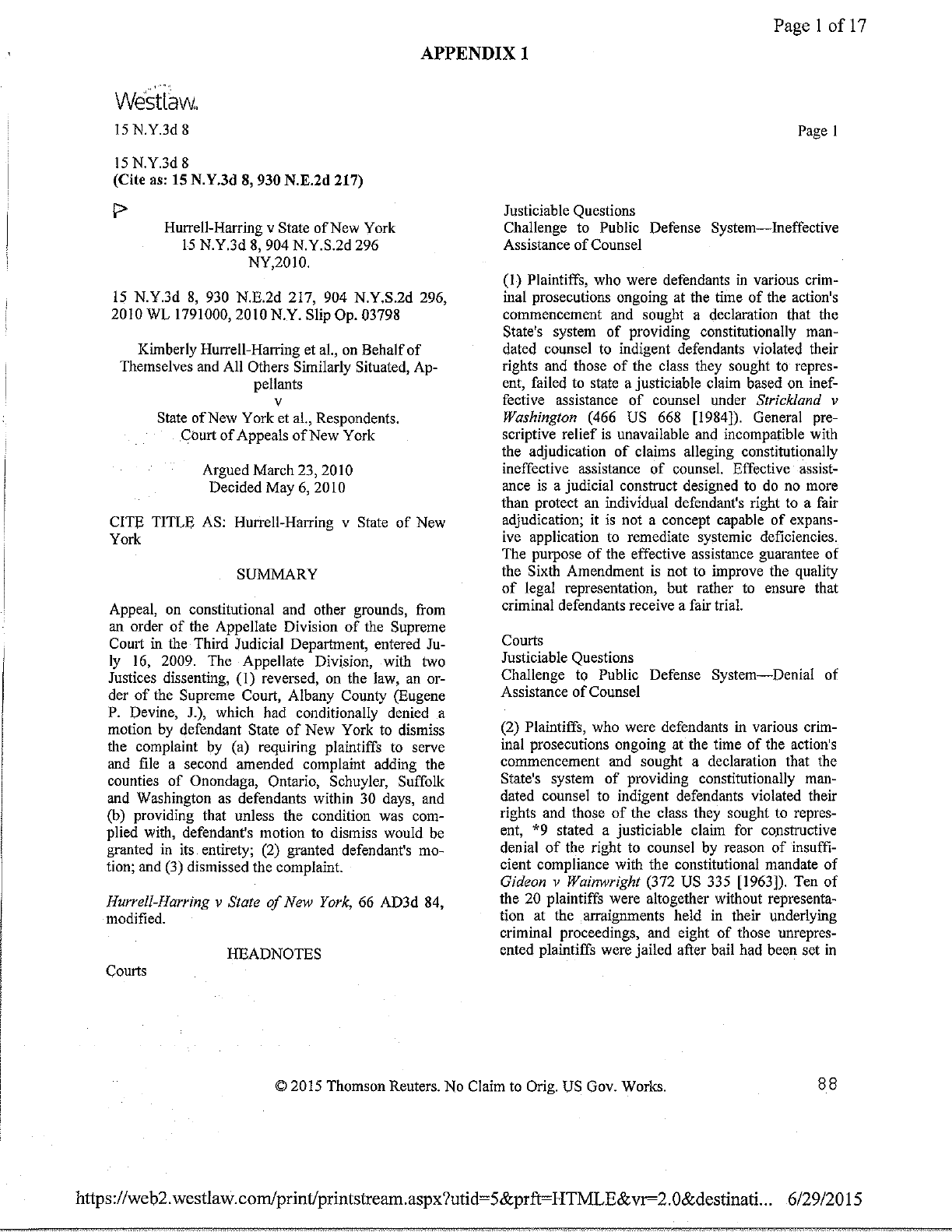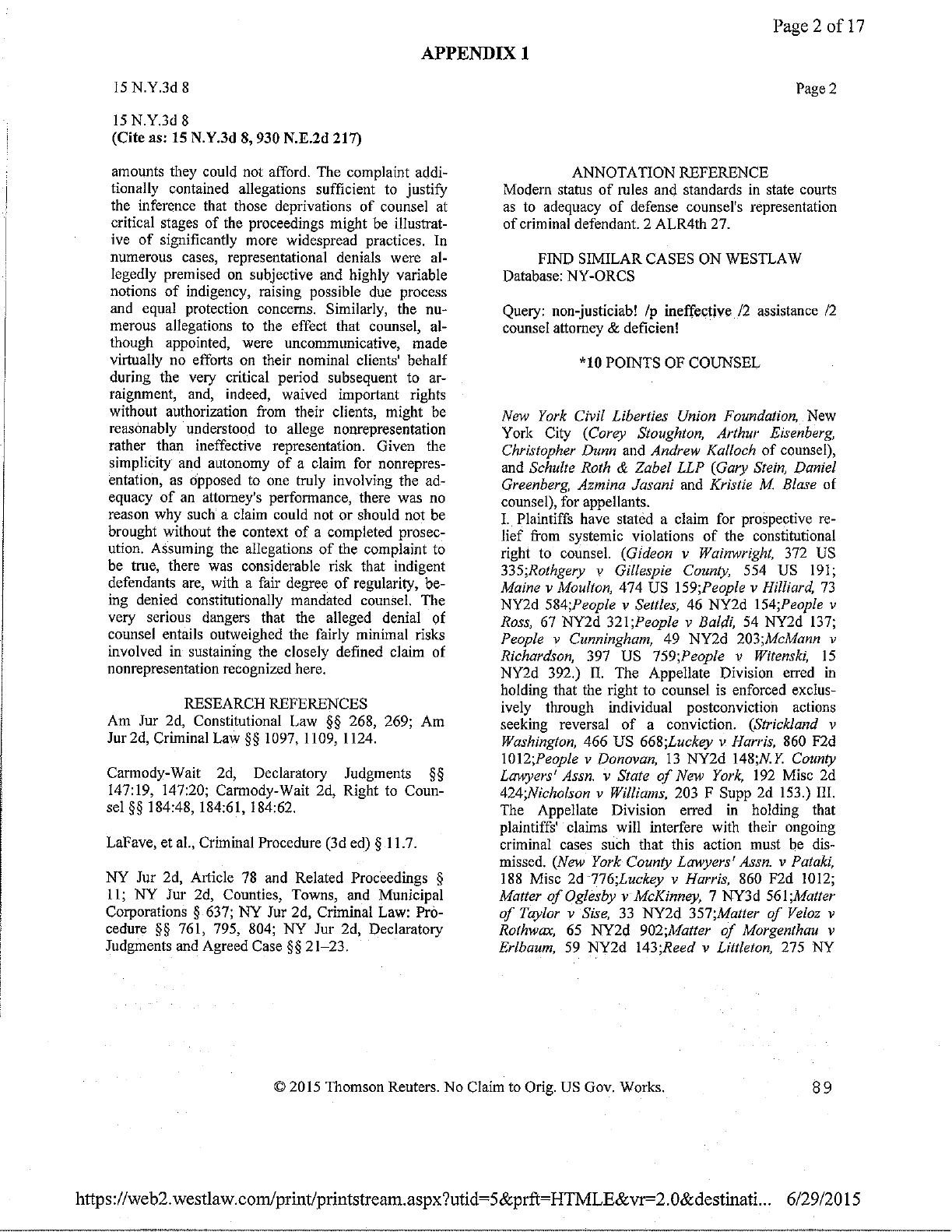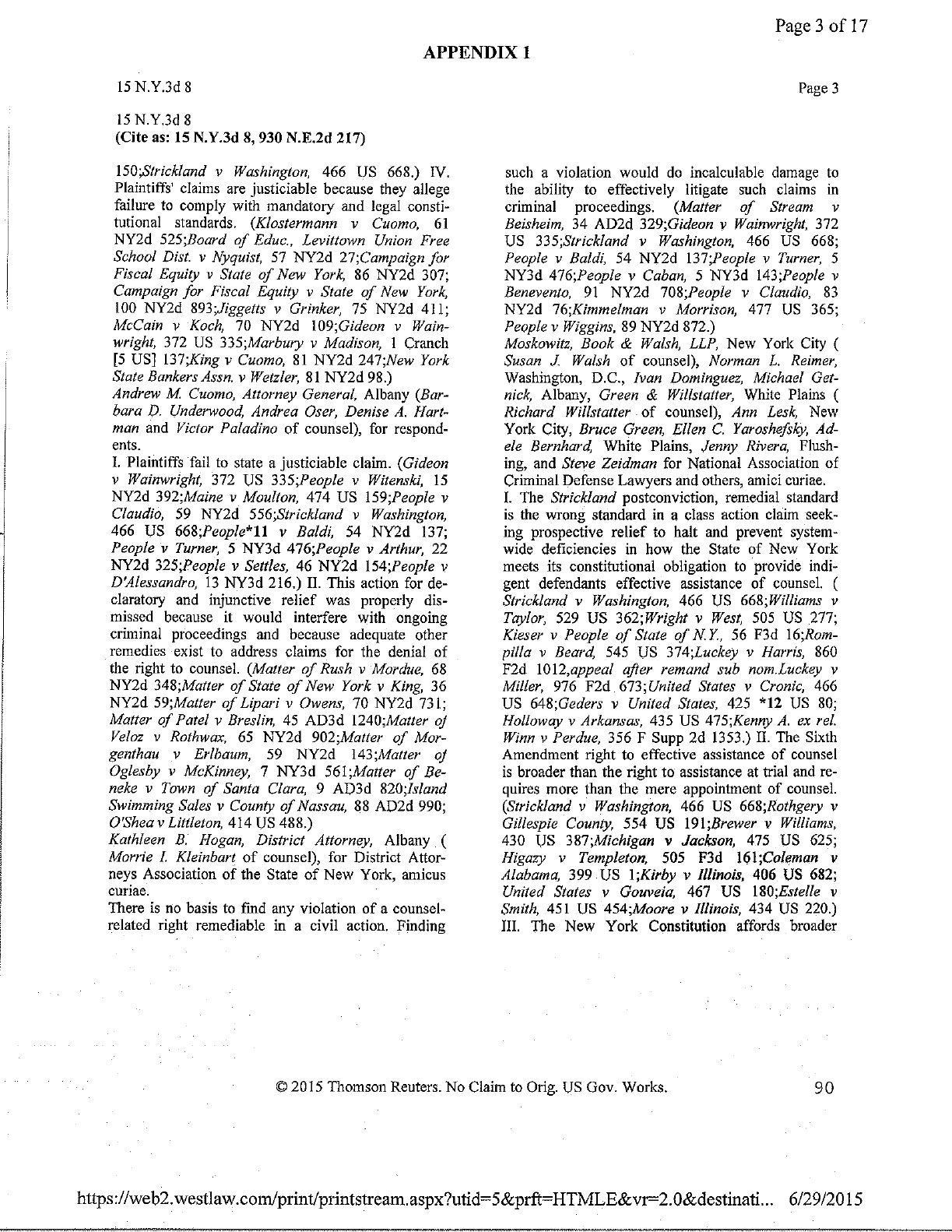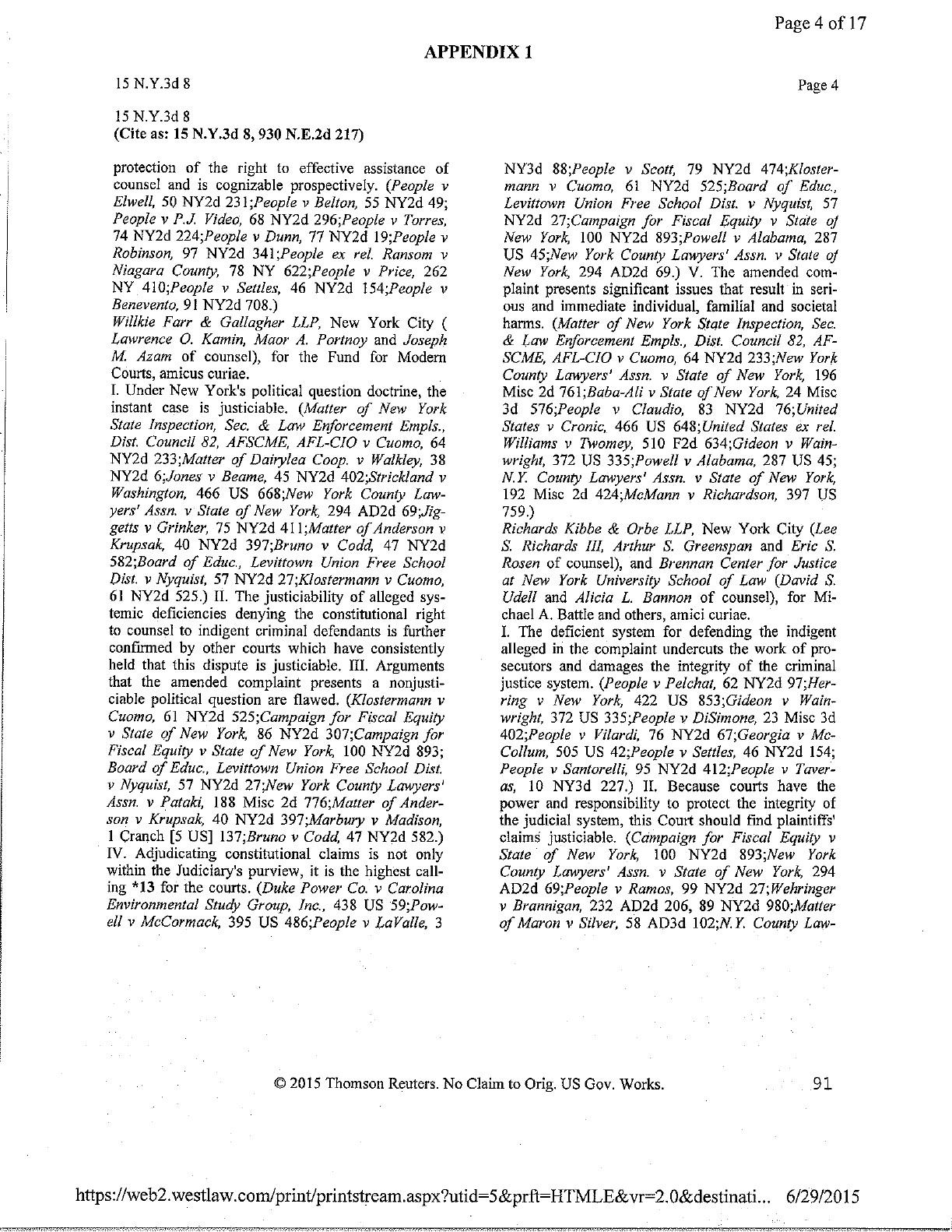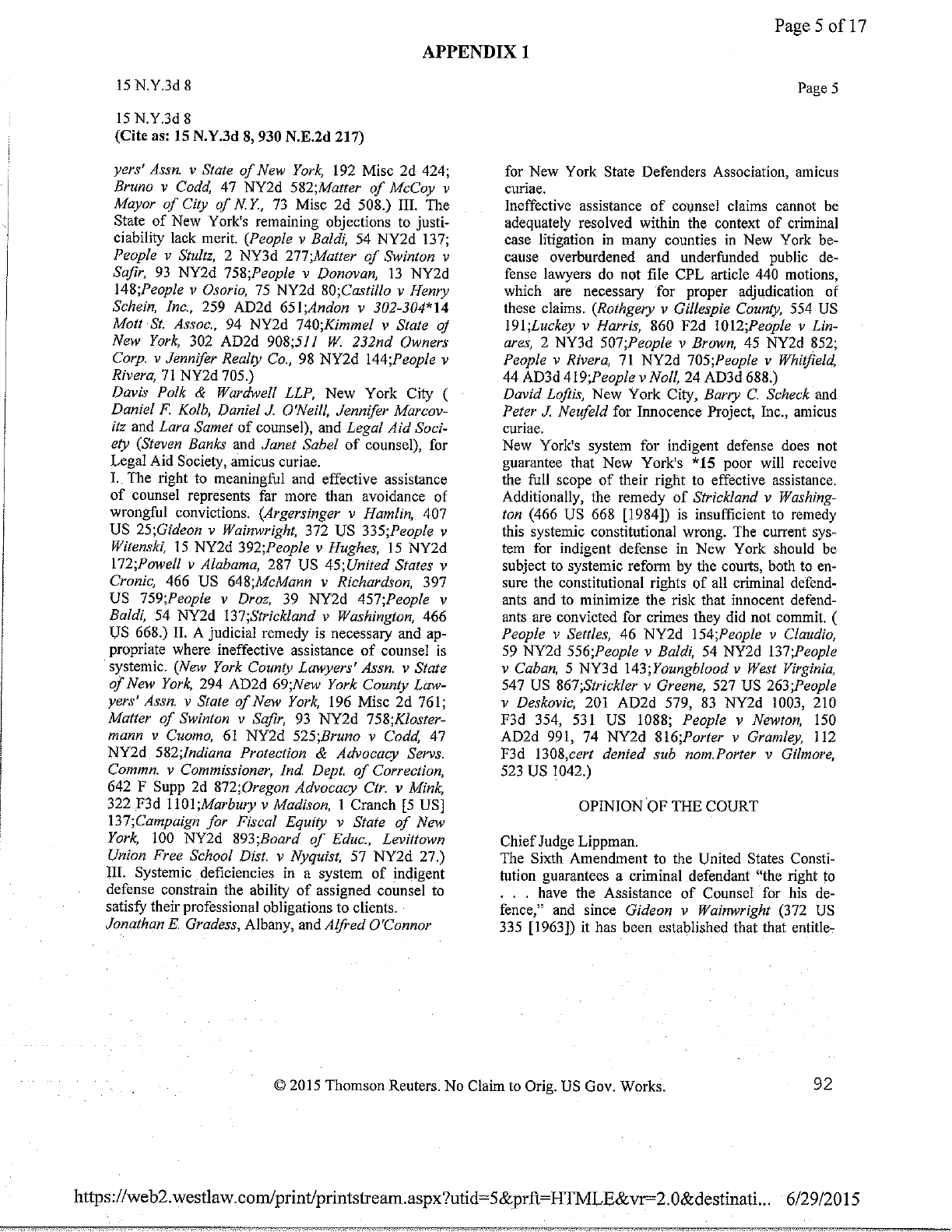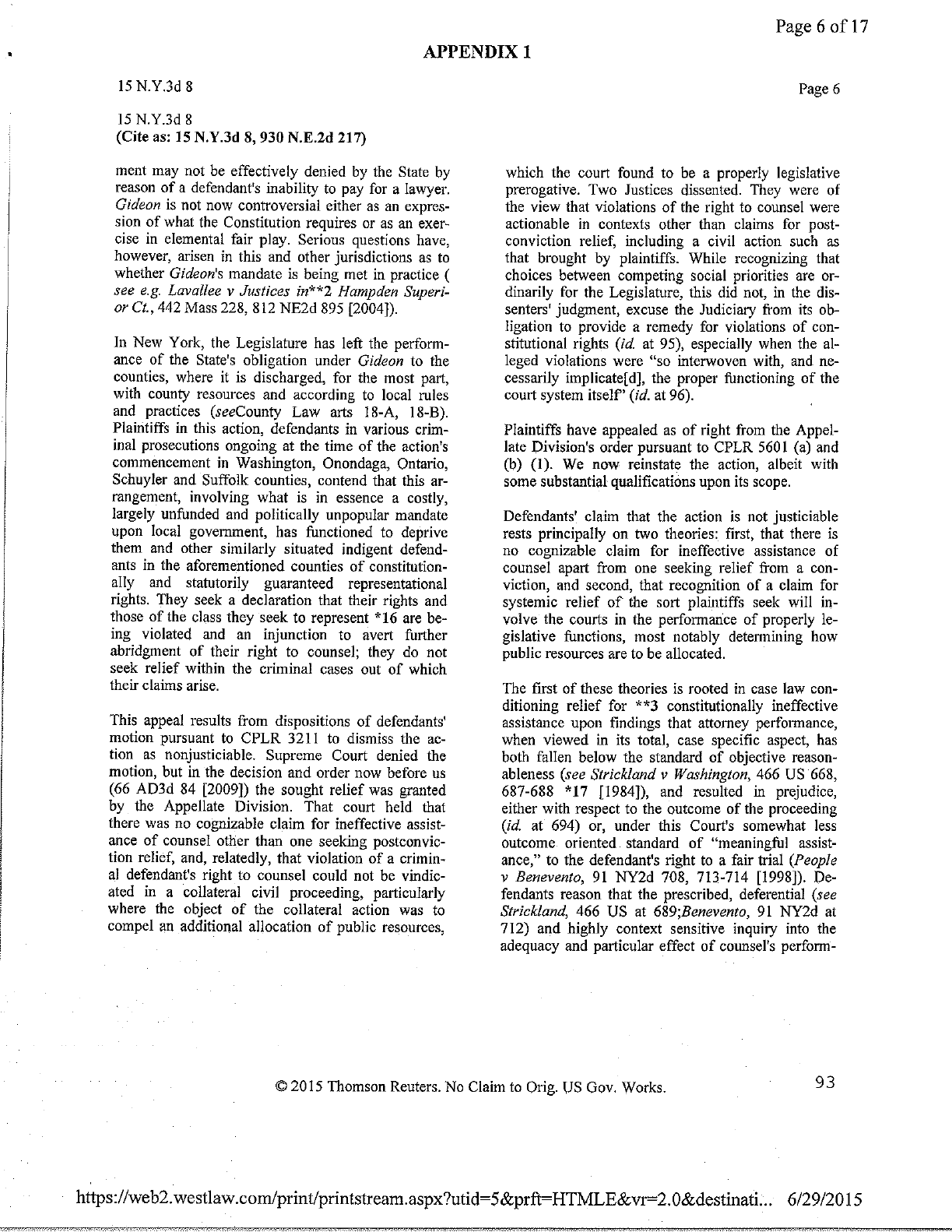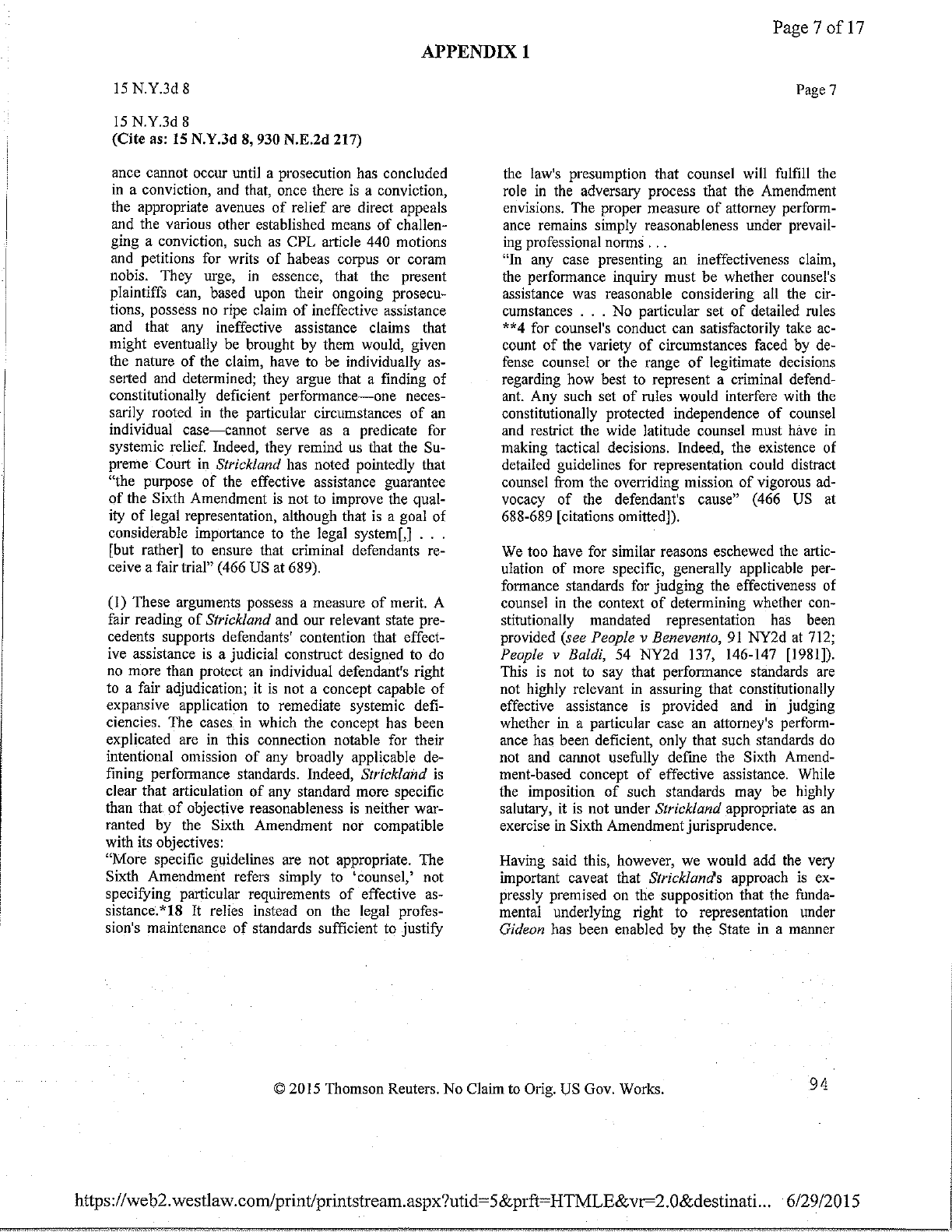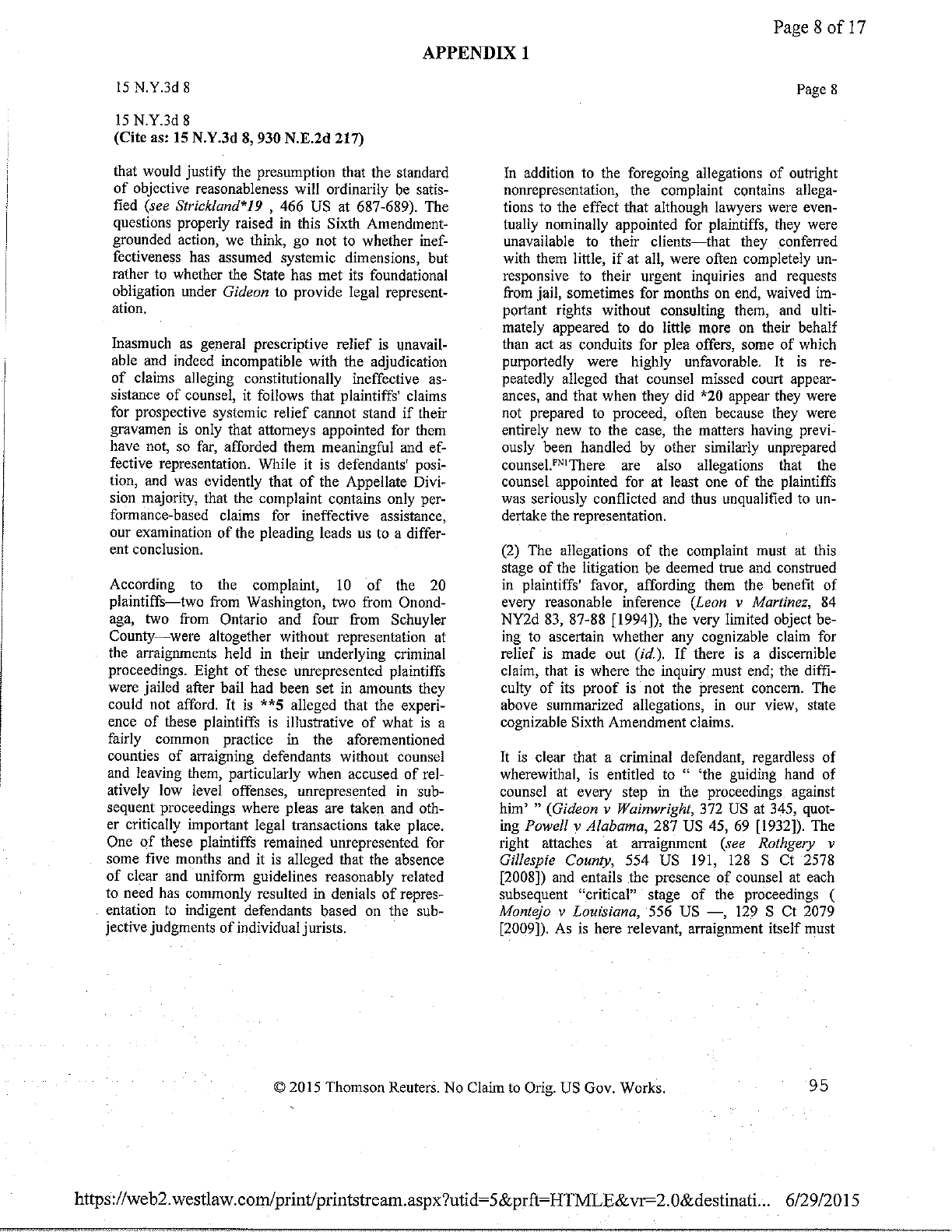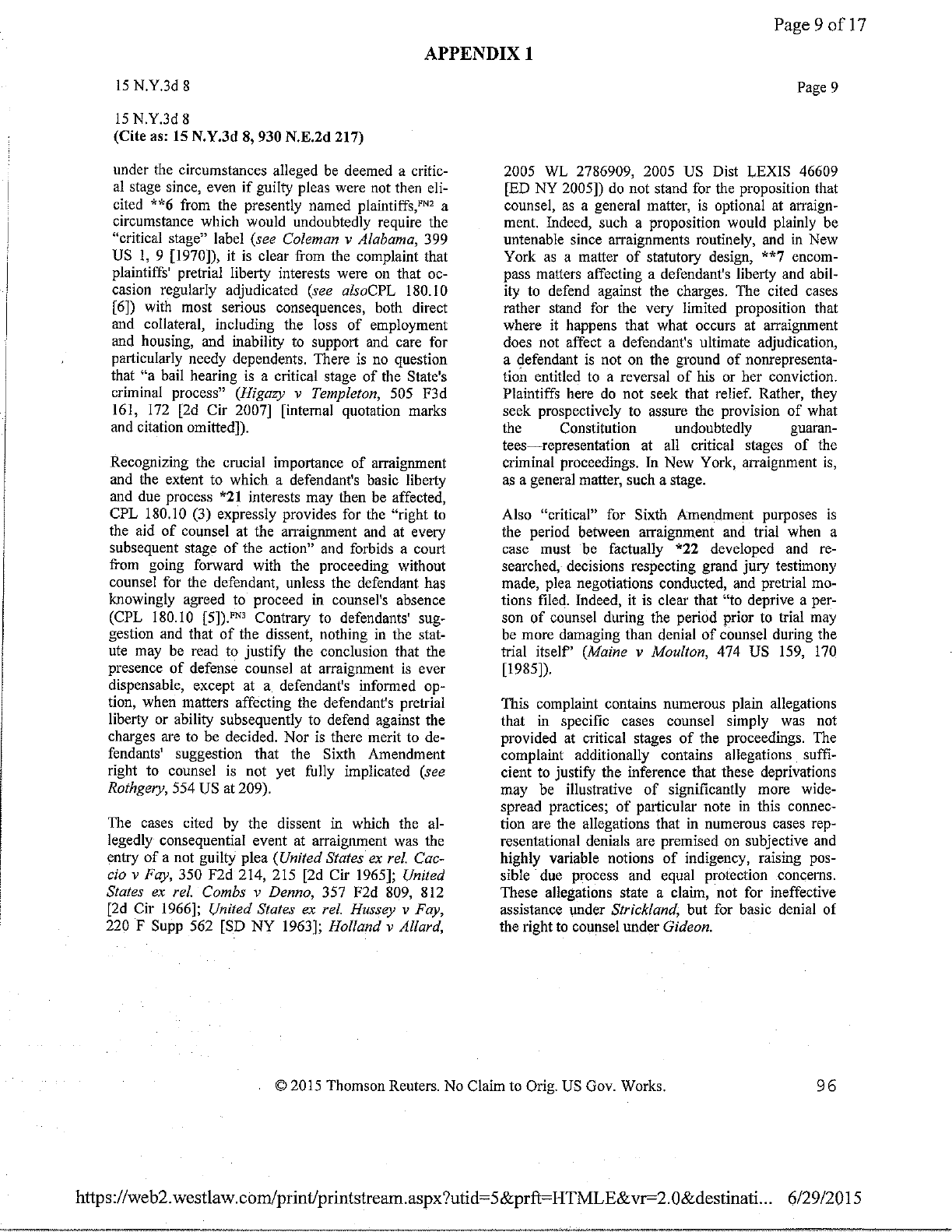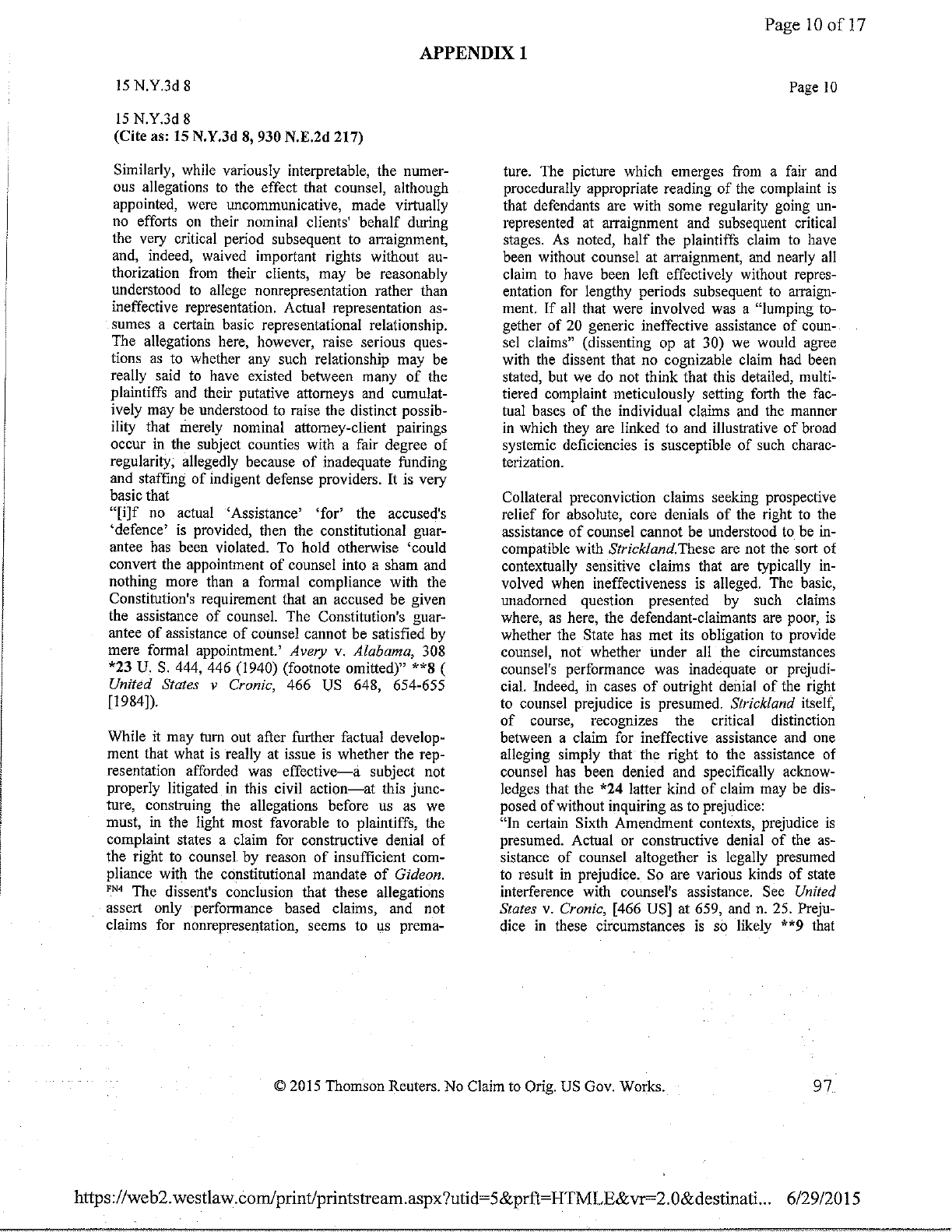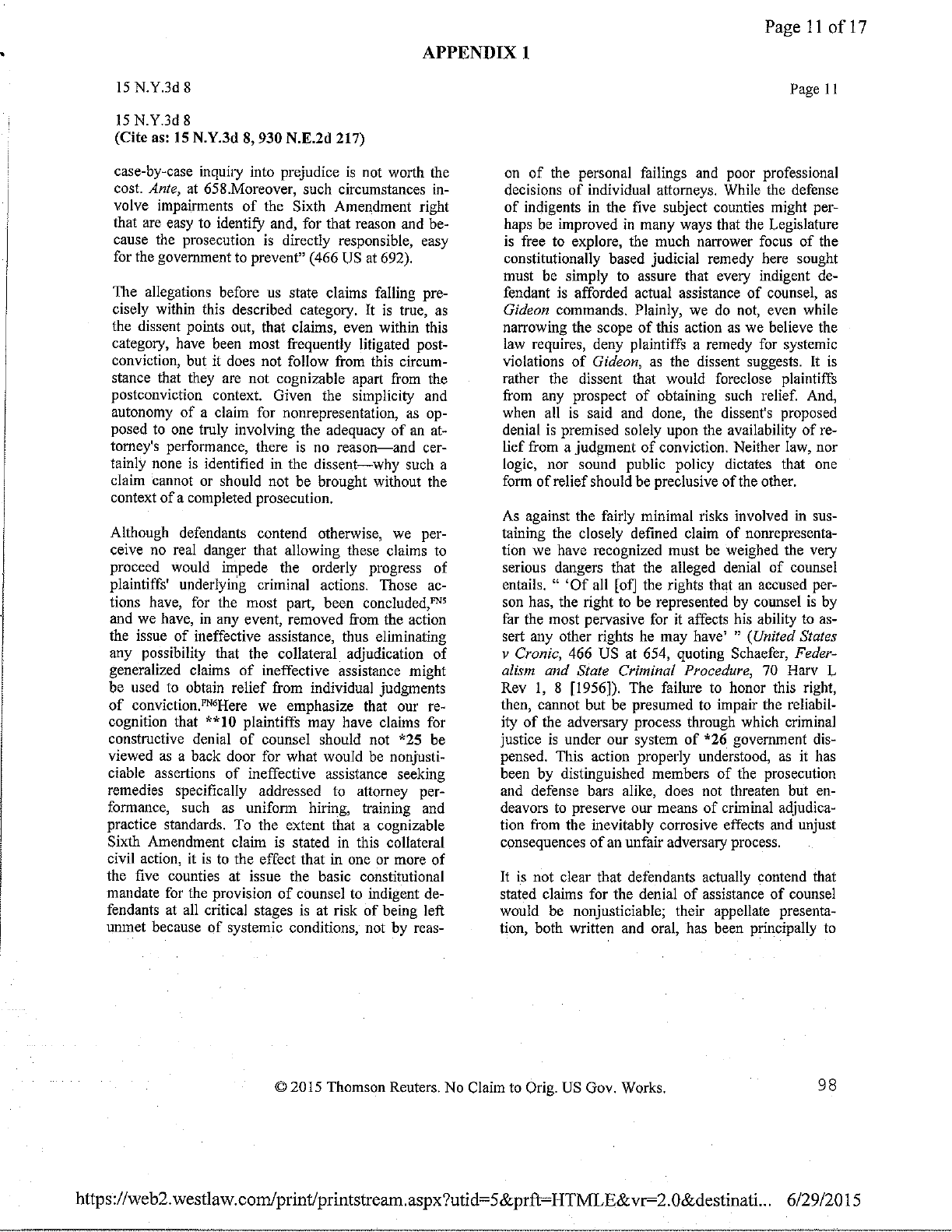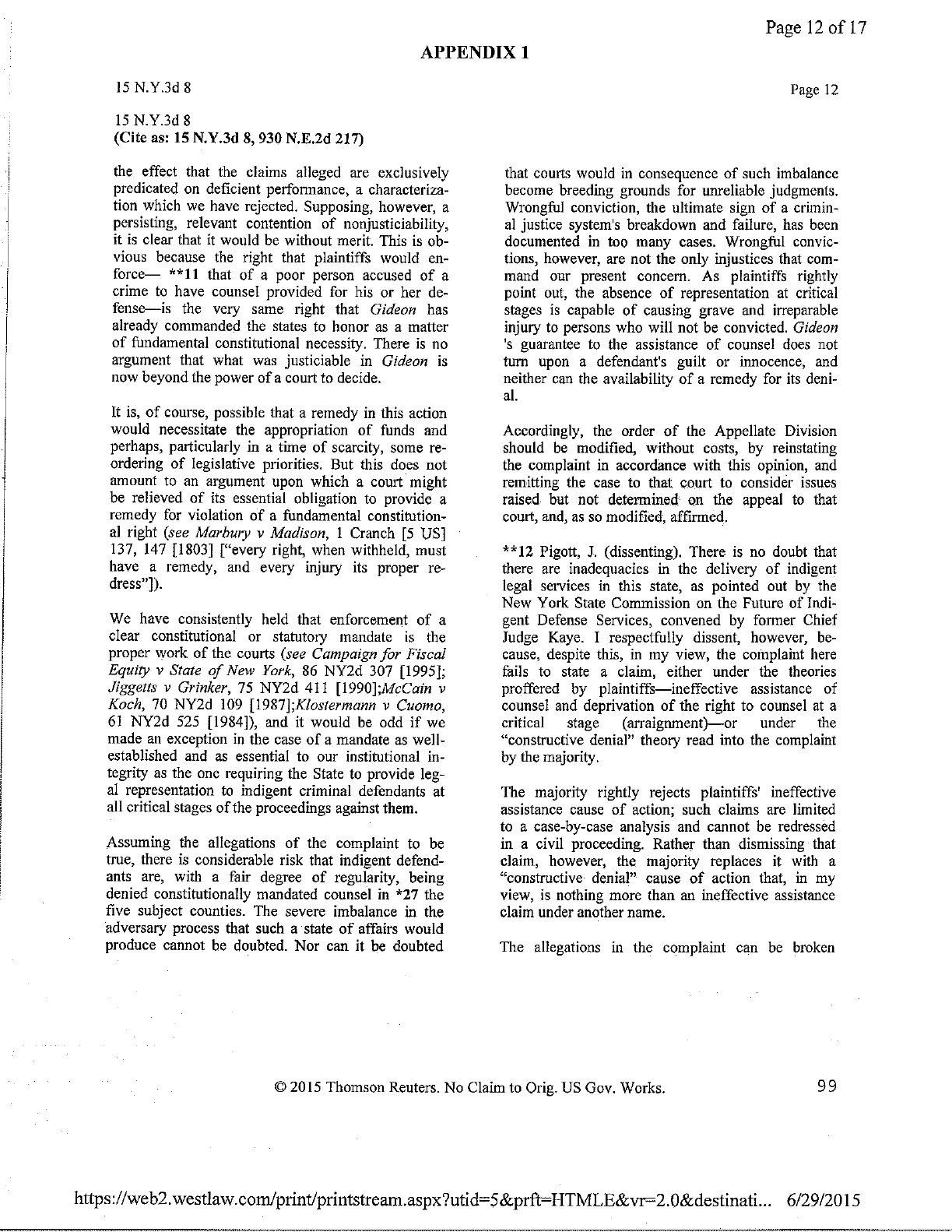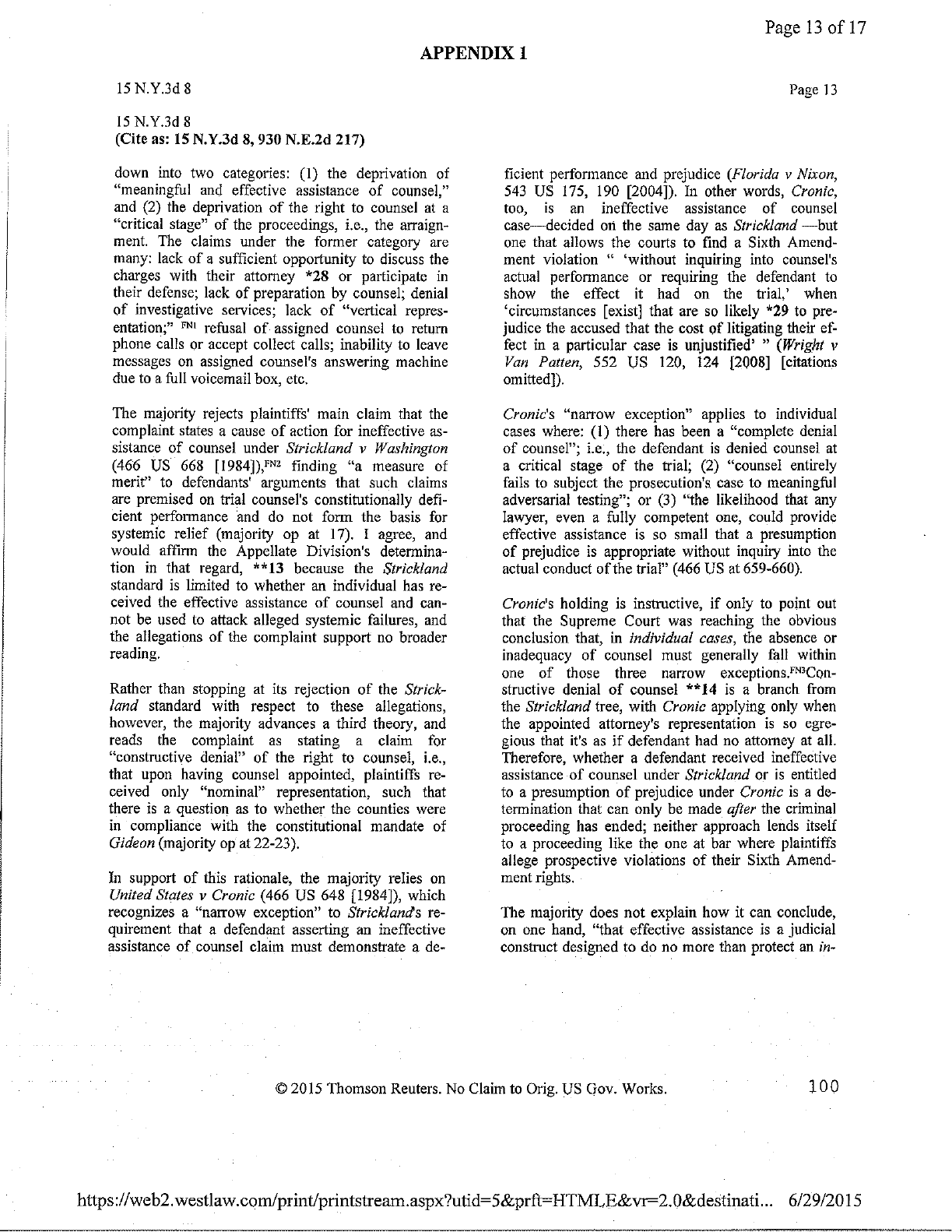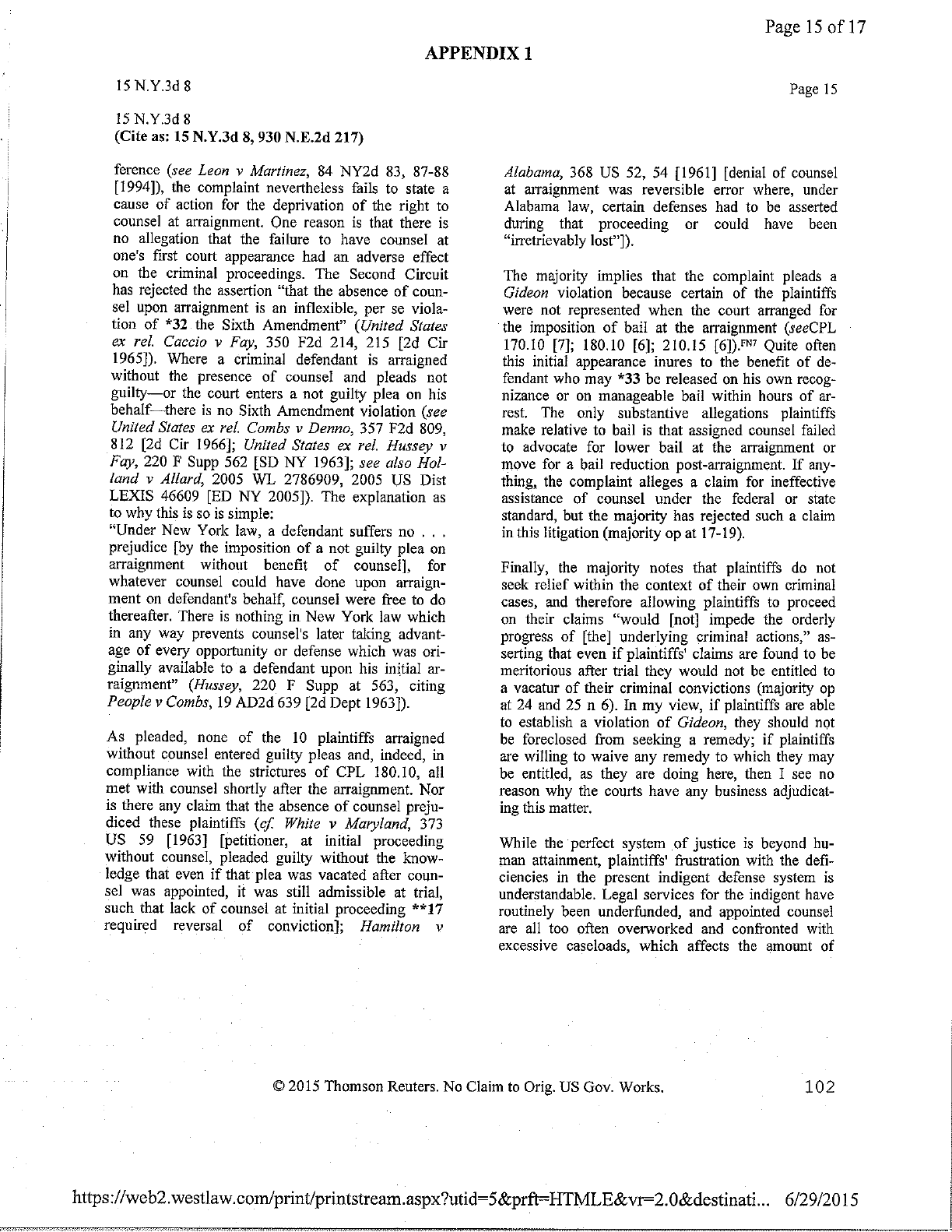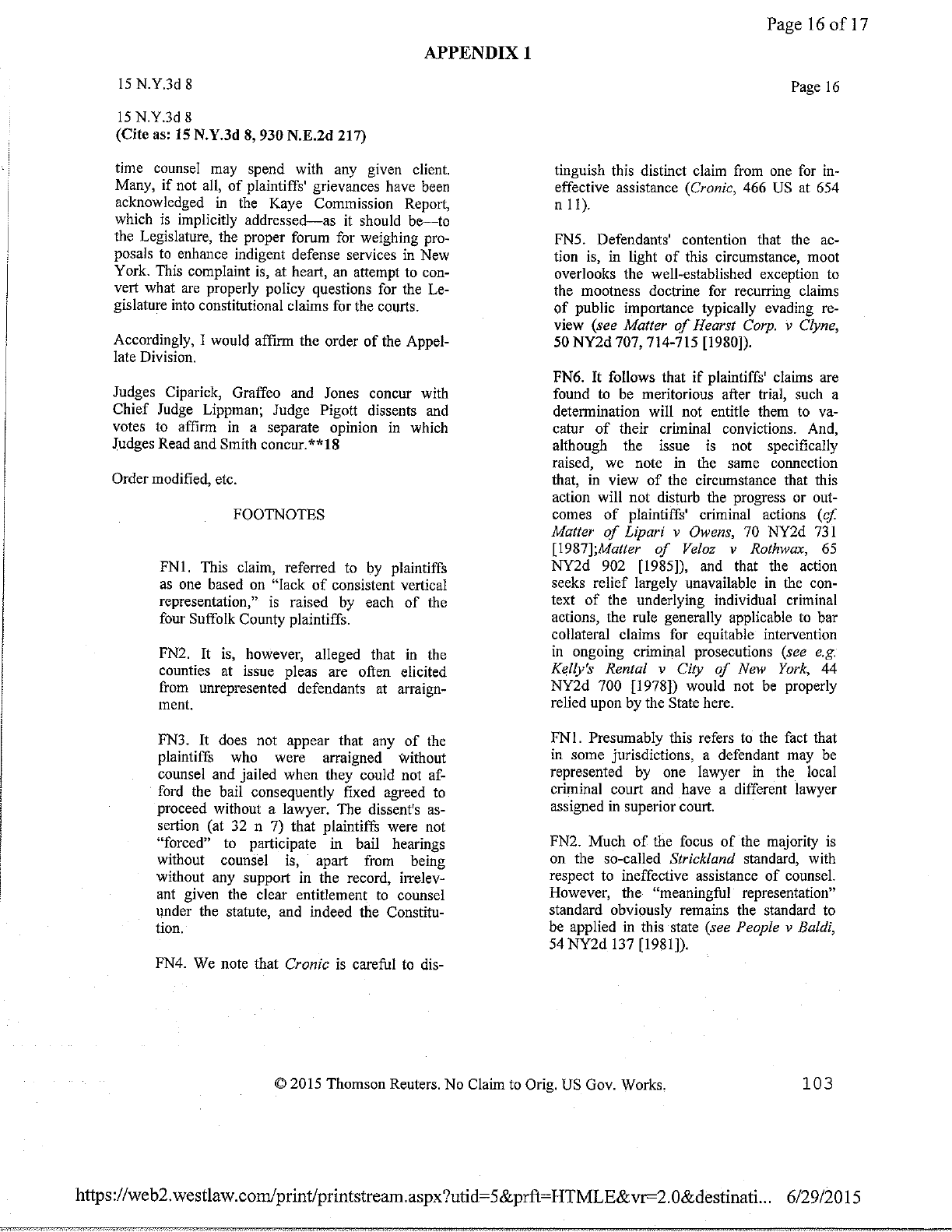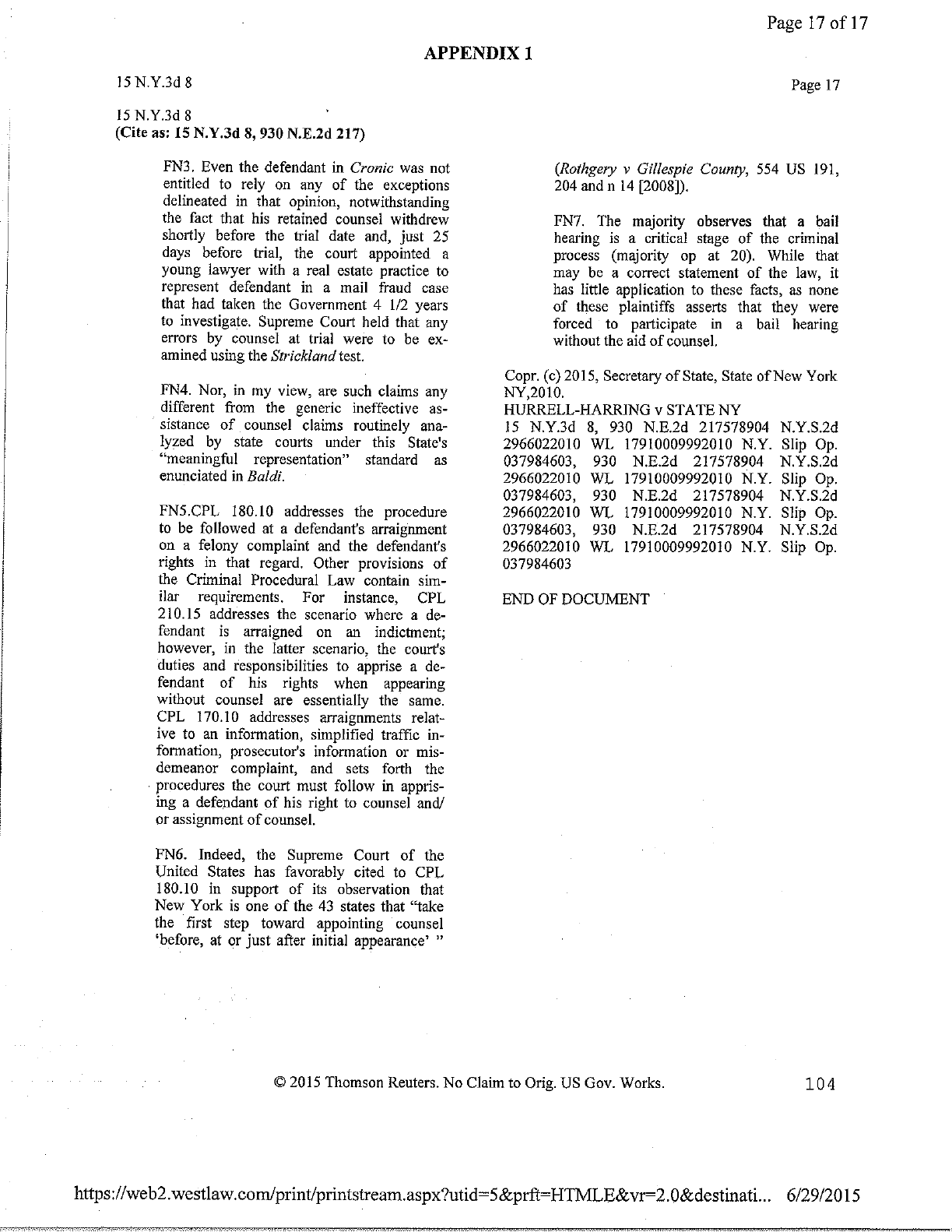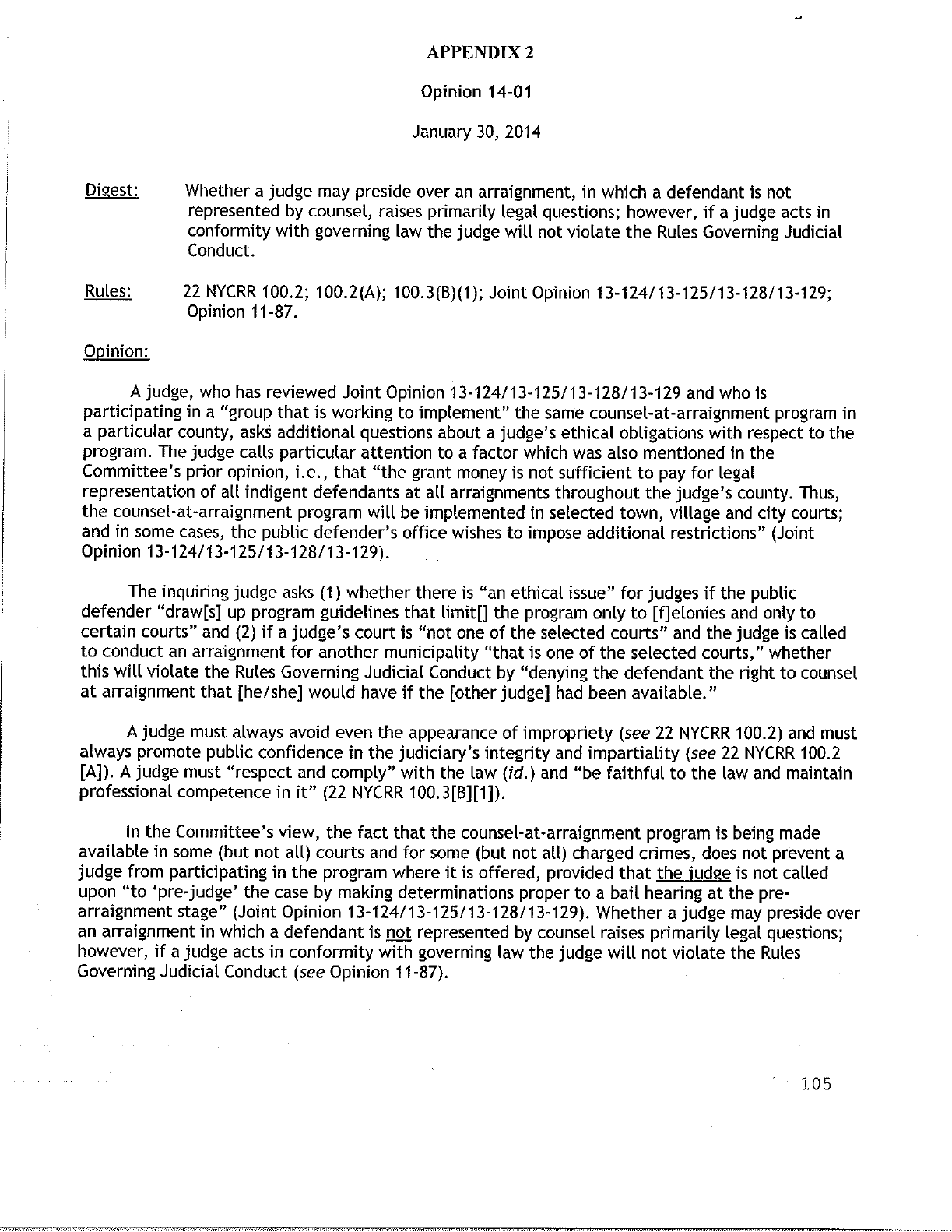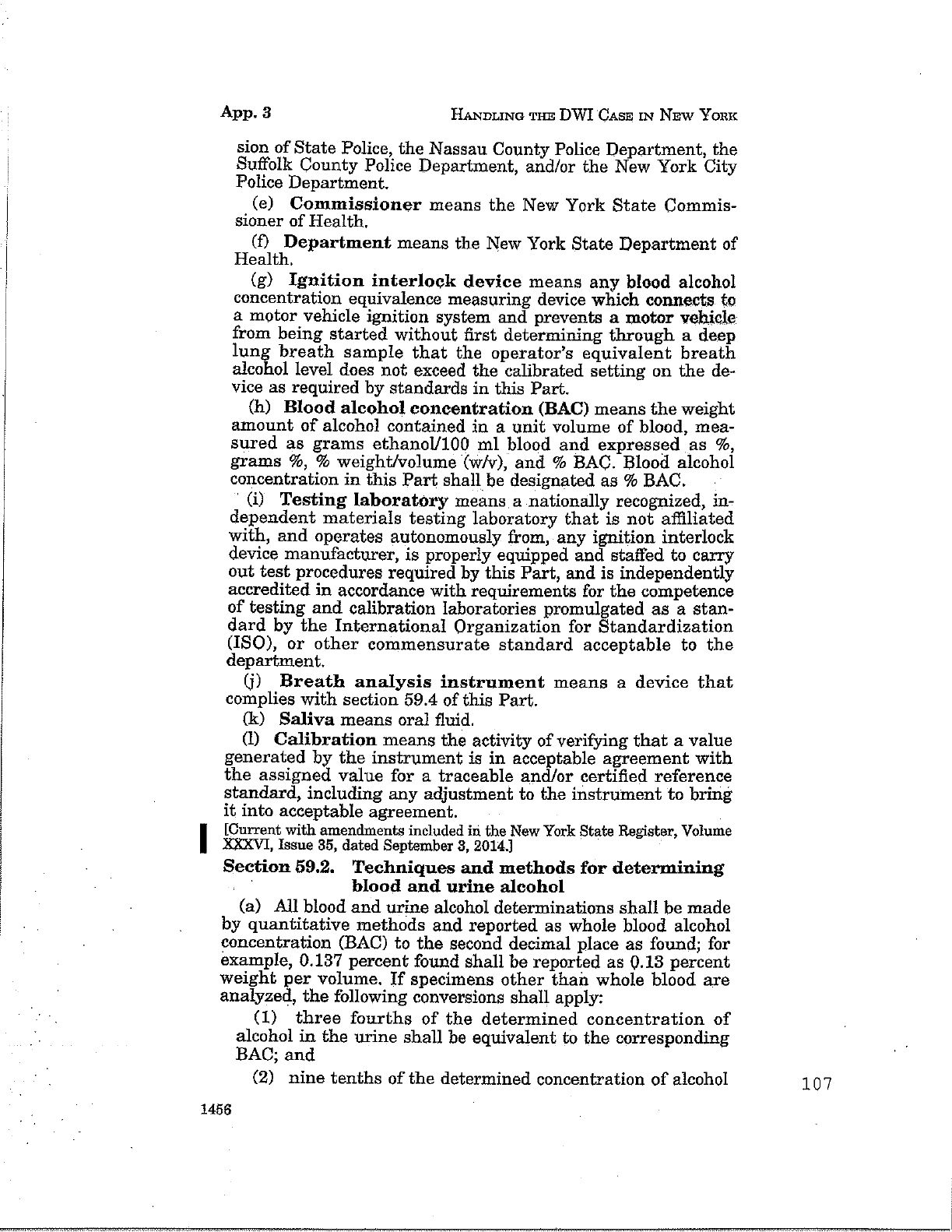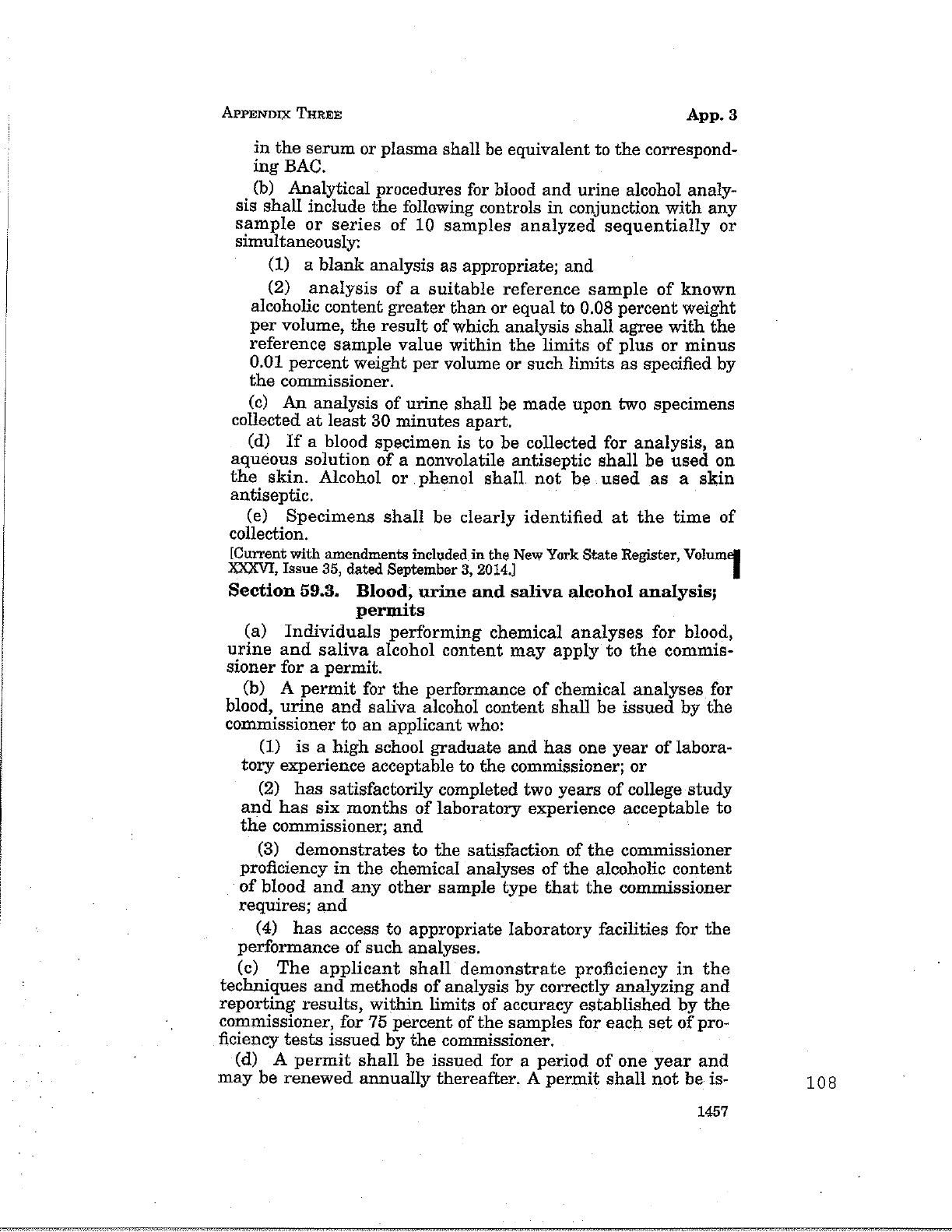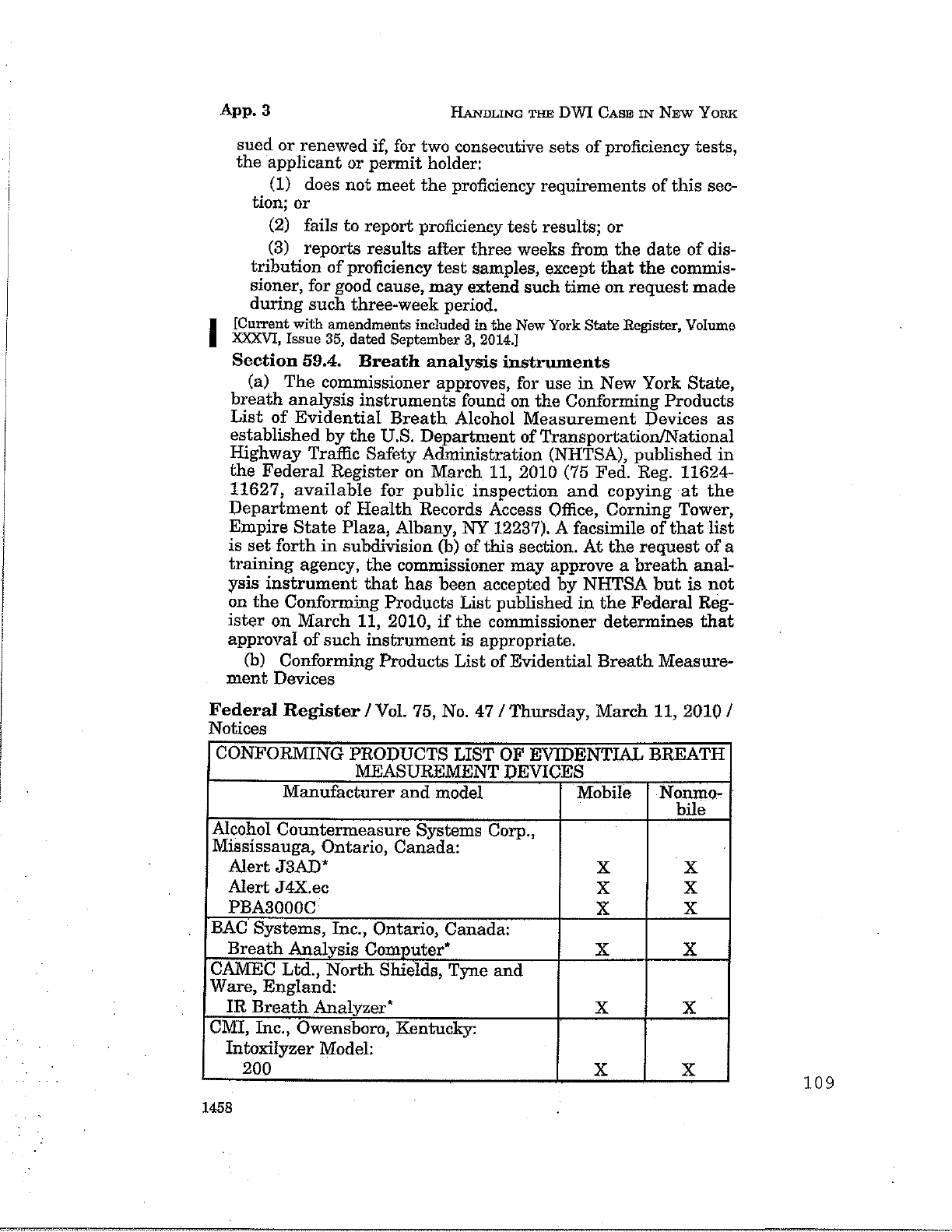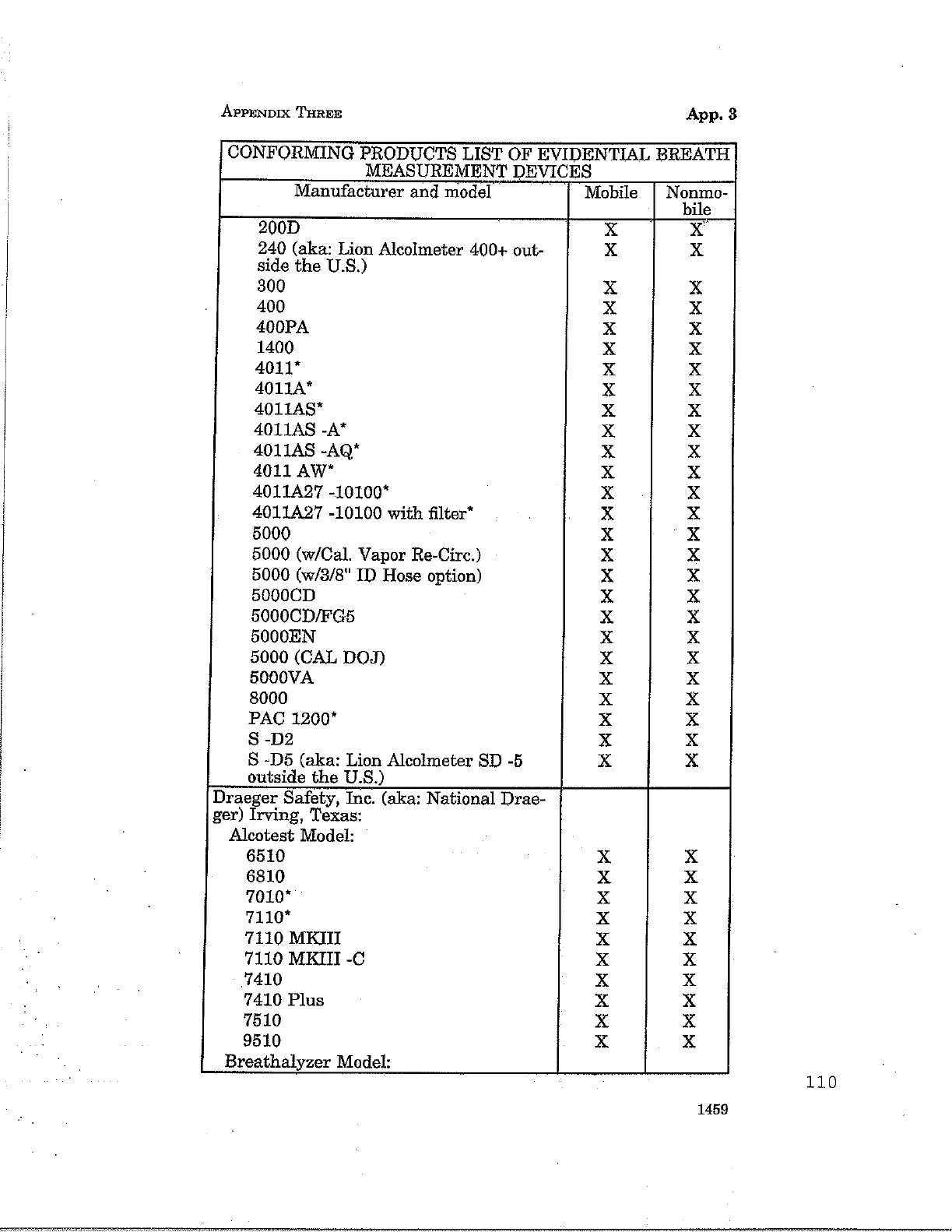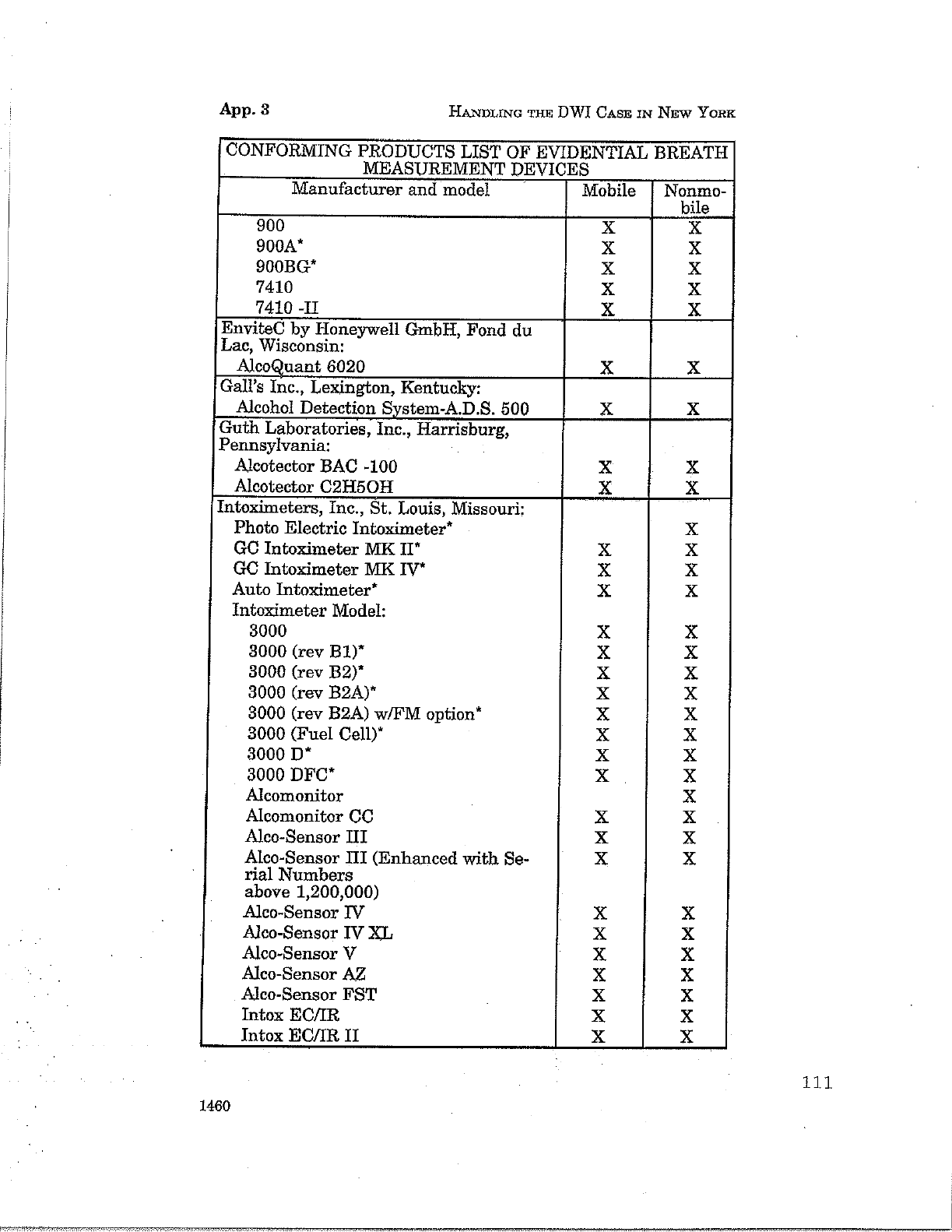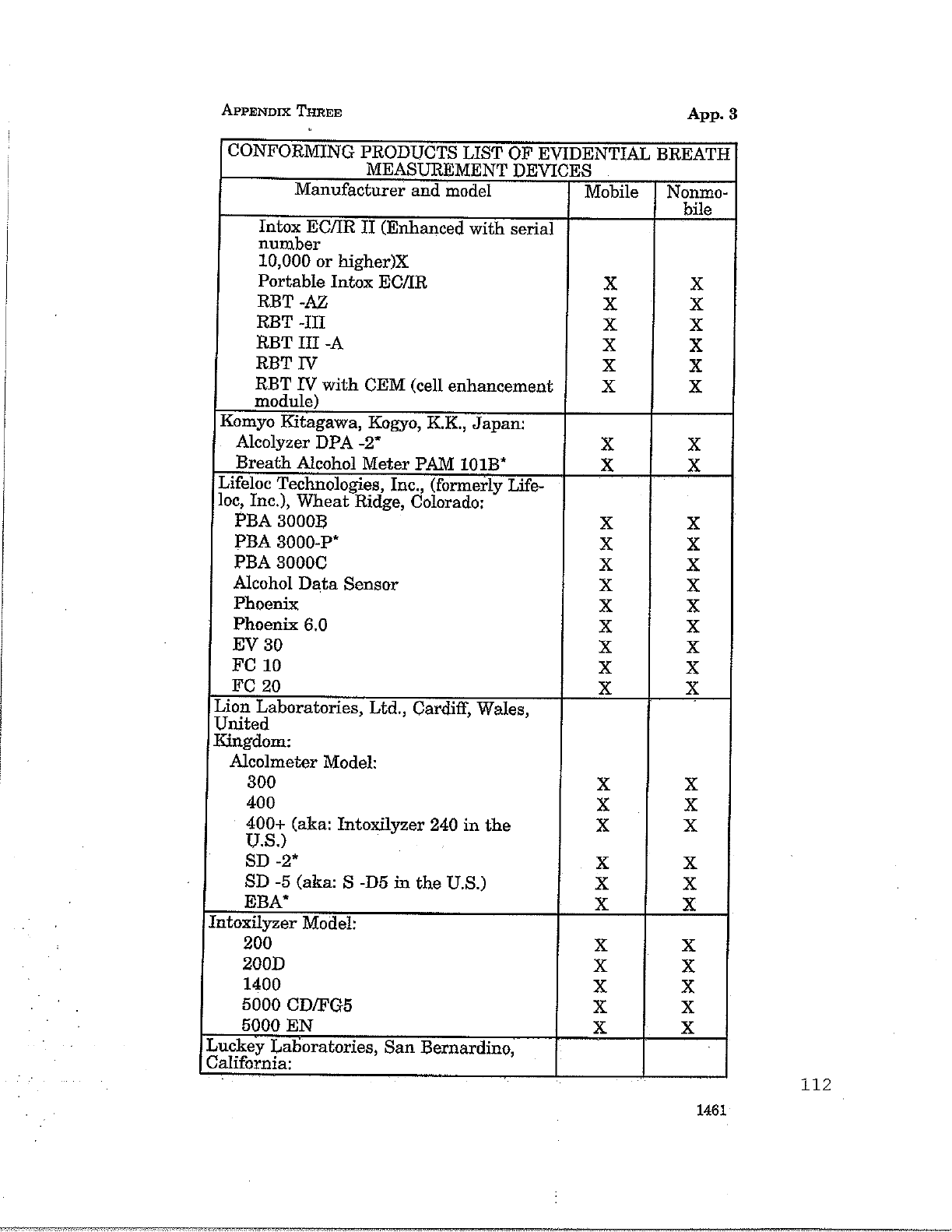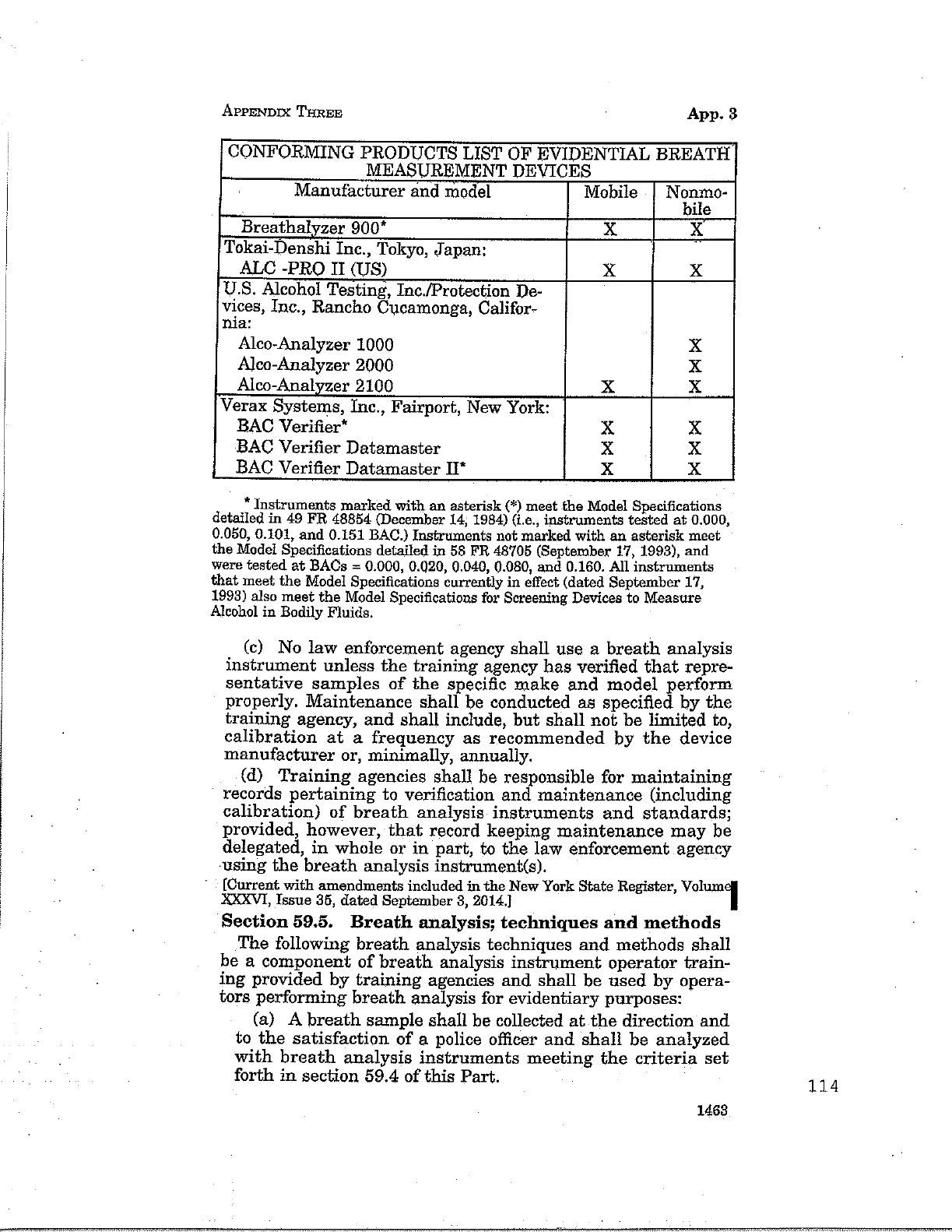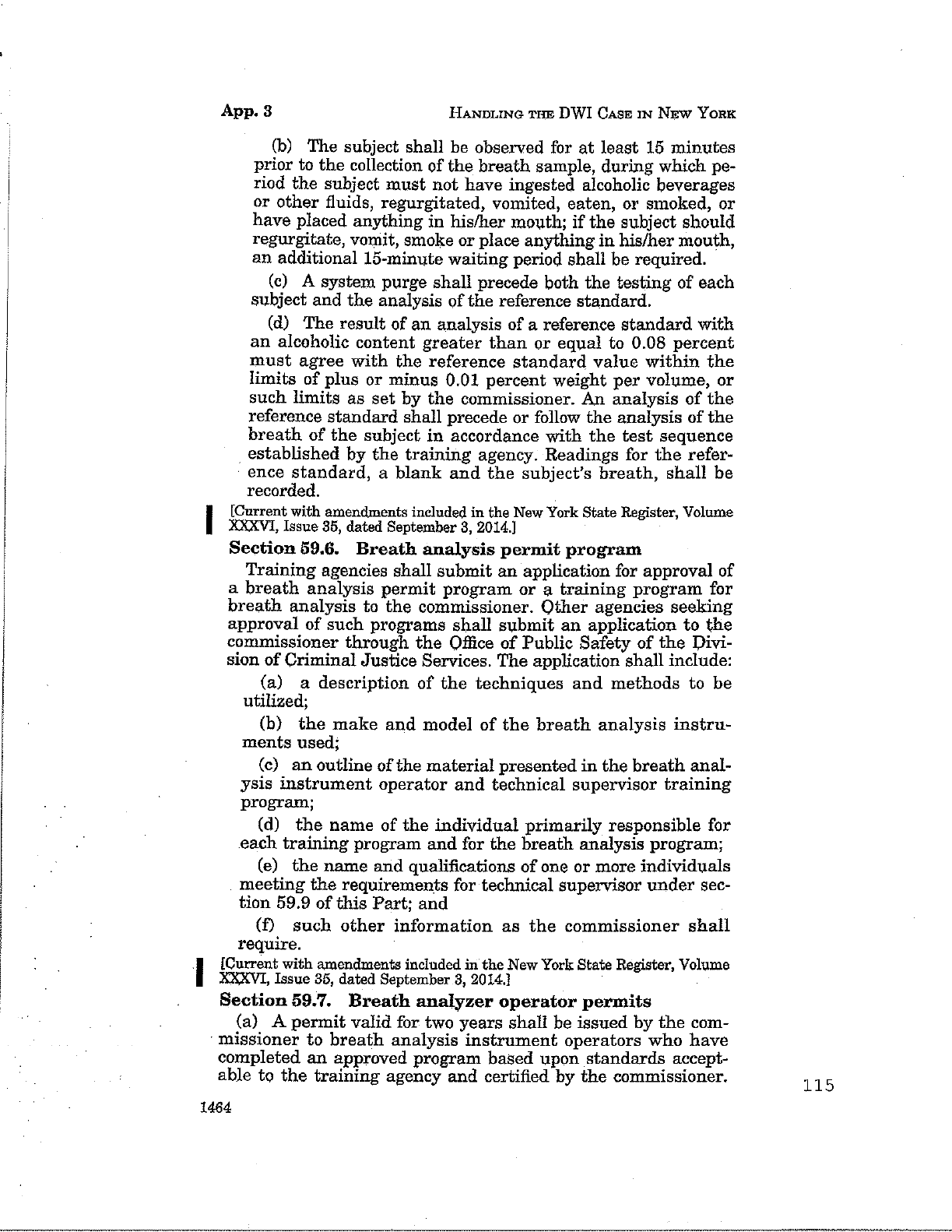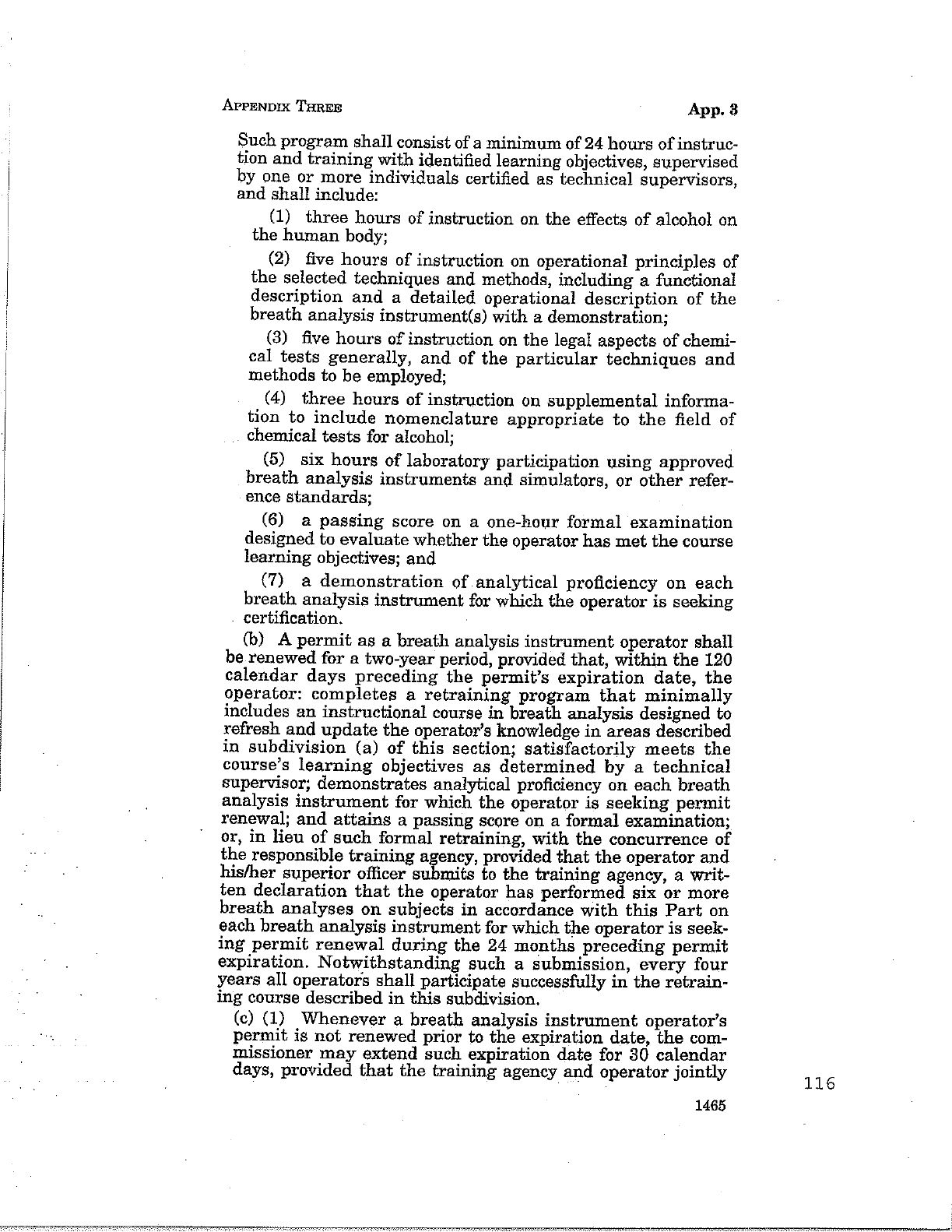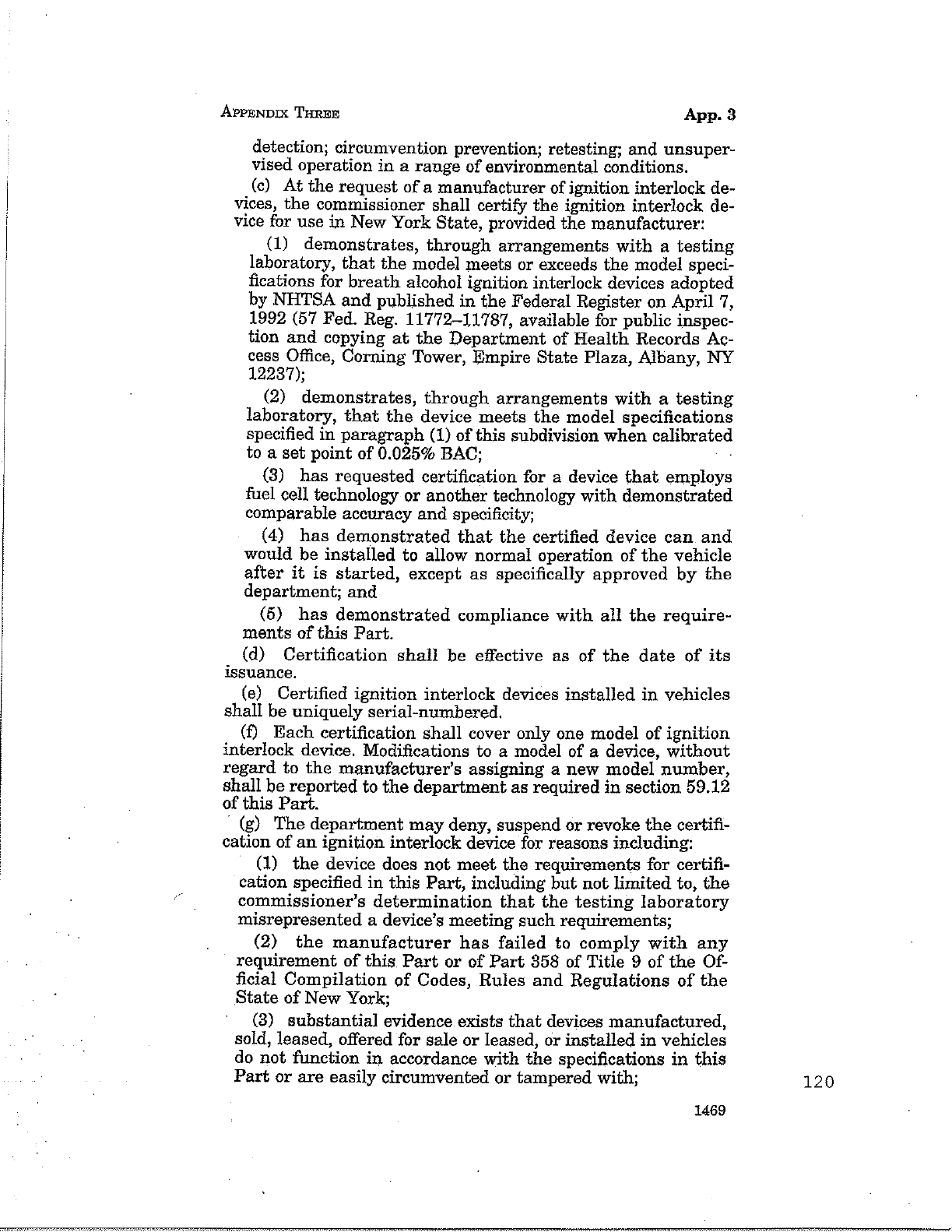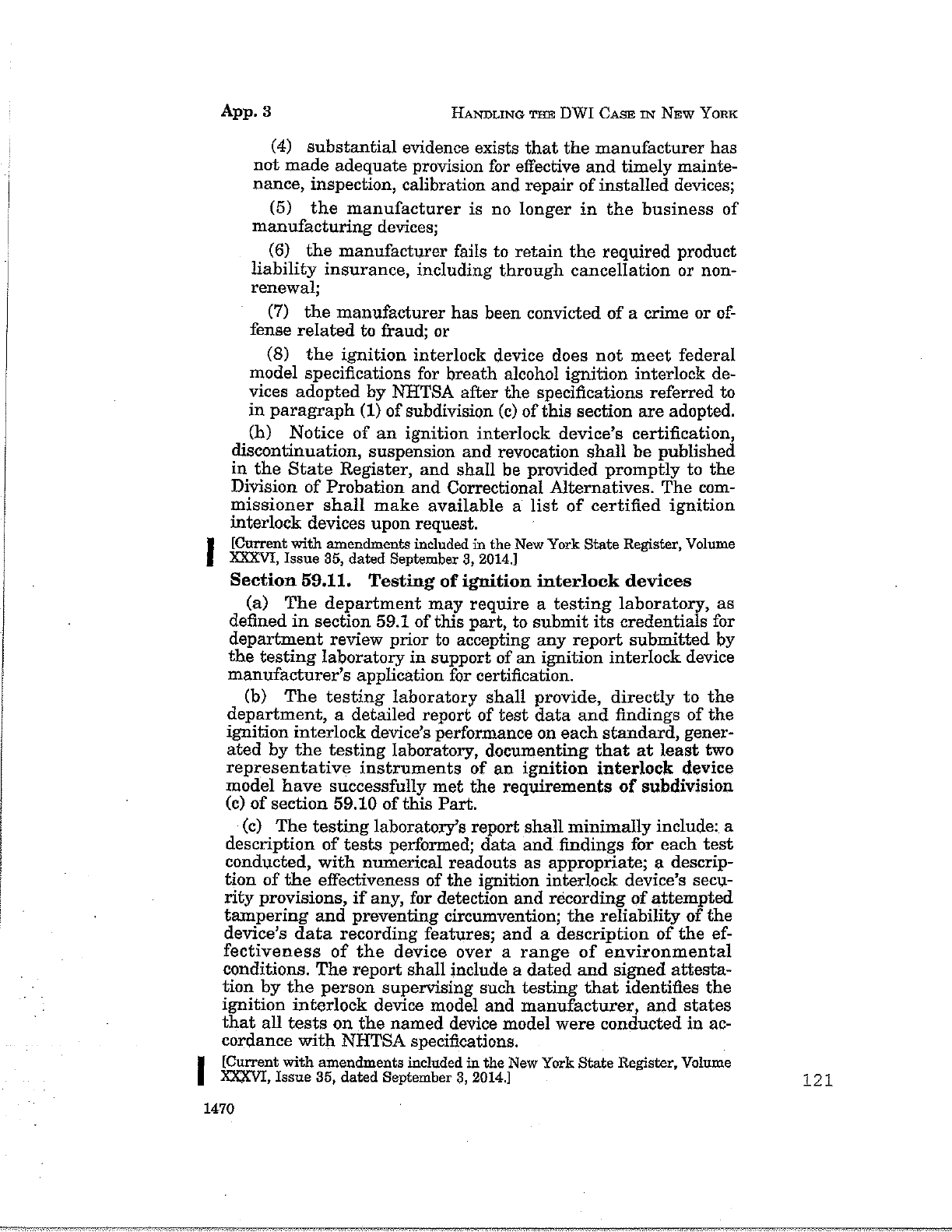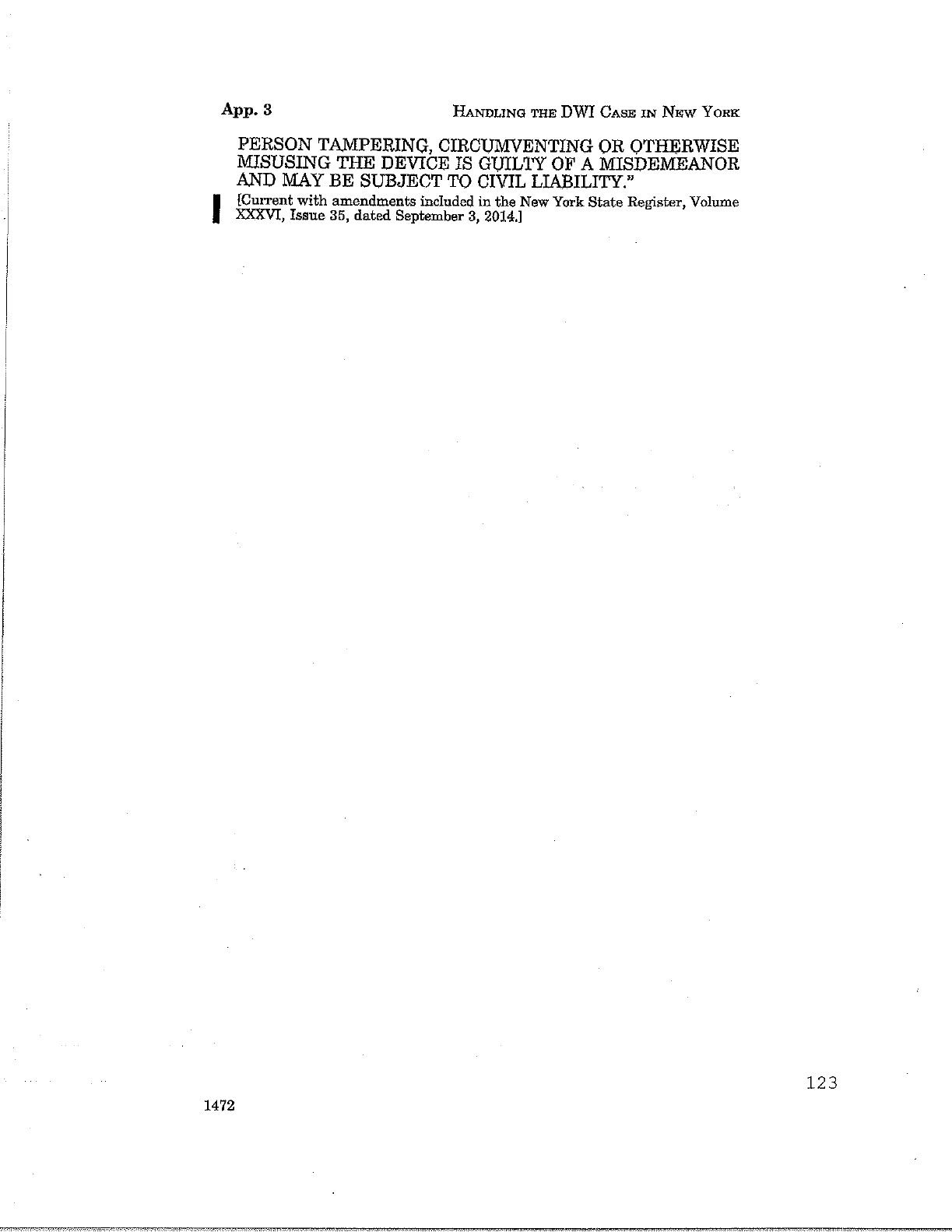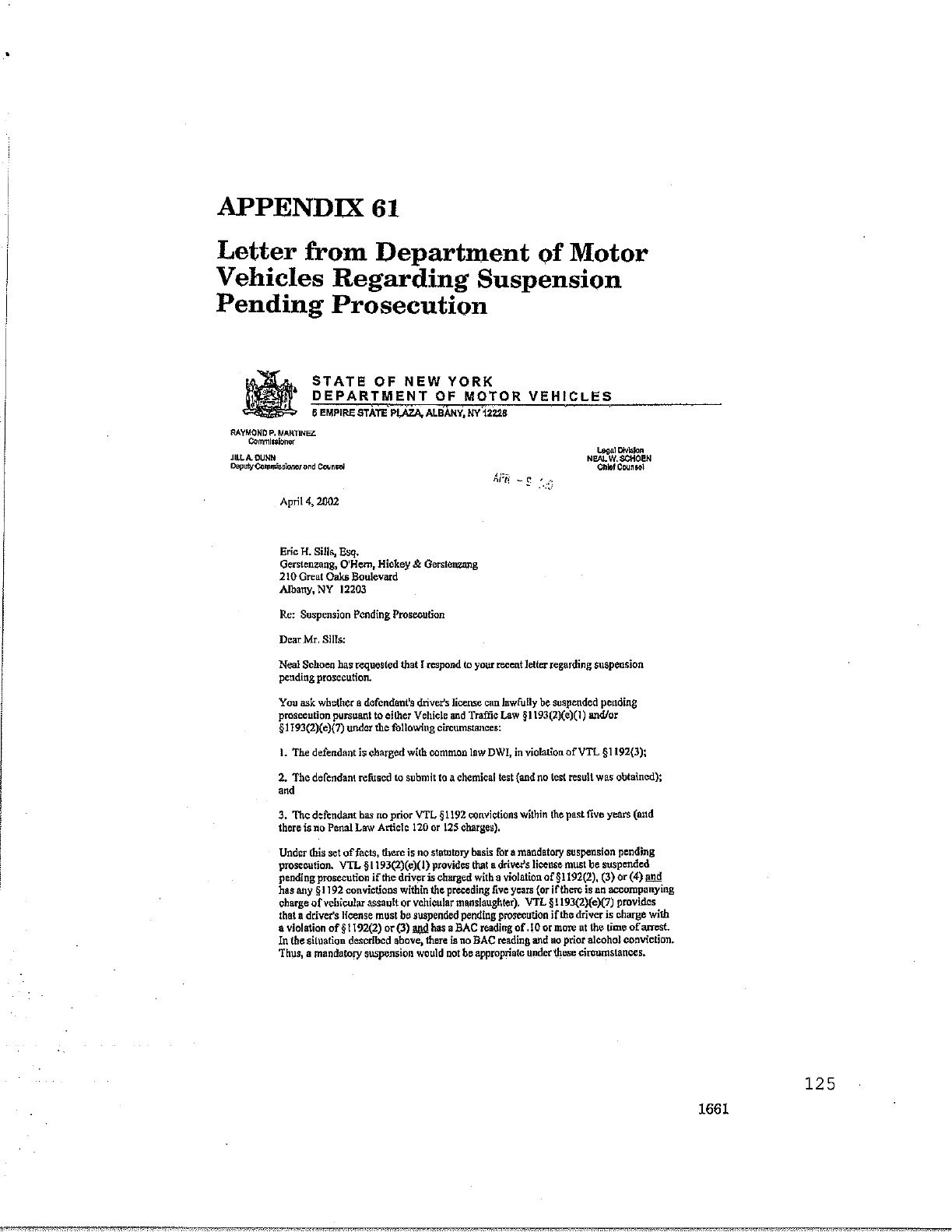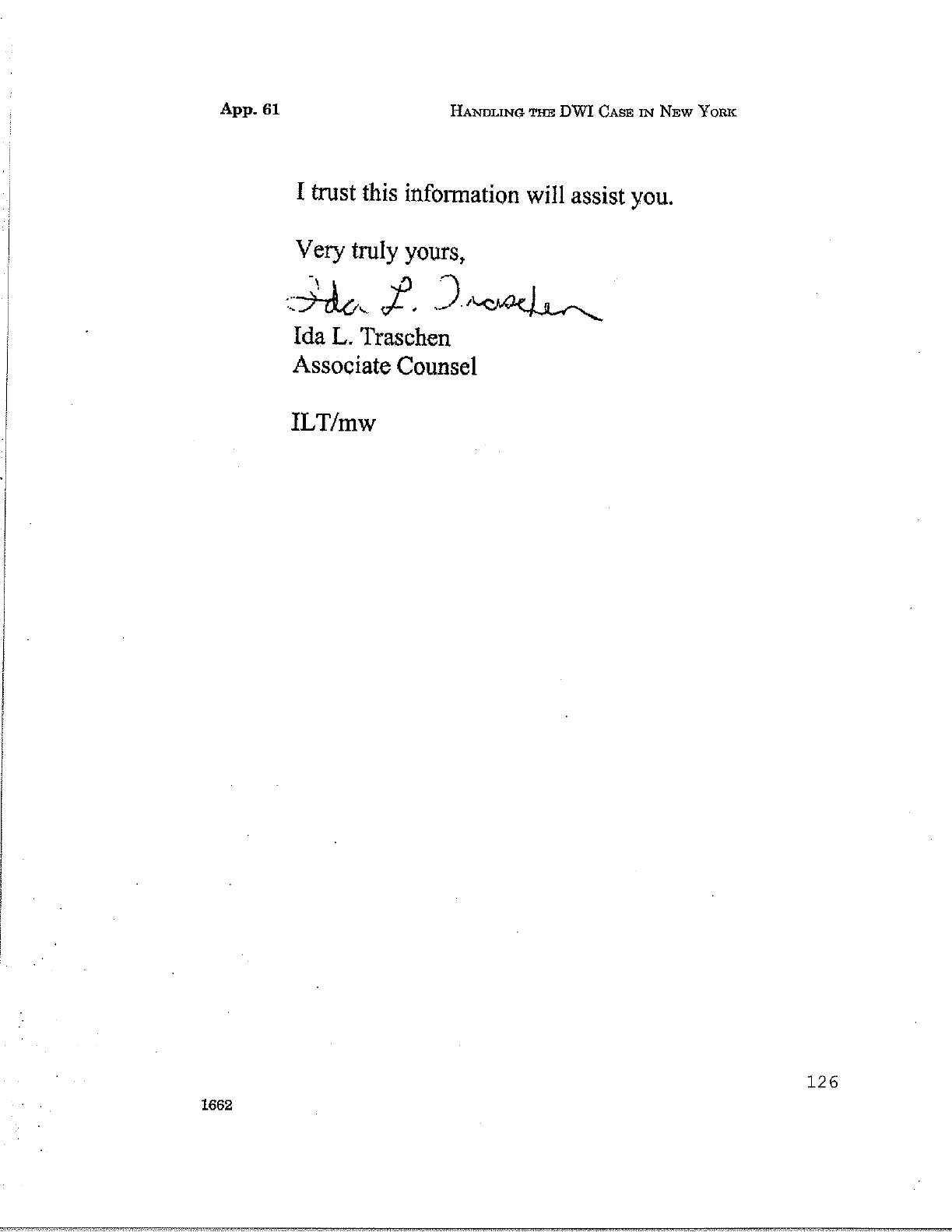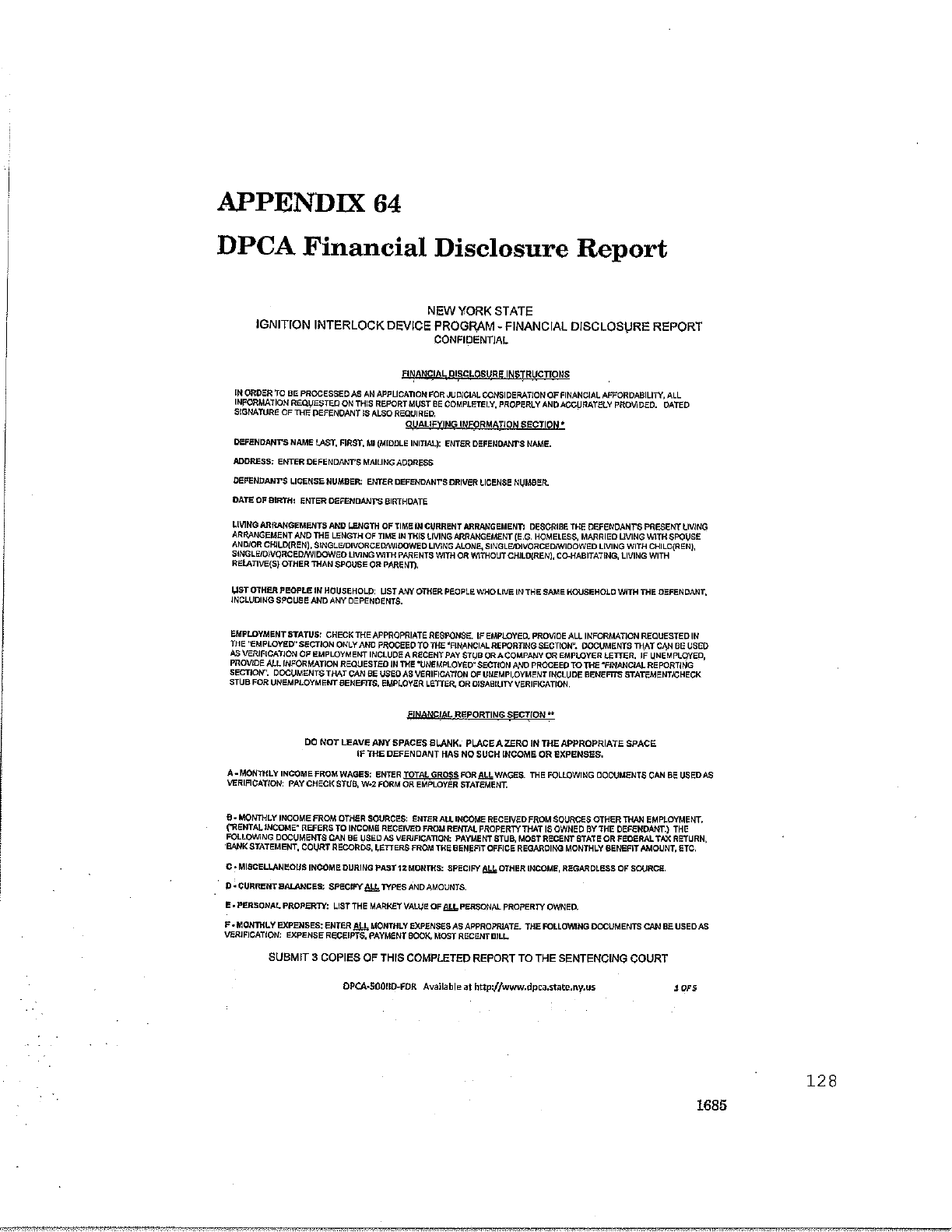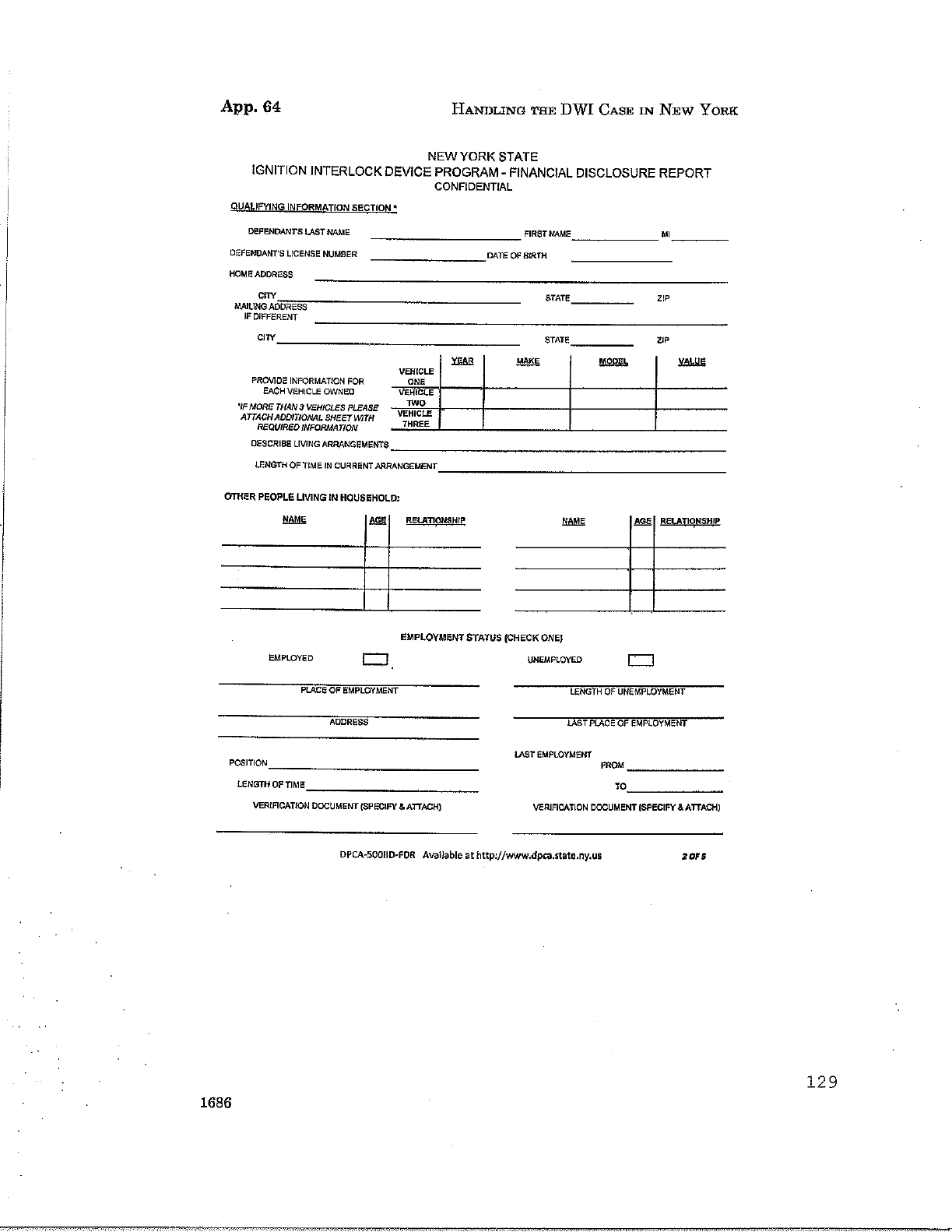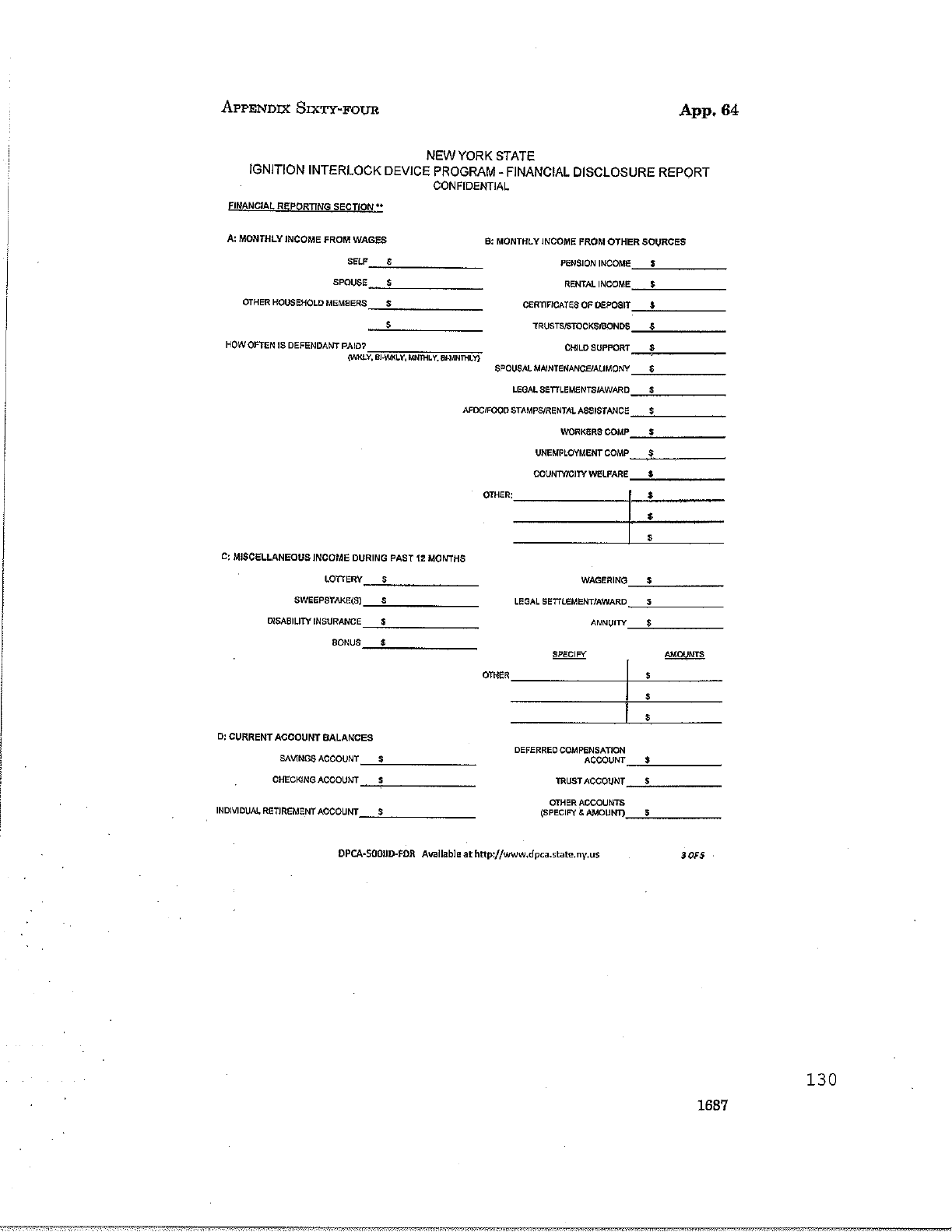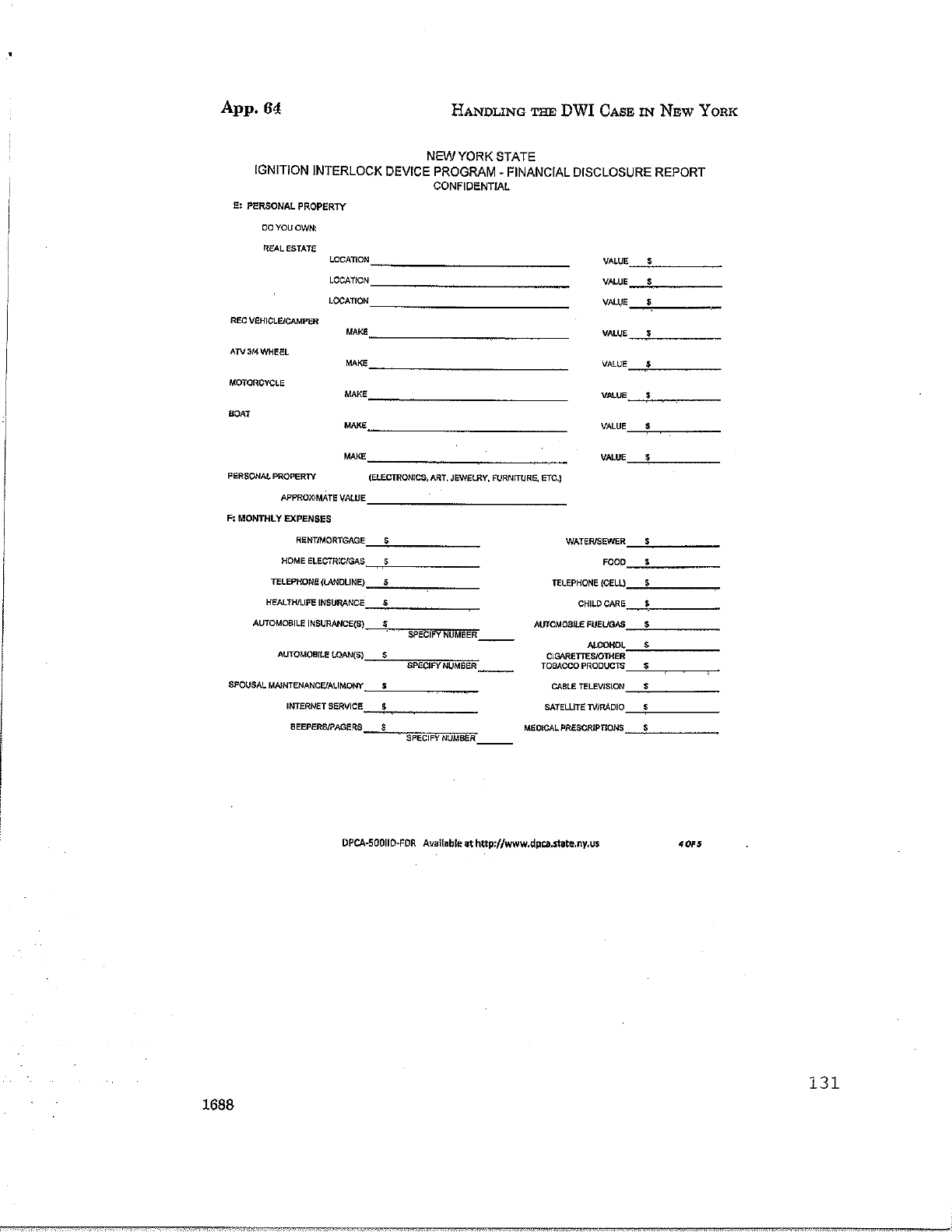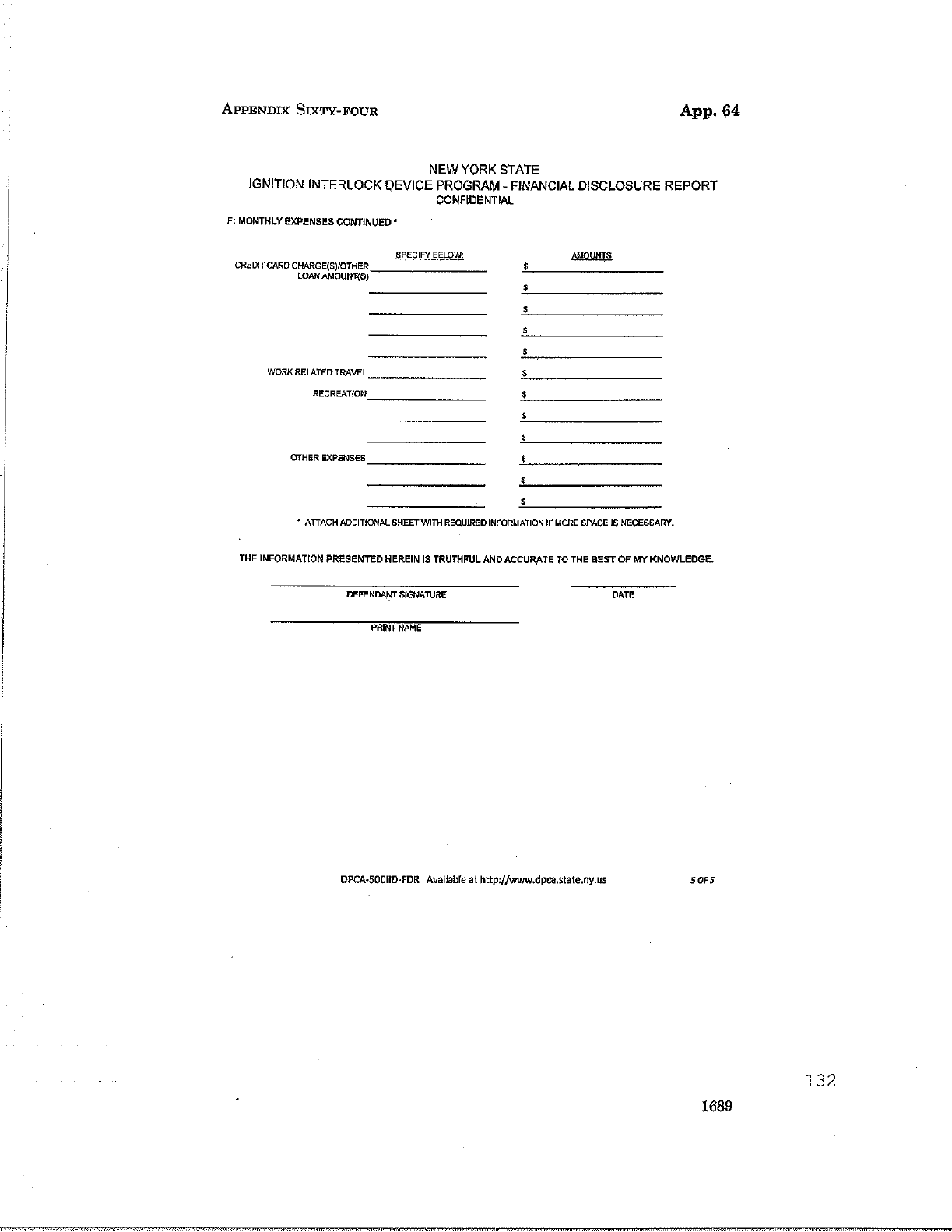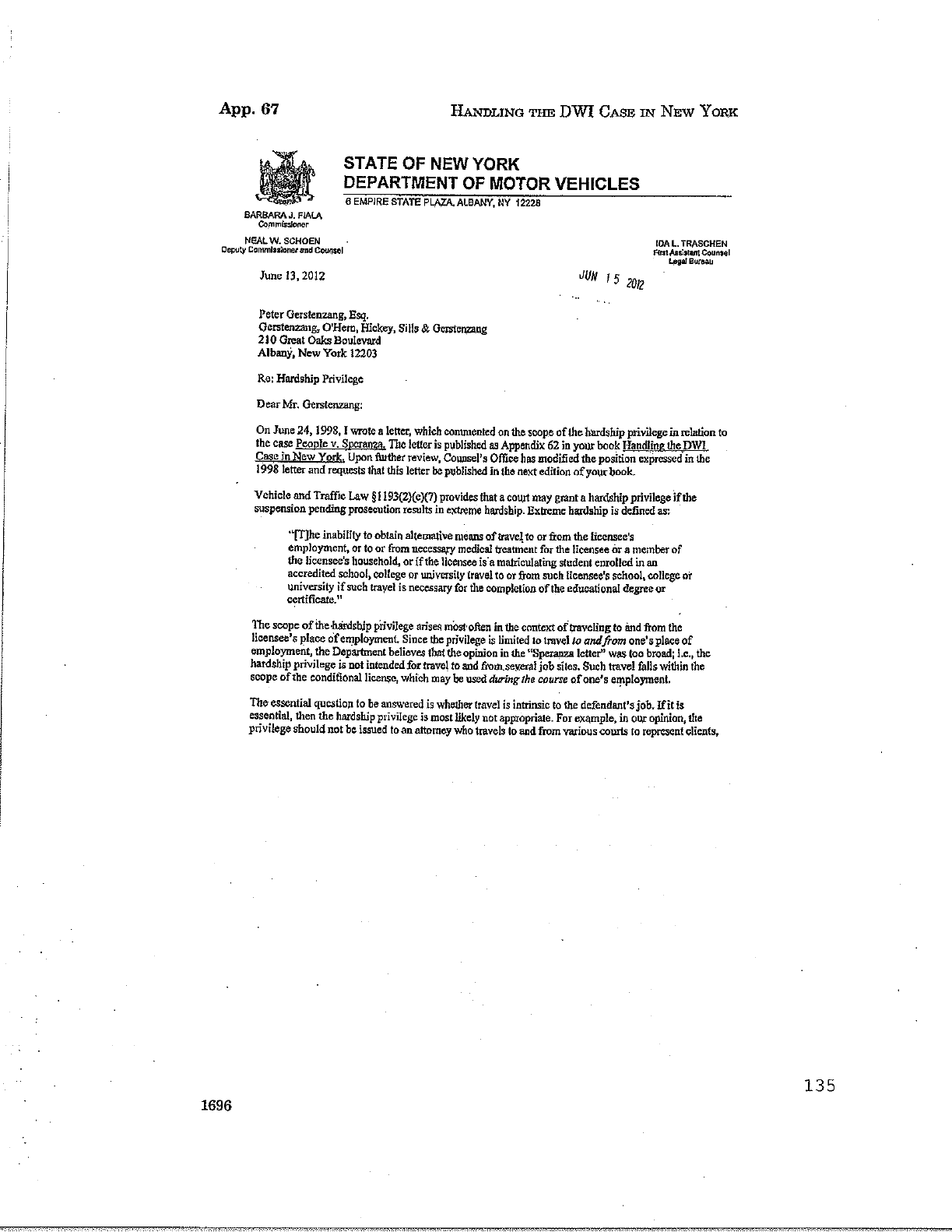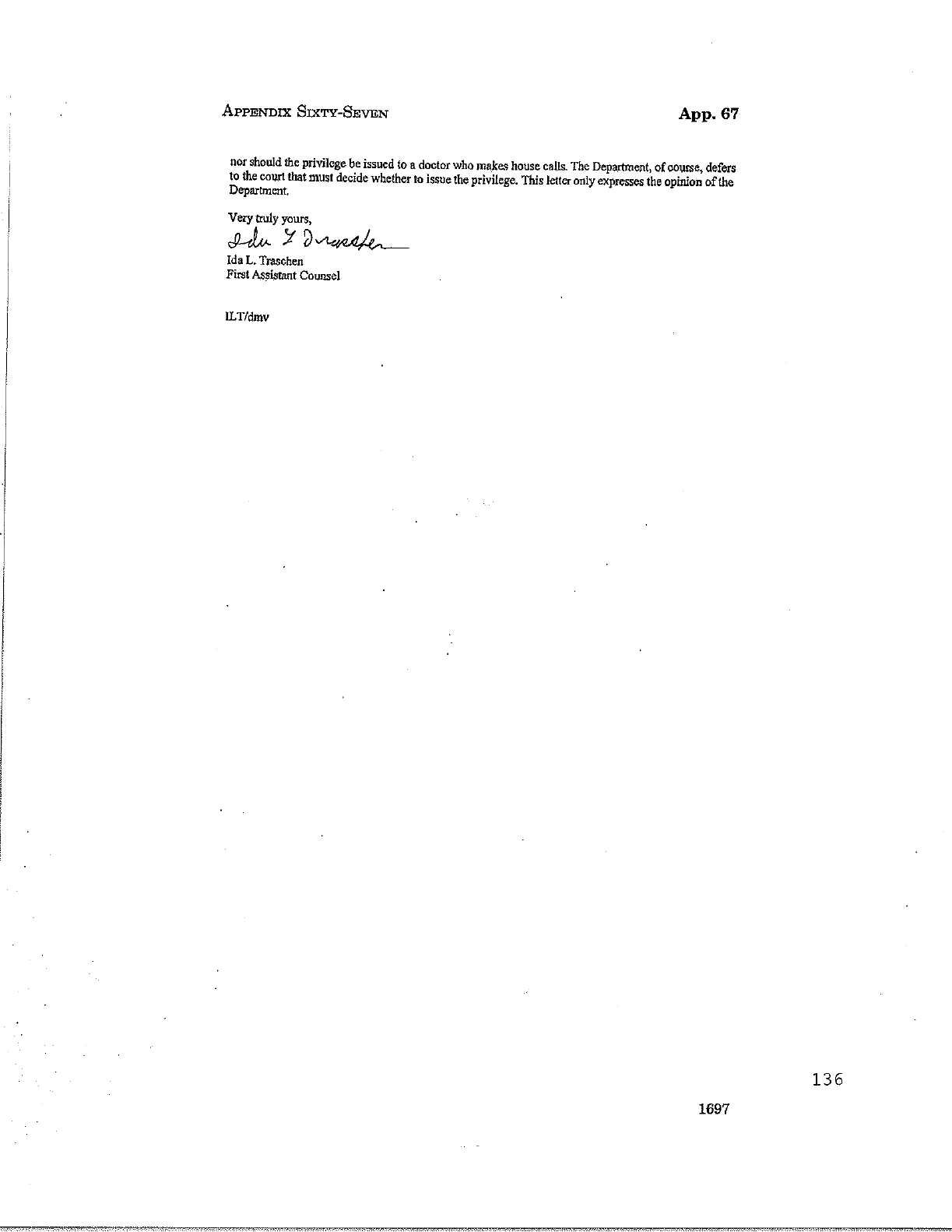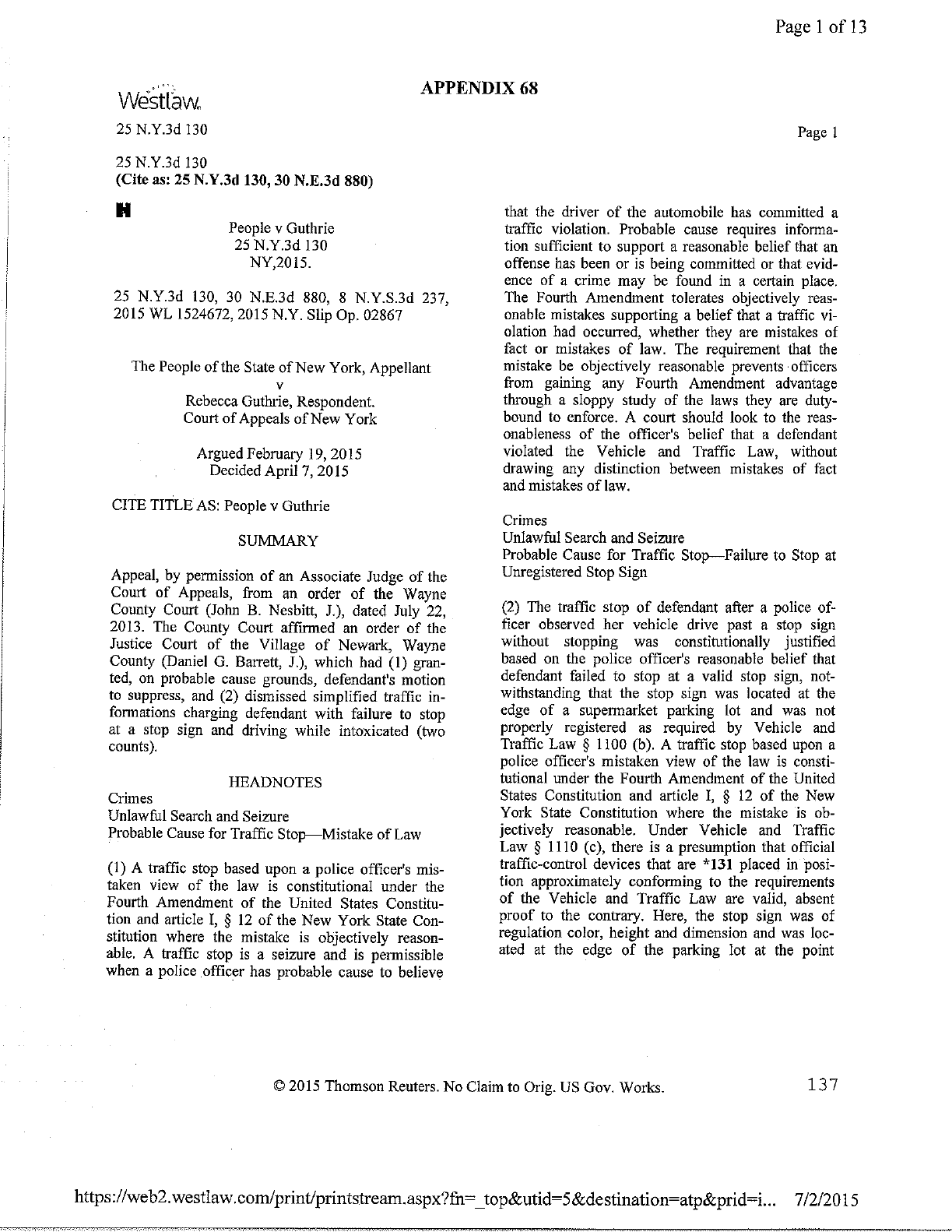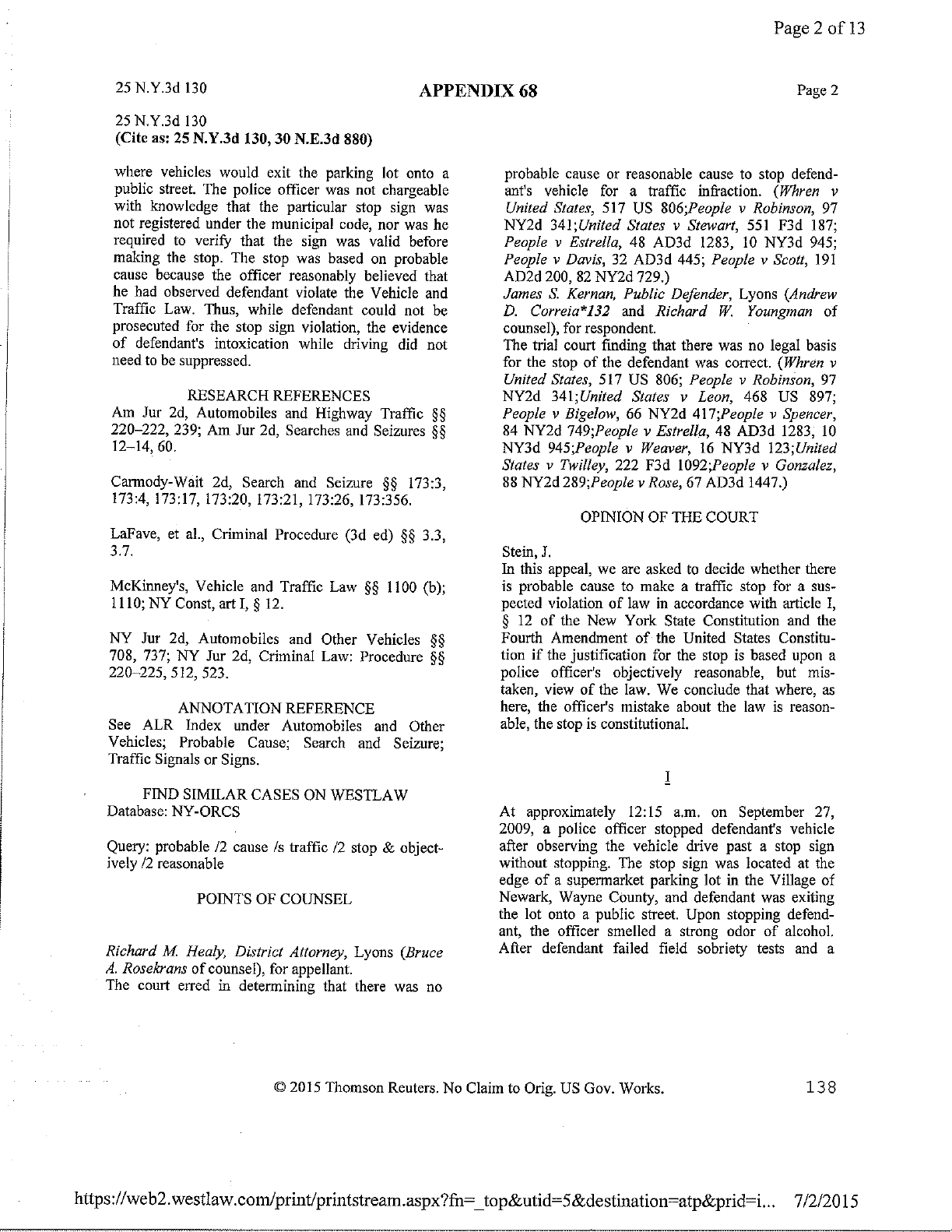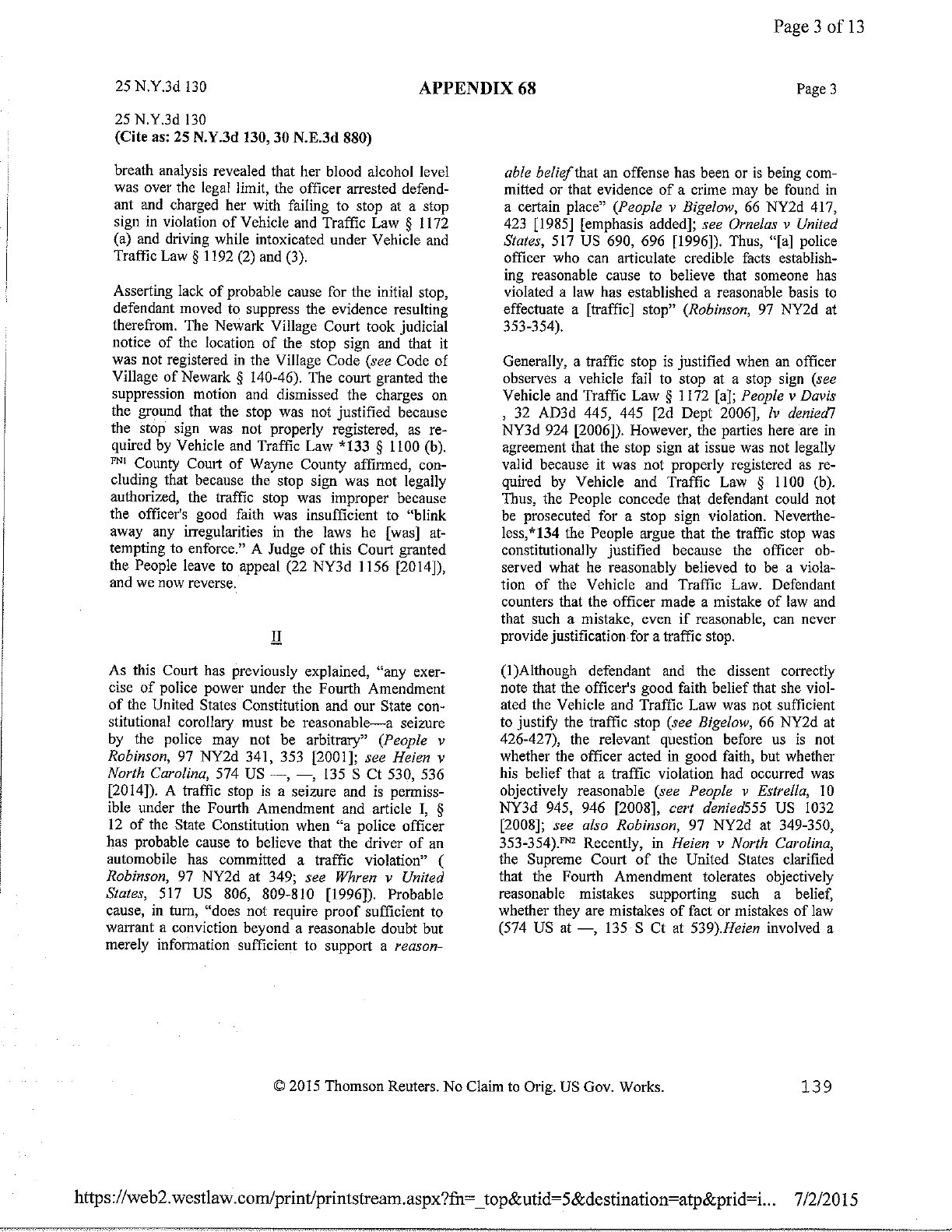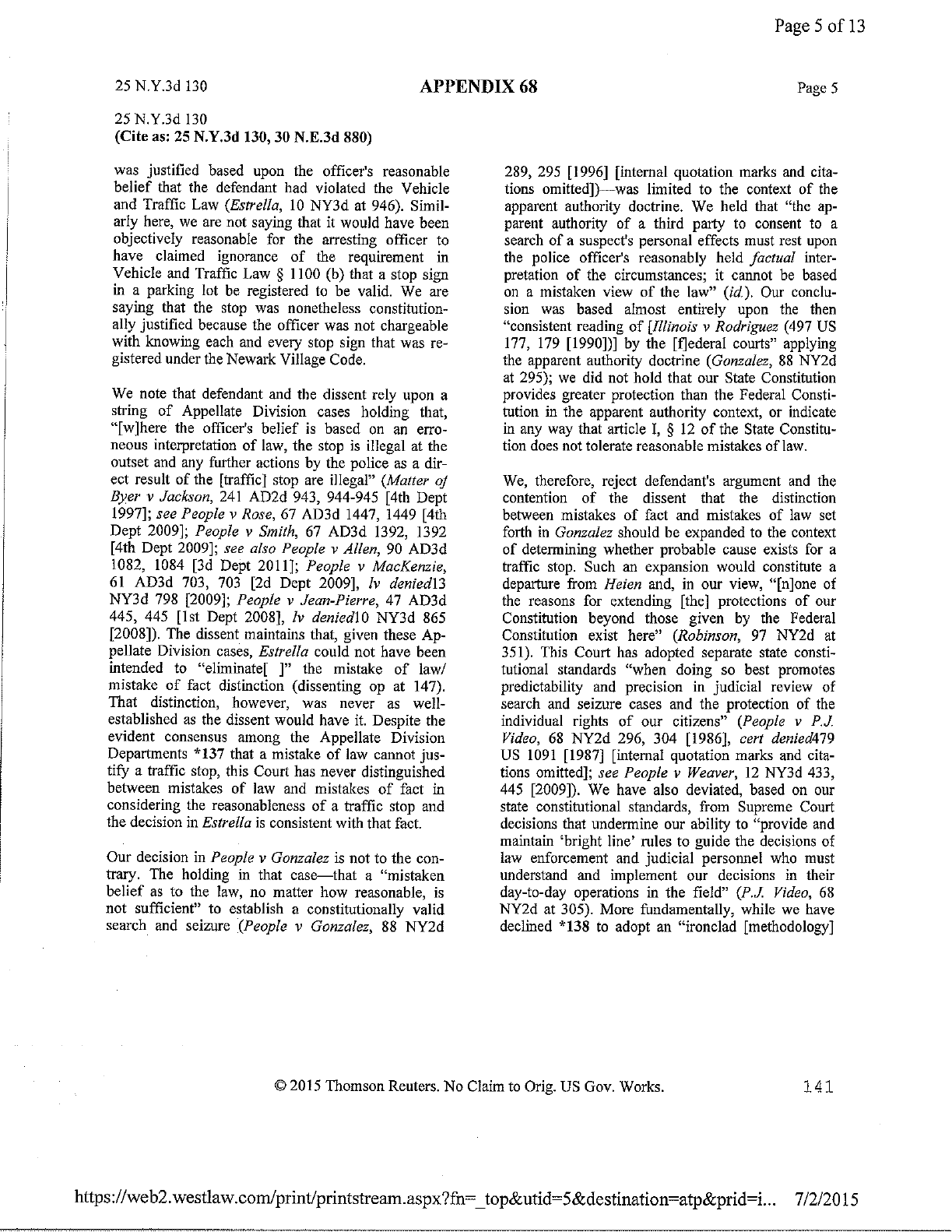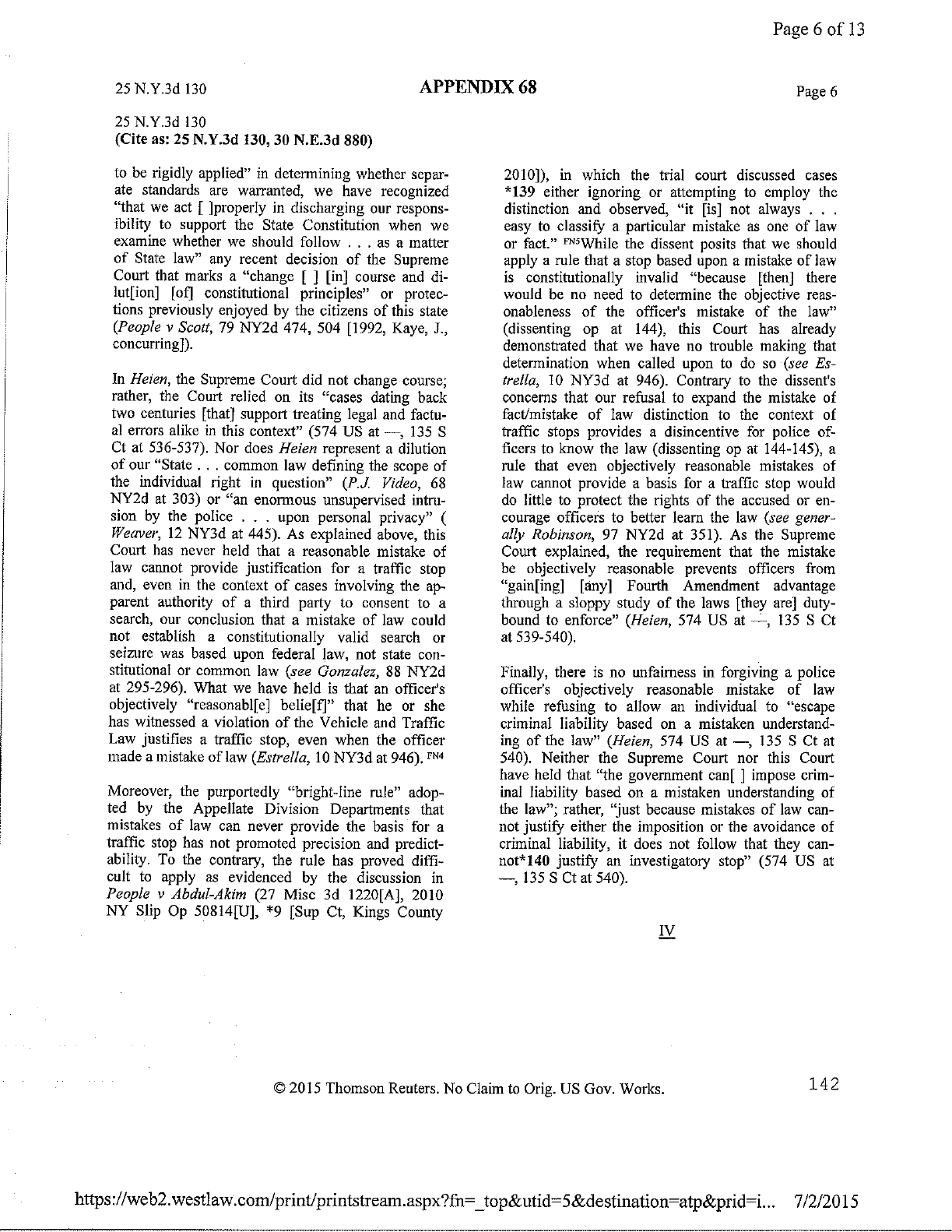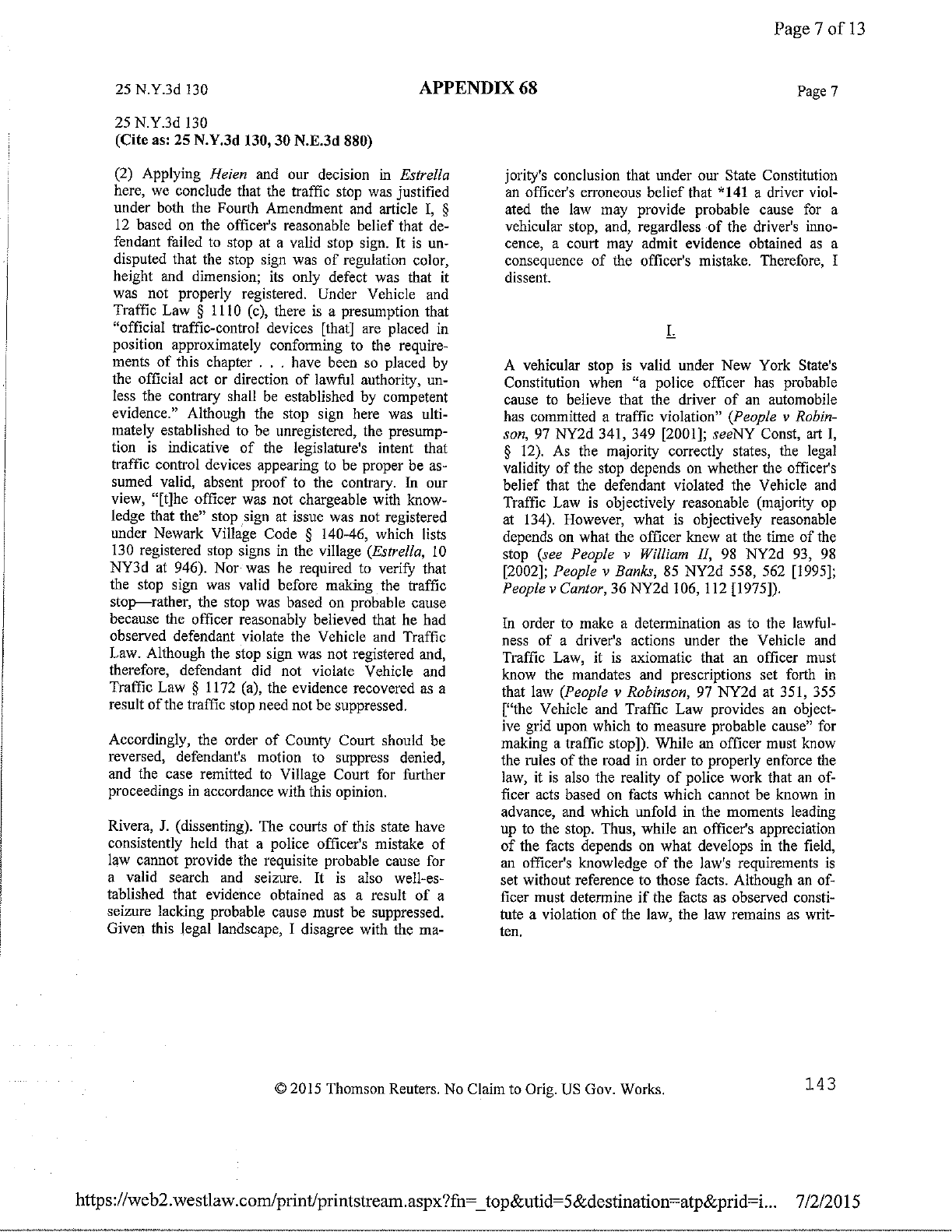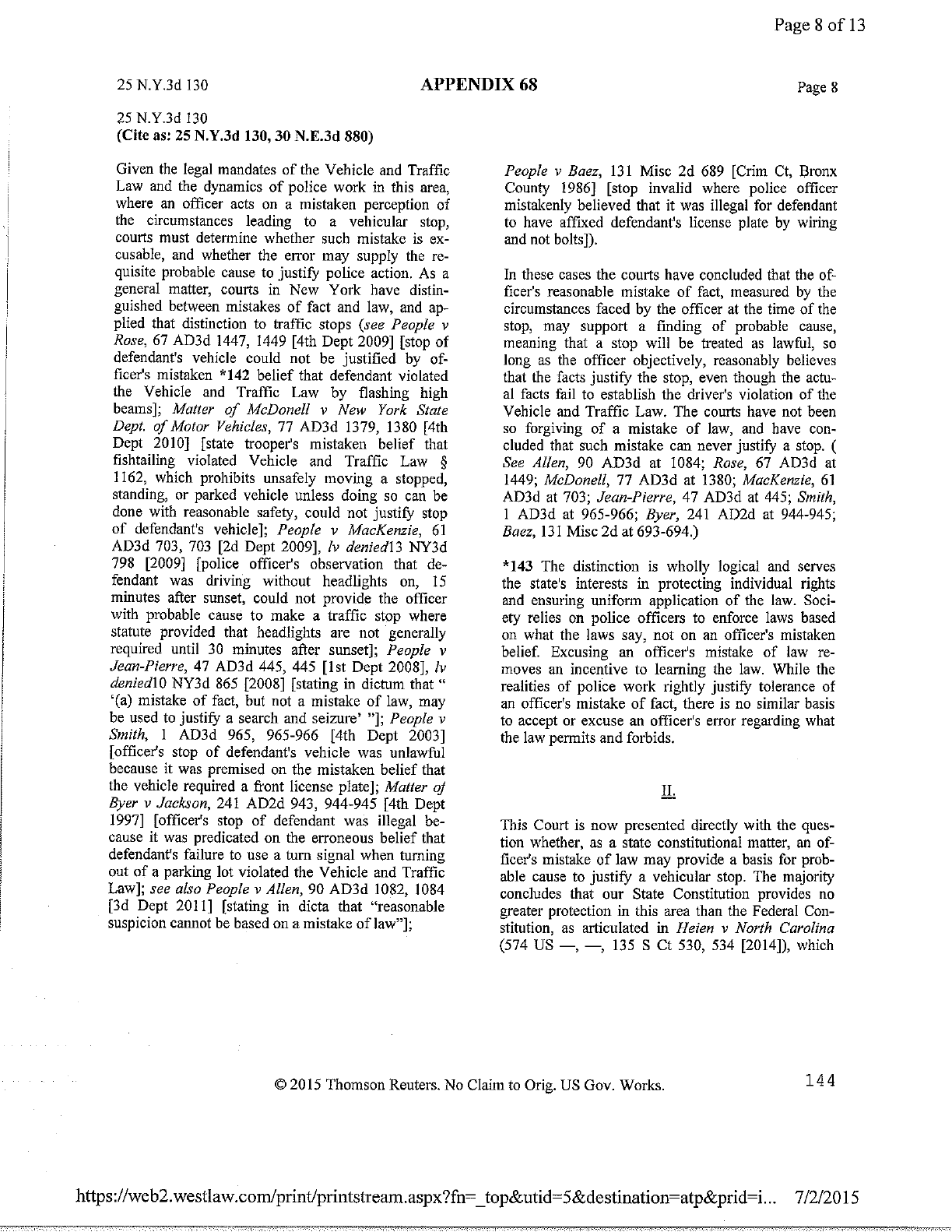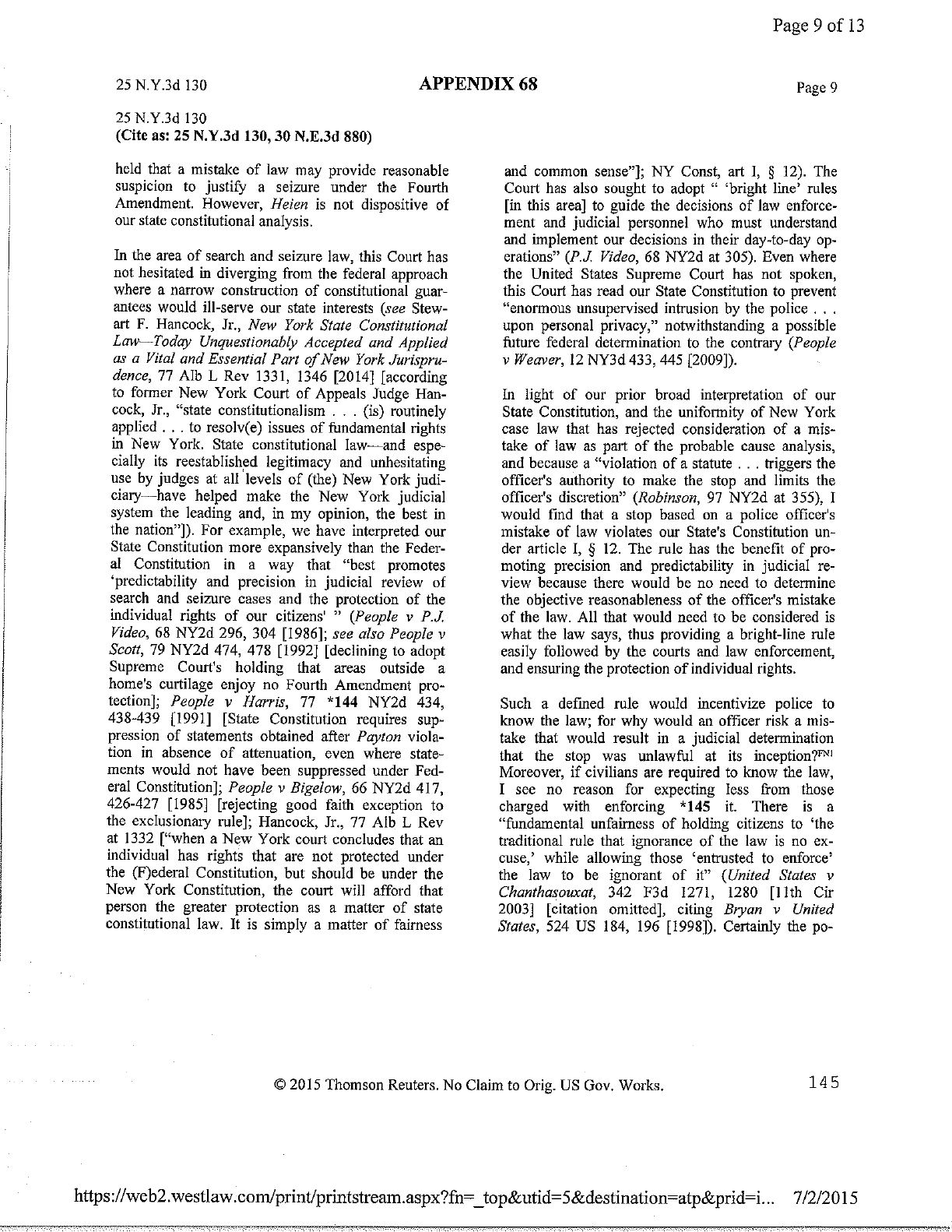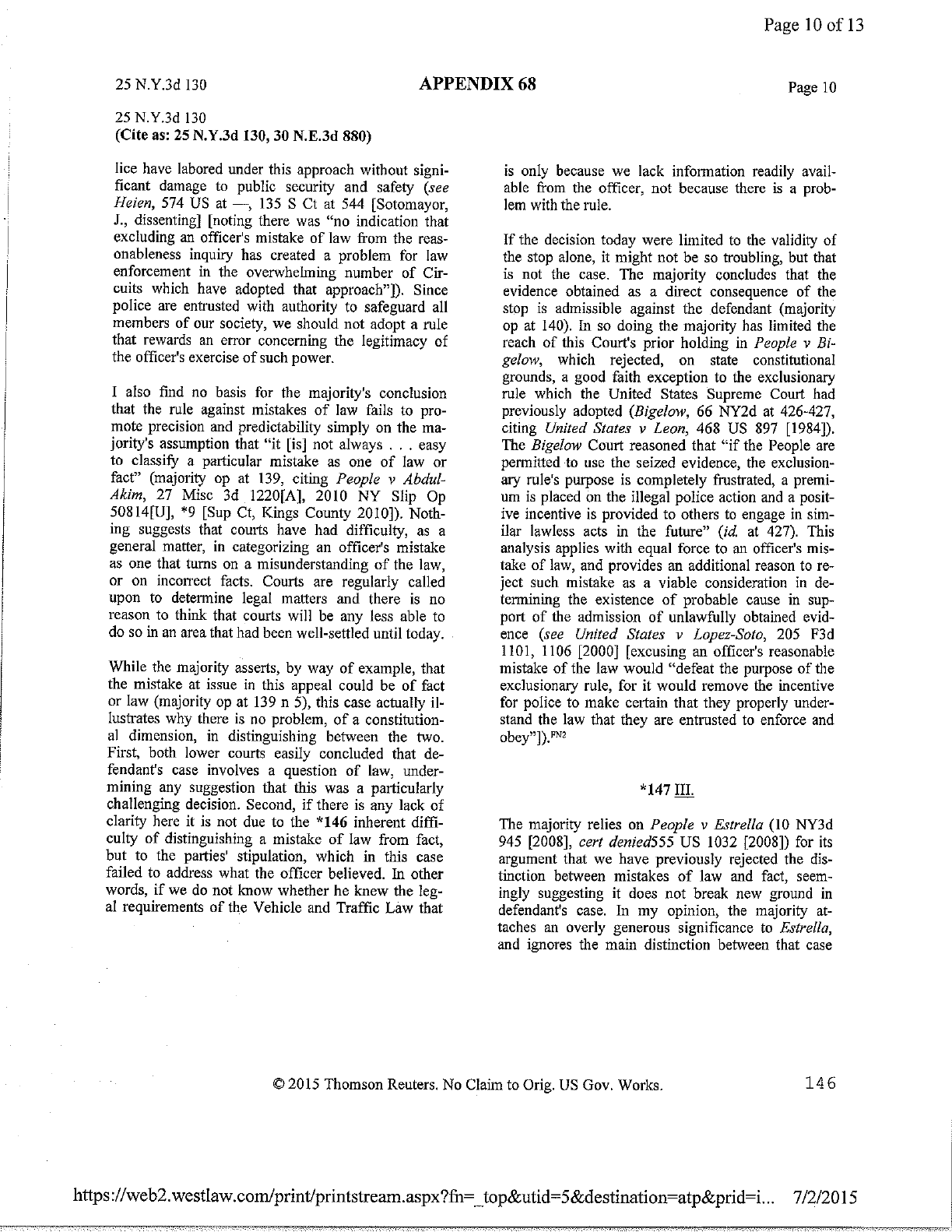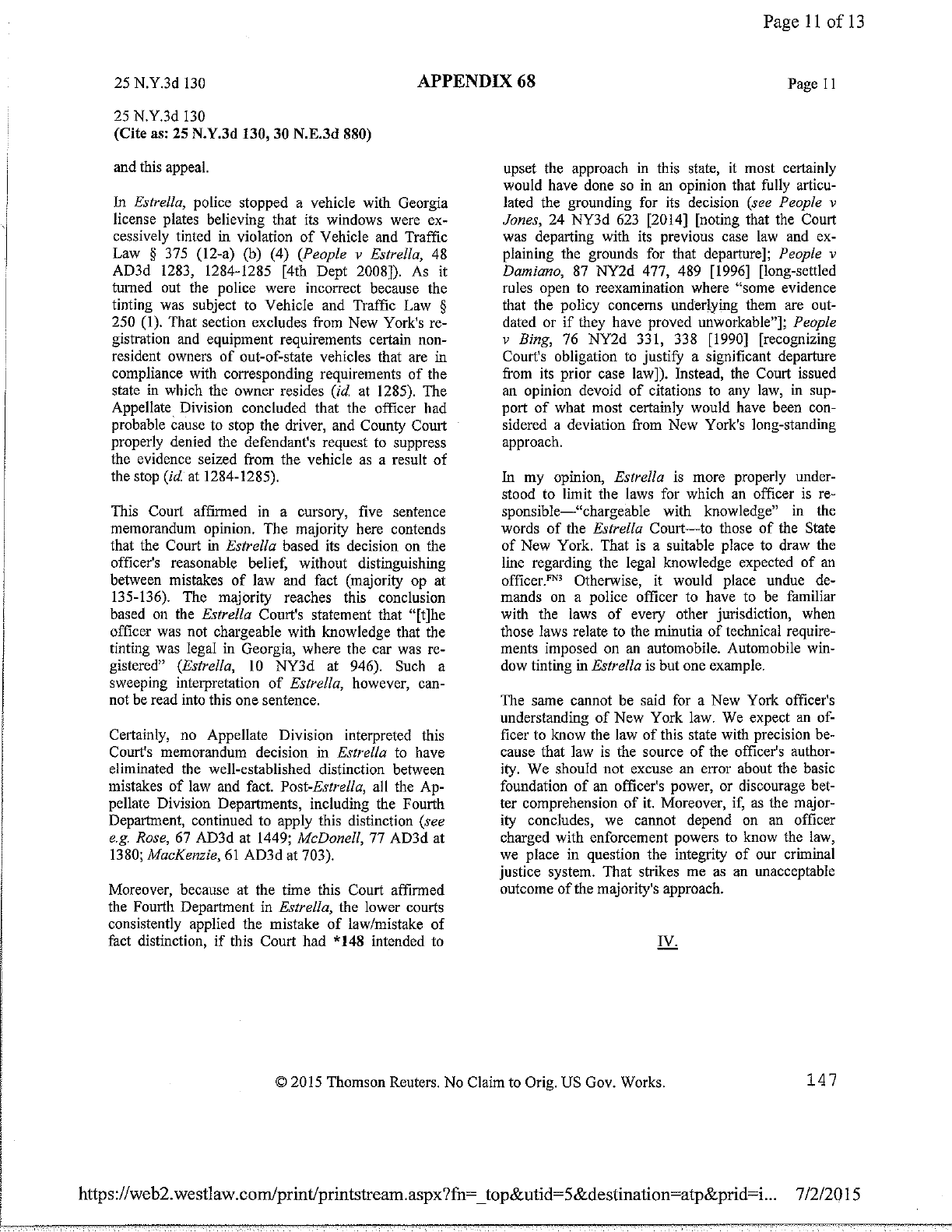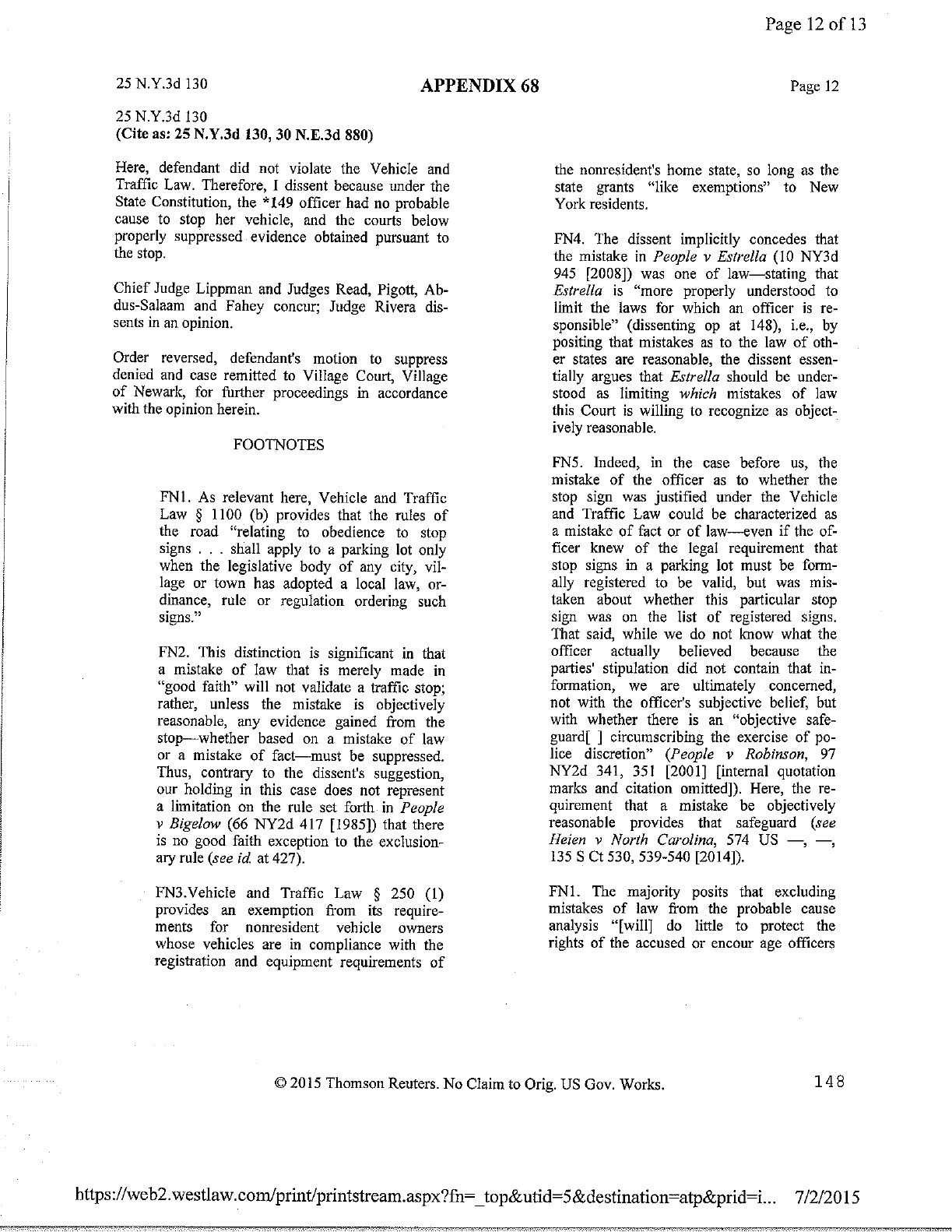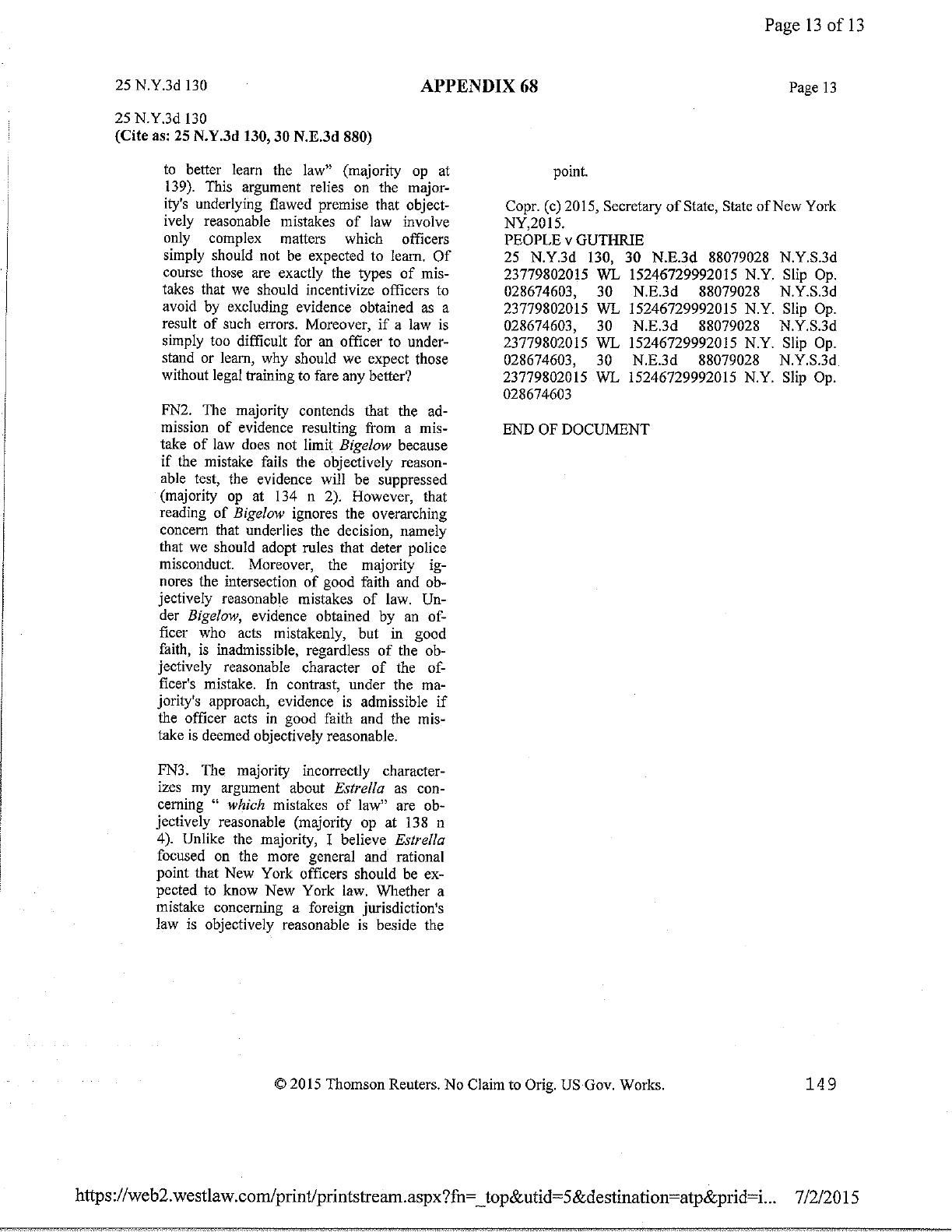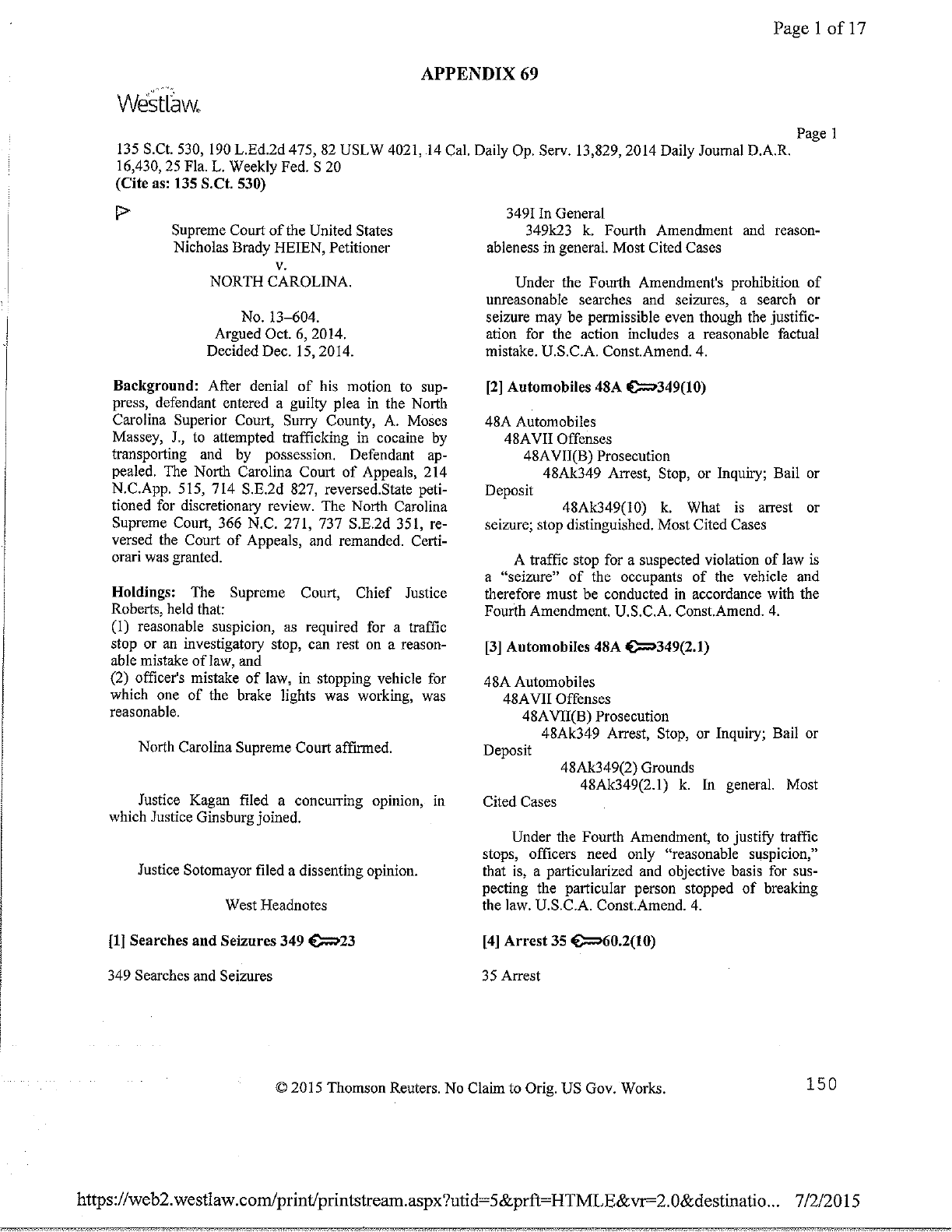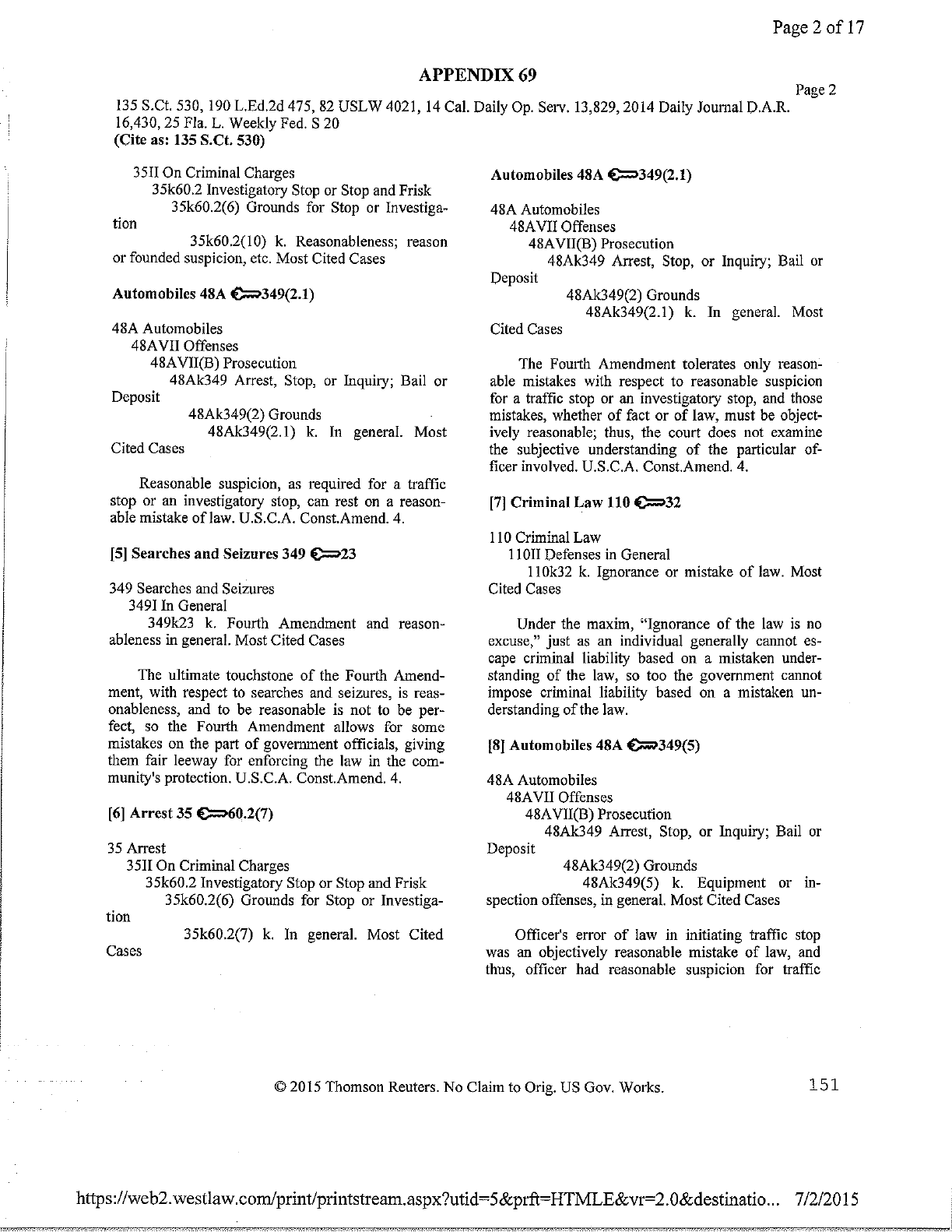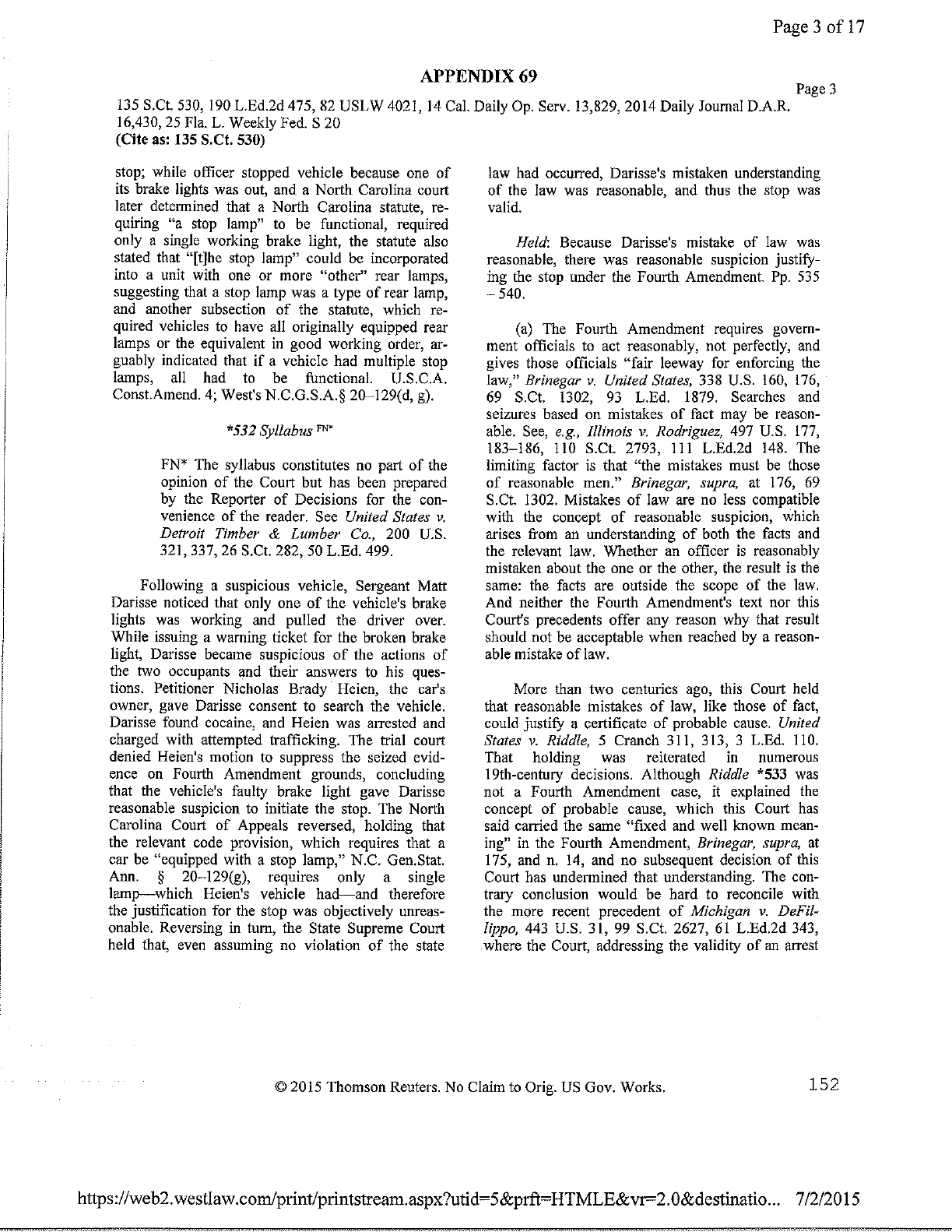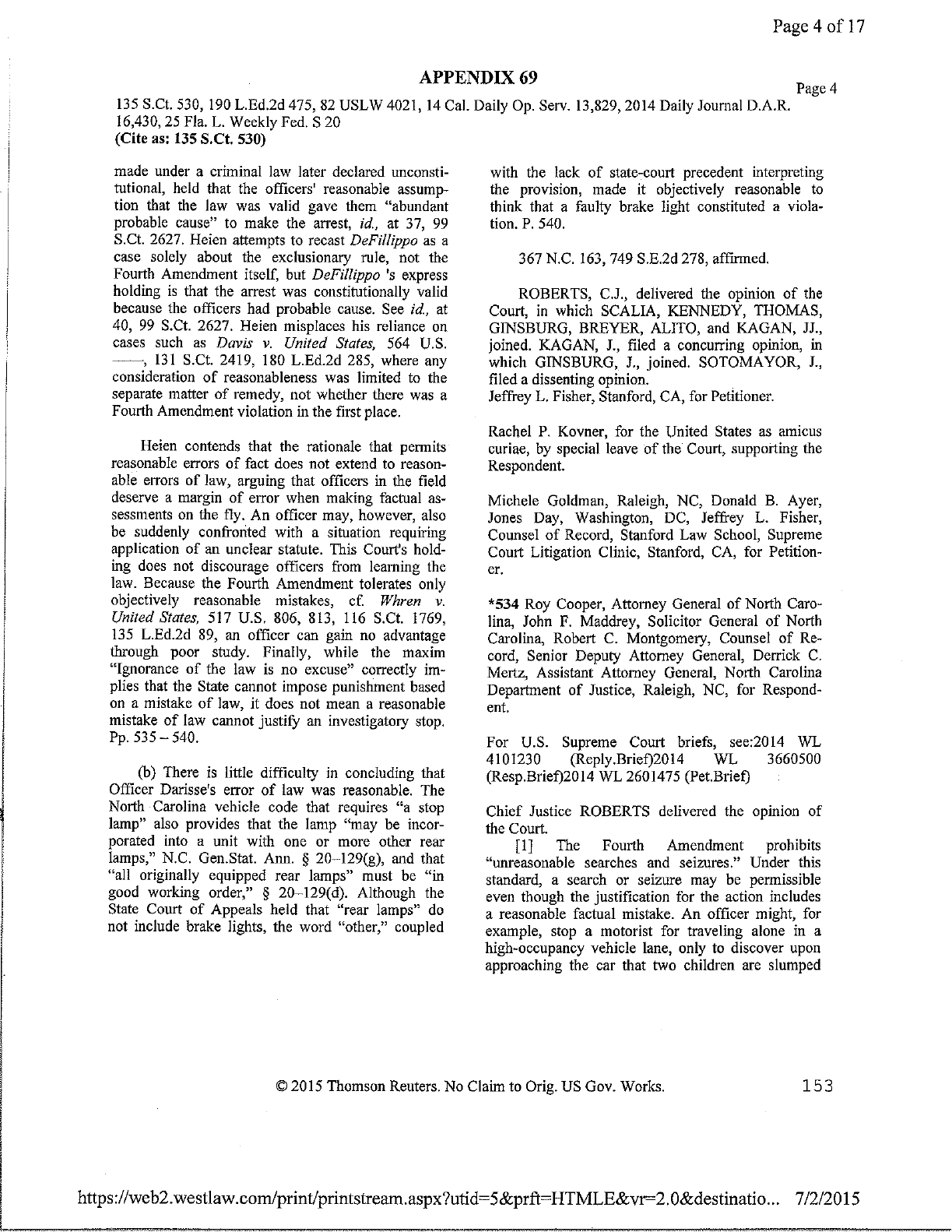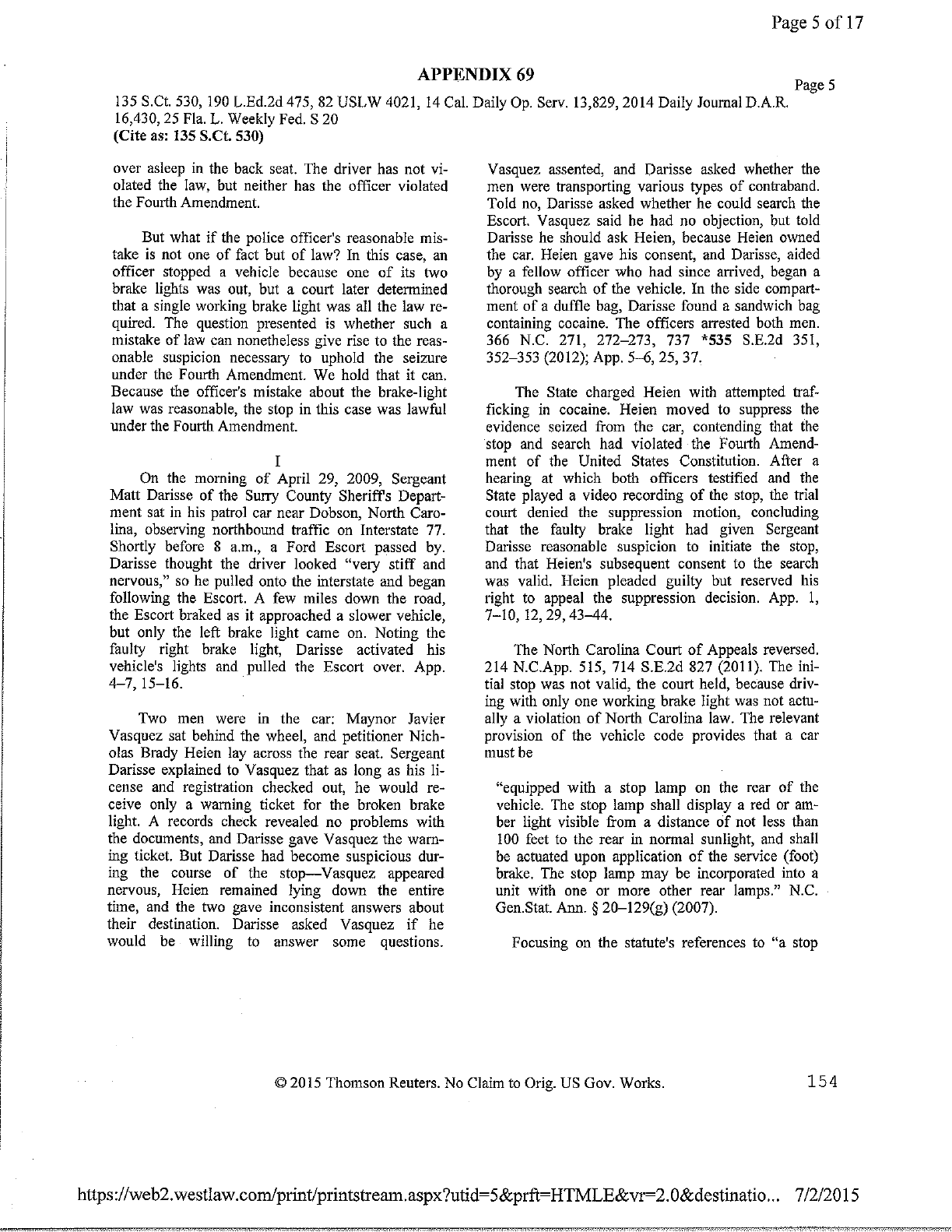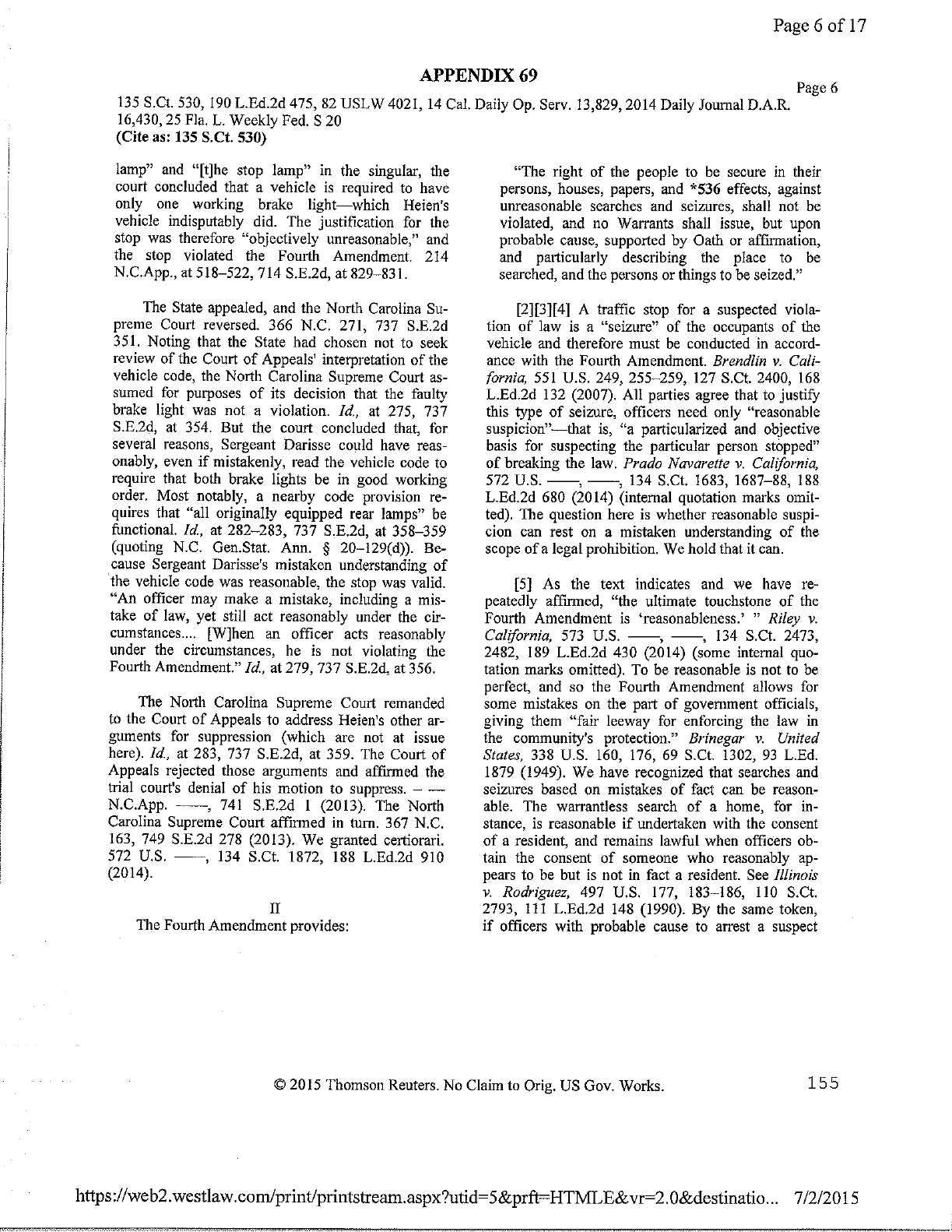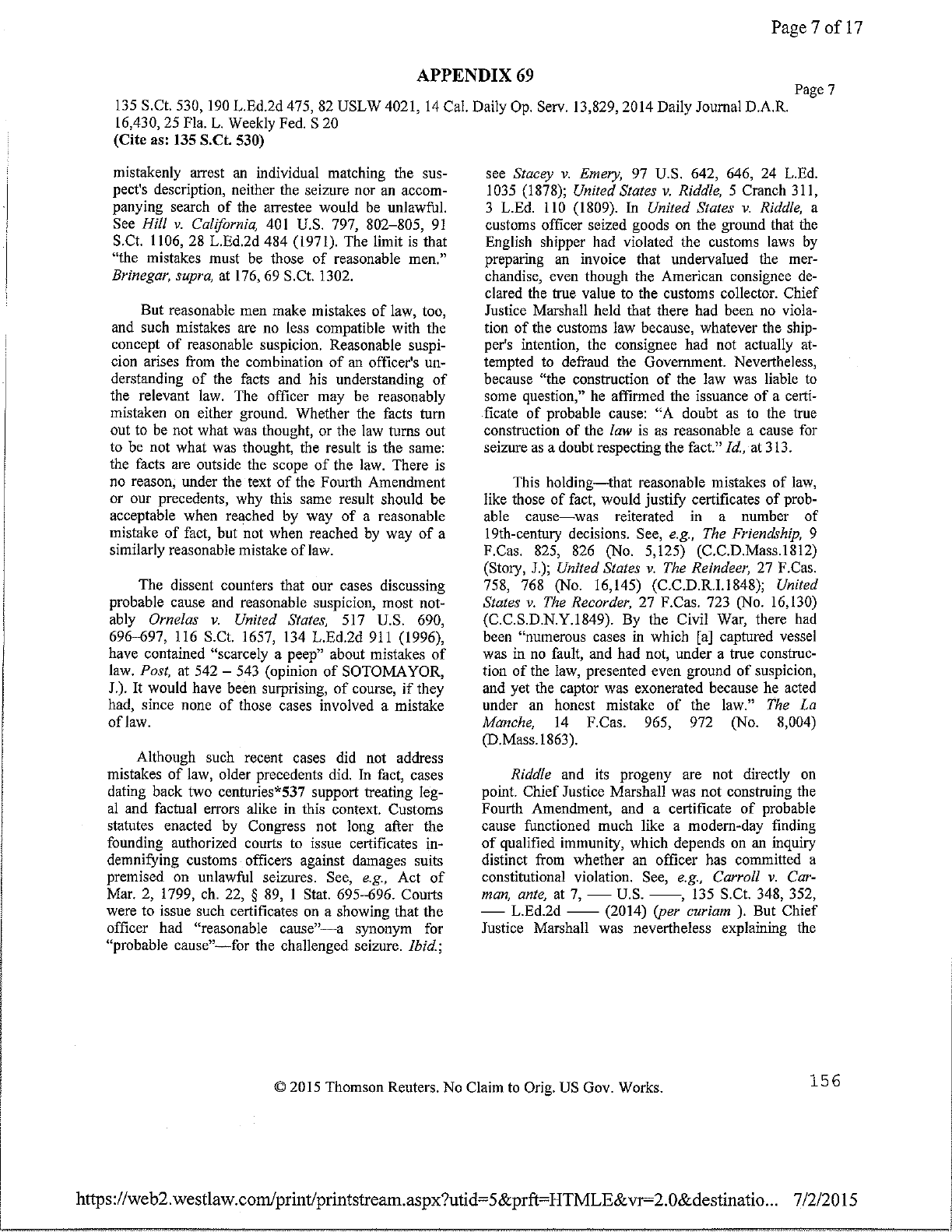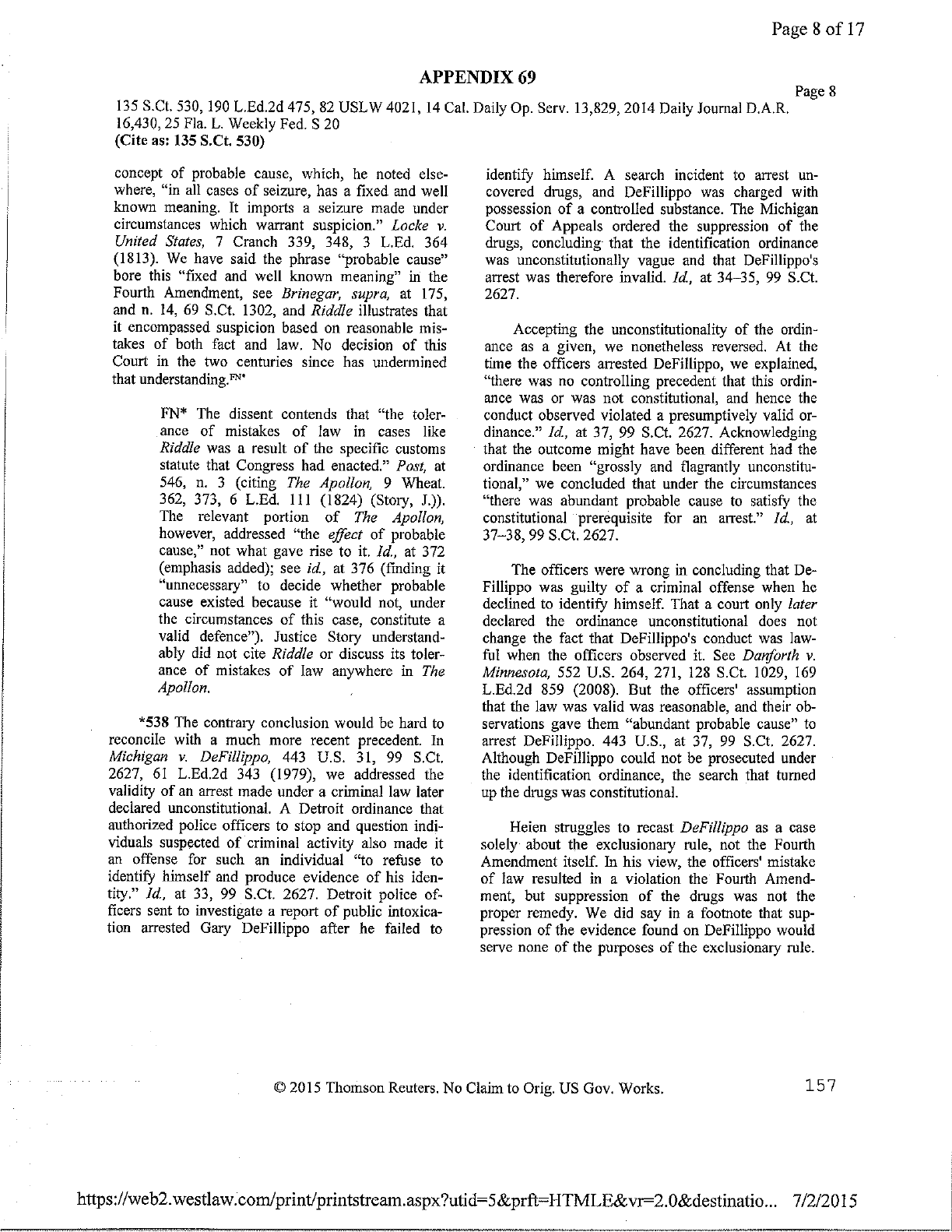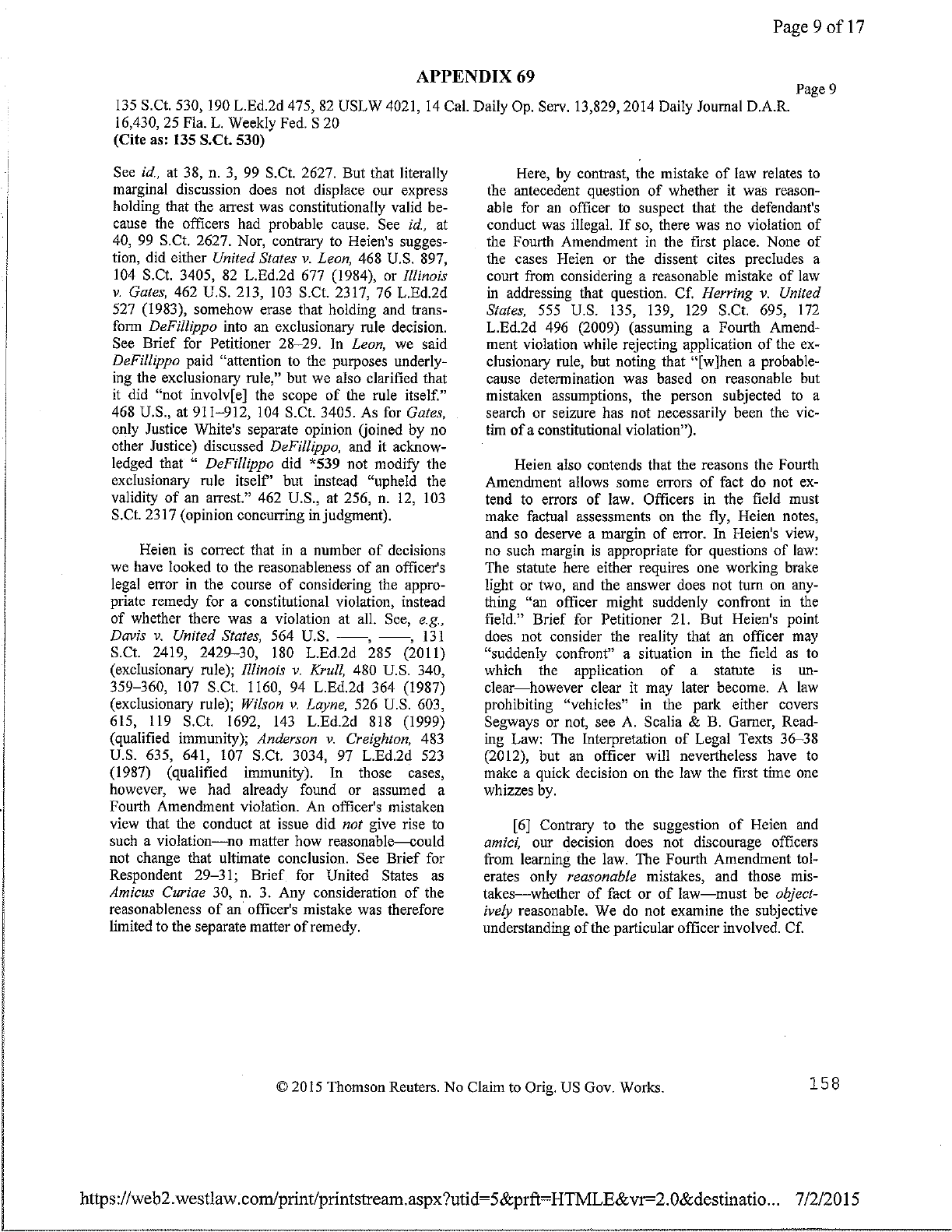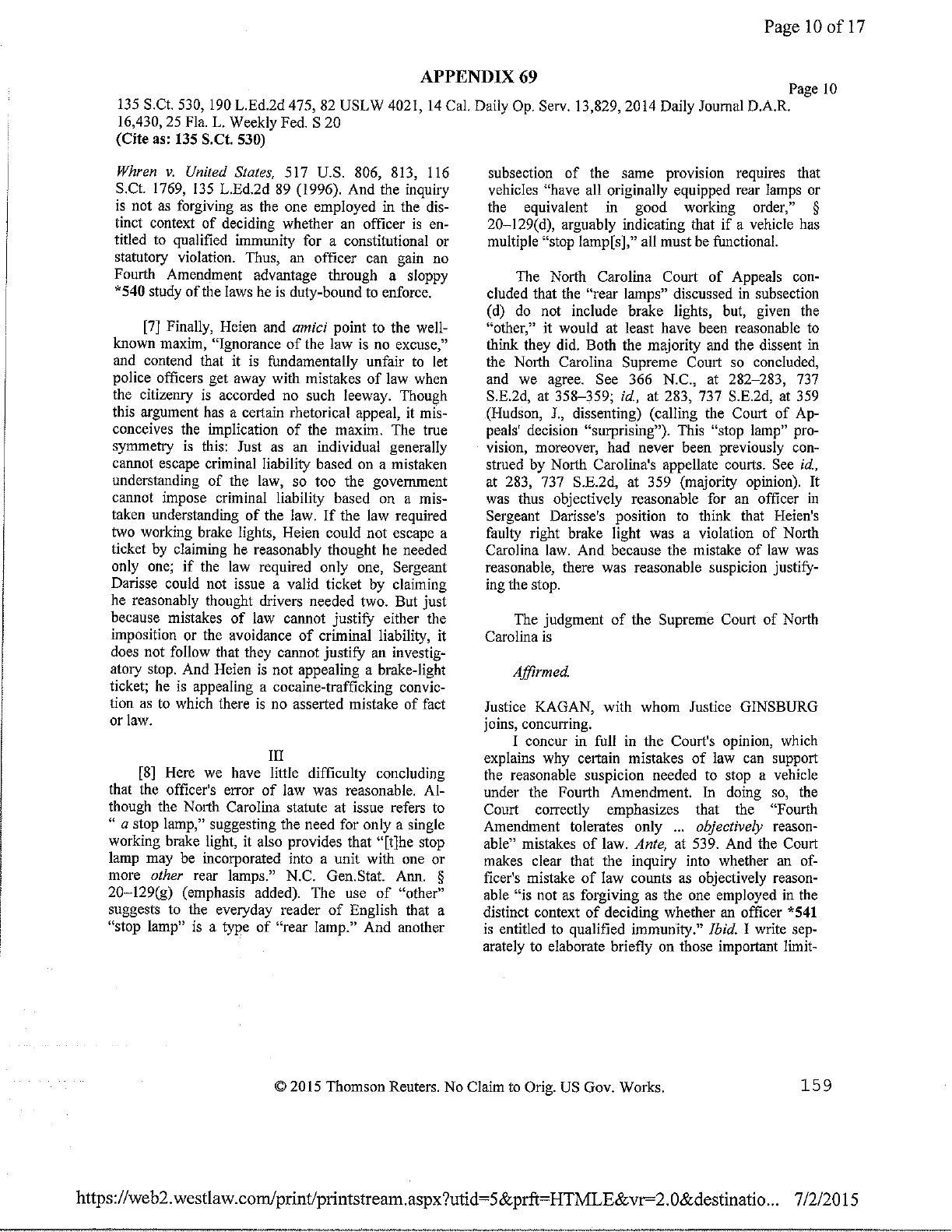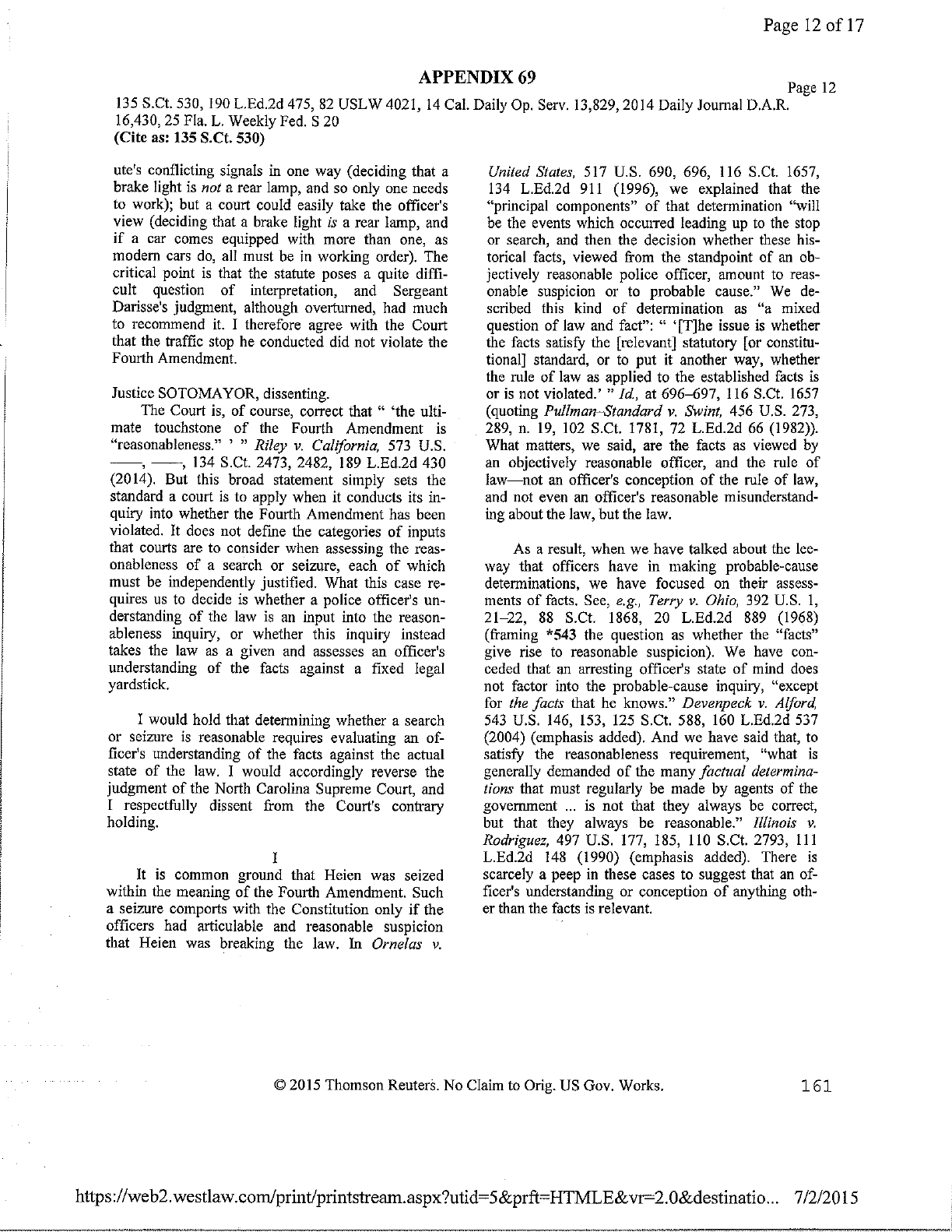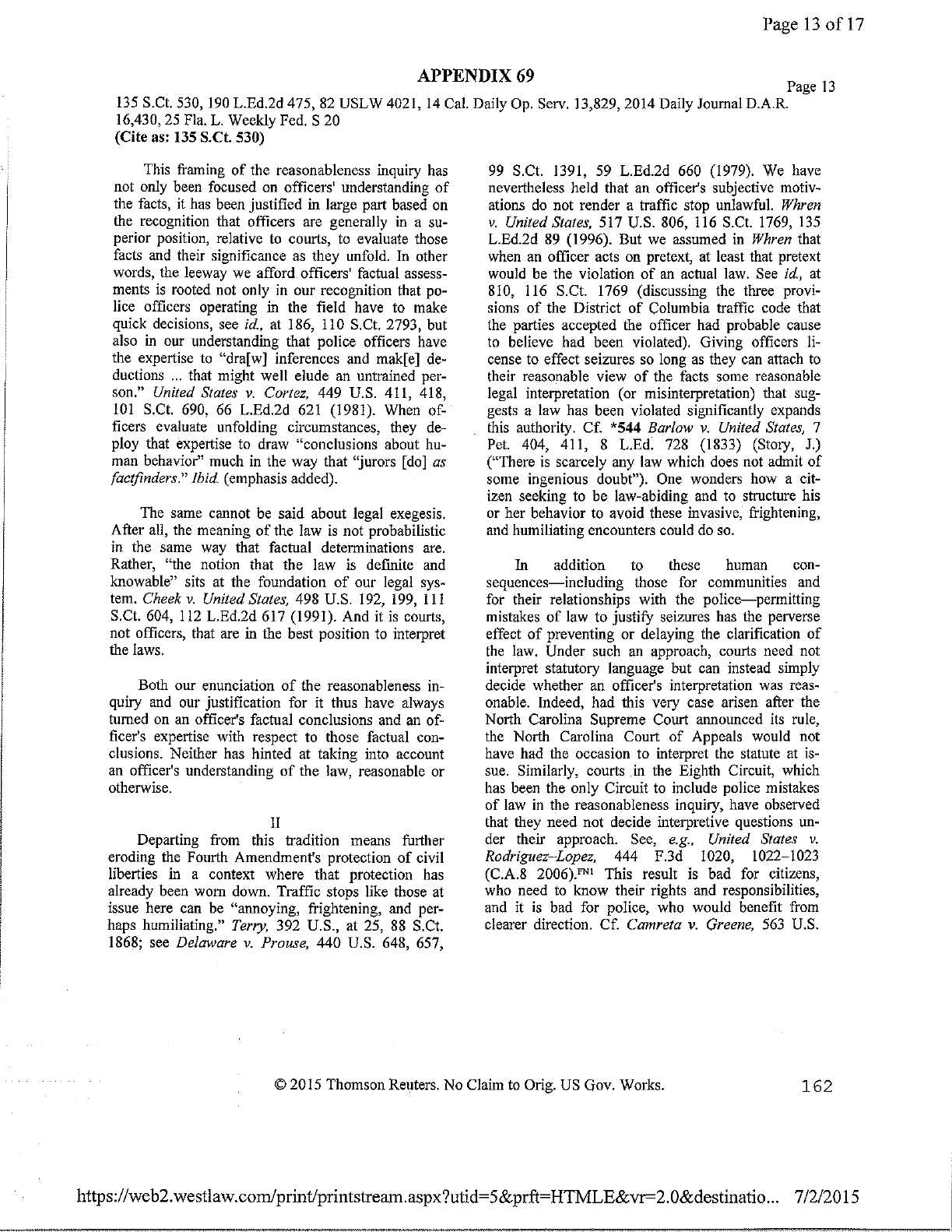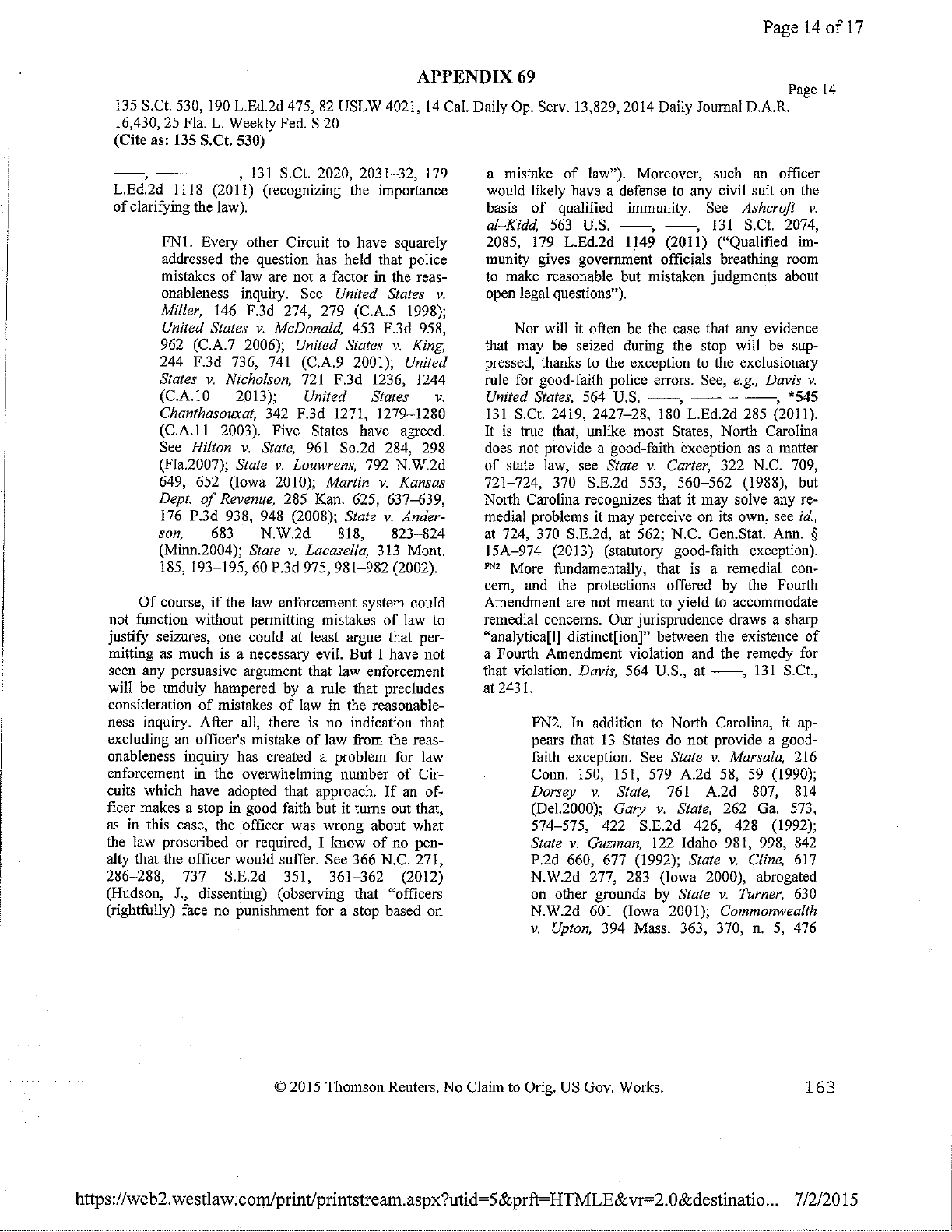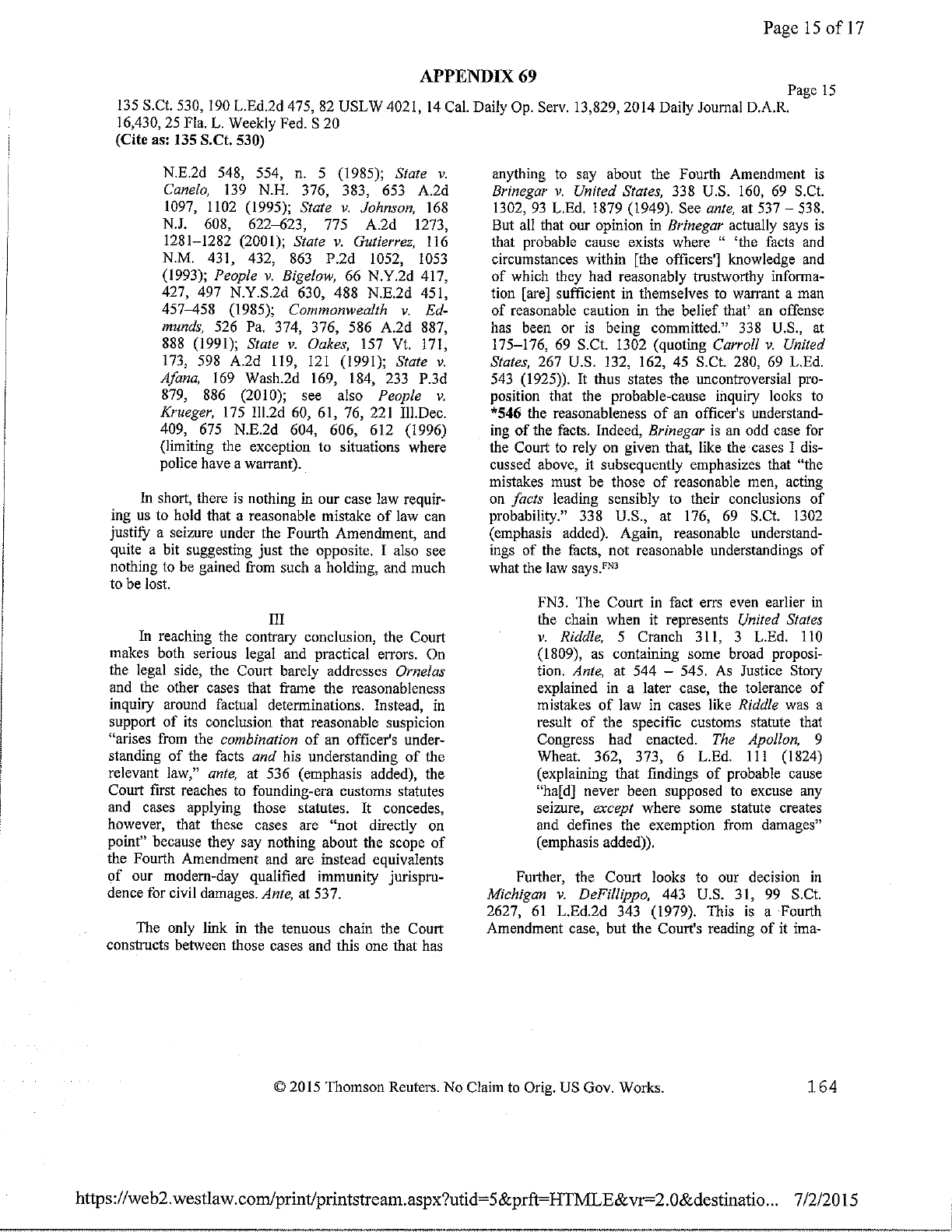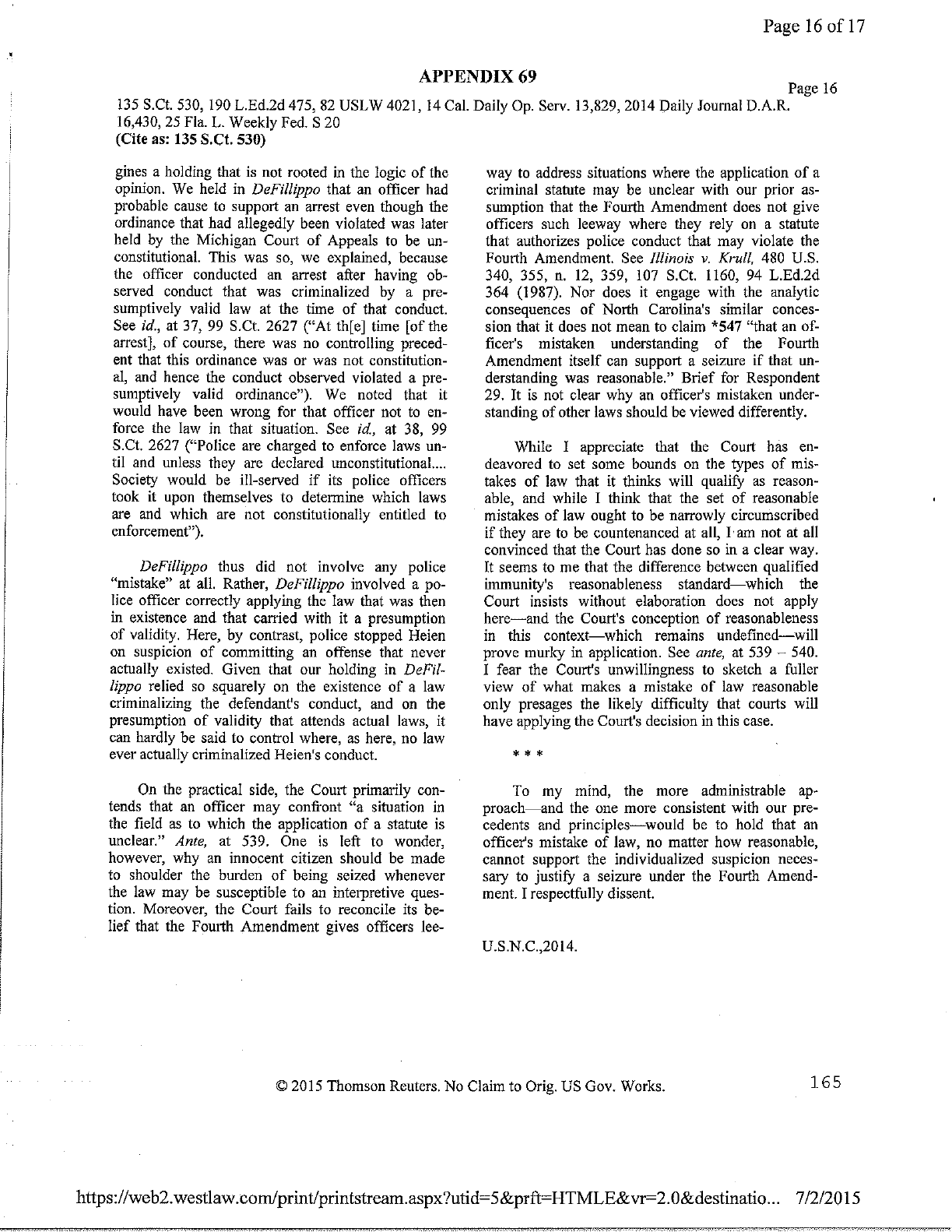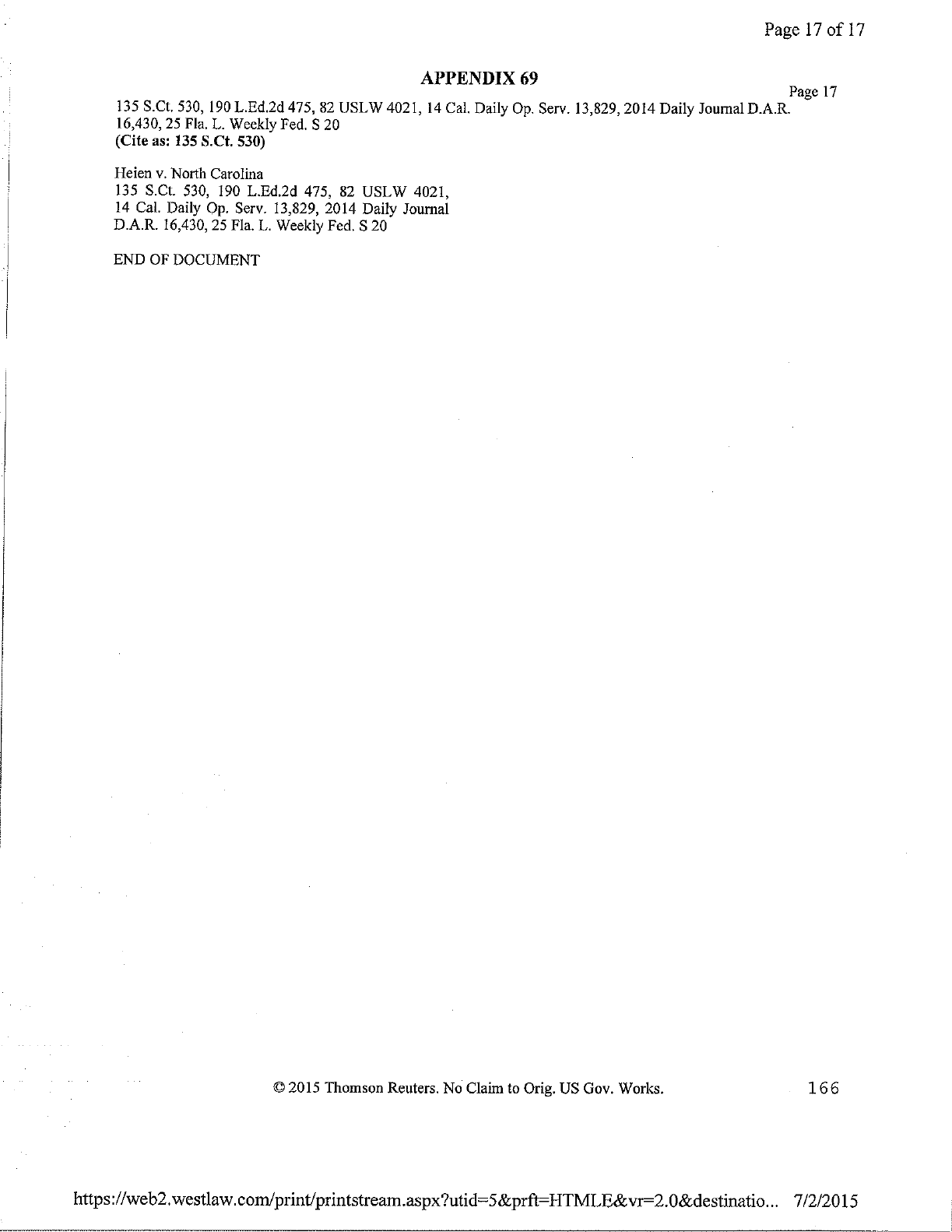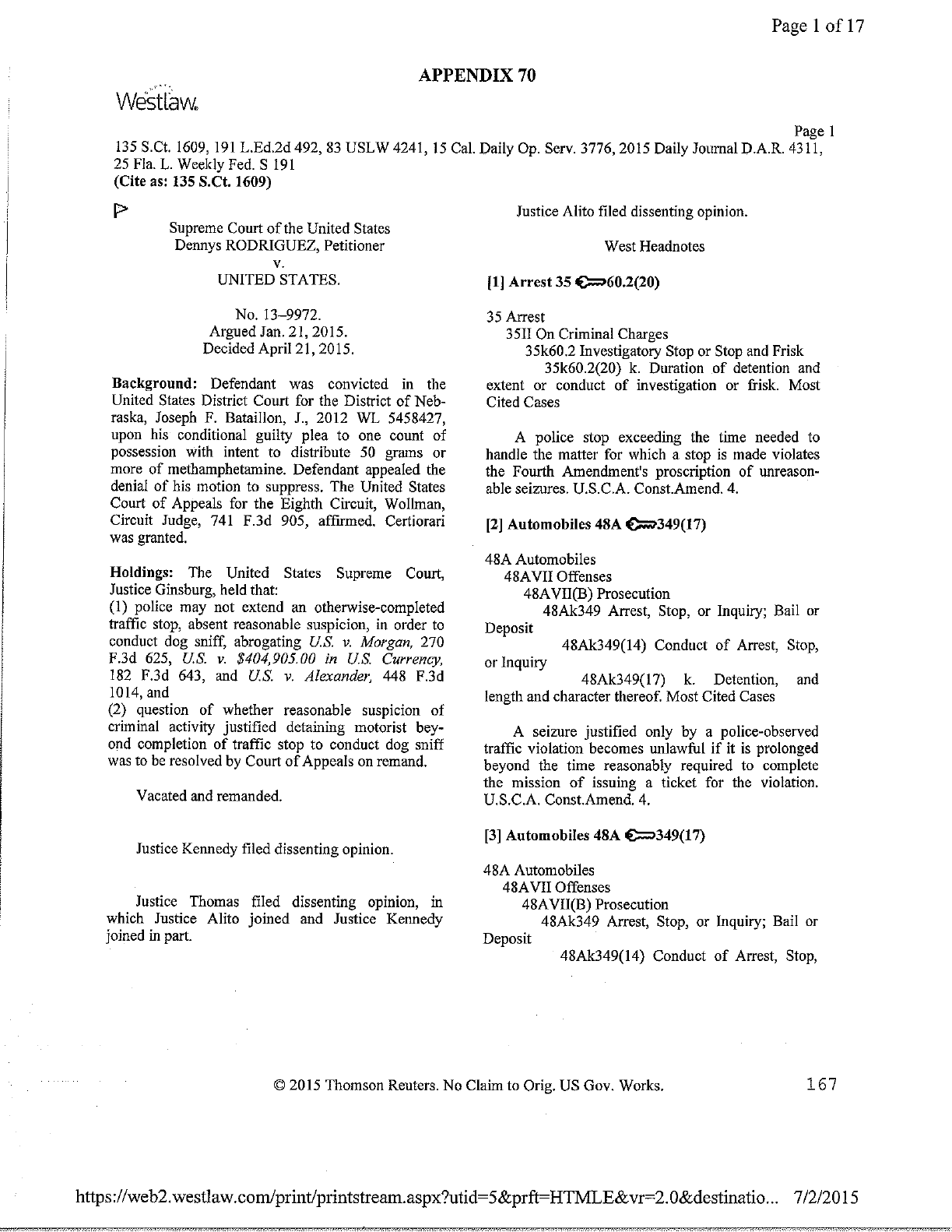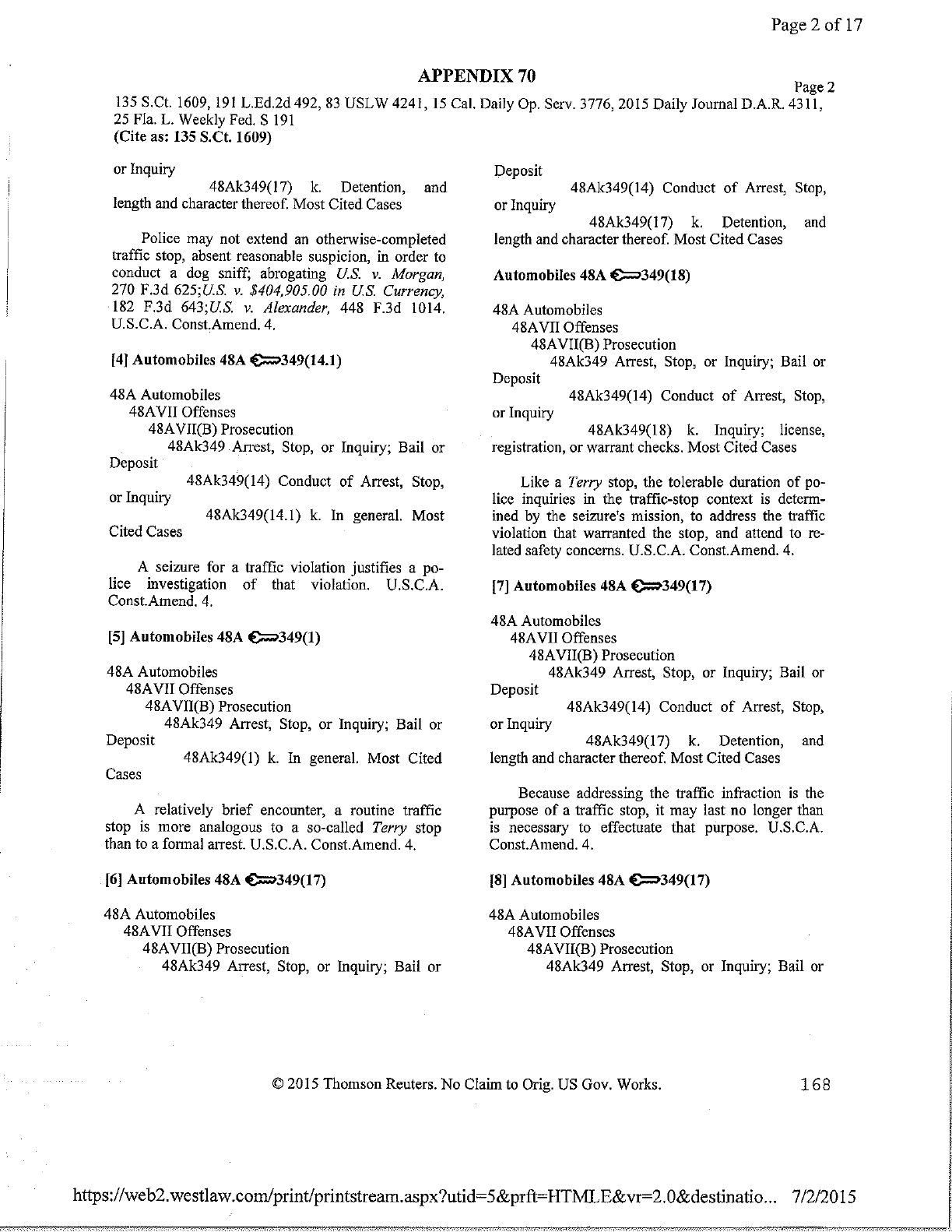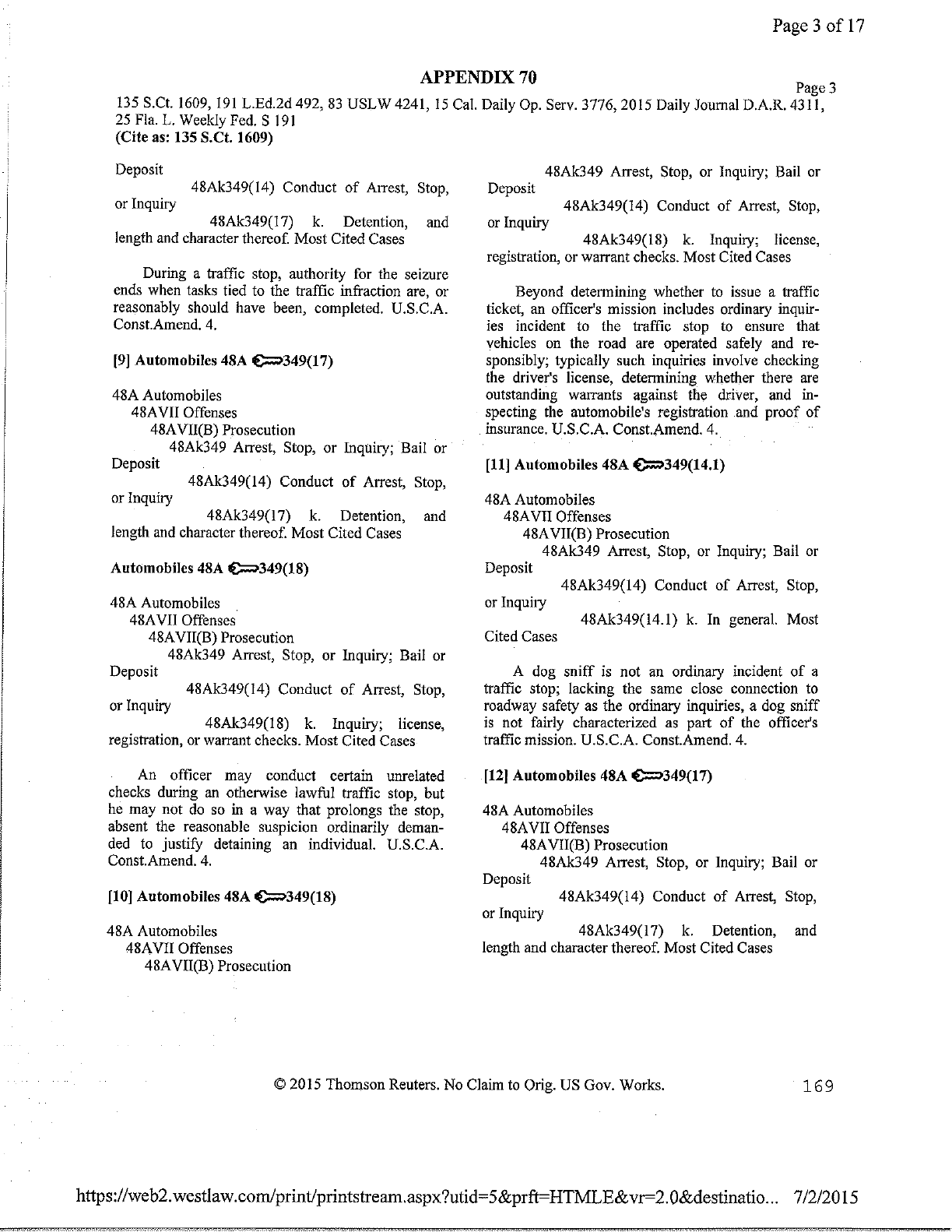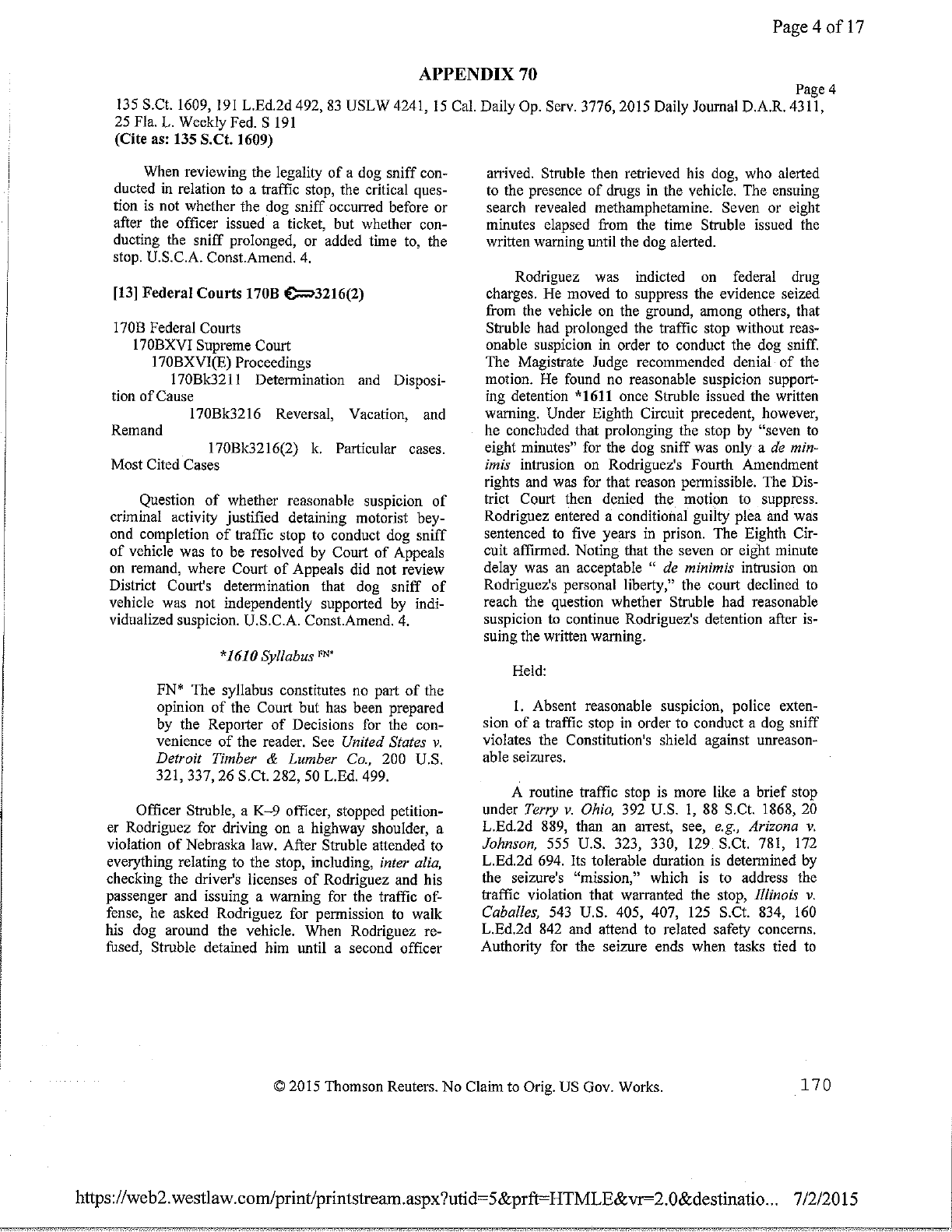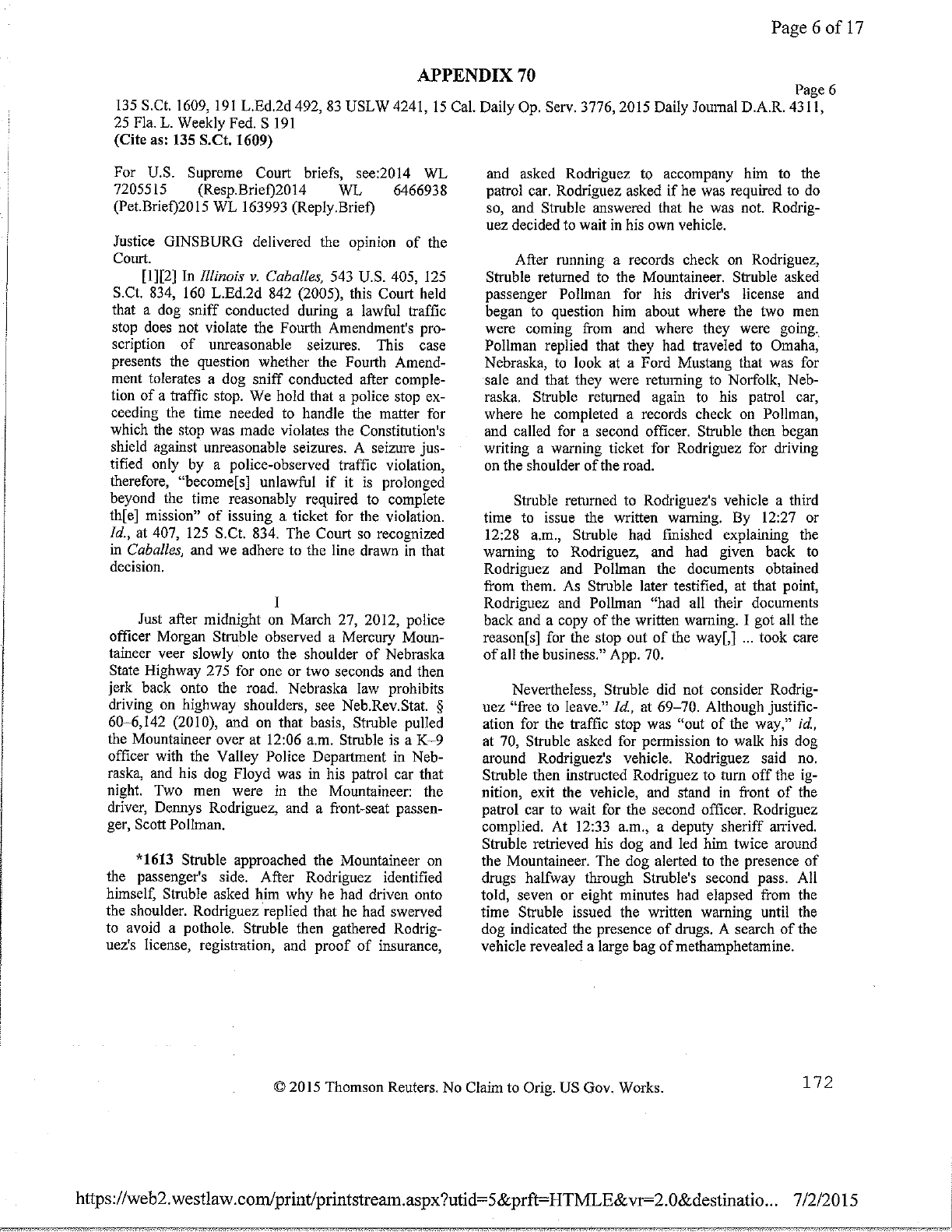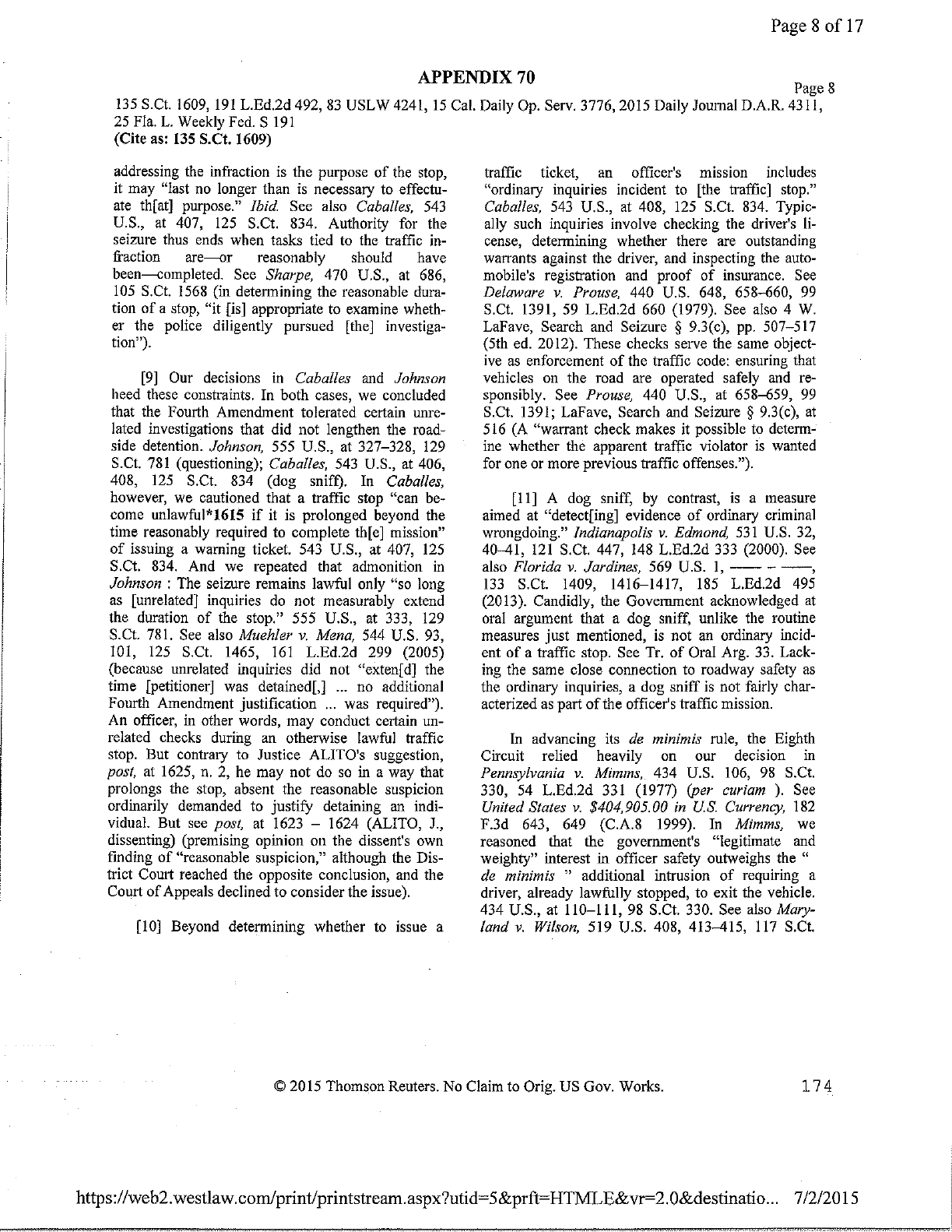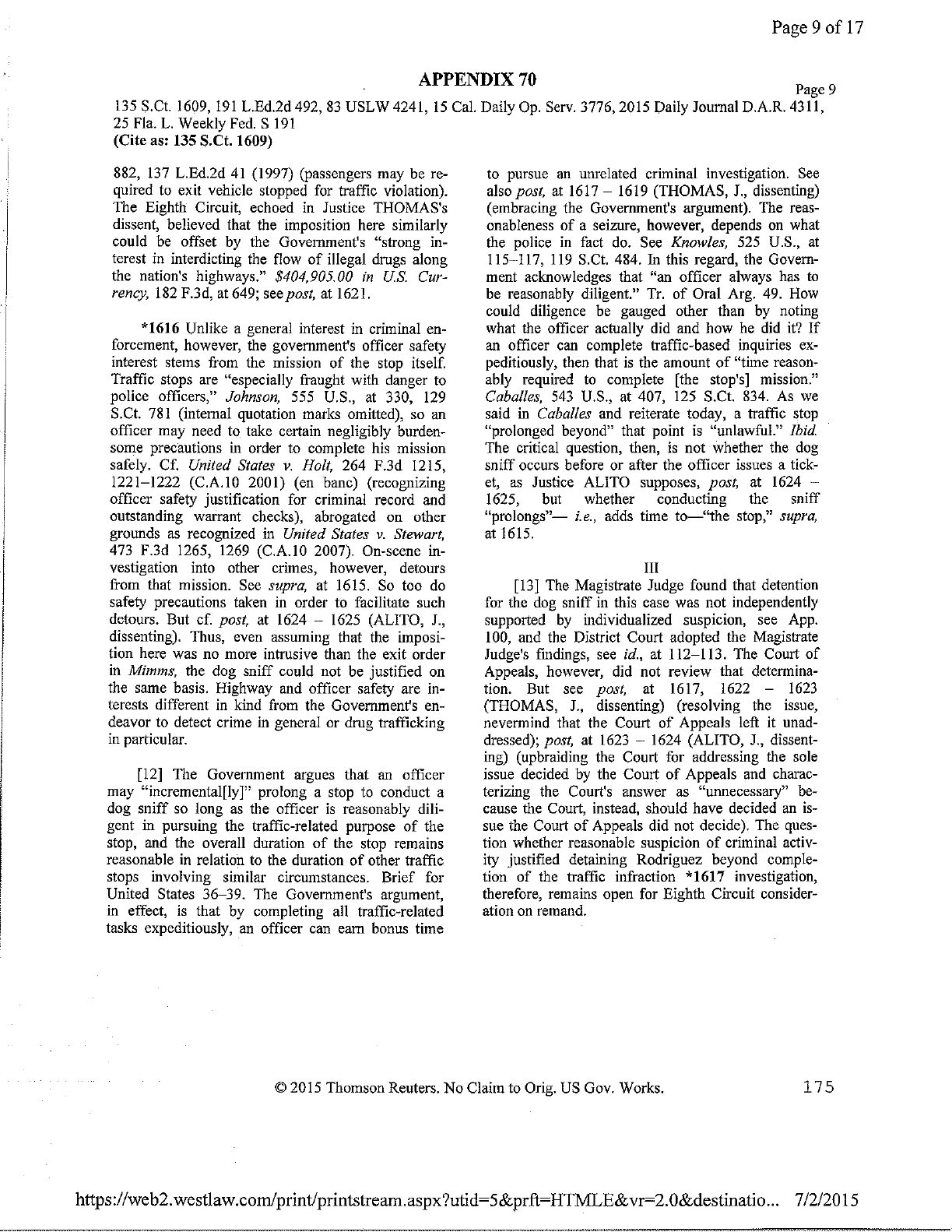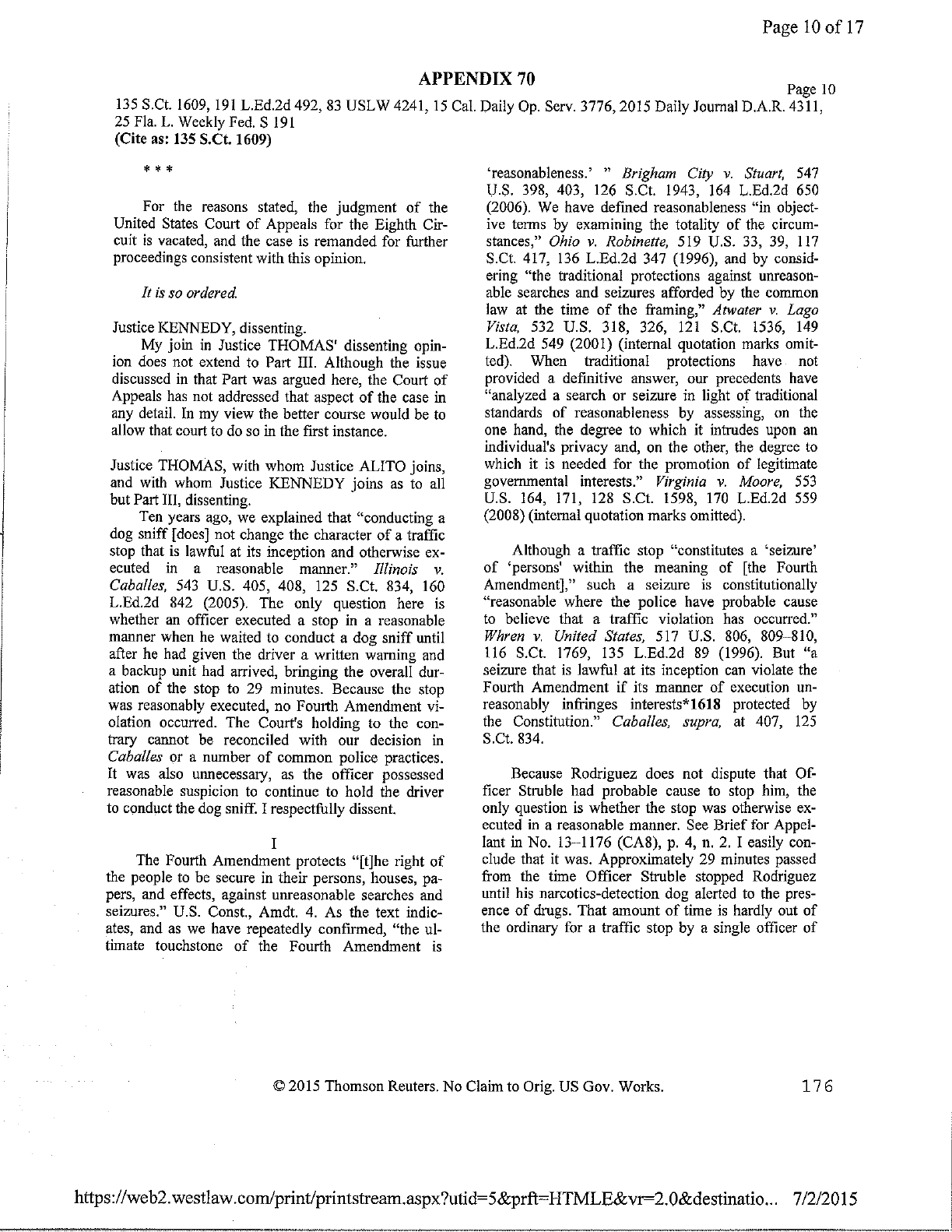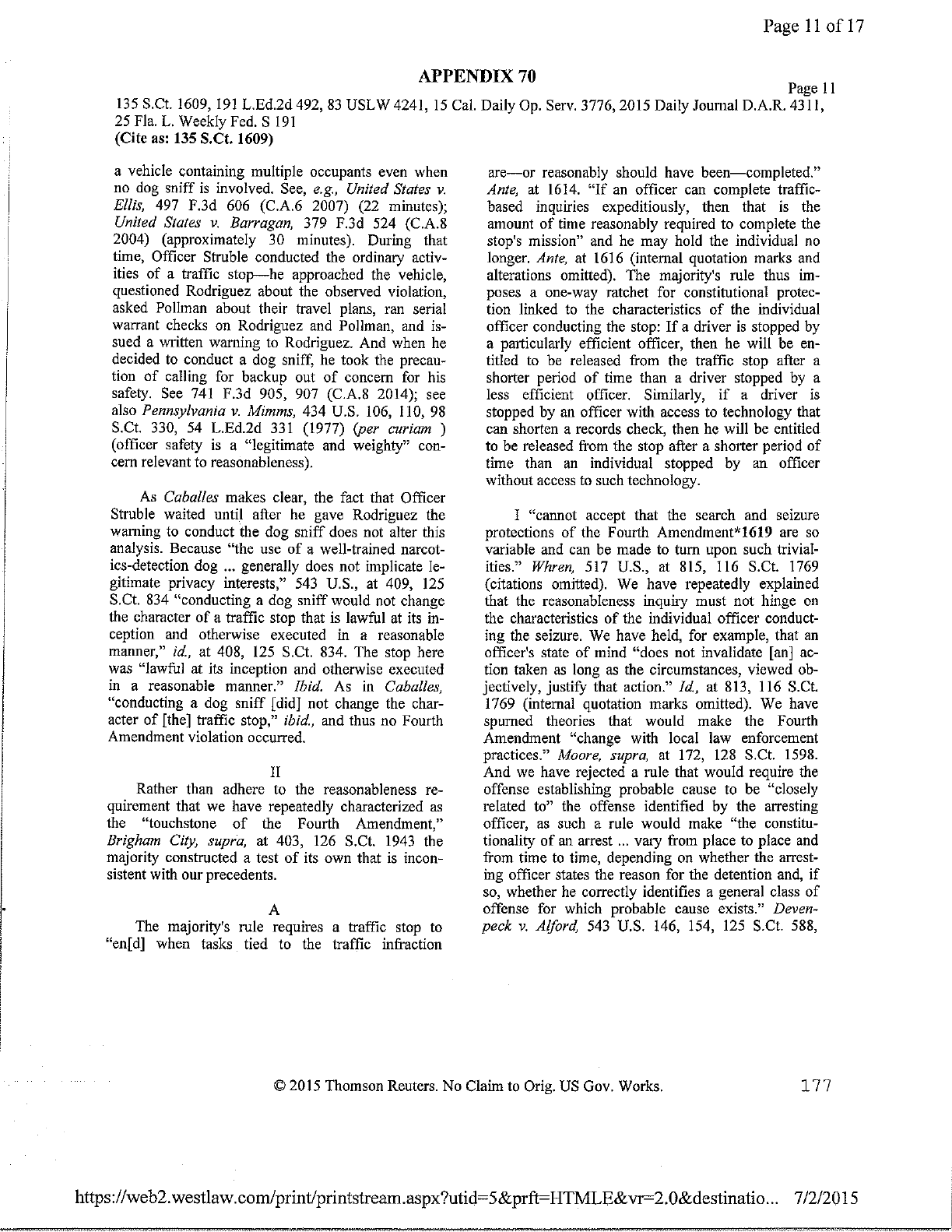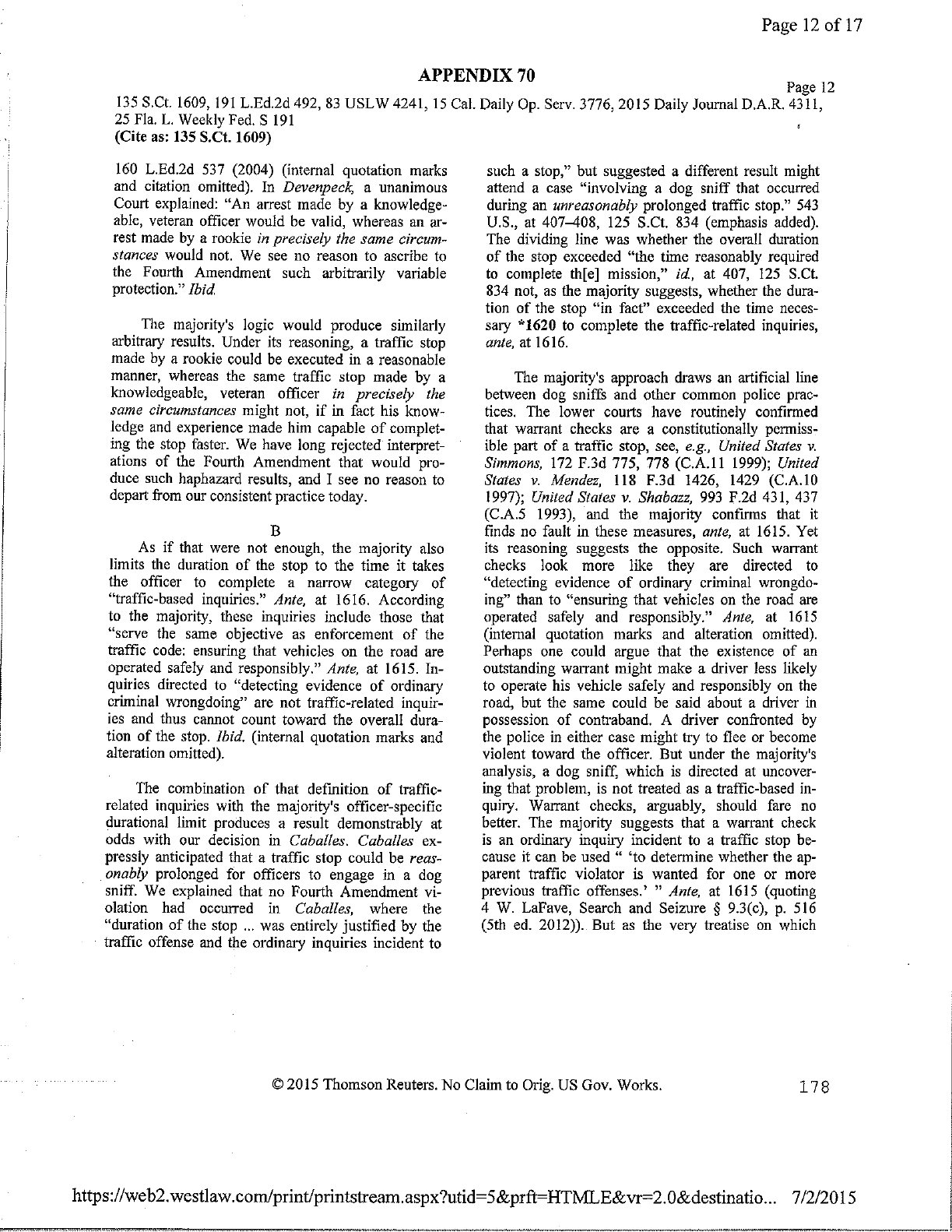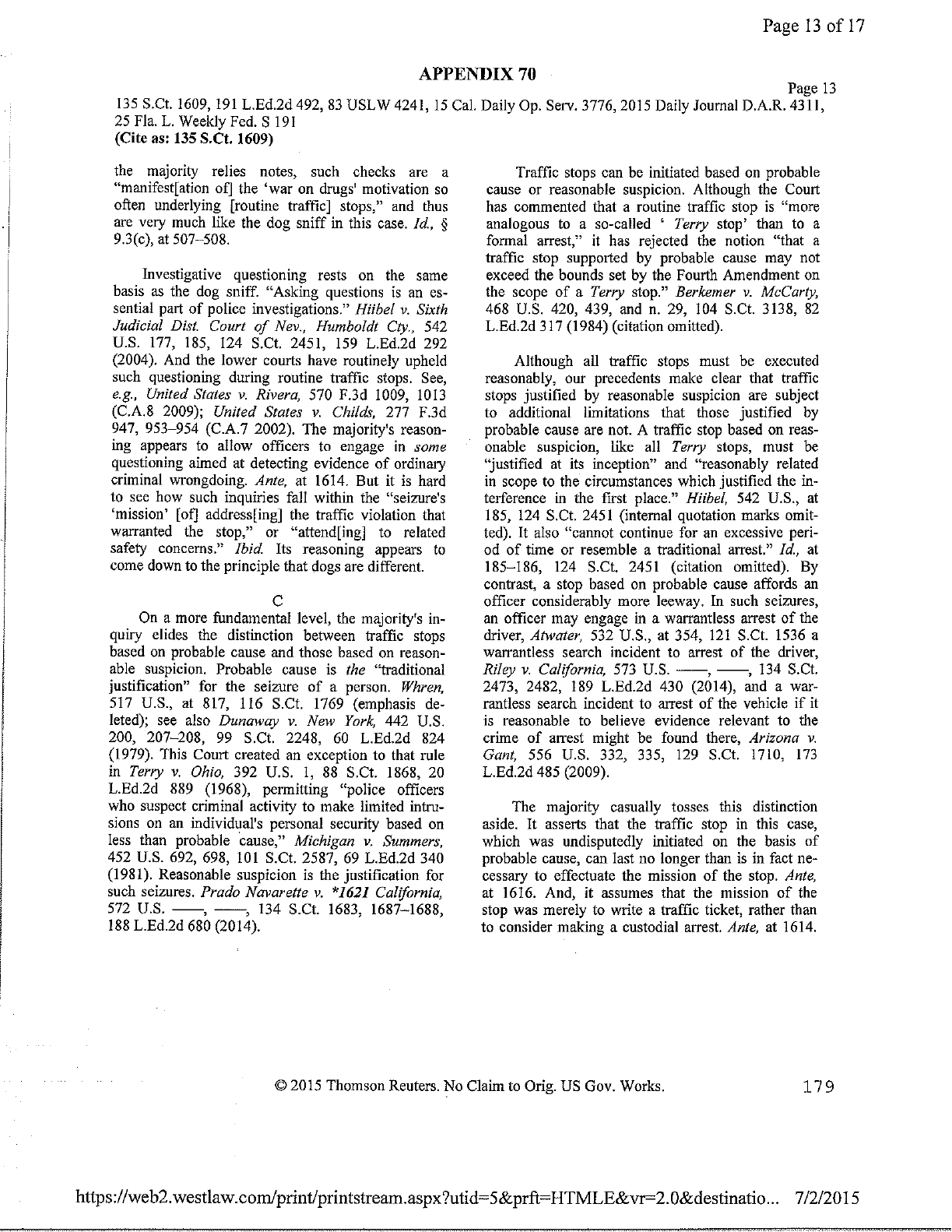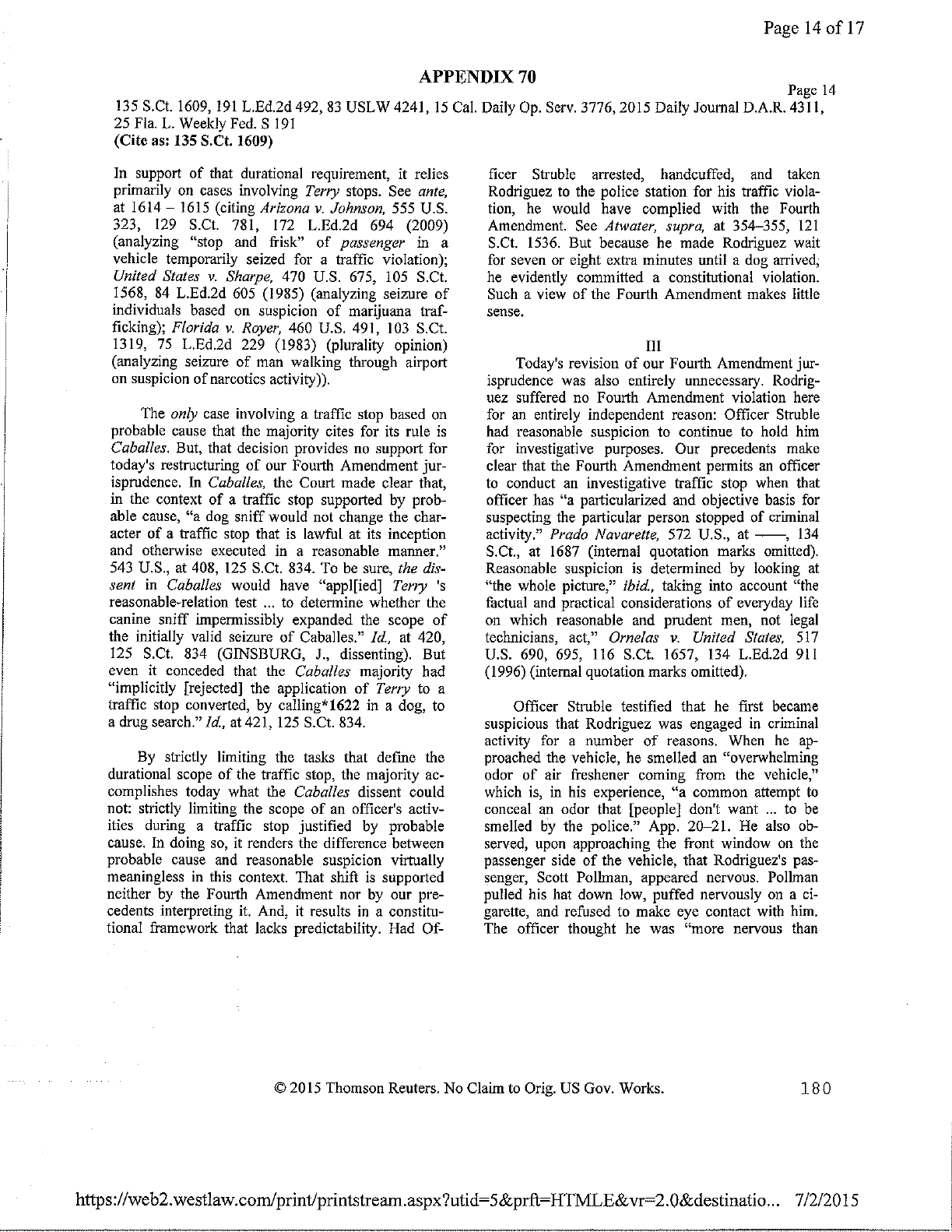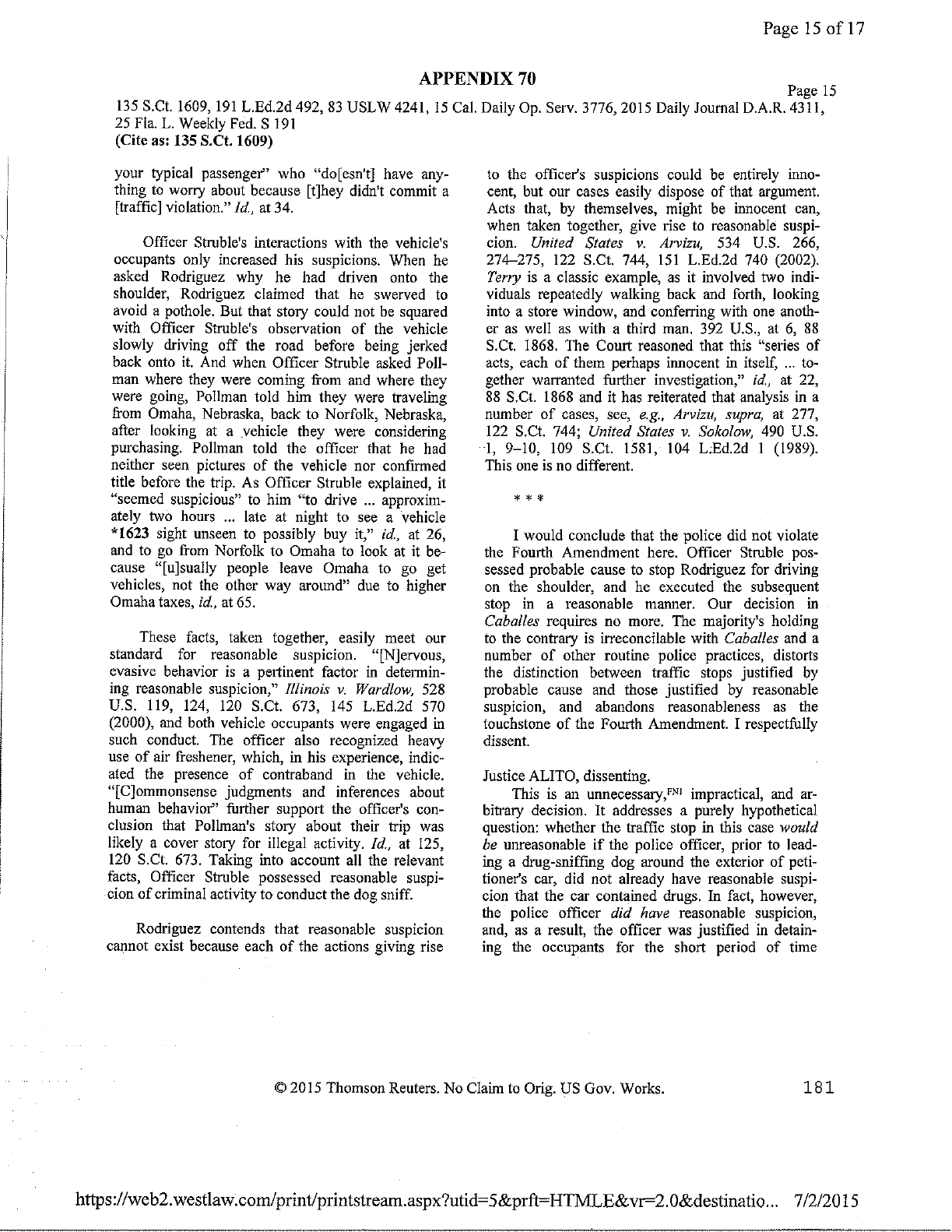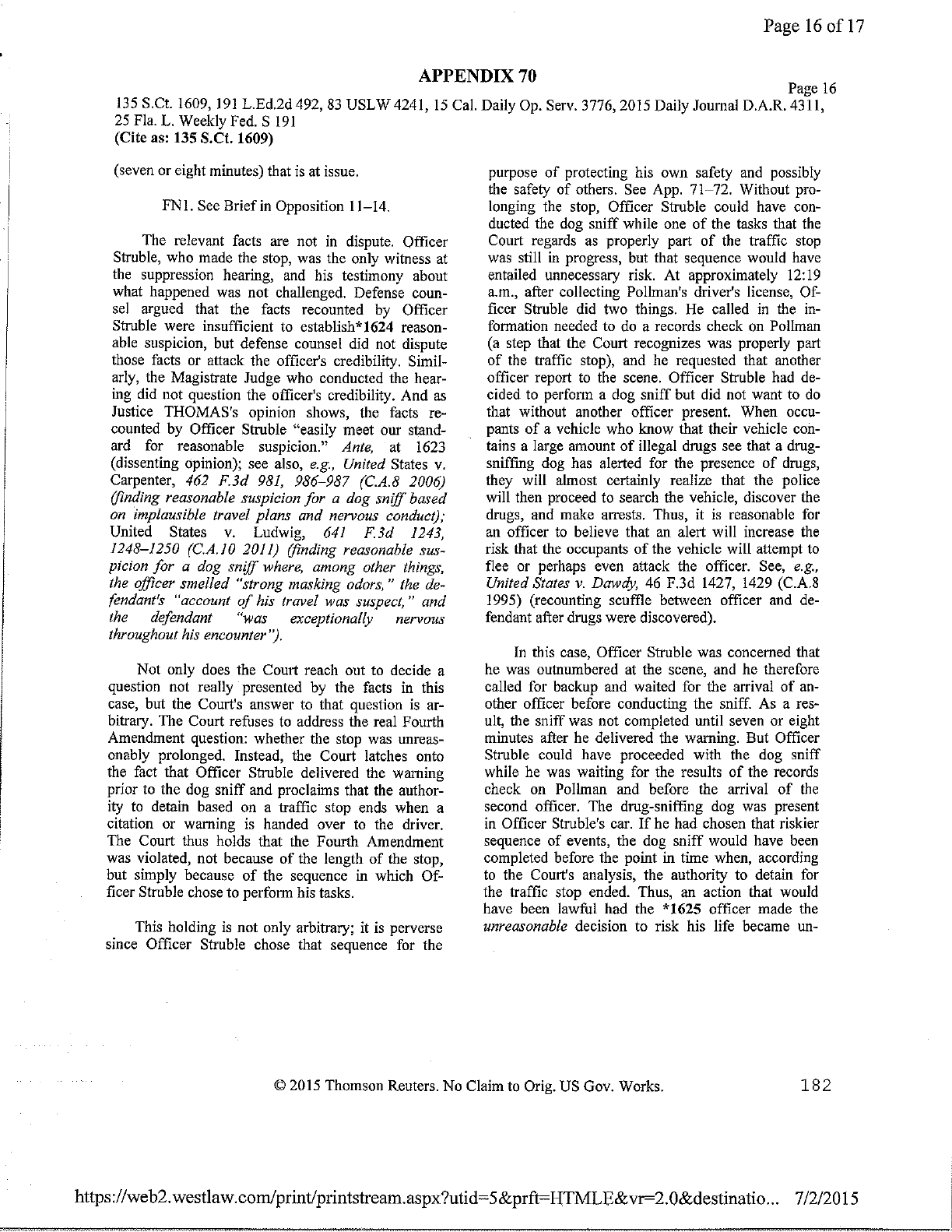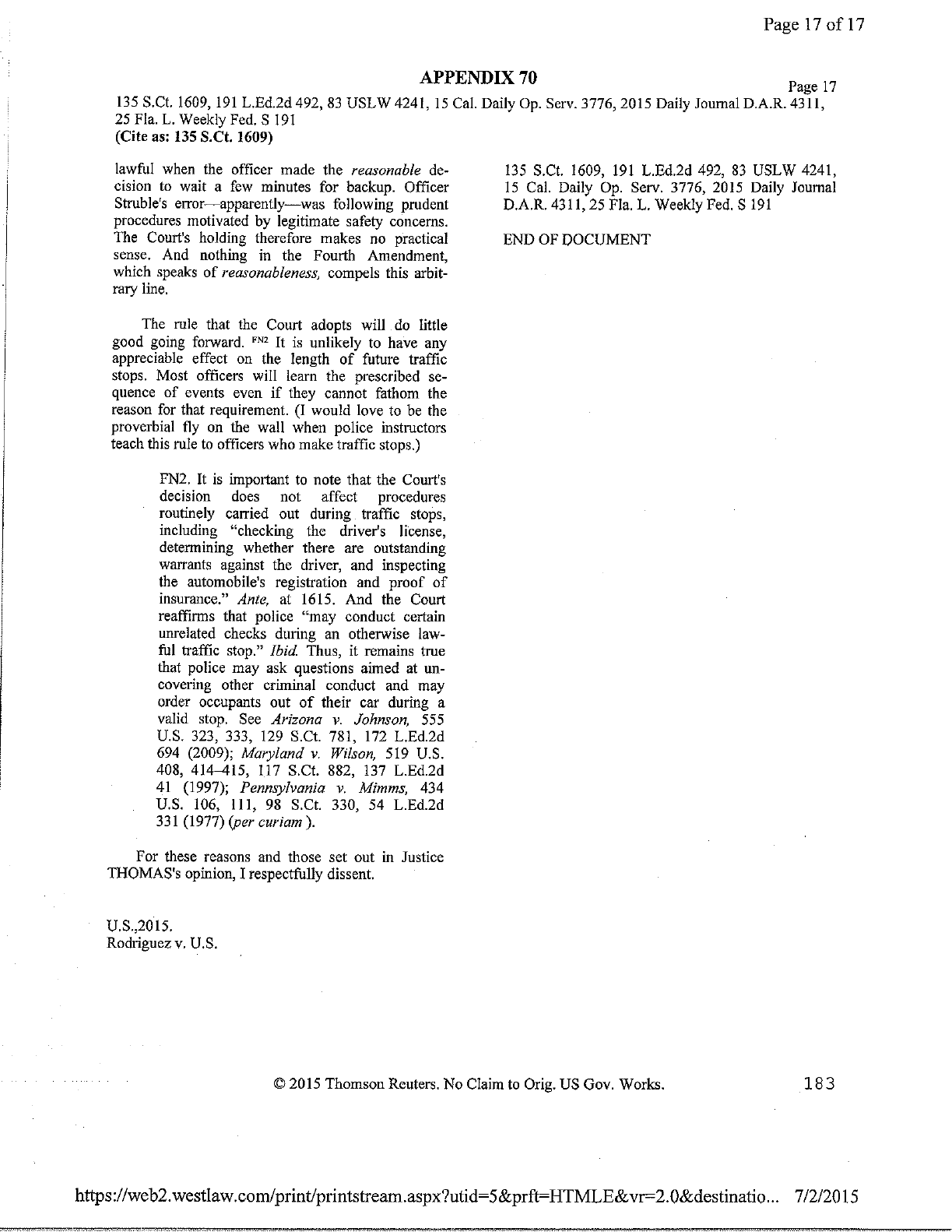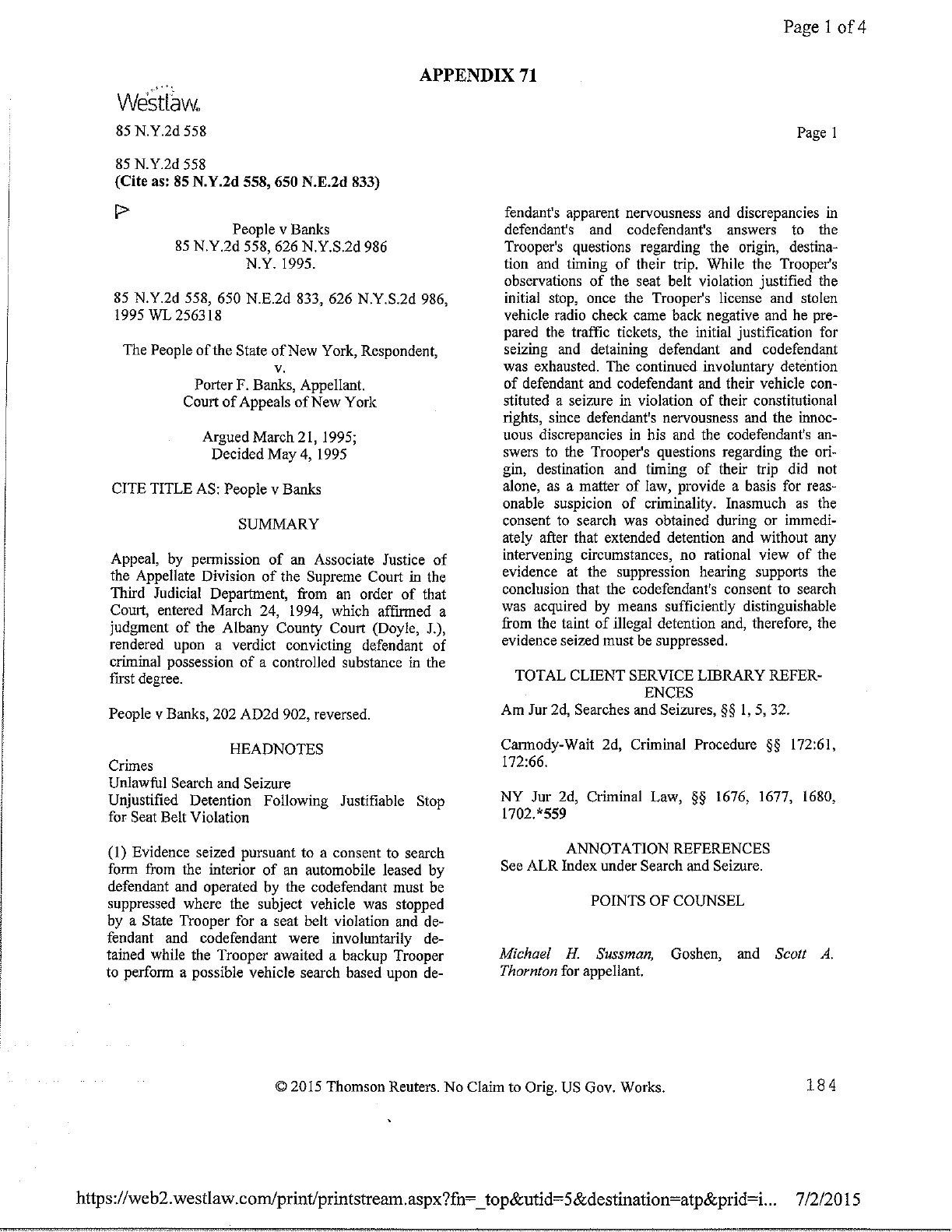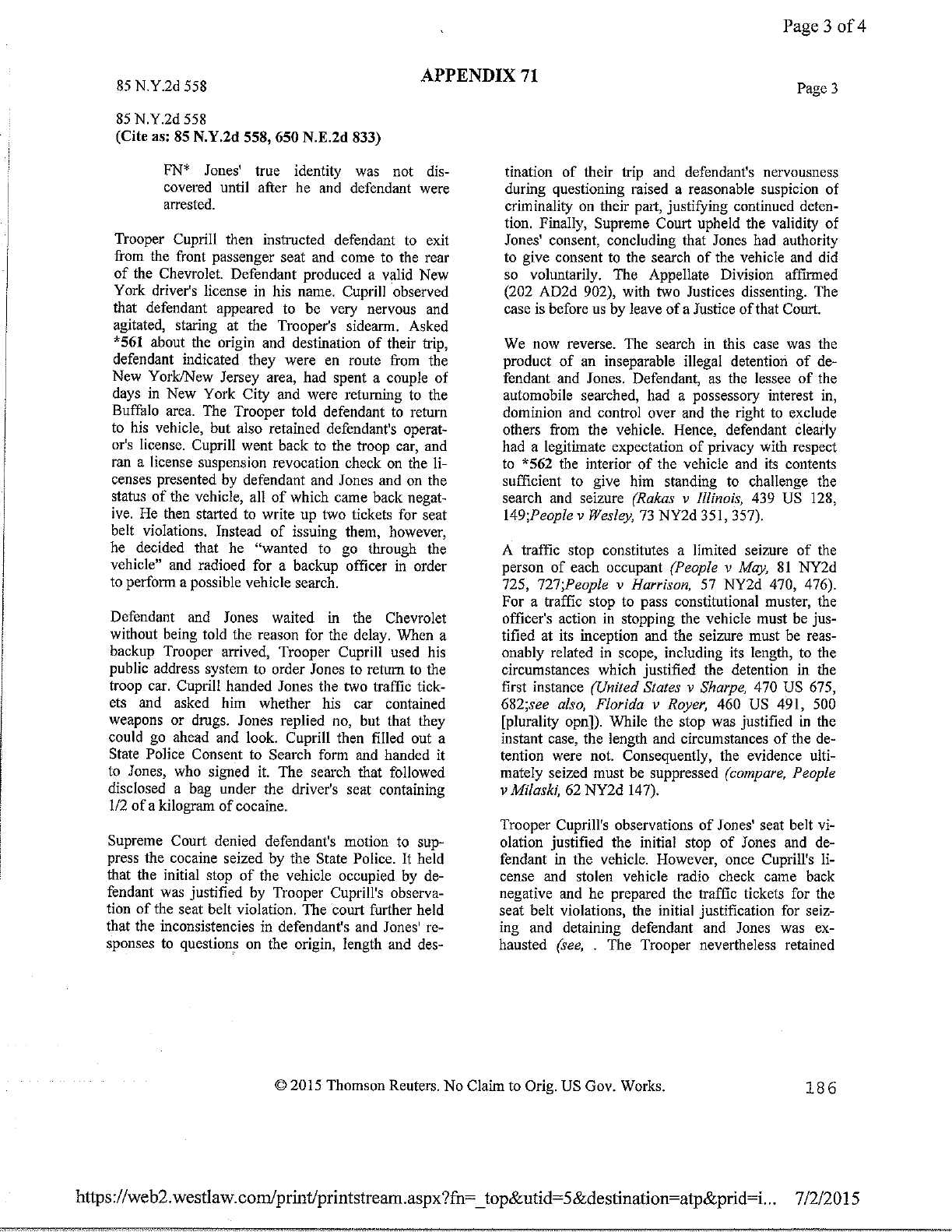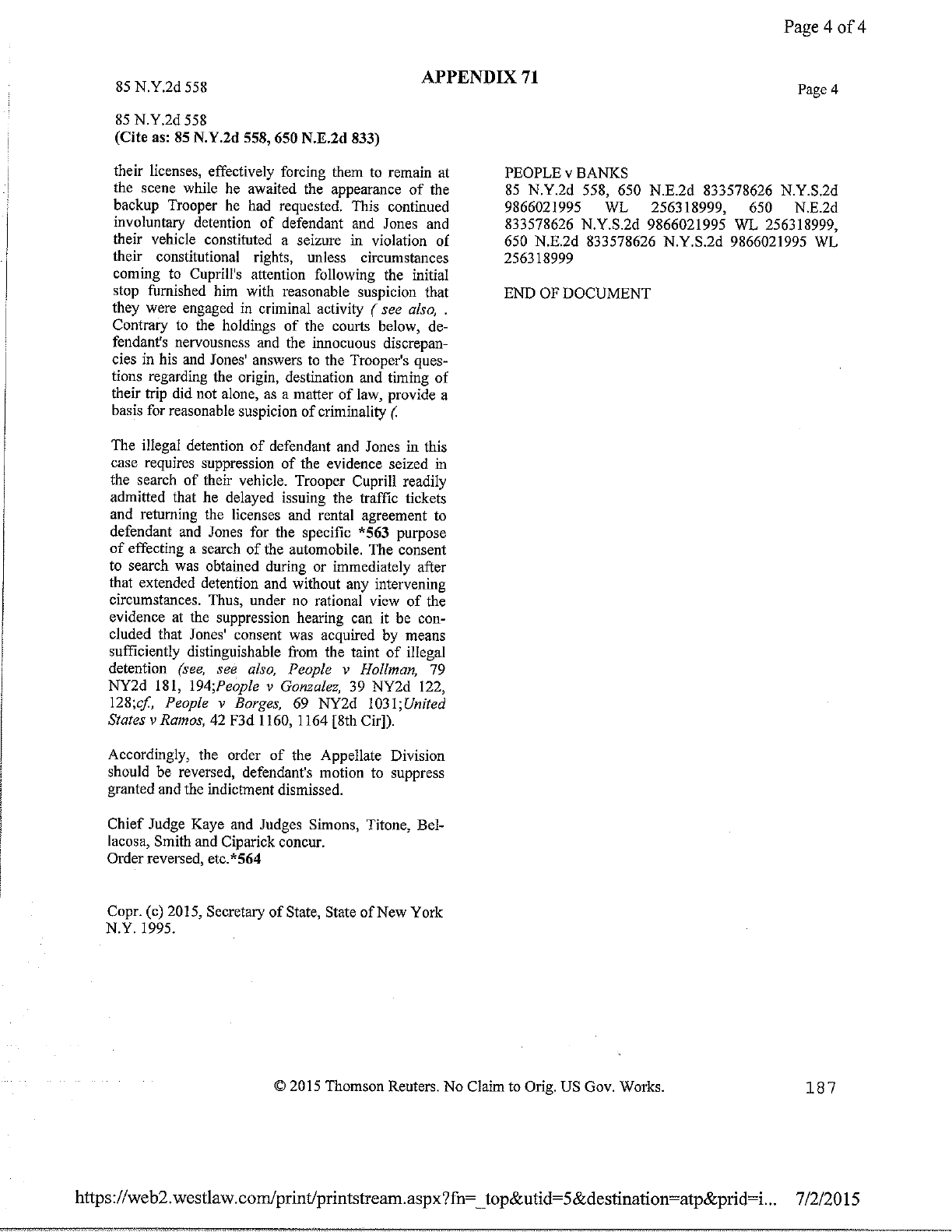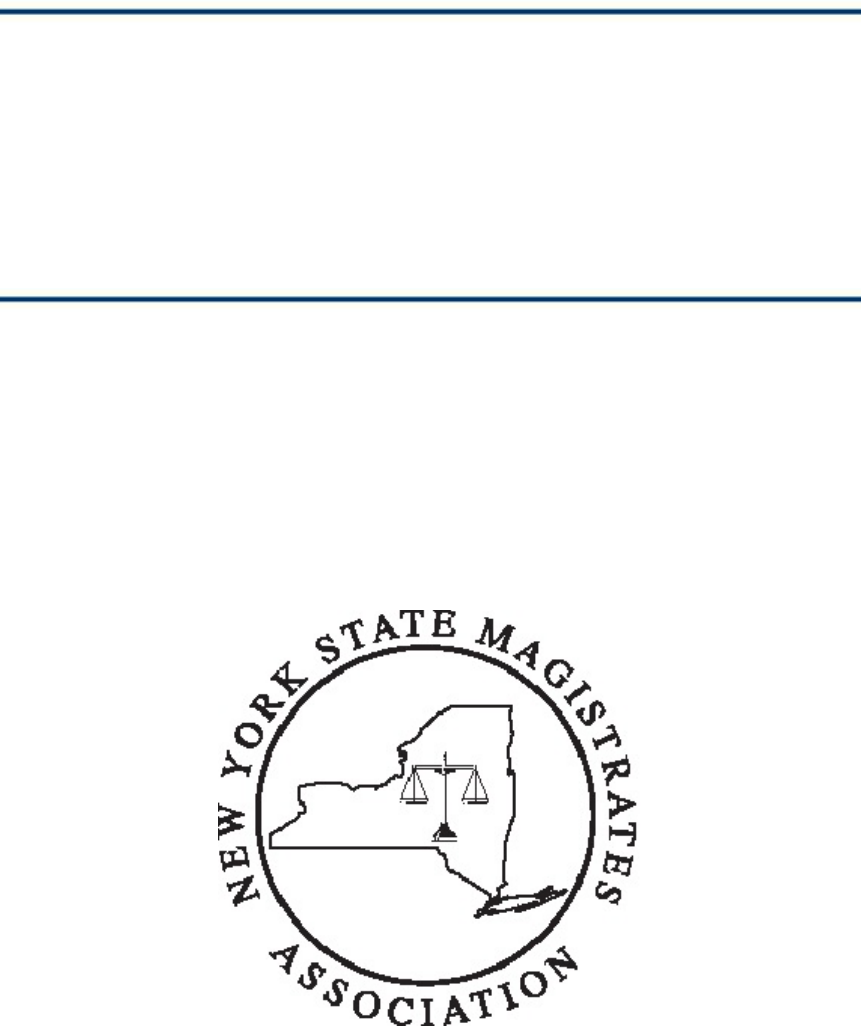
DWI
JUDICIAL PROBLEMS AND PITFALLS
2015 New York State Magistrates Association Conference
Niagara Falls, New York

PETER GERSTENZANG, ESQ.
Introduction
Peter Gerstenzang is the senior partner in the Albany firm of Gerstenzang,
O'Hern, Sills & Gerstenzang where he focuses on Criminal Defense with an emphasis on DWI
cases and Vehicular Crimes. He commenced his legal career as a prosecutor for the United
States Army in the Republic of Vietnam. From 1972 to 1975, he was an Assistant District
Attorney for the County of Albany. Certified as a breath test operator, he taught at the New
York State Police Academy in their Breath Test Training Program for 12 years.
Mr. Gerstenzang is Board Certified by the National College for DUI Defense
(ANCDD@), and is a former Dean of that college. The NCDD is the only organization accredited
by the American Bar Association to certify attorneys as specialists in DUI law.* His book,
Handling the DWI Case in New York, published by West Group, is considered a standard
reference in the field of Driving While Intoxicated cases.
Peter Gerstenzang is a regular lecturer for the New York State Association of
Criminal Defense Lawyers, the National Association of Criminal Defense Lawyers, the New
York State Magistrates Association, the New York State Bar Association, and the New York
State Defenders Association. In addition, he lectures for numerous County Bar and Magistrates
Associations, public defense organizations and the New York State Court Clerks Association.
* The NCDD is not affiliated with any governmental authority. See Rules of Prof. Con., Rule
7.4(c)(1); Hayes v. New York Attorney Grievance Comm. of the 8th Jud. Dist., 672 F.3d 158 (2d Cir.
2012).

NEW YORK STATE MAGISTRATES ASSOCIATION
JUDICIAL PROBLEMS AND PITFALLS
September 28, 2015
Materials Prepared by
PETER GERSTENZANG, ESQ.
GERSTENZANG, O’HERN, SILLS & GERSTENZANG
210 Great Oaks Boulevard
Albany, New York 12203
Copyright © 2015
Portions Excerpted from
Handling the DWI Case in New York by
Peter Gerstenzang, Esq. and Eric H. Sills, Esq.
Reprinted with permission of West Publishing Company
All Rights Reserved

TABLE OF CONTENTS
Page
ARRAIGNMENT ISSUES. . . . . . . . . . . . . . . . . . . . . . . 1
A. Arraignment Without Counsel.. . . . . . . . . . . . . . . . 1
B. Defendant Declines Assigned Counsel.. . . . . . . . . . . . 2
C. Defendant Wishes to Proceed Pro Se. . . . . . . . . . . . . 3
D. CPL § 170.10(4)(a). . . . . . . . . . . . . . . . . . . . . 3
CHAPTER 45: SUSPENSION PENDING PROSECUTION.. . . . . . . . . 5
§ 45:1 In general. . . . . . . . . . . . . . . . . . . . . . 5
§ 45:2 VTL § 1193(2)(e)(7) -- The prompt suspension law. . . 6
§ 45:3 ___ Suspension procedure. . . . . . . . . . . . . . . 7
§ 45:4 ___ Applicability to certain underage drivers.. . . 11
§ 45:5 ___ What if defendant appears for arraignment
without counsel?. . . . . . . . . . . . . . . . . . 13
§ 45:6 ___ Applying Pringle. . . . . . . . . . . . . . . . 18
§ 45:7 ___ What role do the People play at a Pringle
hearing?. . . . . . . . . . . . . . . . . . . . . . 18
§ 45:8 ___ Applicability to chemical test result of
exactly .08%. . . . . . . . . . . . . . . . . . . . 19
§ 45:9 ___ Applicability to out-of-state licensees.. . . . 20
§ 45:10 ___ Hardship privilege. . . . . . . . . . . . . . . 21
§ 45:10A ___ Hardship privilege cannot be used to operate
commercial motor vehicle. . . . . . . . . . . . . . 22
§ 45:11 ___ Pre-conviction conditional license. . . . . . . 22
§ 45:12 ___ Applicability of pre-conviction conditional
license to commercial and taxicab drivers.. . . . . 24
§ 45:13 ___ Violation of pre-conviction conditional
license is a traffic infraction; violation of
hardship privilege constitutes AUO. . . . . . . . . 24
§ 45:14 ___ Prompt suspension law does not preclude Court
from suspending defendant's driver's license
under other laws. . . . . . . . . . . . . . . . . . 24
§ 45:15 VTL § 1193(2)(e)(1) -- Suspension pending
prosecution based upon prior conviction or
vehicular crime.. . . . . . . . . . . . . . . . . . 25
§ 45:16 ___ Suspension procedure. . . . . . . . . . . . . . 26
§ 45:17 ___ Effect of failure to comply with statute. . . . 27
§ 45:18 VTL §§ 1193(2)(e)(1) & (7) -- Suspension time
frame.. . . . . . . . . . . . . . . . . . . . . . . 28
§ 45:19 ___ Length of suspension. . . . . . . . . . . . . . 29
§ 45:20 ___ Constitutionality.. . . . . . . . . . . . . . . 29
§ 45:21 ___ Double Jeopardy and Equal Protection. . . . . . 31
§ 45:22 VTL § 1194(2)(b)(3) -- Temporary suspension of
license at arraignment in chemical test refusal
cases.. . . . . . . . . . . . . . . . . . . . . . . 31
§ 45:23 VTL § 510(3-a) -- Discretionary suspensions.. . . . 32
i

TABLE OF CONTENTS
(Cont'd)
Page
CHAPTER 41: TEST REFUSALS (Select sections from).. . . . . 35
§ 41:35 Procedure upon arrest -- Report of Refusal. . . . . 35
§ 41:36 Report of Refusal -- Verification.. . . . . . . . . 36
§ 41:37 Report of Refusal -- Contents.. . . . . . . . . . . 36
§ 41:38 Report of Refusal -- To whom is it submitted?.. . . 36
§ 41:39 Procedure upon arraignment -- Temporary suspension
of license. . . . . . . . . . . . . . . . . . . . . 37
§ 41:40 Procedure upon arraignment -- Court must provide
defendant with waiver form and notice of DMV
refusal hearing date. . . . . . . . . . . . . . . . 37
§ 41:41 Effect of failure of Court to schedule DMV
refusal hearing.. . . . . . . . . . . . . . . . . . 38
§ 41:42 Effect of delay by Court in forwarding Report of
Refusal to DMV. . . . . . . . . . . . . . . . . . . 38
§ 41:44 Report of Refusal must be forwarded to DMV
within 48 hours of arraignment. . . . . . . . . . . 39
§ 41:45 Forwarding requirement cannot be waived -- even
with consent of all parties.. . . . . . . . . . . . 39
§ 41:28 Chemical test refusal must be "persistent". . . . . 39
§ 41:29 What constitutes a "persistent" refusal?. . . . . . 40
§ 41:88 Admissibility of chemical test refusal evidence
in actions arising under Penal Law. . . . . . . . . 41
CHAPTER 13: (One section from)
§ 13:37 Violation of conditional license as AUO.. . . . . . 42
CHAPTER 49: THE 20-DAY ORDER.. . . . . . . . . . . . . . . 44
§ 49:1 In general. . . . . . . . . . . . . . . . . . . . . 44
§ 49:2 What is a 20-Day Order?.. . . . . . . . . . . . . . 44
§ 49:3 Purpose of a 20-Day Order.. . . . . . . . . . . . . 45
§ 49:4 Scope of a 20-Day Order.. . . . . . . . . . . . . . 45
§ 49:5 Eligibility for a 20-Day Order. . . . . . . . . . . 46
§ 49:6 Chemical test refusals and 20-Day Orders. . . . . . 47
§ 49:7 Court's obligations upon conviction.. . . . . . . . 47
§ 49:8 Advice to defendant regarding 20-Day Order. . . . . 48
§ 49:9 20-Day Orders in certain drug-related cases.. . . . 49
ii

TABLE OF CONTENTS
(Cont'd)
Page
CHAPTER 48: IGNITION INTERLOCK DEVICE PROGRAM. . . . . . . 50
§ 48:1 In general. . . . . . . . . . . . . . . . . . . . . 51
§ 48:2 What is an ignition interlock device?.. . . . . . . 51
§ 48:3 Rules and regulations regarding IIDs. . . . . . . . 51
§ 48:4 Definitions.. . . . . . . . . . . . . . . . . . . . 52
§ 48:5 Scope of IID program. . . . . . . . . . . . . . . . 56
§ 48:6 Who must be required to install and maintain
an IID?.. . . . . . . . . . . . . . . . . . . . . . 56
§ 48:7 Who may not be required to install and maintain
an IID?.. . . . . . . . . . . . . . . . . . . . . . 61
§ 48:8 Cost, installation and maintenance of IID.. . . . . 62
§ 48:9 IID installer must provide defendant with fee
schedule. . . . . . . . . . . . . . . . . . . . . . 63
§ 48:10 What if defendant is unable to afford cost of IID?. 63
§ 48:11 Notification of IID requirement.. . . . . . . . . . 64
§ 48:12 Defendant must install IID within 10 business
days of sentencing. . . . . . . . . . . . . . . . . 65
§ 48:13 Defendant must provide proof of compliance
with IID requirement within 3 business days of
installation. . . . . . . . . . . . . . . . . . . . 65
§ 48:14 DMV will note IID condition on defendant's
driving record. . . . . . . . . . . . . . . . . . . 66
§ 48:15 How often does defendant have to blow into IID?.. . 66
§ 48:16 Lockout mode. . . . . . . . . . . . . . . . . . . . 67
§ 48:17 Circumvention of IID. . . . . . . . . . . . . . . . 67
§ 48:18 Duty of IID monitor to report defendant to Court
and District Attorney.. . . . . . . . . . . . . . . 67
§ 48:19 Use of leased, rented or loaned vehicles. . . . . . 69
§ 48:20 Use of employer-owned vehicles. . . . . . . . . . . 69
§ 48:21 Pre-installation requirements.. . . . . . . . . . . 70
§ 48:22 Mandatory service visit intervals.. . . . . . . . . 71
§ 48:23 Accessibility of IID providers. . . . . . . . . . . 71
§ 48:24 Frequency of reporting by IID providers.. . . . . . 72
§ 48:25 Defendant entitled to report of his/her IID
usage history.. . . . . . . . . . . . . . . . . . . 73
§ 48:26 IID providers must safeguard personal information.. 73
§ 48:27 Post-revocation conditional license.. . . . . . . . 74
§ 48:28 Intrastate transfer of probation/conditional
discharge involving IID requirement.. . . . . . . . 78
§ 48:29 Interstate transfer of probation/conditional
discharge involving IID requirement.. . . . . . . . 79
iii

TABLE OF CONTENTS
(Cont'd)
Page
CHAPTER 48: IGNITION INTERLOCK DEVICE PROGRAM (Cont'd)
§ 48:30 VTL § 1198 does not preclude Court from imposing
any other permissible conditions of probation.. . . 80
§ 48:31 Imposition of IID requirement does not alter
length of underlying license revocation.. . . . . . 81
§ 48:32 IID requirement runs consecutively to jail
sentence. . . . . . . . . . . . . . . . . . . . . . 81
§ 48:33 Applicability of IID requirement to parolees. . . . 84
§ 48:34 IID cannot be removed without "certificate of
completion" or "letter of de-installation". . . . . 85
§ 48:35 Constitutionality of VTL § 1198.. . . . . . . . . . 85
§ 48:36 Necessity of a Frye hearing.. . . . . . . . . . . . 85
MISTAKE OF LAW STOPS. . . . . . . . . . . . . . . . . . . . . 86
VEHICLE STOP DETENTION. . . . . . . . . . . . . . . . . . . . 87
TABLE OF APPENDICES
Page
App.
1 Copy of Hurrell-Harring v. State of New York,
15 N.Y.3d 8 (2010). . . . . . . . . . . . . . . . . 88
2 Advisory Committee on Judicial Ethics'
Opinion 14-01 dated January 30, 2014. . . . . . . . 105
3 New York State Department of Health Rules and
Regulations for Chemical Tests (Breath, Blood,
Urine and Saliva).. . . . . . . . . . . . . . . . . 106
55 20-Day Order and Order of Suspension and
Revocation. . . . . . . . . . . . . . . . . . . . . 124
61 Letter from Department of Motor Vehicles Regarding
Suspension Pending Prosecution. . . . . . . . . . . 125
62 Letter from Department of Motor Vehicles Regarding
Hardship Privilege. . . . . . . . . . . . . . . . . 127
64 DPCA Financial Disclosure Report. . . . . . . . . . 128
65 Order of Suspension Pending Prosecution Hardship
Privilege and Order of Suspension.. . . . . . . . . 133
67 Letters from Department of Motor Vehicles Revising
Opinion Regarding Hardship Privilege. . . . . . . . 134
68 Copy of People v. Guthrie, 25 N.Y.3d 130 (2015).. . 137
69 Copy of Heien v. North Carolina, 135 S.Ct. 530
(2014). . . . . . . . . . . . . . . . . . . . . . . 150
70 Copy of Rodriguez v. United States, 135 S.Ct. 1609
(2015). . . . . . . . . . . . . . . . . . . . . . . 167
71 Copy of People v. Banks, 85 N.Y.2d 558,
626 N.Y.S.2d 986 (1995).. . . . . . . . . . . . . . 184
iv

ARRAIGNMENT ISSUES
A. Arraignment Without Counsel
In Hurrell-Harring v. State of New York, 15 N.Y.3d 8 (2010),
a copy of which is attached at Appendix 1, the New York State
Court of Appeals stated a defendant charged with a crime had a
right to counsel at arraignment. While arraignments in New York
have always included advising the defendant of their right to
counsel, the Court of Appeals went further and stated that
implementation of that right required the presence of counsel at
arraignment:
Contrary to defendants' suggestion and that
of the dissent, nothing in the statute may be
read to justify the conclusion that the
presence of defense counsel at arraignment is
ever dispensable, except at a defendant's
informed option, when matters affecting the
defendant's pretrial liberty or ability
subsequently to defend against the charges
are to be decided.
Id. at 21.
The Court focuses on the fact that an arraignment includes,
among other things, the issuance of a securing order. In that
regard, the Court states: "There is no question that 'a bail
hearing is a critical stage of the State's criminal process'"
(citations omitted). Id. at 20.
The issue of bail takes center stage in the Court's
discussion of the necessity of counsel's presence at arraignment.
While it has been argued that defendants who were released in
their own recognizance with their rights reserved suffered no
detriment in the absence of counsel, that argument cannot be made
where bail is set and the defendant is remanded. Even where an
unrepresented defendant is able to "make" bail, a determination
has been made by the Court that impacts their financial
circumstances at a time when they were not represented by
counsel.
CPL § 510.30 sets forth criteria controlling the
determination on the issue of recognizance or bail. Those
criteria include matters in which the assistance of counsel could
be critical. For example, CPL § 510.30(2)(a):
(i) The principal's character,
reputation, habits and mental
condition;
(ii) His employment and financial
resources; and
1

(iii) His family ties and the length of his
residence if any in the community; and . . .
(vi) His previous record if any in
responding to court appearances when required
or with respect to flight to avoid criminal
prosecution; and . . .
(viii) If he is a defendant, the weight of
the evidence against him in the pending
criminal action and any other factor
indicating probability or improbability of
conviction.
In light of the Court's determination that the arraignment
is a critical stage of the proceeding, it appears that the Court
is saying that the arraignment of a defendant may not proceed
without counsel, absent an informed waiver of that right by the
defendant.
Recognizing the crucial importance of
arraignment and the extent to which a
defendant's basic liberty and due process *21
interests may then be affected, CPL 180.10
(3) expressly provides for the “right to the
aid of counsel at the arraignment and at
every subsequent stage of the action” and
forbids a court from going forward with the
proceeding without counsel for the defendant,
unless the defendant has knowingly agreed to
proceed in counsel's absence CPL 180.10 [5]).
Id. at 20-21.
Ethically, the only opinion that is directly on point is
Opinion 14-01 dated January 30, 2014, attached as Appendix 2.
Here, the Committee concludes their opinion stating: "Whether a
judge may preside over an arraignment, in which a defendant is
not represented by counsel, raises primarily legal questions;
however, if a judge acts in conformity with governing law the
judge will not violate the Rules Governing Judicial Conduct."
See Opinion 11-87 (emphasis added). Accordingly, if a Judge
determines that the presence of an attorney is required to
conduct an arraignment, absent defendant's waiver, then the Judge
would appear to be ethically bound to have counsel present at
arraignment.
B. Defendant Declines Assigned Counsel
While the mandate to have counsel present at the arraignment
of an indigent accused seems clear, it gets more complicated
2
where the defendant has the capability to retain private counsel.
What happens when that defendant is brought before the Court at
4:00 AM and wants to retain private counsel? Can the Court
assign a public defender to represent that defendant for purposes
of arraignment?
Clearly, a court that forces a defendant to accept the
services of assigned counsel is in as much violation of the
defendant's Sixth Amendment right to counsel as a court that
proceeds to determine the defendant's interests without counsel.
In addition, does a court have authority to assign counsel to
someone who does not qualify? Is such an assignment a
misappropriation of public funds?
Declining the services of assigned counsel does not
constitute a waiver of a defendant's right to counsel.
Accordingly, this situation presents an even greater challenge
than obtaining counsel for an indigent defendant who either
accepts those services, or proceeds pro se.
C. Defendant Wishes to Proceed Pro Se
It is important to note that while the law requires the
presence of an attorney at arraignment, it also recognizes
defendant's right to proceed without counsel. This is
particularly significant since there are a number of courts that
routinely advise a defendant that they will be held in custody
until the defendant either accepts the assignment of a Legal Aid
lawyer or Public Defender; or retained counsel arrives to
represent the defendant at arraignment. In these courts, the
right to counsel becomes a mandate that forces defendants to
choose between being released on a securing order, or held in
custody pending the arrival of their attorney. They are given
the alternative of accepting an assigned lawyer whom they would
otherwise not choose to represent them, and do so only under the
coercion of continued incarceration.
D. CPL § 170.10(4)(a)
Statutorily, courts are mandated to not only advise the
defendant of their rights, but to take affirmative action to
implement those rights. CPL 170.10(3) states:
The defendant has the right to the aid of
counsel at the arraignment and at every
subsequent stage of the action. If he
appears on such arraignment without counsel,
he has the following rights:
(a) to an adjournment for the purpose of
obtaining counsel.
CPL 170.10(4)(a) states:
3
Except as provided in subdivision five, the
court must inform the defendant:
(a) Of his rights as prescribed in
subdivision three; and the Court must not
only accord him opportunity to exercise such
rights but must itself take such affirmative
action as is necessary to effectuate them.
4

Copyright © 2015
West Group
PART XII
PENALTIES AND CONSEQUENCES
CHAPTER 45
SUSPENSION PENDING PROSECUTION
§ 45:1 In general
§ 45:2 VTL § 1193(2)(e)(7) -- The prompt suspension law
§ 45:3 ___ Suspension procedure
§ 45:4 ___ Applicability to certain underage drivers
§ 45:5 ___ What if defendant appears for arraignment without
counsel?
§ 45:6 ___ Applying Pringle
§ 45:7 ___ What role do the People play at a Pringle hearing?
§ 45:8 ___ Applicability to chemical test result of exactly .08%
§ 45:9 ___ Applicability to out-of-state licensees
§ 45:10 ___ Hardship privilege
§ 45:10A ___ Hardship privilege cannot be used to operate
commercial motor vehicle
§ 45:11 ___ Pre-conviction conditional license
§ 45:12 ___ Applicability of pre-conviction conditional license
to commercial and taxicab drivers
§ 45:13 ___ Violation of pre-conviction conditional license is a
traffic infraction; violation of hardship privilege
constitutes AUO
§ 45:14 ___ Prompt suspension law does not preclude Court from
suspending defendant's driver's license under other laws
§ 45:15 VTL § 1193(2)(e)(1) -- Suspension pending prosecution
based upon prior conviction or vehicular crime
§ 45:16 ___ Suspension procedure
§ 45:17 ___ Effect of failure to comply with statute
§ 45:18 VTL §§ 1193(2)(e)(1) & (7) -- Suspension time frame
§ 45:19 ___ Length of suspension
§ 45:20 ___ Constitutionality
§ 45:21 ___ Double Jeopardy and Equal Protection
§ 45:22 VTL § 1194(2)(b)(3) -- Temporary suspension of license at
arraignment in chemical test refusal cases
§ 45:23 VTL § 510(3-a) -- Discretionary suspensions
-----
§ 45:1 In general
A defendant charged with DWI must be aware of several statutes
which, if applicable, call for the mandatory and/or permissive
suspension of his or her driver's license pending prosecution. The
5

first statute is VTL § 1193(2)(e)(7) -- the so-called "prompt
suspension law" -- which is generally applicable to a defendant who
is charged with DWI and who is alleged to have had a BAC of .08% or
more at the time of his or her arrest. The second statute, VTL §
1193(2)(e)(1), is applicable to a defendant who is charged with
DWI, Aggravated DWI, DWAI Drugs or DWAI Combined Influence and who
either (a) has been convicted of any violation of VTL § 1192 within
the preceding 5 years, or (b) is charged with Vehicular Assault or
Vehicular Homicide in connection with the current incident. A
third statute, VTL § 1194(2)(b)(3), is applicable to a defendant
who is charged with a violation of VTL § 1192 and who is alleged to
have refused to submit to a chemical test.
Prior to the enactment of the prompt suspension law, VTL §
510(3-a) had occasionally been used to suspend DWI defendants'
driver's licenses pending prosecution. However, in light of VTL §§
1193(2)(e)(1) and (7), as well as the Court of Appeals' decision in
Pringle v. Wolfe, 88 N.Y.2d 426, 646 N.Y.S.2d 82 (1996), continued
reliance upon VTL § 510(3-a) in this regard would appear to be
unwarranted. See Matter of King v. Kay, 39 Misc. 3d 995, 963
N.Y.S.2d 537 (Suffolk Co. Sup. Ct. 2013).
§ 45:2 VTL § 1193(2)(e)(7) -- The prompt suspension law
A defendant who is charged with DWI, Aggravated DWI or DWAI
Combined Influence and who is alleged to have had a BAC of .08% or
more at the time of his or her arrest is subject to the prompt
suspension law. This law provides, in pertinent part:
(7) Suspension pending prosecution; excessive
blood alcohol content. a. Except as provided
in clause a-1 of this subparagraph, a court
shall suspend a driver's license, pending
prosecution, of any person charged with a
violation of [VTL § 1192(2), (2-a), (3) or (4-
a)] who, at the time of arrest, is alleged to
have had .08 of one percent or more by weight
of alcohol in such driver's blood as shown by
chemical analysis of blood, breath, urine or
saliva, made pursuant to [VTL § 1194(2) or
(3)].
VTL § 1193(2)(e)(7)(a).
Notably, the prompt suspension law, by its express terms, only
applies under certain circumstances. For example, the prompt
suspension law only applies where the defendant is charged with VTL
§ 1192(2), (2-a), (3) or (4-a); it does not apply where the
defendant is charged with VTL § 1192(1) (i.e., DWAI) or (4) (i.e.,
DWAI Drugs). In addition, the prompt suspension law only applies
where a chemical test result is obtained; it does not apply where
6

the defendant is alleged to have refused to submit to a chemical
test. See Appendix 61.
Furthermore, the prompt suspension law only applies where the
defendant's BAC is .08% or more; it does not apply where the
defendant's BAC is below .08%, even if he or she is charged with
VTL § 1192(3). Moreover, the prompt suspension law only applies
where a prosecution is pending. Accordingly, a defendant who
enters a plea of guilty and is sentenced at arraignment is not
subject to the prompt suspension law. On the other hand, a
defendant who enters a plea of guilty at arraignment, but whose
sentencing is adjourned, is subject to the prompt suspension law
(because the prosecution does not terminate until the imposition of
sentence).
§ 45:3 VTL § 1193(2)(e)(7) -- Suspension procedure
Pursuant to the express language of the prompt suspension law,
in order to impose a suspension thereunder the Court must make two
findings. First, the Court "must find that the accusatory
instrument conforms to the requirements of [CPL §] 100.40." VTL §
1193(2)(e)(7)(b). CPL § 100.40 sets forth the facial sufficiency
requirements for local criminal court accusatory instruments.
Second, the Court must find that "there exists reasonable cause to
believe . . . that . . . the holder operated a motor vehicle while
such holder had .08 of one percent or more by weight of alcohol in
his or her blood as was shown by chemical analysis of such person's
blood, breath, urine or saliva, made pursuant to the provisions of
[VTL § 1194]." VTL § 1193(2)(e)(7)(b).
If such tentative findings are made, the statute provides that
"the holder shall be entitled to an opportunity to make a statement
regarding these two issues and to present evidence tending to rebut
the court's findings." VTL § 1193(2)(e)(7)(b).
The Court of Appeals' decision in Pringle v. Wolfe, 88 N.Y.2d
426, 646 N.Y.S.2d 82 (1996), added in several prerequisites to
suspension under the prompt suspension law that do not appear in
the statute itself. For example, Pringle adds numerous procedural
due process requirements into the prompt suspension law which must
be complied with before a suspension pending prosecution thereunder
can be imposed; and adds the threshold requirements that a "court
may not order suspension of the license unless it has in its
possession the results of the chemical test, and, as the
Commissioner concedes, these results must be presented to the court
in certified, documented form (see, CPLR 4518[c])." Id. at 432,
646 N.Y.S.2d at 85-86 (emphasis added). See also People v.
DeRojas, 180 Misc. 2d 690, ___, 693 N.Y.S.2d 404, 405 (App. Term,
2d Dep't 1999).
7

In addition, Pringle created, and granted the defendant an
absolute right to, a so-called "Pringle hearing." In this regard,
the Pringle Court held that "[u]nder the prompt suspension law, the
court must hold a suspension hearing before the conclusion of the
proceedings required for arraignment and before the driver's
license may be suspended." 88 N.Y.2d at 432, 646 N.Y.S.2d at 85
(emphasis added). At this hearing, "the court must first determine
whether the accusatory instrument is sufficient on its face and
next whether there exists reasonable cause to believe that the
driver operated a motor vehicle while having a blood alcohol level
in excess of [.08] of 1% as shown by a chemical test." Id. at 432,
646 N.Y.S.2d at 85. See also People v. Roach, 226 A.D.2d 55, ___,
649 N.Y.S.2d 607, 608-09 (4th Dep't 1996).
With regard to the opportunity to rebut, the Pringle Court
held that it would be "meaningless" to allow the defendant "to
'rebut the court's findings' after the suspension is ordered." 88
N.Y.2d at 432, 646 N.Y.S.2d at 86. Accordingly, the Court
interpreted the prompt suspension law to require both (a) that the
defendant be "entitled to present evidence to rebut the court's
tentative findings before the court may order the license
suspension," id. at 432, 646 N.Y.S.2d at 86 (emphasis added), and
(b) that it is "incumbent on the court to grant a driver's
reasonable request for a short adjournment if necessary to marshal
evidence to rebut the prima facie showing of 'reasonable cause.'"
Id. at 433, 646 N.Y.S.2d at 86.
In People v. Roach, 226 A.D.2d 55, 649 N.Y.S.2d 607 (4th Dep't
1996), the Appellate Division, Fourth Department, both (a) stated
that to invoke the prompt suspension law the Court must find, inter
alia, that "there is reasonable cause to believe that the driver
failed a properly administered and reliable chemical sobriety
test," id. at ___, 649 N.Y.S.2d at 609 (emphasis added), and (b)
made clear that the defendant's driver's license should not be
suspended pending prosecution if the driver rebuts the prima facie
showing. Id. at ___, 649 N.Y.S.2d at 609. See also People v.
Boulton, 164 Misc. 2d 604, ___, 625 N.Y.S.2d 428, 430 (Troy City
Ct. 1995) ("Vehicle and Traffic Law § 1193(2)(e)(7)(b) appears to
mandate the return of the license to the defendant whenever
evidence is presented tending to rebut the Court's findings. On
close analysis this burden is neither onerous nor cumbersome").
Despite the fact that a lawful VTL § 1192 arrest is a
prerequisite to a valid request to submit to a chemical test, see,
e.g., Matter of Gagliardi v. Department of Motor Vehicles, 144
A.D.2d 882, ___, 535 N.Y.S.2d 203, 204 (3d Dep't 1988) ("In order
for the testing strictures of Vehicle and Traffic Law § 1194 to
come into play, there must have been a lawful arrest for driving
while intoxicated"), and despite the fact that VTL § 1193(2)(e)(7)
requires that the driver fail a chemical test administered pursuant
to VTL § 1194, neither VTL § 1193(2)(e)(7) nor Pringle appear to
contemplate that the driver can challenge the lawfulness of his or
her arrest at a Pringle hearing.
8

Regardless, the United States Court of Appeals for the Second
Circuit recently held, in a similar DWI-related civil forfeiture
case, that:
[W]e find that the Due Process Clause requires
that claimants be given an early opportunity
to test the probable validity of further
deprivation, including probable cause for the
initial seizure. * * *
As a remedy, we order that claimants be given
a prompt post-seizure retention hearing, with
adequate notice, for motor vehicles seized as
instrumentalities of crime pursuant to
N.Y.C.Code § 14-140(b). * * *
Although we decline to dictate a specific form
for the prompt retention hearing, we hold
that, at a minimum, the hearing must enable
claimants to test the probable validity of
continued deprivation of their vehicles,
including the City's probable cause for the
initial warrantless seizure. In the absence
of either probable cause for the seizure or
post-seizure evidence supporting the probable
validity of continued deprivation, an owner's
vehicle would have to be released during the
pendency of the criminal and civil
proceedings. * * *
In conclusion, we hold that promptly after
their vehicles are seized under N.Y.C.Code §
14-140 as alleged instrumentalities of crime,
plaintiffs must be given an opportunity to
test the probable validity of the City's
deprivation of their vehicles pendente lite,
including probable cause for the initial
warrantless seizure.
Krimstock v. Kelly, 306 F.3d 40, 68, 68-69, 69, 70 (2d Cir. 2002)
(footnote omitted). See also County of Nassau v. Canavan, 1 N.Y.3d
134, 144-45, 770 N.Y.S.2d 277, 286 (2003) (same).
The retention of a motor vehicle driven by an alleged drunken
driver pendente lite pursuant to N.Y.C.Code § 14-140 is analogous
to the suspension of the driver's license of an alleged drunken
driver pendente lite pursuant to VTL § 1193(2)(e)(7). As such,
since the Krimstock Court expressly rejected the New York State
Courts' assessment of the Constitutional due process requirements
associated with the retention of a motor vehicle pendente lite
pursuant to N.Y.C.Code § 14-140 -- Krimstock expressly rejected,
9

and was critical of, the conclusions of Grinberg v. Safir, 181
Misc. 2d 444, 694 N.Y.S.2d 316 (N.Y. Co. Sup. Ct.), aff'd, 266
A.D.2d 43, 698 N.Y.S.2d 218 (1st Dep't 1999), see Krimstock, 306
F.3d at 53 -- it is reasonable to assume that the Second Circuit
would also disagree with the Pringle Court's apparent conclusion
that the driver need not be given an opportunity to test the
lawfulness of his or her warrantless arrest in connection with a
suspension pendente lite pursuant to VTL § 1193(2)(e)(7).
Nonetheless, in Matter of Vanderminden v. Tarantino, 60 A.D.3d
55, ___-___, 871 N.Y.S.2d 760, 763-64 (3d Dep't 2009), the
Appellate Division, Third Department, without addressing Krimstock
(or other Due Process cases), had the following to say about the
scope of a Pringle hearing:
As relevant to petitioner's remaining
arguments, which pertain to the scope and
conduct of his Pringle hearing, we begin by
noting that the prompt suspension law provides
that, in order for the court to issue a
suspension order, it must find that (1) the
accusatory instrument conforms with CPL
100.40, and (2) reasonable cause exists to
believe that the driver operated a motor
vehicle with ".08 of one percent or more by
weight of alcohol in his or her blood as was
shown by chemical analysis of such person's
blood, breath, urine or saliva" (Vehicle and
Traffic Law § 1193[2] [e][7][b]). Where such
an initial determination is made, Vehicle and
Traffic Law § 1193(2)(e)(7) further provides
that the driver "shall be entitled to an
opportunity to make a statement regarding
these two issues and to present evidence
tending to rebut the court's findings"
(Vehicle and Traffic Law § 1193[2][e][7][b]).
In this case, respondent determined that the
simplified information complied with CPL
100.40 and that, based upon the certified
breath test results, as well as the arresting
officer's supporting deposition, there was
reasonable cause to believe that petitioner
had a BAC of .08% or more while operating a
motor vehicle. Therefore, respondent made the
necessary preliminary findings to issue a
suspension order.
In rebuttal, petitioner called three police
witnesses and attempted to question them
regarding the calibration of the breath test
device, the administration of the test, and
matters relating to probable cause for
10

petitioner's arrest. Respondent precluded any
questioning relating to the calibration and
maintenance of the breath device as well as to
probable cause for the arrest, concluding that
such matters were outside the scope of a
Pringle hearing.
We are not persuaded by petitioner's
contention that his due process rights were
violated by respondent's rulings. While
issues pertaining to the lawfulness of the
police stop, probable cause for arrest, and
whether the breath test device was working
properly at the time of the test are relevant
to the admissibility of breath test results at
a criminal trial, and may ultimately bear on
the determination of criminal culpability,
they are beyond the scope of a Pringle
hearing. Significantly, a Pringle hearing is
a civil administrative proceeding which runs
parallel to the criminal proceedings. It is
not a plenary hearing requiring the same level
of due process protection as a criminal trial,
nor is it "an opportunity for free-wheeling
discovery regarding the criminal matter."
Indeed, as the Court of Appeals has observed,
to "convert the license suspension proceeding
into a trial on the merits of the underlying
criminal charge . . . would be prohibitively
expensive and cumbersome, and would subvert
the State's compelling interest in promoting
highway safety." For these reasons, we agree
with Supreme Court that respondent
appropriately limited petitioner's inquiry.
(Citations omitted).
Courts will have to reconcile Vanderminden with the Court of
Appeals' holding in Pringle that "the minimal risk of an erroneous
suspension is further diminished by the driver's right to a
meaningful presuspension opportunity to rebut the chemical test
results." Pringle v. Wolfe, 88 N.Y.2d 426, 434, 646 N.Y.S.2d 82,
87 (1996) (emphasis added).
§ 45:4 VTL § 1193(2)(e)(7) -- Applicability to certain underage
drivers
VTL § 1193(2)(e)(7)(a-1) applies to drivers under 18 years of
age who do not yet possess a full class D or class M driver's
license. A class D license is a regular, non-commercial driver's
license. A class M license is a motorcycle driver's license. VTL
§ 1193(2)(e)(7)(a-1) provides:
11

a-1. A court shall suspend a class DJ or MJ
learner's permit or a class DJ or MJ driver's
license, pending prosecution, of any person
who has been charged with a violation of [VTL
§ 1192(1), (2), (2-a) and/or (3)].
The "J" designation pertains to a junior learner's permit or junior
driver's license. A person between 16 and 18 years of age can
apply for a junior permit/license. A class DJ or MJ driver's
license can be converted to a class D or M driver's license if the
holder is at least 17 years of age and has, among other things,
successfully completed an approved high school or college driver
education course. See 15 NYCRR § 2.5. At age 18, a valid class DJ
or MJ driver's license automatically converts to a class D or M
driver's license.
Notably, unlike the prompt suspension law for class D or M
driver's license holders, VTL § 1193(2)(e)(7)(a-1) applies not only
where the defendant is charged with VTL § 1192(2), (2-a) and/or
(3), but also where he or she is charged with VTL § 1192(1) (i.e.,
DWAI). In addition, unlike the prompt suspension law for class D
or M driver's license holders, no chemical test result is required.
Thus, VTL § 1193(2)(e)(7)(a-1) can be applied to chemical test
refusal cases, and to cases where the chemical test results are not
yet available.
VTL § 1193(2)(e)(7)(b) provides that "the suspension occurring
under clause a-1 of this subparagraph shall occur immediately after
the holder's first appearance before the court on the charge which
shall, whenever possible, be the next regularly scheduled session
of the court after the arrest or at the conclusion of all
proceedings required for the arraignment."
In terms of due process, in order to impose a suspension under
VTL § 1193(2)(e)(7)(1-a), the Court must make two findings. First,
the Court "must find that the accusatory instrument conforms to the
requirements of [CPL §] 100.40." VTL § 1193(2)(e)(7)(b). CPL §
100.40 sets forth the facial sufficiency requirements for local
criminal court accusatory instruments. Second, the Court must find
that:
[T]here exists reasonable cause to believe
either that (a) the holder operated a motor
vehicle while such holder had .08 of one
percent or more by weight of alcohol in his or
her blood as was shown by chemical analysis of
such person's blood, breath, urine or saliva,
made pursuant to the provisions of [VTL §
1194] or (b) the person was the holder of a
12

class DJ or MJ learner's permit or a class DJ
or MJ driver's license and operated a motor
vehicle while such holder was in violation of
[VTL § 1192(1), (2) and/or (3)].
VTL § 1193(2)(e)(7)(b) (emphasis added).
If such tentative findings are made, the statute provides that
"the holder shall be entitled to an opportunity to make a statement
regarding these two issues and to present evidence tending to rebut
the court's findings." VTL § 1193(2)(e)(7)(b). In addition, the
additional procedural due process requirements set forth in the
Court of Appeals' decision in Pringle v. Wolfe, 88 N.Y.2d 426, 646
N.Y.S.2d 82 (1996), apply. See § 45:3, supra.
§ 45:5 What if defendant appears for arraignment without
counsel?
Perhaps the most disturbing aspect of the prompt suspension
law is the way in which it is administered by many Courts where the
defendant appears for arraignment without counsel. In this regard,
many defendants who appear for arraignment without counsel in DWI
cases have their driver's licenses summarily suspended by the
Court. No findings are made; no Pringle hearing is held; no
opportunity to make a statement or present evidence is offered,
etc.
Simply stated, such Courts are both (a) flagrantly
disregarding the requirements of the statute, and (b) flagrantly
disobeying the Court of Appeals' decision in Pringle v. Wolfe, 88
N.Y.2d 426, 646 N.Y.S.2d 82 (1996). As such, they are flagrantly
disregarding defendants' Constitutional right to Due Process.
But that is not all. Such Courts are also violating one of
the most cherished Constitutional rights of all -- the right to
counsel -- which right has been zealously protected by the Court of
Appeals, and has been codified in CPL § 170.10. In this regard,
the Court of Appeals has made clear that:
The State constitutional right to counsel is a
"cherished principle" worthy of the "highest
degree of [judicial] vigilance." Our
decisional law has advanced this principle by
holding that the State constitutional right to
counsel attaches indelibly in two situations.
First, it arises when formal judicial
proceedings begin, whether or not the
defendant has actually retained or requested a
lawyer. . . . Although these principles are
similar to those developed under the Fifth and
Sixth Amendments to the Federal Constitution,
13

New York's constitutional right to counsel
jurisprudence developed "independent of its
Federal counterpart" and offers broader
protections.
People v. Ramos, 99 N.Y.2d 27, 32-33, 750 N.Y.S.2d 821, 824 (2002)
(citations and footnote omitted). See also People v. West, 81
N.Y.2d 370, 373, 599 N.Y.S.2d 484, 486 (1993); People v. Ross, 67
N.Y.2d 321, 502 N.Y.S.2d 693 (1986); People v. Cunningham, 49
N.Y.2d 203, 207-08, 424 N.Y.S.2d 421, 423-24 (1980).
This "indelible" right to counsel . . .
attaches upon defendant's request for an
attorney, at arraignment or upon the filing of
an accusatory instrument. Underlying the rule
is the concept that a criminal defendant
confronted by the awesome prosecutorial
machinery of the State is entitled, at a bare
minimum, to the advice of counsel when he is
considering surrender of his valuable legal
rights.
People v. Grimaldi, 52 N.Y.2d 611, 616, 439 N.Y.S.2d 833, 835
(1981) (emphases added) (citations omitted).
In addition, CPL § 170.10(3) provides:
3. The defendant has the right to the aid of
counsel at the arraignment and at every
subsequent stage of the action. If he appears
upon such arraignment without counsel, he has
the following rights:
(a) To an adjournment for the purpose of
obtaining counsel; and
(b) To communicate, free of charge, by letter
or by telephone, for the purposes of
obtaining counsel and informing a
relative or friend that he has been
charged with an offense; and
(c) To have counsel assigned by the court if
he is financially unable to obtain the
same; except that this paragraph does not
apply where the accusatory instrument
charges a traffic infraction or
infractions only.
(Emphases added).
14

Furthermore, CPL § 170.10(4) mandates that the Court "must
inform the defendant":
(a) Of his rights as prescribed in
subdivision three; and the court must not
only accord him opportunity to exercise
such rights but must itself take such
affirmative action as is necessary to
effectuate them.
(Emphasis added).
Numerous Court of Appeals decisions clearly establish that,
for a waiver of the fundamental Constitutional right to counsel to
be valid, the Court must conduct a "searching inquiry," on the
record, into whether the waiver is knowing, voluntary, intelligent
and unequivocal. In People v. Smith, 92 N.Y.2d 516, 683 N.Y.S.2d
164 (1998), the Court of Appeals reiterated that:
This Court has recognized that defendants may
insist on foregoing the benefits associated
with the right to counsel and proceeding on a
pro se basis. We have consistently also
cautioned, however, that the waiver of this
fundamental right to counsel requires that a
trial court must be satisfied that a
defendant's waiver is unequivocal, voluntary
and intelligent; otherwise the waiver will not
be recognized as effective.
To ascertain whether a waiver meets these
appropriately rigorous requirements, the trial
courts "should undertake a sufficiently
'searching inquiry'" in order to be
"reasonably certain" that a defendant
appreciates the "'dangers and disadvantages'
of giving up the fundamental right to
counsel." Governing principles demand that
appropriate record exploration between the
trial court and defendant be conducted, both
to test an accused's understanding of the
waiver and to provide a reliable basis for
appellate review.
When a record lacks the requisite "searching
inquiry" or fails to measure up to the
prescribed standards, a waiver of the right to
counsel will be deemed ineffective. To pass
muster, a "searching inquiry" must reflect
record evidence that defendant's know what
they are doing and that choices are exercised
"with eyes open."
15

This Court has also signified that these
record exchanges should affirmatively disclose
that a trial court has delved into a
defendant's age, education, occupation,
previous exposure to legal procedures and
other relevant factors bearing on a competent,
intelligent, voluntary waiver.
Id. at 520, 683 N.Y.S.2d at 166-67 (emphases added) (citations
omitted). See also People v. Arroyo, 98 N.Y.2d 101, 103-04, 745
N.Y.S.2d 796, 798 (2002) (same); People v. Slaughter, 78 N.Y.2d
485, 491-92, 577 N.Y.S.2d 206, 210-11 (1991) (same); People v.
Sawyer, 57 N.Y.2d 12, 21, 453 N.Y.S.2d 418, 423 (1982) (same).
In this regard, the United States Supreme Court has made clear
that "[p]resuming waiver from a silent record is impermissible.
The record must show, or there must be an allegation and evidence
which show, that an accused was offered counsel but intelligently
and understandingly rejected the offer. Anything less is not a
waiver." Carnley v. Cochran, 369 U.S. 506, 516, 82 S. Ct. 884, 890
(1963). See generally People v. Nixon, 21 N.Y.2d 338, 355, 287
N.Y.S.2d 659, 672 (1967) ("In cases involving defendants without
lawyers . . . particular pains must be taken. . . . In such cases
inquiry, well beyond the standards thus far propounded, is
indicated").
The requirement of a valid waiver of the right to counsel is
also codified in CPL § 170.10(6). CPL § 170.10(6) provides, in
pertinent part, that except where the only charges are traffic
infractions:
If a defendant . . . desires to proceed
without the aid of counsel, . . . the court
must permit the defendant to proceed without
the aid of counsel if it is satisfied that he
made such decision with knowledge of the
significance thereof, but if it is not so
satisfied it may not proceed until the
defendant is provided with counsel, either of
his own choosing or by assignment.
Finally, the official Practice Commentaries to CPL § 170.10
provide, in pertinent part, that:
The statutory procedure as outlined, however,
omits an essential first step that should be
the responsibility of the court whenever the
defendant appears without counsel and there
has been no warrant of arrest. This is
scrutiny of the accusatory instrument for
legal sufficiency. The reason for immediate
initial appraisal of that instrument is of
16

course that it is the basis of the court's
jurisdiction; and, accordingly, if the
instrument is not legally sufficient, the
court has no authority at all to proceed with
the arraignment. It must dismiss the
instrument and discharge the defendant.
If the court is satisfied that it has
jurisdiction, the next step is to advise the
defendant of his or her rights. In this
respect the statute reflects New York's long-
standing policy that every effort be made for
certainty that the defendant is aware, and has
reasonable opportunity to avail himself, of
the right to representation by counsel. Thus
the court, in addition to advising an
unrepresented defendant of the rights set
forth in subdivision three, must not only
accord the defendant an opportunity to
exercise those rights, "but must itself take
such affirmative action as is necessary to
effectuate them."
A defendant has the right to the aid of
counsel at arraignment and at all subsequent
stages of the proceedings, regardless of the
gravity of the charge. Under New York
statutory law this right is broader than the
requirements of the Federal Constitution.
. . .
Note too, the clear statutory direction that,
in cases other than a traffic infraction, the
court must not permit defendant to proceed
without the aid of counsel unless it is
satisfied that the defendant made the choice
to do so with knowledge of the value of
counsel and risks inherent in self-
representation. This requires a "searching
inquiry" as to defendant's appreciation of the
"dangers and disadvantages" of attempting to
cope with the legal proceedings -- e.g.,
various motions, jury selection, introduction
of evidence, objections to same, etc. -- as
distinguished from merely advising as to the
seriousness of the charge and of the fact that
the defendant could be sentenced to
imprisonment. People v. Kaltenbach, 1983, 60
N.Y.2d 797, 469 N.Y.S.2d 685, 457 N.E.2d 791.
Preiser, Practice Commentaries, McKinney's Cons. Laws of N.Y., Book
11A, CPL § 170.10, at 12-13 (emphases added) (citations omitted).
17

Simply stated, an unfortunate byproduct of the prompt
suspension law is that it puts local criminal courts, who are often
under tremendous pressure from groups such as M.A.D.D., S.A.D.D.
and R.I.D., in a position where they are forced to balance the
fundamental need to impartially protect defendants' Constitutional
rights with the perceived need to confiscate the driver's licenses
of accused drunken drivers at any cost -- and, all too often, the
latter concern prevails.
In People v. Rios, 9 Misc. 3d 1, 801 N.Y.S.2d 113 (App. Term,
9th and 10th Jud. Dist. 2005), the defendant's convictions of
various traffic infractions were reversed for failure to properly
advise the defendant of his right to counsel.
§ 45:6 Applying Pringle
After years without any appellate guidance in the area, the
Appellate Division, Third Department, has recently issued several
decisions addressing Pringle and the prompt suspension law. The
leading case addressing the scope of a Pringle hearing is Matter of
Vanderminden v. Tarantino, 60 A.D.3d 55, 871 N.Y.S.2d 760 (3d Dep't
2009), which is discussed at length in § 45:3, supra. See also
Matter of Schermerhorn v. Becker, 64 A.D.3d 843, 883 N.Y.S.2d 325
(3d Dep't 2009); Matter of Schmitt v. Skovira, 53 A.D.3d 918, 862
N.Y.S.2d 167 (3d Dep't 2008).
One issue that is now well settled is that "a Pringle hearing
is a civil administrative proceeding separate and apart from the
underlying criminal prosecution, but which runs parallel thereto."
Schermerhorn, 64 A.D.3d at ___, 883 N.Y.S.2d at 328. See also
Vanderminden, 60 A.D.3d at ___, 871 N.Y.S.2d at 764; Schmitt, 53
A.D.3d at ___, 862 N.Y.S.2d at 170-71. As such, the results of a
Pringle hearing can be challenged via a CPLR Article 78 proceeding.
Schmitt, 53 A.D.3d at ___, 862 N.Y.S.2d at 172.
In addition, Schermerhorn addresses the People's role at a
Pringle hearing. This issue is addressed in § 45:7, infra.
Furthermore, Vanderminden addresses the applicability of the prompt
suspension law to out-of-state licensees. This issue is addressed
in § 45:9, infra.
§ 45:7 VTL § 1193(2)(e)(7) -- What role do the People play at a
Pringle hearing?
In Matter of Schermerhorn v. Becker, 64 A.D.3d 843, 883
N.Y.S.2d 325 (3d Dep't 2009), the Appellate Division, Third
Department, squarely addressed the issue of the People's role at a
Pringle hearing. The Court held that "a district attorney clearly
does not hold the status of a party in a Pringle hearing." Id. at
___, 883 N.Y.S.2d at 328-29. Nonetheless, if they so choose, the
People can play a "limited role" at the hearing. Id. at ___, 883
18

N.Y.S.2d at 328. Specifically, the People can remind the Court of
the prompt suspension law, offer to provide the Court with the
defendant's chemical test result, and "comment in the event that
defense counsel attempt[s] to markedly expand the narrow scope and
purpose of the Pringle hearing." Id. at ___ & n.2, 883 N.Y.S.2d at
328 & n.2. See generally Matter of Broome County DA's Office v.
Meagher, 8 A.D.3d 732, 777 N.Y.S.2d 567 (3d Dep't 2004); Czajka v.
Breedlove, 200 A.D.2d 263, ___, 613 N.Y.S.2d 741, 742 (3d Dep't
1994) ("The position of District Attorney is a purely statutory
office and, consequently, the only powers and duties which may be
exercised by one acting in that post are those conferred by the
Legislature, either expressly or by necessary implication").
Notably, the Schermerhorn Court made clear that the People are
not required to participate in Pringle hearings. 64 A.D.3d at ___
n.2, 883 N.Y.S.2d at 328 n.2 ("Nor do we suggest that a district
attorney's presence at a Pringle hearing is required").
§ 45:8 VTL § 1193(2)(e)(7) -- Applicability to chemical test
result of exactly .08%
The express language of the prompt suspension law states that
it applies to a DWI defendant who "is alleged to have had .08 of
one percent or more by weight of alcohol in such driver's blood as
shown by chemical analysis of blood, breath, urine or saliva, made
pursuant to [VTL § 1194(2) or (3)]." VTL § 1193(2)(e)(7)(a)
(emphasis added). Nonetheless, this State's highest Court, in
interpreting this law when the proscribed BAC was .10%, clearly and
expressly held that:
The court may not order suspension of the
driver's license unless it has in its
possession the documented results of a
reliable chemical test showing that the
driver's blood alcohol level was in excess of
.10 of 1%.
Pringle v. Wolfe, 88 N.Y.2d 426, 434, 646 N.Y.S.2d 82, 87 (1996)
(emphasis added). In this regard, the "in excess of .10 of 1%"
language does not appear to be a typographical error; rather, it
appears throughout the Pringle decision. See, e.g., id. at 432,
646 N.Y.S.2d at 85 ("At the suspension hearing, the court must
first determine whether the accusatory instrument is sufficient on
its face and next whether there exists reasonable cause to believe
that the driver operated a motor vehicle while having a blood
alcohol level in excess of .10 of 1% as shown by a chemical test")
(emphasis added) (citation omitted); id. at 430, 646 N.Y.S.2d at
84; id. at 435, 646 N.Y.S.2d at 88.
19

This same rationale should apply to a chemical test result of
exactly .08% now that the statute has been amended to reflect the
change in VTL § 1192(2).
§ 45:9 VTL § 1193(2)(e)(7) -- Applicability to out-of-state
licensees
In Matter of Vanderminden v. Tarantino, 60 A.D.3d 55, ___, 871
N.Y.S.2d 760, 762-63 (3d Dep't 2009), the Appellate Division, Third
Department, held as follows:
The threshold question is whether petitioner,
as the holder of a Vermont license, was
subject to the prompt suspension law.
Petitioner contends that because the statute
authorizes the suspension of a driver's
license but does not specifically refer to an
out-of-state licensee's driving privileges,
the statute applies only to holders of New
York licenses. We do not agree. As noted by
the Court of Appeals, Vehicle and Traffic Law
article 31, of which section 1193 is a part,
is "a tightly and carefully integrated statute
the sole purpose of which is to address drunk
driving." Within the statutory scheme,
section 1193 contains the exclusive criminal
penalties and civil sanctions applicable to
drunk driving offenses, including the prompt
suspension provision that is intended to keep
potentially dangerous drivers off New York's
roadways while their criminal charges are
adjudicated. The role of that provision would
be undermined, and its application rendered
arbitrary, if it is interpreted to allow the
holder of an out-of-state license to continue
driving in New York when, under the same
circumstances, the holder of a New York
license would be prohibited from driving.
Given the comprehensive nature and remedial
purpose of article 31, we do not believe the
Legislature intended such an anomalous result.
Accordingly, we construe Vehicle and Traffic
Law § 1193(2)(e)(7) as authorizing a court to
suspend the driving privileges of an out-of-
state licensee under the same circumstances as
would justify suspending a New York license.
(Citations and footnote omitted). See also People v. MacDougall,
165 Misc. 2d 991, ___, 630 N.Y.S.2d 853, 854 (Brighton Just. Ct.
1995) (same). Cf. People v. Nuchow, 164 Misc. 2d 24, ___, 623
N.Y.S.2d 1006, 1010 (Orangetown Just. Ct. 1995) (reaching opposite
conclusion).
20

Where an out-of-state licensee's New York driving privileges
are suspended pending prosecution, the Court has the power to issue
him or her a hardship privilege. See People v. Reick, 33 Misc. 3d
774, 930 N.Y.S.2d 429 (N.Y. City Crim. Ct. 2011). See also next
section. Similarly, DMV will issue the person a pre-conviction
conditional license if he or she is otherwise eligible therefor.
§ 45:10 VTL § 1193(2)(e)(7) -- Hardship privilege
VTL § 1193(2)(e)(7)(e) provides, in pertinent part, that "[i]f
the court finds that the suspension imposed pursuant to this
subparagraph will result in extreme hardship, the court must issue
such suspension, but may grant a hardship privilege, which shall be
issued on a form prescribed by the commissioner." (Emphasis
added). The phrase "extreme hardship" as used in VTL §
1193(2)(e)(7)(e) does not take on its literal meaning. Rather, it
is defined as follows:
"[E]xtreme hardship" shall mean the inability
to obtain alternative means of travel to or
from the licensee's employment, or to or from
necessary medical treatment for the licensee
or a member of the licensee's household, or if
the licensee is a matriculating student
enrolled in an accredited school, college or
university travel to or from such licensee's
school, college or university if such travel
is necessary for the completion of the
educational degree or certificate.
Id.
In People v. Reick, 33 Misc. 3d 774, ___, 930 N.Y.S.2d 429,
430-31 (N.Y. City Crim. Ct. 2011), the Court held that a hardship
privilege can be granted to an out-of-state licensee.
Where the defendant requests a so-called "hardship hearing,"
the statute makes clear that the hearing must be held within 3
business days. See VTL § 1193(2)(e)(7)(e) ("In no event shall
arraignment be adjourned or otherwise delayed more than three
business days solely for the purpose of allowing the licensee to
present evidence of extreme hardship") (emphasis added). Notably,
this section merely prohibits the adjournment of the arraignment
for more than 3 business days if the sole purpose for the
adjournment is to allow the licensee to present evidence of extreme
hardship; if an adjournment is granted for reasons other than, or
in addition to, this purpose, the 3-day limitation does not appear
to apply.
21

In terms of proving extreme hardship, the statute places the
burden of proving extreme hardship on the licensee, "who may
present material and relevant evidence." VTL § 1193(2)(e)(7)(e).
However, "[a] finding of extreme hardship may not be based solely
upon the testimony of the licensee." Id. (emphasis added). In
this regard, the author advises clients to bring proof of where
they live and proof of where they work, go to school, etc.; and, if
possible, a friend or relative who can corroborate such
information. For cases addressing factors to be considered in
determining extreme hardship, see People v. Correa, 168 Misc. 2d
309, 643 N.Y.S.2d 310 (N.Y. City Crim. Ct. 1996), and People v.
Bridgman, 163 Misc. 2d 818, 622 N.Y.S.2d 431 (Canandaigua City Ct.
1995). "The court shall set forth upon the record, or otherwise
set forth in writing, the factual basis for such finding." VTL §
1193(2)(e)(7)(e).
If granted, VTL § 1193(2)(e)(7)(e) provides that a hardship
privilege:
[S]hall permit the operation of a vehicle only
for travel to or from the licensee's
employment, or to or from necessary medical
treatment for the licensee or a member of the
licensee's household, or if the licensee is a
matriculating student enrolled in an
accredited school, college or university
travel to or from such licensee's school,
college or university if such travel is
necessary for the completion of the
educational degree or certificate.
(Emphasis added).
Although the statutory language omits any reference to driving
as part of (i.e., during) the licensee's employment, an informal
opinion from DMV Counsel's Office states that a person who needs to
drive to and from various job sites may do so, but he or she may
not drive for purposes such as running errands, picking up work
materials, etc. See Appendix 62. Notably, however, a more recent
informal opinion from DMV Counsel's Office states that DMV has
"retreated" from this position. See Appendix 67.
§ 45:10A VTL § 1193(2)(e)(7) -- Hardship privilege cannot be used
to operate commercial motor vehicle
"A hardship privilege shall not be valid for the operation of
a commercial motor vehicle." VTL § 1193(2)(e)(7)(e).
§ 45:11 VTL § 1193(2)(e)(7) -- Pre-conviction conditional license
VTL § 1193(2)(e)(7)(d) provides, in pertinent part:
22
[I]f any suspension occurring under [VTL §
1193(2)(e)(7)] has been in effect for a period
of [30] days, the holder may be issued a
conditional license, in accordance with [VTL §
1196], provided the holder of such license is
otherwise eligible to receive such conditional
license. . . . The commissioner shall
prescribe by regulation the procedures for the
issuance of such conditional license.
The relevant regulations are set forth at 15 NYCRR § 134.18,
which provides as follows:
Section 134.18 Conditional license issued
pending prosecution.
(a) When a driver's license is suspended
pending prosecution pursuant to section
1193(2)(e)(7) of the Vehicle and Traffic Law,
the holder of such license may be issued a
conditional license, 30 days after such
suspension takes effect, provided such person
is eligible for such a license as set forth in
section 134.7 of this Part and section 1196 of
the Vehicle and Traffic Law. Such person
shall not be required to and may not
participate in the alcohol and drug
rehabilitation program when issued a
conditional license pursuant to this section.
(b) Establishment of conditions. Each
conditional license issued under this section
shall be subject to the conditions set forth
in section 134.9(b) of this Part and section
1196 of the Vehicle and Traffic Law.
(c) Revocation of conditional license. The
provisions of section 134.9(c) of this Part
shall be applicable to a conditional license
issued under this section.
(d) Period of validity. A conditional license
issued under this section shall be valid,
unless otherwise revoked, suspended or
expired, until the prosecution for the pending
alcohol-related charge is terminated.
Simply stated, a person whose driver's license is suspended
pursuant to the prompt suspension law is eligible for a pre-
conviction conditional license if he or she would be eligible for
a conditional license if convicted of the underlying DWI charge,
and vice versa.
23

§ 45:12 VTL § 1193(2)(e)(7) -- Applicability of pre-conviction
conditional license to commercial and taxicab drivers
Prior to September 30, 2005, VTL § 1196(7)(g) provided that
"[a]ny conditional license or privilege issued to a person
convicted of a violation of any subdivision of [VTL § 1192] shall
not be valid for the operation of any commercial motor vehicle or
taxicab as defined in this chapter." (Emphasis added). Since a
person whose driver's license is suspended pending prosecution
pursuant to the prompt suspension law is not convicted of a VTL §
1192 violation, VTL § 1196(7)(g) was inapplicable to a pre-
conviction conditional license issued to such person. Accordingly,
a pre-conviction conditional license could be used to operate a
commercial motor vehicle and/or a taxicab.
A 2007 amendment to VTL § 1193(2)(e)(7)(d) provides that "[a]
conditional license issued pursuant to this subparagraph shall not
be valid for the operation of a commercial motor vehicle."
On the other hand, DMV will still issue a pre-conviction
conditional license valid for the operation of a taxicab.
§ 45:13 VTL § 1193(2)(e)(7) -- Violation of pre-conviction
conditional license is a traffic infraction; violation of
hardship privilege constitutes AUO
VTL § 1196(7)(f) provides that using a pre-conviction
conditional license "for any use other than those authorized
pursuant to [VTL § 1196(7)(a)]" constitutes a traffic infraction.
See also People v. Rivera, 16 N.Y.3d 654, 655-56, 926 N.Y.S.2d 16,
17 (2011) ("a driver whose license has been revoked, but who has
received a conditional license and failed to comply with its
conditions, may be prosecuted only for the traffic infraction of
driving for a use not authorized by his license, not for the crime
of driving while his license is revoked").
By contrast, there is no comparable statute dealing with using
a hardship privilege for a use other than those authorized pursuant
to VTL § 1193(2)(e)(7)(e). As a result, a person caught violating
a hardship privilege can be charged with AUO. See also Chapter 13,
supra.
§ 45:14 VTL § 1193(2)(e)(7) -- Prompt suspension law does not
preclude Court from suspending defendant's driver's
license under other laws
Finally, VTL § 1193(2)(e)(7)(c) expressly states that
"[n]othing contained in this subparagraph shall be construed to
prohibit or limit a court from imposing any other suspension
pending prosecution required or permitted by law." This language
presumably refers to suspensions pending prosecution pursuant to
24
VTL § 1193(2)(e)(1), VTL § 1194(2)(b)(3) and VTL § 510(3-a), which
are discussed in the sections that follow.
Our thanks to Neal W. Schoen, First Assistant Counsel, and Ida
L. Traschen, Associate Counsel, of DMV Counsel's Office, for their
advice and assistance with regard to the prompt suspension law.
§ 45:15 VTL § 1193(2)(e)(1) -- Suspension pending prosecution
based upon prior conviction or vehicular crime
A defendant who is charged with DWI, Aggravated DWI, DWAI
Drugs or DWAI Combined Influence and who either (a) has been
convicted of any violation of VTL § 1192 within the preceding 5
years, or (b) is charged with Vehicular Assault or Vehicular
Homicide in connection with the current incident, is also subject
to the suspension of his or her driver's license pending
prosecution. In this regard, VTL § 1193(2)(e)(1) provides, in
pertinent part:
(1) Suspension pending prosecution; procedure.
a. Without notice, pending any prosecution,
the court shall suspend such license, where
the holder has been charged with a violation
of [VTL § 1192(2), (2-a), (3), (4) or (4-a)]
and either (i) a violation of a felony under
[Penal Law Article 120 or 125] arising out of
the same incident, or (ii) has been convicted
of any violation under [VTL § 1192] within the
preceding [5] years.
VTL § 1193(2)(e)(1)(a).
Notably, VTL § 1193(2)(e)(1), by its express terms, only
applies under certain circumstances. For example, it only applies
where the defendant is charged with VTL § 1192(2), (2-a), (3), (4)
or (4-a); it does not apply where the defendant is charged with VTL
§ 1192(1) (i.e., DWAI). In addition, VTL § 1193(2)(e)(1) only
applies where the defendant either (a) has been convicted of any
violation of VTL § 1192 within the preceding 5 years, or (b) is
charged with Vehicular Assault or Vehicular Homicide in connection
with the current incident. Furthermore, unlike the prompt
suspension law, no chemical test result is required; thus, VTL §
1193(2)(e)(1) can be applied to chemical test refusal cases.
Like the prompt suspension law, VTL § 1193(2)(e)(1) only
applies where a prosecution is pending. Accordingly, a defendant
who enters a plea of guilty and is sentenced at arraignment is not
subject to VTL § 1193(2)(e)(1). On the other hand, a defendant who
enters a plea of guilty at arraignment, but whose sentencing is
adjourned, is subject thereto (because the prosecution does not
terminate until the imposition of sentence).
25

§ 45:16 VTL § 1193(2)(e)(1) -- Suspension procedure
In order to impose a suspension under VTL § 1193(2)(e)(1), the
Court must make three findings. First, the Court "must find that
the accusatory instrument conforms to the requirements of [CPL §]
100.40." VTL § 1193(2)(e)(1)(b). CPL § 100.40 sets forth the
facial sufficiency requirements for local criminal court accusatory
instruments. Second, the Court must find that "there exists
reasonable cause to believe that the holder operated a motor
vehicle in violation of [VTL § 1192(2), (2-a), (3), (4) or (4-a)]."
VTL § 1193(2)(e)(1)(b). Critically, this means that reasonable
cause (i.e., probable cause) to believe that the defendant is
guilty of DWI, Aggravated DWI, DWAI Drugs or DWAI Combined
Influence -- and not merely of DWAI Alcohol -- is an element of a
VTL § 1193(2)(e)(1) suspension. Third, the Court must find that
"there exists reasonable cause to believe . . . either (i) the
person had been convicted of any violation under [VTL § 1192]
within the preceding [5] years; or (ii) that the holder committed
a violation of a felony under [Penal Law Article 120 or 125]." VTL
§ 1193(2)(e)(1)(b).
If such tentative findings are made, the statute provides that
"the holder shall be entitled to an opportunity to make a statement
regarding the enumerated issues and to present evidence tending to
rebut the court's findings." VTL § 1193(2)(e)(1)(b).
If a suspension is imposed pursuant to VTL § 1193(2)(e)(1) as
a result of the defendant being charged with a felony under Penal
Law Article 120 or 125:
[A]nd the holder has requested a hearing
pursuant to [CPL Article 180], the court shall
conduct such hearing. If upon completion of
the hearing, the court fails to find that
there is reasonable cause to believe that the
holder committed a felony under [Penal Law
Article 120 or 125] and the holder has not
been previously convicted of any violation of
[VTL § 1192] within the preceding [5] years
the court shall promptly notify the
commissioner and direct restoration of such
license to the license holder unless such
license is suspended or revoked pursuant to
any other provision of this chapter.
VTL § 1193(2)(e)(1)(b).
In light of the Court of Appeals' decision in Pringle v.
Wolfe, 88 N.Y.2d 426, 646 N.Y.S.2d 82 (1996), it seems clear both
(a) that the procedural due process requirements set forth therein
apply equally to both VTL §§ 1193(2)(e)(1) and (7), and (b) that
26

evidence of a defendant's alleged prior VTL § 1192 conviction must
be submitted to the Court in "certified, documented form." See §
45:3, supra. See also CPL § 60.60; People v. Van Buren, 82 N.Y.2d
878, 609 N.Y.S.2d 170 (1993); People v. Smith, 258 A.D.2d 245, 697
N.Y.S.2d 783 (4th Dep't 1999).
In People v. Osborn, 193 Misc. 2d 173, ___, 749 N.Y.S.2d 853,
855 (Sullivan Co. Ct. 2002), the Court held that "the principles
upon which the Court of Appeals based Pringle, supra in regard to
V & T § 1193(2)(e)(7) apply equally herein with regard to V & T §
1193(2)(e)(1)." In so holding, the Court reasoned that:
A drivers license is a substantial property
right and due process must be followed whether
that property right is sought to be taken
under V & T § 1193(2)(e)(7) or (2)(e)(1).
The statutory language of V & T §
1193(2)(e)(7) is almost exactly the same as V
& T § 1193(2)(e)(1) with the one exception
that one of the criteria for the taking under
V & T § 1193(2)(e)(7) is blood alcohol content
of [.08] or higher while one of the criteria
under V & T § 1193(2)(e)(1) is a prior
conviction of any section of V & T § 1192
within the preceding five years. This
distinction does not mollify one's Due Process
rights under Pringle.
Id. at ___, 749 N.Y.S.2d at 855.
Similarly, in People v. Giacopelli, 171 Misc. 2d 844, ___, 655
N.Y.S.2d 835, 839 (Clarkstown Just. Ct. 1997), the Court held that:
[B]oth sections 1193(2)(e)(1) and (7),
providing for pretrial suspension, have a
"deprivational" effect, and as the very same
"substantial property interest" is at issue
under both statutes, Pringle v. Wolfe must
apply to both sections equally. Perhaps more
importantly, there exists a stronger reason
for a hearing under section 1193(2)(e)(1), as
there exists no tempering of the suspension
with the grant of a "hardship license" as is
available in section 1193(2)(e)(7)(e).
§ 45:17 VTL § 1193(2)(e)(1) -- Effect of failure to comply with
statute
In Matter of Plumley v. Leuenberger, 131 Misc. 2d 543, ___,
500 N.Y.S.2d 911, 913 (Oneida Co. Sup. Ct. 1985), the Court lifted
27

the suspension of the petitioner's driver's license pending
prosecution and ordered that the license be returned where the Town
Court failed to follow the requirements of the suspension statute.
The Court held that the suspension was untimely in that it occurred
after the arraignment had been completed. Id. at ___, 500 N.Y.S.2d
at 913. In addition, "[n]o findings were made and transmitted to
petitioner. Consequently, he was not given an opportunity to rebut
them. Thus, there has been no compliance with the statute, and the
suspension should be lifted and the license returned." Id. at ___,
500 N.Y.S.2d at 912.
On the other hand, in Matter of Kinney v. Bortle, 136 Misc. 2d
68, ___, 518 N.Y.S.2d 336, 337 (Oneida Co. Sup. Ct. 1987), a
different Judge of the same Court held that the Town Court's
failure to comply with the suspension statute "cannot be construed
as a waiver of the statutory requirement that petitioner's license
be surrendered. A Town Justice simply has no authority to waive
the requirements of V & T § 510(2)(b)(vi)(a) and (b). The Town
Justice's letter directing surrender of the license which was sent
some three week [sic] after petitioner's first appearance, is
legally effective, and petitioner must immediately comply with that
directive."
It should be noted that, since both Plumley and Kinney were
decided long before the Court of Appeals' decision in Pringle v.
Wolfe, 88 N.Y.2d 426, 646 N.Y.S.2d 82 (1996), the continued
validity of these cases is questionable.
In People v. Giacopelli, 171 Misc. 2d 844, ___, 655 N.Y.S.2d
835, 839 (Clarkstown Just. Ct. 1997), which was decided subsequent
to Pringle, the Court held both (a) that Pringle applies equally to
both VTL §§ 1193(2)(e)(1) and (7), and (b) "that having suspended
the defendant's driver's license prior to holding a hearing was a
violation of the defendant's due process rights to a hearing."
§ 45:18 VTL §§ 1193(2)(e)(1) & (7) -- Suspension time frame
The prompt suspension law provides that, with two exceptions,
the Court must impose a suspension thereunder "no later than at the
conclusion of all proceedings required for the arraignment." VTL
§ 1193(2)(e)(7)(b). See also Pringle v. Wolfe, 88 N.Y.2d 426, 429,
432, 646 N.Y.S.2d 82, 84, 85 (1996).
The first exception is that if, for some reason, the results
of the chemical test are not available prior to the completion of
the arraignment (which is only the case where the chemical test is
a blood or urine test, as breath test results are available almost
instantaneously), "the complainant police officer or other public
servant shall transmit such results to the court at the time they
become available." VTL § 1193(2)(e)(7)(b). The Court is
thereafter required to impose a prompt suspension law suspension
28

"as soon as practicable following the receipt of such results and
in compliance with the requirements of [VTL § 1193(2)(e)(7)(b)]."
Id.
The second exception applies to an underage offender with a
class DJ or MJ driver's license/learner's permit. In this
situation, VTL § 1193(2)(e)(7)(b) provides that "the suspension
occurring under clause a-1 of this subparagraph shall occur
immediately after the holder's first appearance before the court on
the charge which shall, whenever possible, be the next regularly
scheduled session of the court after the arrest or at the
conclusion of all proceedings required for the arraignment."
VTL § 1193(2)(e)(1)(b) provides that the Court must impose a
suspension under VTL § 1193(2)(e)(1) "no later than [20] days after
the holder's first appearance before the court on the charges or at
the conclusion of all proceedings required for the arraignment."
§ 45:19 VTL §§ 1193(2)(e)(1) & (7) -- Length of suspension
If imposed, a suspension pending prosecution pursuant to
either the prompt suspension law or VTL § 1193(2)(e)(1) will remain
in effect for as long as the case is pending. In addition, the
time period during which the defendant's driver's license is
suspended pending prosecution will not be credited toward any post-
conviction suspension/revocation period if the charges ultimately
result in a VTL § 1192 conviction. See People v. DeRojas, 196
Misc. 2d 171, ___, 763 N.Y.S.2d 386, 388-89 (App. Term, 2d Dep't
2003).
Furthermore, it is critical to note that if the defendant's
driver's license is suspended pending prosecution pursuant to VTL
§ 1193(2)(e)(1), the defendant is ineligible for either a hardship
privilege and/or a pre-conviction conditional license (both of
which are discussed at length supra), as he or she would be
ineligible for a conditional license if convicted of the underlying
VTL § 1192 or Penal Law charge(s).
Accordingly, if a plea bargain resolution of the case is
contemplated, defense counsel should attempt to conclude the case
as soon as possible (ideally at arraignment) in order to avoid
unnecessarily extending the length of the defendant's loss of
license.
§ 45:20 VTL §§ 1193(2)(e)(1) & (7) -- Constitutionality
In Pringle v. Wolfe, 88 N.Y.2d 426, 646 N.Y.S.2d 82 (1996),
the Court of Appeals declared VTL § 1193(2)(e)(7) to be
Constitutional. In so holding, the Court summed up the due process
issue as follows:
29

In sum, though the private interest affected
by the prompt suspension law is substantial,
the severity of the license suspension is
mitigated by its temporary duration, the
availability of a conditional license and
hardship relief, and the significant
protection of a presuspension judicial
hearing, which militates heavily in favor of
the statute's constitutionality. Further
weighing against the driver's interest in
maintaining his license are the slight risk of
an erroneous deprivation and the overriding
State interest in "the prompt removal of a
safety hazard" from its streets. Based on the
foregoing, we hold that the prompt suspension
law affords the driver all the process that is
constitutionally due.
Id. at 435, 646 N.Y.S.2d at 87-88 (citations omitted).
Notably, however, the Court left open the possibility that
additional Constitutional challenges could be raised in the future,
stating that, while "various constitutional challenges to the
prompt suspension law [are] currently pending in the lower courts,
we only have occasion to reach those issues squarely presented on
this appeal." Id. at 429 n.1, 646 N.Y.S.2d at 84 n.1.
In addition, a persuasive argument can be made that VTL §
1193(2)(e)(1) is unconstitutional. Ironically, this argument finds
its support in Pringle, the very case that held VTL § 1193(2)(e)(7)
to be Constitutional. First of all, unlike a suspension pending
prosecution pursuant to VTL § 1193(2)(e)(7), a suspension pending
prosecution pursuant to VTL § 1193(2)(e)(1) can theoretically be
ordered without notice to the defendant. See VTL §
1193(2)(e)(1)(a) ("Without notice, pending any prosecution . . .").
But see People v. Giacopelli, 171 Misc. 2d 844, ___, 655 N.Y.S.2d
835, 839 (Clarkstown Just. Ct. 1997) (Court held that it is a
violation of a defendant's due process rights to suspend his or her
driver's license pending prosecution pursuant to VTL §
1193(2)(e)(1) prior to holding a hearing).
Second, unlike under VTL § 1193(2)(e)(7), hardship relief and
a pre-conviction conditional license are not available under VTL §
1193(2)(e)(1). Accordingly, if a pre-suspension Pringle-type
hearing is not required with regard to suspensions pending
prosecution pursuant to VTL § 1193(2)(e)(1), then 2 of the 3
factors that the Pringle Court found militated in favor of the
constitutionality of VTL § 1193(2)(e)(7) are absent from VTL §
1193(2)(e)(1).
30

§ 45:21 VTL §§ 1193(2)(e)(1) & (7) -- Double Jeopardy and Equal
Protection
It is well settled that the prosecution of a defendant for DWI
following the suspension of his or her driver's license pending
prosecution does not violate the Double Jeopardy Clause of either
the New York State Constitution or the United States Constitution.
See People v. Haishun, 238 A.D.2d 521, 656 N.Y.S.2d 660 (2d Dep't
1997); People v. Roach, 226 A.D.2d 55, 649 N.Y.S.2d 607 (4th Dep't
1996); Matter of Smith v. County Court of Essex County, 224 A.D.2d
89, 649 N.Y.S.2d 507 (3d Dep't 1996); People v. Malone, 175 Misc.
2d 893, 673 N.Y.S.2d 809 (App. Term, 2d Dep't 1997); People v.
Busby, 175 Misc. 2d 509, 670 N.Y.S.2d 960 (App. Term, 2d Dep't
1997); People v. Steele, 172 Misc. 2d 860, 661 N.Y.S.2d 908 (App.
Term, 2d Dep't 1997); People v. Uzquaino, 172 Misc. 2d 388, 661
N.Y.S.2d 438 (App. Term, 2d Dep't 1997); People v. Conrad, 169
Misc. 2d 1066, 654 N.Y.S.2d 226 (App. Term, 2d Dep't 1996).
Similarly, Courts have rejected the argument that the prompt
suspension law violates the Equal Protection Clause of either the
New York State Constitution or the United States Constitution. See
Roach, 226 A.D.2d at ___, 649 N.Y.S.2d at 610; People v. Condarco,
166 Misc. 2d 470, 633 N.Y.S.2d 930 (N.Y. City Crim. Ct. 1995);
People v. Boulton, 164 Misc. 2d 604, 625 N.Y.S.2d 428 (Troy City
Ct. 1995).
§ 45:22 VTL § 1194(2)(b)(3) -- Temporary suspension of license at
arraignment in chemical test refusal cases
At arraignment in a chemical test refusal case, the Court is
required to temporarily suspend the defendant's driving privileges
pending the outcome of a DMV refusal hearing. See VTL §
1194(2)(b)(3) ("For persons placed under arrest for a violation of
any subdivision of [VTL § 1192], the license or permit to drive and
any non-resident operating privilege shall, upon the basis of such
written report, be temporarily suspended by the court without
notice pending the determination of a hearing as provided in [VTL
§ 1194(2)(c)]"). See also 15 NYCRR § 139.3(a).
Similar provisions exist for individuals charged with Boating
While Intoxicated, see Navigation Law § 49-a; 15 NYCRR § 139.3(b),
and Snowmobiling While Intoxicated. See Parks, Recreation &
Historic Preservation Law § 25.24; 15 NYCRR § 139.3(c). This
procedure does not violate the Due Process Clause. See Matter of
Ventura, 108 Misc. 2d 281, 437 N.Y.S.2d 538 (Monroe Co. Sup. Ct.
1981). See generally Mackey v. Montrym, 443 U.S. 1, 99 S. Ct. 2612
(1979).
However, "[i]f the department fails to provide for such
hearing [15] days after the date of the arraignment of the arrested
person, the license, permit to drive or non-resident operating
31

privilege of such person shall be reinstated pending a hearing
pursuant to this section." VTL § 1194(2)(c). In addition, "[i]f
the respondent appears for a first scheduled chemical test refusal
hearing, and the arresting officer does not appear, the matter will
be adjourned and any temporary suspension still in effect shall be
terminated." 15 NYCRR § 127.9(c).
In other words, the temporary license suspension imposed at
arraignment in a refusal case lasts the shorter of 15 days or until
the DMV refusal hearing.
§ 45:23 VTL § 510(3-a) -- Discretionary suspensions
VTL § 510(3-a), formerly an unlettered paragraph following VTL
§ 510(3)(i), provides that:
Opportunity to be heard and temporary
suspensions. Where revocation or suspension
is permissive, the holder, unless he shall
waive such right, shall have an opportunity to
be heard except where such revocation or
suspension is based solely on a court
conviction or convictions or on a court
commitment to an institution under the
jurisdiction of the department of mental
hygiene. A license or registration, or the
privilege of a non-resident of operating a
motor vehicle in this state or of the
operation within this state of any motor
vehicle owned by him, may, however, be
temporarily suspended without notice, pending
any prosecution, investigation or hearing.
This section has rarely been used in DWI cases. Rather, it
has generally been implemented in cases of reckless and abhorrent
driving which demonstrated "a reckless disregard for the life or
property of others."
In Matter of Ryan v. Smith, 139 Misc. 2d 151, 527 N.Y.S.2d 174
(Schenectady Co. Sup. Ct. 1988), the petitioner brought an Article
78 proceeding challenging the suspension of his driver's license,
pursuant to VTL § 510(3-a), pending prosecution of a DWI charge.
The suspension appeared to be imposed due to petitioner's
"extraordinarily high" BAC, which was alleged to have been .23%.
In upholding the suspension, the Court noted that:
While V & T § 510 in general may be considered
a study in ambiguous draftsmanship, it appears
from a full reading of the statute, and from
reported decisions that both New York State
and out of state drivers may have their
licenses temporarily suspended pending any
prosecution, investigation or hearing.
32

Additionally, though the statutory language
and structure is at best murky, it indicates
that the arraigning court possessed the power
to temporarily suspend the license by the
force of the last sentence in § 510(3)
[currently § 510(3-a)]. It must be firmly
kept in mind that the suspension here is of a
temporary, discretionary nature pending
prosecution, and may not be categorized as a
permissive suspension or revocation, or a
mandatory suspension without notice. . . .
Moreover, as a temporary, discretionary
suspension, the procedural due process
safeguards of V & T § 510(2)(b)(vi) [currently
VTL § 1193(2)(e)(1)] do not appear to be
applicable.
Id. at ___, 527 N.Y.S.2d at 175 (citations omitted).
In People v. Forgette, 141 Misc. 2d 1009, ___, 535 N.Y.S.2d
924, 927 (N.Y. City Crim. Ct. 1988), the Court expressly rejected
the premise of Ryan (i.e., that a suspension pending prosecution
pursuant to VTL § 510(3-a) can be based solely on an allegedly high
BAC).
Rather, it seems entirely appropriate that a
temporary suspension be grounded upon evidence
that a driver's continued operation of a motor
vehicle represents a danger to the public.
Part of the criteria should necessarily entail
a review of the arraigned charges. . . .
Additional evidence demonstrating a threat to
the public would normally consist of the
defendant's past driving record. . . .
Finally, it should be noted that a temporary
suspension is indeed just that.
Id. at ___, 535 N.Y.S.2d at 927.
In Matter of Buckson v. Harris, 145 A.D.2d 883, ___, 536
N.Y.S.2d 219, 219-20 (3d Dep't 1988), the petitioner brought an
Article 78 proceeding challenging County Court's Order "which
directed petitioner to refrain from driving a motor vehicle as a
condition of bail." The Appellate Division, Third Department,
dismissed the petition, citing VTL § 510(3)(i) (currently VTL §
510(3-a)), as well as the fact that the petitioner had numerous
prior alcohol-related convictions and was currently charged with
felony DWI.
33

In Matter of King v. Kay, 39 Misc. 3d 995, 963 N.Y.S.2d 537
(Suffolk Co. Sup. Ct. 2013), the defendant's driver's license was
suspended pending prosecution by a Judge of the Suffolk County
District Court pursuant to VTL § 1193(2)(e)(7). However, another
Judge of the same Court subsequently suspended the defendant's
driver's license pursuant to VTL § 510(3-a). The only conceivable
reason for doing so would be to deprive the defendant of
eligibility for a pre-conviction conditional license. The
defendant challenged the VTL § 510(3-a) suspension via an Article
78 proceeding.
In a very well reasoned decision, the Suffolk County Supreme
Court annulled the VTL § 510(3-a) suspension, finding that VTL §
510(3-a) was inapplicable to the case. In so holding, the Court
reasoned, in part, as follows:
Vehicle and Traffic Law § 510(3-a) does not
authorize a temporary suspension without a
finding that suspension is permissive pursuant
to Vehicle and Traffic Law § 510(3).
Respondent made no such finding. Further,
petitioner is charged solely with violations
of Vehicle and Traffic Law § 1192, which
without further findings, subjects petitioner
to suspension under article 31, not Vehicle
and Traffic Law § 510. In fact, at the time
of respondent's November 26, 2012
determination, petitioner's license had
already been temporarily suspended pursuant to
Vehicle and Traffic Law § 1193(2)(e)(7).
The propriety of the respondent's
administrative determination must be judged
solely on the grounds invoked by respondent.
This Court finds no basis in the law to
support the temporary suspension of
Petitioner's license pursuant to Vehicle and
Traffic Law § 510(3-a) on this record.
Id. at ___, 963 N.Y.S.2d at 544-45.
34
Copyright © 2015
West Group
CHAPTER 41 (Select sections from)
TEST REFUSALS
§ 41:35 Procedure upon arrest -- Report of Refusal
§ 41:36 Report of Refusal -- Verification
§ 41:37 Report of Refusal -- Contents
§ 41:38 Report of Refusal -- To whom is it submitted?
§ 41:39 Procedure upon arraignment -- Temporary suspension of
license
§ 41:40 Procedure upon arraignment -- Court must provide
defendant with waiver form and notice of DMV refusal
hearing date
§ 41:41 Effect of failure of Court to schedule DMV refusal
hearing
§ 41:42 Effect of delay by Court in forwarding Report of Refusal
to DMV
§ 41:44 Report of Refusal must be forwarded to DMV within 48
hours of arraignment
§ 41:45 Forwarding requirement cannot be waived -- even with
consent of all parties
§ 41:28 Chemical test refusal must be "persistent"
§ 41:29 What constitutes a "persistent" refusal?
§ 41:88 Admissibility of chemical test refusal evidence in
actions arising under Penal Law
-----
§ 41:35 Procedure upon arrest -- Report of Refusal
Where a person has been lawfully arrested for a suspected
violation of VTL § 1192, VTL § 1194(2)(b)(1) provides, in pertinent
part:
(b) Report of refusal. (1) If: (A) such
person having been placed under arrest; or (B)
after a breath [screening] test indicates the
presence of alcohol in the person's system; .
. . and having thereafter been requested to
submit to such chemical test and having been
informed that the person's license or permit
to drive and any non-resident operating
privilege shall be immediately suspended and
subsequently revoked for refusal to submit to
such chemical test or any portion thereof,
whether or not the person is found guilty of
35

the charge for which such person is arrested
. . ., refuses to submit to such chemical
test or any portion thereof, unless a court
order has been granted pursuant to [VTL §
1194(3)], the test shall not be given and a
written report of such refusal shall be
immediately made by the police officer before
whom such refusal was made.
See also 15 NYCRR § 139.2(a). Similar provisions exist for
individuals charged with Boating While Intoxicated, see Navigation
Law § 49-a; 15 NYCRR § 139.2(b), and Snowmobiling While
Intoxicated. See Parks, Recreation & Historic Preservation Law §
25.24; 15 NYCRR § 139.2(c).
In Matter of Smith v. Commissioner of Motor Vehicles, 103
A.D.2d 865, ___, 478 N.Y.S.2d 103, 104 (3d Dep't 1984), the
Appellate Division, Third Department, rejected a claim that the
validity of the Report of Refusal was somehow affected by the fact
that it was filled out by the chief of police rather than the
arresting officer.
§ 41:36 Report of Refusal -- Verification
A Report of Refusal "may be verified by having the report
sworn to, or by affixing to such report a form notice that false
statements made therein are punishable as a class A misdemeanor
pursuant to [PL § 210.45] and such form notice together with the
subscription of the deponent shall constitute a verification of the
report." VTL § 1194(2)(b)(1). See also 15 NYCRR § 139.2(a).
§ 41:37 Report of Refusal -- Contents
The officer's Report of Refusal must "set forth reasonable
grounds to believe [1] such arrested person . . . had been driving
in violation of any subdivision of [VTL § 1192] . . ., [2] that
said person had refused to submit to such chemical test, and [3]
that no chemical test was administered pursuant to the requirements
of [VTL § 1194(3)]." VTL § 1194(2)(b)(2).
§ 41:38 Report of Refusal -- To whom is it submitted?
The officer's Report of Refusal "shall be presented to the
court upon arraignment of an arrested person." VTL §
1194(2)(b)(2). See also 15 NYCRR § 139.2(d) ("Upon the arraignment
of the defendant, the police officer shall present to the court
copies of the report of refusal to submit to chemical test").
For individuals under the age of 21 charged with a Zero
Tolerance law refusal, see § 15:54, supra.
36

§ 41:39 Procedure upon arraignment -- Temporary suspension of
license
At arraignment in a refusal case, the Court is required to
temporarily suspend the defendant's driving privileges pending the
outcome of a DMV refusal hearing. See VTL § 1194(2)(b)(3) ("For
persons placed under arrest for a violation of any subdivision of
[VTL § 1192], the license or permit to drive and any non-resident
operating privilege shall, upon the basis of such written report,
be temporarily suspended by the court without notice pending the
determination of a hearing as provided in [VTL § 1194(2)(c)]").
See also 15 NYCRR § 139.3(a).
Similar provisions exist for individuals charged with Boating
While Intoxicated, see Navigation Law § 49-a; 15 NYCRR § 139.3(b),
and Snowmobiling While Intoxicated. See Parks, Recreation &
Historic Preservation Law § 25.24; 15 NYCRR § 139.3(c). This
procedure does not violate the Due Process Clause. See Matter of
Ventura, 108 Misc. 2d 281, 437 N.Y.S.2d 538 (Monroe Co. Sup. Ct.
1981). See generally Mackey v. Montrym, 443 U.S. 1, 99 S.Ct. 2612
(1979).
However, "[i]f the department fails to provide for such
hearing [15] days after the date of the arraignment of the arrested
person, the license, permit to drive or non-resident operating
privilege of such person shall be reinstated pending a hearing
pursuant to this section." VTL § 1194(2)(c). In addition, "[i]f
the respondent appears for a first scheduled chemical test refusal
hearing, and the arresting officer does not appear, the matter will
be adjourned and any temporary suspension still in effect shall be
terminated." 15 NYCRR § 127.9(c).
In other words, the temporary license suspension imposed at
arraignment in a refusal case lasts the shorter of 15 days or until
the DMV refusal hearing.
§ 41:40 Procedure upon arraignment -- Court must provide
defendant with waiver form and notice of DMV refusal
hearing date
VTL § 1194(2)(b)(4) provides that "[t]he court . . . shall
provide such person with a scheduled hearing date, a waiver form,
and such other information as may be required by the commissioner."
15 NYCRR § 139.3(d) provides more specificity in this regard:
Upon arraignment . . ., the court shall
complete a temporary suspension and notice of
hearing form (adding the location and the next
available hearing date and time, as provided
by the commissioner), and give the appropriate
copies to the defendant and the police
officer.
37

See generally 15 NYCRR § 127.1(a) (general requirements of hearing
notice); 15 NYCRR § 139.2(d) ("The police officer shall bring his
or her own copy of such report to the refusal hearing at the
location and on the date and time specified in the temporary
suspension and notice of hearing form provided by the court").
The "temporary suspension and notice of hearing form"
referenced in 15 NYCRR § 139.3(d) is a 2-sided document. The front
side is entitled "Notice of Temporary Suspension and Notice of
Hearing." The back side is entitled "Waiver of Hearing."
In terms of hearing date availability, 15 NYCRR § 139.4(a)
provides that "[t]he commissioner shall provide to all magistrates,
in advance, a schedule of hearing dates and locations and forms
necessary to carry out the provisions of this Part."
§ 41:41 Effect of failure of Court to schedule DMV refusal
hearing
The arraigning Court will occasionally fail to schedule a DMV
refusal hearing, in violation of VTL § 1194(2)(b)(4) and 15 NYCRR
§ 139.3(d). In this regard, 15 NYCRR § 127.9(a) provides that a
chemical test refusal hearing "may be scheduled by the department
if the court fails to do so."
§ 41:42 Effect of delay by Court in forwarding Report of Refusal
to DMV
In Matter of Mullen v. New York State Dep't of Motor Vehicles,
144 A.D.2d 886, 535 N.Y.S.2d 206 (3d Dep't 1988), Town Court failed
to temporarily suspend petitioner's driver's license at arraignment
and/or forward the Report of Refusal to DMV within 48 hours, as is
required by VTL § 1194(2). Approximately 10 months later,
following a Huntley/probable cause hearing, the Court finally filed
the Report of Refusal. Petitioner sought a writ of prohibition,
claiming that, as a result of Town Court's delay in forwarding the
Report of Refusal to DMV, "respondents never obtained jurisdiction
to review her refusal." Id. at ___, 535 N.Y.S.2d at 207. The
Appellate Division, Third Department, disagreed. In so holding,
the Court reasoned that:
It is well established that mere delay in
scheduling a refusal hearing will not oust
respondents of jurisdiction. . . . [W]e
cannot accept petitioner's premise that the
48-hour transfer provision constitutes a
jurisdictional prerequisite. In our view, the
time schedules specified in Vehicle and
Traffic Law § 1194(2) are directory only. By
providing for an immediate license suspension
procedure in the event of a test refusal, the
38

Legislature was clearly acting "to protect the
public, not the impaired driver."
Id. at ___, 535 N.Y.S.2d at 207 (citation omitted).
§ 41:44 Report of Refusal must be forwarded to DMV within 48
hours of arraignment
VTL § 1194(2)(b)(3) provides that "[c]opies of such report
must be transmitted by the court to the commissioner. . . . Such
report shall be forwarded to the commissioner within [48] hours of
such arraignment." See also 15 NYCRR § 139.3(d) ("Within 48 hours
of the arraignment, the court must forward copies of both the
refusal report and the temporary suspension and notice of hearing
form to the commissioner").
§ 41:45 Forwarding requirement cannot be waived -- even with
consent of all parties
VTL § 1194(2)(b)(3) expressly provides that copies of the
Report of Refusal "must be transmitted by the court to the
commissioner and such transmittal may not be waived even with the
consent of all the parties." (Emphasis added). See also 15 NYCRR
§ 139.3(d) ("Timely submission of the refusal report to the
Commissioner of Motor Vehicles may not be waived even with consent
of all parties"). This section prohibits the parties from
negotiating a plea bargain pursuant to which the Report of Refusal
is not forwarded to DMV -- which would allow the defendant to avoid
the civil consequences of his or her refusal to submit to a
chemical test.
§ 41:28 Chemical test refusal must be "persistent"
VTL § 1194(2)(f) provides that:
(f) Evidence. Evidence of a refusal to submit
to such chemical test or any portion thereof
shall be admissible in any trial, proceeding
or hearing based upon a violation of the
provisions of [VTL § 1192] but only upon a
showing that the person was given sufficient
warning, in clear and unequivocal language, of
the effect of such refusal and that the person
persisted in the refusal.
(Emphases added).
39

The "persistence" requirement, while applicable to Court
proceedings based upon a violation of VTL § 1192, is inapplicable
to a DMV chemical test refusal hearing -- where "the only evidence
of refusal necessary [i]s that the petitioner refused at least once
to submit to a chemical test." Matter of Hahne v. New York State
Dep't of Motor Vehicles, 63 A.D.3d 936, 882 N.Y.S.2d 434 (2d Dep't
2009). See also VTL § 1194(2)(c) (one of the issues to be
determined at a DMV chemical test refusal hearing is "did such
person refuse to submit to such chemical test or any portion
thereof").
§ 41:29 What constitutes a "persistent" refusal?
In order for a refusal to be considered "persistent," the
motorist must be "offered at least two opportunities to submit to
the chemical test, 'at least one of which must take place after
being advised of the sanctions for refusal.'" People v. Pagan, 165
Misc. 2d 255, ___, 629 N.Y.S.2d 656, 660 (N.Y. City Crim. Ct. 1995)
(citation omitted). See also People v. Thomas, 46 N.Y.2d 100, 108,
412 N.Y.S.2d 845, 850 (1978) ("Under the procedure prescribed by
section 1194 of the Vehicle and Traffic Law a driver who has
initially declined to take one of the described chemical tests is
to be informed of the consequences of such refusal. If he
thereafter persists in a refusal the test is not to be given (§
1194, subd. 2); the choice is the driver's"); People v. Rosado, 158
Misc. 2d 50, ___ & n.1, ___ & n.3, 600 N.Y.S.2d 624, 625 & n.1, 626
& n.3 (N.Y. City Crim. Ct. 1993); People v. Camagos, 160 Misc. 2d
880, ___, 611 N.Y.S.2d 426, 429 (N.Y. City Crim. Ct. 1993) ("The
dictionary defines persistence as to continue steadfastly or often
annoyingly, especially in spite of opposition"); People v. Garcia-
Cepero, 22 Misc. 3d 490, ___, 874 N.Y.S.2d 689, 694 (Bronx Co. Sup.
Ct. 2008). See generally People v. O'Reilly, 16 Misc. 3d 775, ___,
842 N.Y.S.2d 292, 297-98 (Suffolk Co. Dist. Ct. 2007); People v.
Davis, 8 Misc. 3d 158, ___, 797 N.Y.S.2d 258, 262-63 (Bronx Co.
Sup. Ct. 2005); People v. Nigohosian, 138 Misc. 2d 843, ___, 525
N.Y.S.2d 556, 559 (Nassau Co. Dist. Ct. 1988).
In People v. D'Angelo, 244 A.D.2d 788, ___, 665 N.Y.S.2d 713,
713 (3d Dep't 1997), the Appellate Division, Third Department, held
that "defendant's words and conduct clearly evince a persistent
refusal to submit to a breathalyzer test" where:
[F]ollowing his arrest, defendant was taken to
the City of Glens Falls Police Station,
arriving at around 5:00 A.M. on June 1, 1995,
where he was immediately provided with the
requisite warning. Defendant initially agreed
to take the test but, upon learning that he
was going to be charged with a felony, changed
his mind stating to the officer "What's the
point?" The police then reread the warning to
40

him, eliciting an unintelligible mumble from
defendant who lay down on a bench and went to
sleep. At 5:37 A.M. and 5:47 A.M., the
arresting officer unsuccessfully attempted to
rouse defendant to ask him to take the test.
See also People v. Richburg, 287 A.D.2d 790, ___, 731 N.Y.S.2d 256,
258 (3d Dep't 2001); People v. O'Reilly, 16 Misc. 3d 775, ___, 842
N.Y.S.2d 292, 297-98 (Suffolk Co. Dist. Ct. 2007).
§ 41:88 Admissibility of chemical test refusal evidence in
actions arising under Penal Law
In People v. Loughlin, 154 A.D.2d 552, ___, 546 N.Y.S.2d 392,
393 (2d Dep't 1989), the Appellate Division, Second Department,
held that "[t]he defendant's contention that evidence of his
refusal to take a breathalyzer test should not have been admitted
because he was charged with crimes arising under the Penal Law
rather than under the Vehicle and Traffic Law . . . is without
merit." See also People v. Stratis, 137 Misc. 2d 661, ___-___, 520
N.Y.S.2d 904, 910-11 (Kings Co. Sup. Ct. 1987) (VTL § 1194(4)
(currently VTL § 1194(2)(f)) applies to Penal Law violations, and
thus evidence of defendant's refusal to submit to chemical test
inadmissible where refusal warnings were not read to defendant in
"clear and unequivocal" language), aff'd on other grounds, 148
A.D.2d 557, 54 N.Y.S.2d 186 (2d Dep't 1989).
41

§ 13:37 Violation of conditional license as AUO
When a person's driver's license is suspended or revoked in
connection with a VTL § 1192 violation, the person may be eligible
for a conditional driver's license. Where such license is granted
by DMV, although the person's license status is technically
"suspended" or "revoked," he or she will nonetheless possess a
license that is valid for certain purposes. See VTL § 1196(7)(a).
This raises the question: What is the appropriate charge where a
person operates a motor vehicle in violation of a conditional
license?
Prior to the enactment of VTL § 1196(7)(f), an issue existed
as to whether a person driving outside of the parameters of a
conditional license committed AUO, a misdemeanor, or rather merely
committed the traffic infraction of driving in violation of a
licensing restriction, in violation of VTL § 509(3). In People v.
Tousley, 86 Misc. 2d 1059, 383 N.Y.S.2d 996 (Yates Co. Ct. 1976),
the Court held that the appropriate charge under the circumstances
is the traffic infraction. In so holding, the Court commented that
if the Legislature "intended that these specially considered
drivers should be guilty of a misdemeanor for driving other than to
and from work, school or class, at work or during the specific 3
hours on the weekend, . . . then the legislature should have said
so." Id. at ___, 383 N.Y.S.2d at 998. It never did. Thus,
pursuant to the doctrine of legislative acquiescence, which
provides that "[w]here the practical construction of a statute is
well known, the Legislature is charged with knowledge and its
failure to interfere indicates acquiescence," Engle v. Talarico, 33
N.Y.2d 237, 242, 351 N.Y.S.2d 677, 680-81 (1973), this issue should
have been put to rest.
However, 12 years later, in People v. Sabin, 139 Misc. 2d 641,
528 N.Y.S.2d 288 (Westchester Co. Ct. 1988), the Court expressly
disagreed with Tousley, and held that the defendant could validly
be charged with AUO. This time, the Legislature did not acquiesce.
Rather, in 1989, subsequent to Sabin, the Legislature enacted VTL
§ 1196(7)(f), which expressly provides, in pertinent part:
It shall be a traffic infraction for the
holder of a conditional license or privilege
to operate a motor vehicle upon a public
highway for any use other than those
authorized pursuant to [VTL § 1196(7)(a)].
VTL § 1196(7)(f) clearly legislatively overrules Sabin. In
addition, published decisions decided subsequent to the enactment
of VTL § 1196(7)(f) have consistently agreed with Tousley (and
either disagreed with or distinguished Sabin). See, e.g., People
v. Buckley, 13 Misc. 3d 910, 821 N.Y.S.2d 859 (Sullivan Co. Ct.
2006) (AUO 1st charge dismissed where defendant possessed valid
42

pre-conviction conditional license at time of new DWI charge);
People v. Greco, 151 Misc. 2d 859, ___, 583 N.Y.S.2d 714, 715 (App.
Term, 9th & 10th Jud. Dist. 1992) ("It is the opinion of this Court
that a person holding a restricted use license, has a license and
may not be charged as if he is operating the motor vehicle with a
revoked or suspended license").
In People v. Rivera, 16 N.Y.3d 654, 655-56, 926 N.Y.S.2d 16,
17 (2011), the Court of Appeals (temporarily) resolved this issue,
holding as follows: "a driver whose license has been revoked, but
who has received a conditional license and failed to comply with
its conditions, may be prosecuted only for the traffic infraction
of driving for a use not authorized by his license, not for the
crime of driving while his license is revoked."
Effective November 1, 2013, however, Rivera was partially
legislatively overruled. In this regard, newly enacted VTL §
511(3)(a)(iv) provides that a person commits the felony of AUO 1st
when the person "operates a motor vehicle upon a public highway
while holding a conditional license issued pursuant to [VTL §
1196(7)(a)] while under the influence of alcohol or a drug in
violation of [VTL § 1192(1), (2), (2-a), (3), (4), (4-a) or (5)]."
The title of this new offense (i.e., AUO 1st) is a misnomer -- as
a person who commits this offense is not unlicensed (and is thus
not committing AUO). Perhaps this offense should be a new category
of Aggravated DWI (akin to Leandra's Law) or a new category of
felony DWI.
Regardless, Rivera still applies to cases that fall below the
level of AUO 1st. In other words, a person who drives in violation
of the conditions of a valid conditional license -- but not in a
manner constituting AUO 1st -- "may be prosecuted only for the
traffic infraction of driving for a use not authorized by his
license." Rivera, 16 N.Y.3d at 655-56, 926 N.Y.S.2d at 17.
43

Copyright © 2015
West Group
CHAPTER 49
THE 20-DAY ORDER
§ 49:1 In general
§ 49:2 What is a 20-Day Order?
§ 49:3 Purpose of a 20-Day Order
§ 49:4 Scope of a 20-Day Order
§ 49:5 Eligibility for a 20-Day Order
§ 49:6 Chemical test refusals and 20-Day Orders
§ 49:7 Court's obligations upon conviction
§ 49:8 Advice to defendant regarding 20-Day Order
§ 49:9 20-Day Orders in certain drug-related cases
-----
§ 49:1 In general
When a defendant is sentenced for a violation of VTL § 1192,
his or her driver's license will be either suspended or revoked
by the Court. See VTL § 1193(2). See also Chapter 46, supra.
At sentencing, the defendant is required to physically surrender
his or her driver's license to the Court. VTL § 1193(2)(d)(1).
Unless the defendant is granted a so-called "20-Day Order"
(also called a "20-Day Stay"), the suspension/revocation of his
or her driver's license takes effect immediately upon sentencing.
Id. A certificate of relief from disabilities issued pursuant to
Correction Law Article 23 cannot be used to override the
provisions of VTL § 1193(2)(d)(1). Id.
§ 49:2 What is a 20-Day Order?
As is noted in the previous section, when a defendant is
sentenced for a violation of VTL § 1192, his or her driver's
license will be either suspended or revoked by the Court. A 20-
Day Order is an Order of the Court staying the imposition of such
suspension/revocation for a period of 20 days from the date of
sentencing.
If the defendant is eligible for a 20-Day Order, the Court
has discretion whether or not to grant it. VTL § 1193(2)(d)(2).
However, in the usual case it is difficult to conceive of a
reason why a Court would not issue a 20-Day Order to an eligible
defendant. In the authors' experience, 20-Day Orders are almost
always granted to eligible defendants. However, some Courts
require that the defendant pay the fine and/or surcharge
associated with the VTL § 1192 offense before they will issue the
Order.
44
§ 49:3 Purpose of a 20-Day Order
The purpose of a 20-Day Order is to allow a defendant who is
eligible for both the Drinking Driver Program ("DDP") and a
conditional or restricted use license to drive during the time
period that it takes (a) for the Court to complete and file the
paperwork regarding the defendant's VTL § 1192 conviction to DMV,
and (b) for DMV to input the conviction into its computer system.
In this regard, a defendant who is eligible for the DDP and a
conditional or restricted use license cannot sign up for the DDP
and/or obtain a conditional or restricted use license until his
or her VTL § 1192 conviction is officially entered into the DMV
computer system.
Simply stated, DMV will not permit a defendant to sign up
for the DDP or to obtain a conditional or restricted use license
unless and until the defendant's VTL § 1192 conviction triggering
eligibility therefor exists in its computer system. Since it
often takes approximately 7-14 days for a VTL § 1192 conviction
to make its way into the DMV computer system, the 20-Day Order
was created so that defendants who are eligible for the DDP and a
conditional or restricted use license will not receive a period
of complete license suspension while their VTL § 1192 convictions
are being administratively processed by the Court and DMV. The
procedure also benefits the Courts and DMV, as they would be
deluged by inquiries and complaints by defendants who would check
on the status of their convictions on a daily basis until their
paperwork had been processed.
§ 49:4 Scope of a 20-Day Order
Technically speaking, a 20-Day Order does not grant a
defendant driving privileges. Rather, it stays the imposition of
a mandatory suspension/revocation resulting from a VTL § 1192
conviction for a period of 20 days from the date of sentencing.
In other words, a 20-Day Order merely continues the defendant's
existing driving privileges for 20 days.
Thus, if the defendant had a full, unrestricted driver's
license prior to sentencing, the 20-Day Order acts as a full,
unrestricted driver's license for a period of 20 days from the
date of sentencing. In this regard, even if the defendant
obtains a conditional or restricted use license within this 20-
day time period, he or she still has full driving privileges for
the full 20 days.
By contrast, if the defendant had no driving privileges
prior to sentencing (due to, for example, a suspension or
revocation for refusing to submit to a chemical test, 3
45

speeds/misdemeanors within 18 months, too many points, an
insurance lapse, failure to answer a ticket, failure to pay child
support, etc.), a 20-Day Order would not permit him or her to
drive.
There is a notable exception to this rule. Specifically, if
the defendant's driver's license is suspended pending prosecution
of a VTL § 1192 charge, see Chapter 45, supra, and such
suspension is the only suspension that the defendant is currently
subject to, a VTL § 1192 conviction (arising out of the same
incident) terminates such suspension as a matter of law (as the
prosecution is no longer pending). As such, in such a situation
the defendant would have a 20-day window during which he or she
would have full driving privileges despite the fact that such 20-
day period is sandwiched between a pre-conviction suspension
pending prosecution and a post-conviction suspension/revocation.
§ 49:5 Eligibility for a 20-Day Order
As a general rule, any person who is eligible for the DDP
and a conditional or restricted use license following a VTL §
1192 conviction, see Chapter 50, infra, is eligible for a 20-Day
Order. Specifically, VTL § 1193(2)(d)(2) provides that:
Except where the license holder has been [1] charged
with a violation of [Penal Law Article 120 or 125]
arising out of the same incident or [2] convicted of
such violation or a violation of any subdivision of
[VTL § 1192] within the preceding [5] years, the
[Court] may issue an order making said license
suspension or revocation take effect [20] days after
the date of sentencing.
Many Courts are under the misimpression that a defendant is
only eligible for a 20-Day Order if his or her driver's license
is suspended for a conviction of DWAI, as opposed to revoked for
a DWI. In this regard, as VTL § 1193(2)(d)(2) makes clear, it is
irrelevant whether the defendant's driver's license is revoked as
opposed to suspended. Thus, for example, a defendant with no
prior VTL § 1192 conviction(s) who pleads guilty to misdemeanor
DWI, and whose driver's license is thereby revoked for at least 6
months, is eligible for a 20-Day Order. In fact, a defendant who
is convicted of felony DWI is eligible for a 20-Day Order (as
long as his or her predicate DWI conviction is more than 5 years
old).
However, as is explained in the previous section, even if
the defendant is eligible for (and granted) a 20-Day Order, such
Order would have no effect if the defendant is precluded from
driving for some other reason (e.g., as a condition of
probation).
46

§ 49:6 Chemical test refusals and 20-Day Orders
As is noted previously, a 20-Day Order merely continues the
defendant's existing driving privileges for 20 days. Thus, if
the defendant had any pre-existing suspension/revocation on his
or her driver's license, a 20-Day Order is useless (as it merely
"continues" nonexistent driving privileges).
In this regard, a chemical test refusal does not affect a
defendant's eligibility for a 20-Day Order, but in many cases a
test refusal will render a 20-Day Order ineffective. For
example, if the defendant in a test refusal case enters a VTL §
1192 plea at arraignment, the Court is required to issue a
temporary suspension of the defendant's driving privileges at
that time -- independent of the VTL § 1192 suspension/revocation
-- based upon the alleged chemical test refusal. See VTL §
1194(2)(b)(3); 15 NYCRR § 139.3(a). See also § 41:39, supra; §
41:53, supra. In such a case, a 20-Day Order would continue
nonexistent driving privileges, and would thus be a legal nullity
(at least until the temporary suspension is terminated).
Similarly, if the defendant's VTL § 1192 plea is entered
subsequent to a DMV chemical test refusal revocation, a 20-Day
Order would continue nonexistent driving privileges and would be
a legal nullity.
Conversely, a valid 20-Day Order would become invalid if the
defendant's driving privileges are revoked at a DMV chemical test
refusal hearing held during the 20-day life span of the Order.
§ 49:7 Court's obligations upon conviction
If a Court grants a 20-Day Order, it is required to provide
a copy thereof to the defendant. VTL § 1193(2)(d)(2). In this
regard, where a defendant's driver's license is suspended/revoked
for a violation of VTL § 1192, the Court issues the defendant a
2-part form entitled:
New York State Department of Motor Vehicles
ORDER OF SUSPENSION OR REVOCATION
The official name of the form is MV-1192. A sample copy of
this form is set forth at Appendix 55. The top portion of the
form is entitled "PART 1 – CONTINUATION OF DRIVING PRIVILEGES."
This portion of the form is the 20-Day Order. Part 2 of the form
is the Order suspending or revoking the defendant's driver's
license. The 20-Day Order portion of the form provides, in
pertinent part:
47

According to Section 1193 of the Vehicle and
Traffic Law, your driver license will be 9
suspended 9 revoked on (sentence date plus 20
days). This order will allow you to drive,
with the same limitations as your driver
license, until your suspension/revocation
starts. You must have both parts of this
order with you when you drive. If you do not
have both parts of this order with you, you
may be charged with a violation of the
Vehicle and Traffic Law. When the
suspension/revocation starts, you do not have
the right to drive unless you receive a
conditional license. This order must be
turned in before a conditional license can be
issued to you.
Implicit in the concept of the 20-Day Order is the premise
that the Court will forward the paperwork documenting the
defendant's VTL § 1192 conviction to DMV in a timely manner. In
this regard, VTL § 1193(2)(d)(2) mandates that "[t]he court shall
forward to [DMV] the certificates required in [VTL §§ 513 and
514], along with a copy of any order issued pursuant to this
paragraph and the license, within [96] hours of sentencing." In
order to encourage compliance with the 96-hour rule, the State
pays Towns and Villages $15 for each case in which a Town or
Village Court complies with the requirements of VTL §
1193(2)(d)(2). See General Municipal Law § 99-l(1)(i).
§ 49:8 Advice to defendant regarding 20-Day Order
Defense counsel should advise a client to sign up for the
DDP and a conditional or restricted use license while the 20-Day
Order is still valid; but to wait approximately 16-18 days
following sentencing before doing so (unless DMV has notified the
client in a more expeditious fashion that his or her VTL § 1192
conviction has been processed). The reason is that if the client
goes to DMV too soon (i.e., before his or her VTL § 1192
conviction has "hit" the DMV computer system), such trip will be
a waste of time and will have to be repeated.
The client should also be advised that, unless he or she
obtains a conditional or restricted use license, continuing to
drive after the 20-Day Order has expired constitutes the crime of
Aggravated Unlicensed Operation of a Motor Vehicle in the 2nd
Degree. See VTL § 511(2). See also Chapter 13, infra.
48
§ 49:9 20-Day Orders in certain drug-related cases
VTL § 510(2)(b)(v) provides for the mandatory suspension of
a defendant's driver's license where the defendant is convicted
of, or adjudicated a youthful offender in connection with,
certain crimes involving drugs. In this regard, the Court can
"issue an order making said license suspension take effect [20]
days after the date of sentencing and, if this is done, the
license holder shall be given a copy of the order permitting the
continuation of driving privileges." VTL § 510(2)(b)(vi).
49
Copyright © 2015
West Group
CHAPTER 48
IGNITION INTERLOCK DEVICE PROGRAM
§ 48:1 In general
§ 48:2 What is an ignition interlock device?
§ 48:3 Rules and regulations regarding IIDs
§ 48:4 Definitions
§ 48:5 Scope of IID program
§ 48:6 Who must be required to install and maintain an IID?
§ 48:7 Who may not be required to install and maintain an IID?
§ 48:8 Cost, installation and maintenance of IID
§ 48:9 IID installer must provide defendant with fee schedule
§ 48:10 What if defendant is unable to afford cost of IID?
§ 48:11 Notification of IID requirement
§ 48:12 Defendant must install IID within 10 business days of
sentencing
§ 48:13 Defendant must provide proof of compliance with IID
requirement within 3 business days of installation
§ 48:14 DMV will note IID condition on defendant's driving
record
§ 48:15 How often does defendant have to blow into IID?
§ 48:16 Lockout mode
§ 48:17 Circumvention of IID
§ 48:18 Duty of IID monitor to report defendant to Court and
District Attorney
§ 48:19 Use of leased, rented or loaned vehicles
§ 48:20 Use of employer-owned vehicles
§ 48:21 Pre-installation requirements
§ 48:22 Mandatory service visit intervals
§ 48:23 Accessibility of IID providers
§ 48:24 Frequency of reporting by IID providers
§ 48:25 Defendant entitled to report of his/her IID usage
history
§ 48:26 IID providers must safeguard personal information
§ 48:27 Post-revocation conditional license
§ 48:28 Intrastate transfer of probation/conditional discharge
involving IID requirement
§ 48:29 Interstate transfer of probation/conditional discharge
involving IID requirement
§ 48:30 VTL § 1198 does not preclude Court from imposing any
other permissible conditions of probation
§ 48:31 Imposition of IID requirement does not alter length of
underlying license revocation
§ 48:32 IID requirement runs consecutively to jail sentence
50

§ 48:33 Applicability of IID requirement to parolees
§ 48:34 IID cannot be removed without "certificate of
completion" or "letter of de-installation"
§ 48:35 Constitutionality of VTL § 1198
§ 48:36 Necessity of a Frye hearing
-----
§ 48:1 In general
Effective August 15, 2010, every person who is convicted of
common law DWI, per se DWI, or per se Aggravated DWI (i.e., VTL §
1192(2), (2-a) or (3)) -- committed on or after November 18, 2009
-- will be required to install an ignition interlock device in
any vehicle that the person owns or operates (with the exception
of certain employer-owned vehicles) for at least 6 months. See
VTL § 1193(1)(b)(ii); VTL § 1193(1)(c)(iii). See also VTL §
1198; PL § 65.10(2)(k-1). This chapter addresses various issues
associated with the ignition interlock device requirement.
§ 48:2 What is an ignition interlock device?
VTL § 119-a defines "ignition interlock device" (a.k.a.
"IID") as:
Any blood alcohol concentration equivalence
measuring device which connects to a motor
vehicle ignition system and prevents a motor
vehicle from being started without first
determining through a deep lung breath sample
that the operator's equivalent breath alcohol
level does not exceed the calibrated setting
on the device as required by [VTL § 1198].
See also 9 NYCRR § 358.3(l); 10 NYCRR § 59.1(g); 15 NYCRR §
140.1(b)(1).
An ignition interlock device is required to be calibrated to
a "set point" of .025% BAC. See 9 NYCRR § 358.5(c)(2); 9 NYCRR §
358.5(c)(10)(i); 9 NYCRR § 358.5(d)(6); 10 NYCRR § 59.10(c)(2).
The term "set point" means "a pre-set or pre-determined BAC
setting at which, or above, the device will prevent the ignition
of a motor vehicle from operating." 9 NYCRR § 358.3(y).
§ 48:3 Rules and regulations regarding IIDs
The Department of Health ("DOH") is required to publish a
list of approved ignition interlock devices. See VTL §
1198(6)(a). In addition, both the Division of Probation and
Correctional Alternatives ("DPCA") and the DOH are required to
promulgate regulations regarding ignition interlock devices. See
51

VTL § 1193(1)(g); VTL § 1198(6)(b). Such regulations must
require, at a minimum, that ignition interlock devices:
(1) have features that make circumventing
difficult and that do not interfere with the
normal or safe operation of the vehicle;
(2) work accurately and reliably in an
unsupervised environment;
(3) resist tampering and give evidence if
tampering is attempted;
(4) minimize inconvenience to a sober user;
(5) require a proper, deep, lung breath
sample or other accurate measure of blood
alcohol content equivalence;
(6) operate reliably over the range of
automobile environments;
(7) correlate well with permissible levels of
alcohol consumption as may be established by
the sentencing court or by any provision of
law; and
(8) [be] manufactured by a party covered by
product liability insurance.
VTL § 1198(6)(b).
The relevant DOH regulations are contained in 10 NYCRR Part
59 (a copy of which is set forth at Appendix 3). The relevant
DPCA regulations are contained in 9 NYCRR Part 358 (a copy of
which is set forth at Appendix 64).
§ 48:4 Definitions
Relevant definitions pertaining to the ignition interlock
device program are contained in the DPCA regulations, see 9 NYCRR
§ 358.3, and, to a lesser extent, in the DOH regulations. See 10
NYCRR § 59.1. In this regard, 9 NYCRR § 358.3 provides as
follows:
(a) The term "blood alcohol concentration" or
"BAC" shall mean the weight amount of alcohol
contained in a unit volume of blood, measured
as grams ethanol/100 ml. blood and expressed
as %, grams %, % weight/volume (w/v), and %
BAC. Blood alcohol concentration in this
Part shall be designated as % BAC.
52
(b) The term "certificate of completion"
shall mean a document issued by the monitor
after the conclusion of the ignition
interlock period, including any extensions or
modifications as may have occurred since the
date of sentence which shows either
completion of the operator's sentence or a
change in the conditions of probation or
conditional discharge no longer requiring the
need for a device.
(c) The term "circumvent" shall mean to
request, solicit or allow any other person to
blow into an ignition interlock device, or to
start a motor vehicle equipped with the
device, for the purpose of providing the
operator whose driving privileges [are] so
restricted with an operable motor vehicle, or
to blow into an ignition interlock device or
start a motor vehicle equipped with the
device for the purpose of providing an
operable motor vehicle to a person whose
driving privilege is so restricted or to
tamper with an operable ignition interlock
device.
(d) The term "county" shall mean every county
outside of the city of New York, and the City
of New York as a whole.
(e) The term "county executive" shall mean a
county administrator, county manager, county
director or county president and in cities
with a population of one million or more, the
mayor.
(f) The term "division" shall mean the
division of probation and correctional
alternatives.
(g) The term "drinking driver program" shall
mean an alcohol and drug rehabilitation
program established pursuant to [VTL § 1196].
(h) The term "failed tasks" shall mean
failure to install the ignition interlock
device or failure to comply with a service
visit or any requirement resulting therefrom
as prescribed by this Part.
53
(i) The term "failed tests" shall mean a
failed start-up re-test, failed rolling re-
test, or missed rolling re-test.
(j) The term "failure report recipients"
shall mean all persons or entities required
to receive a report from the monitor of an
operator's failed tasks or failed tests
pursuant to a county's plan which may
include, but is not limited to[,] the
sentencing court, district attorney,
operator's alcohol treatment provider, and
the drinking driver program, where
applicable.
(k) The term "ignition interlock device"
shall mean any blood alcohol concentration
equivalence measuring device which connects
to a motor vehicle ignition system and
prevents a motor vehicle from being started
without first determining through a deep lung
breath sample that the operator's equivalent
blood alcohol level does not exceed the
calibrated setting on the device as required
by standards of the [DOH].
(l) The term "installation/service provider"
shall mean an entity approved by a qualified
manufacturer that installs, services, and/or
removes an ignition interlock device.
(m) The term "lockout mode" shall mean
circumstances enumerated in this Part which
trigger the ignition interlock device to
cause the operator's vehicle to become
inoperable if not serviced within [5]
calendar days.
(n) The term "monitor" shall mean the local
probation department where the operator is
under probation supervision or any person(s)
or entity (ies) designated in the county's
ignition interlock program plan for any
operator granted conditional discharge.
(o) The term "operator" shall mean a person
who is subject to installation of an ignition
interlock device following a conviction of a
violation of [VTL § 1192(2), (2-a) or (3),]
54
or any crime defined by the Vehicle and
Traffic Law or Penal Law of which an alcohol-
related violation of any provision of [VTL §
1192] is an essential element.
(p) The term "qualified manufacturer" shall
mean a manufacturer or distributor of an
ignition interlock device certified by the
[DOH] which has satisfied the specific
operational requirements herein and has been
approved as an eligible vendor by the [DPCA]
in the designated region where the county is
located.
(q) The term "region" shall mean counties
comprising an area within New York State
designated by the [DPCA] where a qualified
manufacturer is authorized and has agreed to
service.
(r) The term "start-up test" shall mean a
breath test taken by the operator to measure
the operator's blood alcohol concentration
prior to starting the vehicle's ignition.
(s) The term "start-up re-test" shall mean a
breath test taken by the operator to measure
the operator's blood alcohol concentration
required within [5] to [15] minutes of a
failed start-up test.
(t) The term "rolling test" shall mean a
breath test, administered at random
intervals, taken by the operator while the
vehicle is running.
(u) The term "rolling re-test" shall mean a
breath test, taken by the operator while the
vehicle is running, within [1] to [3] minutes
after a failed or missed rolling test.
(1) The term "failed rolling re-test"
shall mean a rolling re-test in which
the operator's BAC is at or above the
set point.
(2) The term "missed rolling re-test"
shall mean failure to take the rolling
re-test within the time period allotted
to do so.
55

(v) The term "service period" shall mean the
length of time between service visits.
(w) The term "service visit" shall mean a
visit by the operator to[,] or with[,] the
installation/service provider for purposes of
having the ignition interlock device
inspected, monitored, downloaded,
recalibrated, or maintained. It shall also
mean[,] where applicable, the act by any
operator of sending the portion of the
interlock device that contains the data log
and the breath testing module to the
qualified manufacturer for the purposes of
downloading the data, reporting to the
monitor, and recalibrating the device.
(x) The term "set point" shall mean a pre-set
or pre-determined BAC setting at which, or
above, the device will prevent the ignition
of a motor vehicle from operating.
(y) The term "STOP-DWI" shall mean special
traffic options program-driving while
intoxicated.
(z) The term "tamper" shall mean to alter,
disconnect, physically disable, remove,
deface, or destroy an ignition interlock
device or any of its component seals in any
way not authorized by this Part.
§ 48:5 Scope of IID program
VTL § 1198(1) provides as follows:
Applicability. The provisions of this
section shall apply throughout the state to
each person required or otherwise ordered by
a court as a condition of probation or
conditional discharge to install and operate
an ignition interlock device in any vehicle
which he or she owns or operates.
See also 9 NYCRR § 358.2.
§ 48:6 Who must be required to install and maintain an IID?
Effective August 15, 2010, literally everyone who is
convicted of an alcohol-related misdemeanor or felony DWI, or any
other crime in either the VTL or the Penal Law of which an
56

alcohol-related violation of VTL § 1192 is an essential element,
is required to install and maintain an IID. In this regard, VTL
§ 1198(2)(a) provides:
In addition to any other penalties prescribed
by law, the court shall require that any
person who has been convicted of a violation
of [VTL § 1192(2), (2-a) or (3)], or any
crime defined by this chapter or the penal
law of which an alcohol-related violation of
any provision of [VTL § 1192] is an essential
element, to install and maintain, as a
condition of probation or conditional
discharge, a functioning ignition interlock
device in accordance with the provisions of
this section and, as applicable, in
accordance with the provisions of [VTL §§
1193(1) and (1-a)]; provided, however, the
court may not authorize the operation of a
motor vehicle by any person whose license or
privilege to operate a motor vehicle has been
revoked except as provided herein. For any
such individual subject to a sentence of
probation, installation and maintenance of
such ignition interlock device shall be a
condition of probation.
In addition, prior to November 1, 2013, VTL § 1193(1)(b)(ii)
provided:
In addition to the imposition of any fine or
period of imprisonment set forth in this
paragraph, the court shall also sentence such
person convicted of a violation of [VTL §
1192(2), (2-a) or (3)] to a period of
probation or conditional discharge, as a
condition of which it shall order such person
to install and maintain, in accordance with
the provisions of [VTL § 1198], an ignition
interlock device in any motor vehicle owned
or operated by such person during the term of
such probation or conditional discharge
imposed for such violation of [VTL § 1192]
and in no event for less than [6] months.
Notably, the IID requirement only applied where the
defendant was "convicted" of certain DWI offenses. As such, it
did not apply to youthful offender adjudications (as such
adjudications are not "convictions"). See CPL § 720.10.
57
VTL § 1193(1)(b)(ii) also provided that the duration of a
mandatory IID requirement was "during the term of such probation
or conditional discharge imposed for such violation of [VTL §
1192] and in no event for a period of less than six months."
This language led to considerable confusion in that many people
who thought that they had received a 6-month IID requirement --
and many Judges who thought that they had imposed a 6-month IID
requirement -- were confronted with a situation in which the
installer would not remove the IID without a Court order on the
ground that the sentence was for a minimum of 6 months as opposed
to for precisely 6 months. In addition, defendants who installed
the IID prior to sentencing were not given credit for "time
served."
The Legislature addressed both of these issues in 2013. In
this regard, effective November 1, 2013, VTL § 1193(1)(b)(ii) now
provides as follows:
In addition to the imposition of any fine or
period of imprisonment set forth in this
paragraph, the court shall also sentence such
person convicted of, or adjudicated a
youthful offender for, a violation of [VTL §
1192(2), (2-a) or (3)] to a term of probation
or conditional discharge, as a condition of
which it shall order such person to install
and maintain, in accordance with the
provisions of [VTL § 1198], an ignition
interlock device in any motor vehicle owned
or operated by such person during the term of
such probation or conditional discharge
imposed for such violation of [VTL § 1192]
and in no event for a period of less than
[12] months; provided, however, that such
period of interlock restriction shall
terminate upon submission of proof that such
person installed and maintained an ignition
interlock device for at least [6] months,
unless the court ordered such person to
install and maintain an ignition interlock
device for a longer period as authorized by
this subparagraph and specified in such
order. The period of interlock restriction
shall commence from the earlier of the date
of sentencing, or the date that an ignition
interlock device was installed in advance of
sentencing. Provided, however, the court may
not authorize the operation of a motor
vehicle by any person whose license or
privilege to operate a motor vehicle has been
revoked pursuant to the provisions of this
section.
58
(Emphases added).
Similar changes were made to VTL § 1193(1)(c)(iii). Prior
to November 1, 2013, VTL § 1193(1)(c)(iii) provided:
In addition to the imposition of any fine or
period of imprisonment set forth in this
paragraph, the court shall also sentence such
person convicted of a violation of [VTL §
1192(2), (2-a) or (3)] to a period of
probation or conditional discharge, as a
condition of which it shall order such person
to install and maintain, in accordance with
the provisions of [VTL § 1198], an ignition
interlock device in any motor vehicle owned
or operated by such person during the term of
such probation or conditional discharge
imposed for such violation of [VTL § 1192]
and in no event for a period of less than [6]
months.
Effective November 1, 2013, this section provides:
In addition to the imposition of any fine or
period of imprisonment set forth in this
paragraph, the court shall also sentence such
person convicted of, or adjudicated a
youthful offender for, a violation of [VTL §
1192(2), (2-a) or (3)] to a period of
probation or conditional discharge, as a
condition of which it shall order such person
to install and maintain, in accordance with
the provisions of [VTL § 1198], an ignition
interlock device in any motor vehicle owned
or operated by such person during the term of
such probation or conditional discharge
imposed for such violation of [VTL § 1192]
and in no event for a period of less than
[12] months; provided, however, that such
period of interlock restriction shall
terminate upon submission of proof that such
person installed and maintained an ignition
interlock device for at least [6] months,
unless the court ordered such person to
install and maintain a[n] ignition interlock
device for a longer period as authorized by
this subparagraph and specified in such
order. The period of interlock restriction
shall commence from the earlier of the date
of sentencing, or the date that an ignition
interlock device was installed in advance of
sentencing. Provided, however, the court may
59

not authorize the operation of a motor
vehicle by any person whose license or
privilege to operate a motor vehicle has been
revoked pursuant to the provisions of this
section.
See People v. Nunez, 119 A.D.3d 1373, ___, 988 N.Y.S.2d 396, 397
(4th Dep't 2014).
In People v. Vidaurrazaga, 100 A.D.3d 664, 953 N.Y.S.2d 290
(2d Dep't 2012), the Appellate Division, Second Department, made
clear that sentencing Courts have discretion in determining how
long the IID requirement will remain in effect (i.e., the IID
requirement must remain in effect anywhere from a minimum of 6
months to a maximum of the duration of the period of probation or
conditional discharge), and held that:
Based on the record before us, it is not
clear whether the Supreme Court was aware
that it had discretion in fixing the duration
of the condition requiring the defendant to
install and maintain an ignition interlock
device in his automobile. We therefore remit
the matter to the Supreme Court, Nassau
County, for resentencing. We express no
opinion as to the appropriate duration of the
condition.
Id. at ___, 953 N.Y.S.2d at 293 (citations omitted).
Pursuant to VTL § 1193(1-a), where a defendant is convicted
of DWI in violation of VTL § 1192(2) or (3) after having been
previously convicted of DWI in violation of VTL § 1192(2) or (3)
within the preceding 5 years, the sentencing Court must, inter
alia:
[O]rder the installation of an ignition
interlock device approved pursuant to [VTL §
1198] in any motor vehicle owned or operated
by the person so sentenced. Such devices
shall remain installed during any period of
license revocation required to be imposed
pursuant to [VTL § 1193(2)(b)], and, upon the
termination of such revocation period, for an
additional period as determined by the court.
VTL § 1193(1-a)(c)(i).
Moreover, "[a]ny person ordered to install an ignition
interlock device pursuant to [VTL § 1193(1-a)(c)] shall be
subject to the provisions of [VTL § 1198(4), (5), (7), (8) and
(9)]." VTL § 1193(1-a)(c).
60

§ 48:7 Who may not be required to install and maintain an IID?
The IID program only applies to people who have been
convicted of a violation of VTL § 1192(2), (2-a) or (3), or any
other crime in either the VTL or the Penal Law of which an
alcohol-related violation of VTL § 1192 is an essential element.
See PL § 65.10(2)(k-1) ("The court may require [the IID]
condition only where a person has been convicted of a violation
of [VTL § 1192(2), (2-a) or (3)], or any crime defined by the
[VTL] or this chapter of which an alcohol-related violation of
any provision of [VTL § 1192] is an essential element"). See
also VTL § 1198(2)(a); VTL § 1198(3)(d); 9 NYCRR § 358.1; 15
NYCRR § 140.2.
Thus, a defendant who has been convicted of DWAI in
violation of VTL § 1192(1), DWAI Drugs in violation of VTL §
1192(4), or DWAI Combined Influence in violation of VTL § 1192(4-
a), cannot be ordered to install and maintain an IID. See People
v. Levy, 91 A.D.3d 793, ___, 938 N.Y.S.2d 315, 316 (2d Dep't
2012) ("We agree with the defendant that the County Court
improperly directed, as a condition of probation, that the
defendant install an ignition interlock device on her motor
vehicle. . . . Here, the defendant's conviction for operating a
motor vehicle while under the influence of drugs pursuant to
Vehicle and Traffic Law § 1192(4) falls outside the scope of
Penal Law § 65.10(2)(k-1)"). See also VTL § 1198(2)(c) ("Nothing
contained in [VTL § 1198] shall authorize a court to sentence any
person to a period of probation or conditional discharge for the
purpose of subjecting such person to the provisions of [VTL §
1198], unless such person would have otherwise been so eligible
for a sentence of probation or conditional discharge").
In People v. Uribe, 109 A.D.3d 844, ___, 971 N.Y.S.2d 60, 60
(2d Dep't 2013), the same Court that decided Levy, supra,
summarily stated (without explanation) that "[t]he County Court
correctly imposed an interlock ignition [sic] requirement as an
element of the defendant's sentence (see [VTL] §§ 1192[4-a],
1198[2])." However, since a person can violate VTL § 1192(4-a)
without consuming alcohol -- and thus the consumption of alcohol
is not an essential element of a VTL § 1192(4-a) charge -- it
would appear that VTL § 1198(2) does not authorize the imposition
of an IID in VTL § 1192(4-a) cases. See also PL § 65.10(2)(k-1)
("The court may require [the IID] condition only where a person
has been convicted of a violation of [VTL § 1192(2), (2-a) or
(3)], or any crime defined by the [VTL] or this chapter of which
an alcohol-related violation of any provision of [VTL § 1192] is
an essential element"). See generally PL § 60.21 (which is only
applicable to VTL §§ 1192(2), (2-a) or (3)).
61

§ 48:8 Cost, installation and maintenance of IID
The cost of installing and maintaining the ignition
interlock device is the responsibility of the defendant:
[U]nless the court determines such person is
financially unable to afford such cost
whereupon such cost may be imposed pursuant
to a payment plan or waived. In the event of
such waiver, the cost of the device shall be
borne in accordance with regulations issued
under [VTL § 1193(1)(g)] or pursuant to such
other agreement as may be entered into for
provision of the device.
VTL § 1198(5)(a). See also 9 NYCRR § 358.8(a).
In this regard, every qualified IID manufacturer must:
[A]gree to adhere to a maximum fee/charge
schedule with respect to all operator's costs
associated with such devices, offer a payment
plan for any operator determined to be
financially unable to pay the cost of the
ignition interlock device where a payment
plan is so ordered, and provide a device free
of fee/charge to the operator where the cost
is waived by the sentencing court, or
pursuant to such other agreement as may be
entered into for provision of the device.
Any contractual agreement between the
operator and the qualified manufacturer or
its installation/service providers shall
permit an early termination without penalty
to the operator when a certificate of
completion has been issued, where the
sentence has been revoked, and whenever the
operator has been transferred to a
jurisdiction where the manufacturer does not
do business. Nothing shall prevent a
qualified manufacturer from lowering the
fee/charge schedule during the course of an
operator's contract and/or the contractual
agreement with the [DPCA].
9 NYCRR § 358.5(c)(3).
Although the cost of an IID is considered a fine for
purposes of CPL § 420.10(5), it does not replace, but rather is
in addition to, any fines, surcharges or other costs imposed by
law. See VTL § 1198(5)(a).
62

The installer/service provider of the ignition interlock
device is responsible for the installation, calibration and
maintenance of such device. See VTL § 1198(5)(b).
§ 48:9 IID installer must provide defendant with fee schedule
An ignition interlock device installer must:
[P]rovide to all operators, at the time of
device installation a hardcopy statement of
fees/charges clearly specifying warranty
details, schedule of lease payments where
applicable, any additional costs anticipated
for routine recalibration, service visits,
and shipping where the device includes the
direct exchange method of servicing, and
listing any items available without charge if
any, along with a list of
installation/service providers in their
respective county, a toll-free 24 hour
telephone number to be called from anywhere
in the continental United States to secure
up-to-date information as to all
installation/service providers located
anywhere in the continental United States and
for emergency assistance, and a technical
support number available during specified
business hours to reach a trained staff
person to answer questions and to respond to
mechanical concerns associated with the
ignition interlock device.
9 NYCRR § 358.5(d)(2).
§ 48:10 What if defendant is unable to afford cost of IID?
As is noted in the previous section, the cost of installing
and maintaining the ignition interlock device is the
responsibility of the defendant "unless the court determines such
person is financially unable to afford such cost whereupon such
cost may be imposed pursuant to a payment plan or waived." VTL §
1198(5)(a). See also 9 NYCRR § 358.5(c)(3); 9 NYCRR § 358.8(a).
In this regard, the DPCA has promulgated a form entitled
"Financial Disclosure Report" to be used in determining a
person's ability to afford the cost of an IID. This form (a copy
of which is set forth at Appendix 65) only has to be completed by
people seeking a payment plan or a full waiver of the costs of an
IID.
Where the defendant claims an inability to afford the costs
of an IID, 9 NYCRR § 358.8(b) provides that:
63

Any operator who claims financial inability
to pay for the device shall submit in advance
of sentencing [3] copies of his or her
financial disclosure report, on a form
prescribed by the [DPCA], to the sentencing
court[,] which shall distribute copies to the
district attorney and defense counsel. The
report shall enumerate factors which may be
considered by the sentencing court with
respect to financial inability of the
operator to pay for the device and shall
include, but not be limited to[,] income from
all sources, assets, and expenses. This
report shall be made available to assist the
court in determining whether or not the
operator is financially able to afford the
cost of the ignition interlock device, and[,]
if not[,] whether to impose a payment plan.
Where it is determined that a payment plan is
not feasible, the court shall determine
whether the fee/charge for the device shall
be waived.
9 NYCRR § 358.4(d)(3) addresses the issue of how IID
manufacturers should divide the costs of providing IIDs to
indigent defendants:
[I]n the event more than one qualified
manufacturer does business within its region,
the county shall establish an equitable
procedure for manufacturers to provide
ignition interlock devices without costs
where an operator has been determined
financially unable to afford the costs and
has received a waiver from the sentencing
court. The equitable procedure should be
based upon proportion of ignition interlock
devices paid to each qualified manufacturer
by operators in the county.
§ 48:11 Notification of IID requirement
Where a Court imposes the IID condition upon a defendant,
the Court must notify DMV of such condition. See VTL §
1198(4)(b). In addition, every County must:
[E]stablish a procedure whereby the probation
department and any other monitor will be
notified no later than [5] business days from
the date an ignition interlock condition is
imposed by the sentencing court, any waiver
64

of the cost of the device granted by the
sentencing court, and of any intrastate
transfer of probation or interstate transfer
of any case which either has responsibility
to monitor. Such procedure shall also
establish a mechanism for advance
notification as to date of release where
local or state imprisonment is imposed.
9 NYCRR § 358.4(d)(5). See also 9 NYCRR § 358.7(a)(1).
Furthermore, IID installers must "notify the monitor and
county probation department when an ignition interlock device has
been installed on an operator's vehicle(s) within [3] business
days of installation." 9 NYCRR § 358.5(d)(16).
§ 48:12 Defendant must install IID within 10 business days of
sentencing
Every defendant sentenced to the IID requirement must:
[H]ave installed and maintain a functioning
ignition interlock device in any vehicle(s)
he or she owns or operates within [10]
business days of the condition being imposed
by the court or[,] if sentenced to
imprisonment[,] upon release from
imprisonment, whichever is applicable.
9 NYCRR § 358.7(c)(1).
In this regard, IID installers are required to install an
IID within 7 business days of a defendant's request that the
device be installed. See 9 NYCRR § 358.5(d)(1). Notably, where
the defendant's vehicle needs repairs before installation can
take place, the 7-day installation period commences when such
repairs are completed. See 9 NYCRR § 358.5(d)(12).
§ 48:13 Defendant must provide proof of compliance with IID
requirement within 3 business days of installation
Every defendant who has an IID installed must, "within [3]
business days of installation, submit proof of installation to
the court, county probation department, and any other designated
monitor." 9 NYCRR § 358.7(c)(1). See also VTL § 1198(4)(a). If
the defendant fails to provide proof of installation, the Court
may, absent a finding of good cause for the failure which is
placed in the record, revoke, modify or terminate the defendant's
sentence of probation or conditional discharge. See VTL §
1198(4)(a).
65

An issue had arisen as to how to handle situations in which
the defendant failed to install an IID due to the fact that the
defendant did not own -- and claimed that he or she would not
operate -- a motor vehicle during the duration of the IID
requirement. In this regard, effective November 1, 2013, VTL §
1198(4)(a) defines "good cause" for not installing an IID as
follows:
Good cause may include a finding that the
person is not the owner of a motor vehicle if
such person asserts under oath that such
person is not the owner of any motor vehicle
and that he or she will not operate any motor
vehicle during the period of interlock
restriction except as may be otherwise
authorized pursuant to law. "Owner" shall
have the same meaning as provided in [VTL §
128].
§ 48:14 DMV will note IID condition on defendant's driving
record
Where a Court notifies DMV that it has imposed the IID
condition upon a defendant, DMV must note such condition on the
defendant's driving record. VTL § 1198(4)(b). See also VTL §
1198(3)(f).
§ 48:15 How often does defendant have to blow into IID?
The operator of a vehicle equipped with an ignition
interlock device is not merely required to blow into the device
to start the vehicle. Rather:
[T]he operator after passing the start-up
test allowing the engine to start, [must]
submit to an initial rolling test within a
randomly variable interval ranging from [5]
to [15] minutes. Subsequent rolling tests
shall continue to be required at random
intervals not to exceed [30] minutes for the
duration of the travel. A start-up re-test
shall be required within [5] to [15] minutes
of a failed start-up test. A rolling re-test
shall be required within [1] to [3] minutes
after a failed or missed rolling test.
9 NYCRR § 358.5(c)(2).
66

§ 48:16 Lockout mode
When an ignition interlock device goes into "lockout mode,"
it causes the operator's vehicle to become inoperable if not
serviced within 5 calendar days. See 9 NYCRR § 358.3(n). "An
ignition interlock device shall enter into a lockout mode upon
the following events: [1] failed start-up retest, [1] missed
start-up re-test, [1] failed rolling re-test or [1] missed
rolling re-test within a service period, or [1] missed service
visit." 9 NYCRR § 358.5(c)(2).
§ 48:17 Circumvention of IID
It is a class A misdemeanor:
(a) for a defendant subject to the ignition
interlock device requirement to request,
solicit or allow any other person to either
(i) blow into an ignition interlock device,
or (ii) start a motor vehicle equipped with
an ignition interlock device, for the purpose
of providing the defendant with an operable
motor vehicle;
(b) for a person to either (i) blow into an
ignition interlock device, or (ii) start a
motor vehicle equipped with an ignition
interlock device, for the purpose of
providing a person sentenced to the ignition
interlock device requirement with an operable
motor vehicle;
(c) to tamper with or circumvent an otherwise
operable ignition interlock device; and/or
(d) for a defendant subject to the ignition
interlock device requirement to operate a
motor vehicle without such device.
VTL § 1198(9)(a)-(e).
Every ignition interlock device is required to have a label
affixed to it "warning that any person tampering, circumventing,
or otherwise misusing the device is guilty of a misdemeanor and
may be subject to civil liability." VTL § 1198(10). See also 10
NYCRR § 59.12(f).
§ 48:18 Duty of IID monitor to report defendant to Court and
District Attorney
9 NYCRR § 358.7(d)(1) provides, in pertinent part, that:
67
Upon learning of the following events:
(i) that the operator has failed to have
installed the ignition interlock device
on his/her own vehicle(s) or vehicle(s)
which he/she operates;
(ii) that the operator has not complied
with service visits requirements;
(iii) a report of alleged tampering with
or circumventing an ignition interlock
device or an attempt thereof;
(iv) a report of a failed start-up re-
test;
(v) a report of a missed start-up re-
test;
(vi) a report of a failed rolling re-
test;
(vii) a report of a missed rolling re-
test; and/or
(viii) a report of a lockout mode;
the applicable monitor shall take appropriate
action consistent with public safety. Where
under probation supervision, the county
probation department shall adhere to Part
352. With respect to any operator sentenced
to conditional discharge, the monitor shall
take action in accordance with the provisions
of its county ignition interlock program
plan.
In this regard:
At a minimum, any monitor shall notify the
appropriate court and district attorney,
within [3] business days, where an operator
has failed to have installed the ignition
interlock device on his/her own vehicle(s) or
vehicle(s) which he/she operates, where the
operator has not complied with a service
visit requirement, any report of alleged
68

tampering with or circumventing an ignition
interlock device or an attempt thereof, any
report of a lock-out mode, and/or any report
of a failed test or re-test where the BAC is
.05 percent or higher.
Id. (emphasis added).
As part of its report to the Court and District Attorney:
The monitor may recommend modification of the
operator's condition of his or her sentence
or release whichever is applicable as
otherwise authorized by law, including
extension of his/her ignition interlock
period, a requirement that the operator
attend alcohol and substance abuse treatment
and/or drinking driver program, referral to
[DMV] to determine whether [DMV] may suspend
or revoke the operator's license, or
recommend revocation of his/her sentence or
release.
9 NYCRR § 358.7(d)(2).
"Where the operator is under supervision by the division of
parole, the monitor shall coordinate monitoring with the division
of parole and promptly provide the parole agency with reports of
any failed tasks or failed tests." 9 NYCRR § 358.7(d)(3).
§ 48:19 Use of leased, rented or loaned vehicles
Where a defendant is subjected to the ignition interlock
device requirement, such requirement applies to every motor
vehicle operated by the defendant including, but not limited to,
vehicles that are leased, rented or loaned. See VTL §
1198(7)(a). In this regard, a defendant who is sentenced to the
ignition interlock device requirement must "notify any other
person who rents, leases or loans a motor vehicle to him or her
of such driving restriction." VTL § 1198(7)(b).
A violation of VTL § 1198(7)(a) or (b) is a misdemeanor.
See VTL § 1198(7)(c). It is also a misdemeanor for a person to
knowingly rent, lease or lend a motor vehicle to a person known
to be subject to the ignition interlock device requirement unless
such vehicle is equipped with an IID. See VTL § 1198(7)(b), (c).
§ 48:20 Use of employer-owned vehicles
Where a defendant who is sentenced to the ignition interlock
device requirement is required to operate a motor vehicle owned
69

by the defendant's employer for work-related purposes, the
defendant is allowed to operate such vehicle without an ignition
interlock device under the following conditions:
1. Only in the course and scope of the defendant's
employment;
2. Only if the employer has been notified that the
defendant is subject to the ignition interlock device
requirement;
3. Only if the defendant has provided the Court and the
Probation Department with written proof indicating that
the defendant's employer is aware of the ignition
interlock device requirement and has granted the
defendant permission to operate the employer's vehicle
without an ignition interlock device only for business
purposes; and
4. The defendant has notified the Court and the Probation
Department of his or her intention to so operate the
employer's vehicle.
VTL § 1198(8). See also 15 NYCRR § 140.5(c); 9 NYCRR §
358.7(c)(5).
A motor vehicle owned by a business entity that is wholly or
partly owned or controlled by a defendant subject to the ignition
interlock device requirement does not qualify for the "employer
vehicle exemption." See VTL § 1198(8); 15 NYCRR § 140.5(c); 9
NYCRR § 358.7(c)(5).
§ 48:21 Pre-installation requirements
Prior to installing an IID, an installer must "obtain and
record the following information from every operator":
(i) photo identification;
(ii) the name and policy number of his/her
automobile insurance;
(iii) the vehicle identification number (VIN)
of all motor vehicles owned or routinely
driven by the operator, and a statement
disclosing the names of all other individuals
who operate the motor vehicle(s) owned or
driven by the operator; and
70

(iv) a notarized affidavit from the
registered owner of the vehicle granting
permission to install the device if the
vehicle is not registered to the operator.
9 NYCRR § 358.5(d)(13). See also 9 NYCRR § 358.7(c)(3).
§ 48:22 Mandatory service visit intervals
Every defendant sentenced to the IID requirement must:
[S]ubmit to service visits within [30]
calendar days of prior installation or
service visits for the collection of data
from the ignition interlock device and/or for
inspection, maintenance, and recalibration
purposes where the device does not
automatically transmit data directly to the
monitor; and submit to an initial service
visit within [30] calendar days of
installation and service visits within [60]
calendar days of prior service visits where
the device either automatically transmits
data directly to the monitor for inspection,
maintenance, or recalibration purposes or the
device head is sent to the qualified
manufacturer every [30] calendar days for
such purposes, including data download.
9 NYCRR § 358.7(c)(2).
§ 48:23 Accessibility of IID providers
A qualified ignition interlock device manufacturer must:
[A]gree to service every county within [its]
region and ensure that there shall be an
installation/service provider within 50 miles
from the operator's residence or location
where the vehicle is parked or garaged,
whichever is closest[,] and ensure repair or
replacement of a defective ignition interlock
device shall be made available within the
same 50 mile radius by a fixed or mobile
installation/service provider, or through a
qualified manufacturer sending a replacement,
within 48 hours of receipt of a complaint, or
within 72 hours where an intervening weekend
71
or holiday. Mobile servicing may be
permissible provided that the above facility
requirements are met and a specific mobile
servicing unit with regular hours is
indicated.
9 NYCRR § 358.5(c)(4).
§ 48:24 Frequency of reporting by IID providers
A qualified ignition interlock device manufacturer must:
[G]uarantee that an installation/service
provider or the manufacturer shall download
the usage history of every operator's
ignition interlock device within [30]
calendar days between service visits or if
the operator fails to appear for a service
visit(s) as soon thereafter as the device can
be downloaded, and provide the monitor with
such information and in such format as
determined by the [DPCA].
9 NYCRR § 358.5(c)(5).
In addition, the manufacturer must:
Further guarantee that the
installation/service provider shall take
appropriate, reasonable and necessary steps
to confirm any report of failed tasks, failed
tests, circumvention, or tampering and
thereafter notify the appropriate monitor
within [3] business days of knowledge or
receipt of data, indicating:
(i) installation of a device on an
operator's vehicle(s);
(ii) report of a failed start-up re-
test;
(iii) report of a missed start-up re-
test;
(iv) report of a failed rolling re-test;
(v) report of a missed rolling re-test;
(vi) report of the device entering
lockout mode;
72

(vii) failure of an operator to appear
at a scheduled service visit; or
(viii) report of an alleged
circumvention or tampering with the
ignition interlock devices as prohibited
by [VTL § 1198(9)(a), (c) or (d)], or an
attempt thereof.
Id.
§ 48:25 Defendant entitled to report of his/her IID usage
history
An ignition interlock device manufacturer must:
[P]rovide, no more than monthly to the
operator upon his or her request, the
operator's usage history, including any
report of failed tasks, failed tests,
circumvention, or tampering. An operator may
only make [1] request during any month for
such information. Such request shall be in
writing and provide either an email address
or self-addressed stamped envelope.
9 NYCRR § 358.5(c)(6).
§ 48:26 IID providers must safeguard personal information
A qualified ignition interlock device manufacturer must:
[A]gree to safeguard personal information
with respect to any operator and any reports
and provide access to such records only as
authorized herein, by law, or by court order.
All records maintained by the manufacturer
and any of its installation/service providers
with respect to ignition interlock devices in
New York State shall be retained in
accordance with section 358.9.
9 NYCRR § 358.5(c)(7). See also 9 NYCRR § 358.5(c)(10)(vii).
Any monitor may disseminate relevant case
records, including failed tasks or failed
reports not otherwise sealed or specifically
restricted in terms of access by state or
federal law[,] to appropriate law enforcement
authorities, district attorney, treatment
agencies, licensed or certified treatment
73

providers, the judiciary, for law enforcement
and/or case management purposes relating to
criminal investigations and/or execution of
warrants, supervision and/or monitoring of
ignition interlock conditions, and treatment
and/or counseling. Personal information in
any financial disclosure report shall only be
accessible to the monitor, court, and
district attorney for purposes related to
determination of financial affordability.
Case record information is not to be used for
noncriminal justice purposes and shall
otherwise only be available pursuant to a
court order. In all such instances, those to
whom access has been granted shall not
secondarily disclose such information without
the express written permission of the monitor
that authorized access.
9 NYCRR § 358.7(e).
§ 48:27 Post-revocation conditional license
When the ignition interlock device program first came into
effect, it had limited applicability. For example, the program
only applied to defendants who were placed on probation for DWI,
and thus it generally only applied to recidivist drunk drivers.
See generally People v. Letterlough, 86 N.Y.2d 259, 268-69, 631
N.Y.S.2d 105, 110 (1995). Such defendants generally were either
ineligible for, and/or were in any event prohibited from
obtaining, a regular conditional license during the mandatory
license revocation period. However, DMV was authorized to grant
such defendants a "post-revocation conditional license" for use
during the remainder of the term of probation. See VTL §
1198(3)(a).
Now that literally everyone who is convicted of an alcohol-
related misdemeanor or felony DWI, or any other crime in either
the VTL or the Penal Law of which an alcohol-related violation of
VTL § 1192 is an essential element, will be required to obtain an
ignition interlock device -- regardless of whether they are on
probation and regardless of whether they are repeat offenders --
the concept of the post-revocation conditional license has become
outdated. In this regard, DMV's position is that, for purposes
of determining eligibility for a conditional license, it will
treat a defendant subject to the IID requirement the same as it
would have treated him/her prior to August 15, 2010. See Chapter
50, infra. In other words, defendants who would be eligible for
74
a conditional license if they were not subject to the IID
requirement (e.g., most first offenders) will still be eligible
for a conditional license after August 15, 2010, notwithstanding
the language of VTL § 1198(3)(a).
To the extent that a "post-revocation conditional license"
is still a relevant concept, such a license is akin to a regular
conditional license. It allows the defendant to drive:
(1) enroute to and from the holder's place of
employment,
(2) if the holder's employment requires the
operation of a motor vehicle then during the
hours thereof,
(3) enroute to and from a class or course at
an accredited school, college or university
or at a state approved institution of
vocational or technical training,
(4) to and from court ordered probation
activities,
(5) to and from [DMV] for the transaction of
business relating to such license,
(6) for a [3] hour consecutive daytime
period, chosen by [DMV], on a day during
which the participant is not engaged in usual
employment or vocation,
(7) enroute to and from a medical examination
or treatment as part of a necessary medical
treatment for such participant or member of
the participant's household, as evidenced by
a written statement to that effect from a
licensed medical practitioner,
(8) enroute to and from a class or an
activity which is an authorized part of the
alcohol and drug rehabilitation program and
at which participant's attendance is
required, and
(9) enroute to and from a place, including a
school, at which a child or children of the
participant are cared for on a regular basis
and which is necessary for the participant to
75

maintain such participant's employment or
enrollment at an accredited school, college
or university or at a state approved
institution of vocational or technical
training.
VTL § 1198(3)(b). See also 15 NYCRR § 140.5(b).
A person is ineligible for a post-revocation conditional
license if he or she has either (a) "been found by a court to
have committed a violation of [VTL § 511] during the license
revocation period," VTL § 1198(3)(a), or (b) been "deemed by a
court to have violated any condition of probation set forth by
the court relating to the operation of a motor vehicle or the
consumption of alcohol." Id. See also 15 NYCRR § 140.4(a).
DMV cannot deny an application for a post-revocation
conditional license "based solely upon the number of convictions
for violations of any subdivision of [VTL § 1192] committed by
such person within the [10] years prior to application for such
license." VTL § 1198(3)(a). See also 15 NYCRR § 140.4(b). By
contrast:
A post-revocation conditional license shall
be denied to any person if a review of such
person's driving record, or additional
information secured by [DMV], indicates that
any of the following conditions apply:
(1) The person has been convicted of
homicide, assault, criminal negligence or
criminally negligent homicide arising out of
the operation of a motor vehicle.
(2) The conviction upon which eligibility is
based involved a fatal accident.
(3) The person has been convicted more than
once of reckless driving within the last [3]
years.
(4) The person has had a series of
convictions, incidents and/or accidents or
has a medical or mental condition, which in
the judgment of [DMV] tends to establish that
the person would be an unusual and immediate
risk upon the highway.
(5) The person has been penalized under
section [VTL § 1193(1)(d)(1)] for any
violation of [VTL § 1192(2), (2-a), (3), (4)
or (4-a)].
76

(6) The person has had a post-revocation
conditional license within the last [5]
years.
(7) The person has other open suspension or
revocation orders on their record, other than
for a violation of [VTL § 1192(1), (2), (2-
a), (3), (4) or (4-a)].
(8) The person has [2] convictions of a
violation of [VTL § 1192(3), (4) or (4-a)]
where physical injury has resulted in both
instances.
(9) The person has been convicted of an
offense arising from the same event which
resulted in the current alcohol-related
conviction, which conviction, aside from the
alcohol-related conviction, resulted in the
mandatory revocation of the person's license
for leaving the scene of an accident
involving personal injury or death.
(10) The person has had [2] or more
revocations and/or suspensions of his
driver's license, other than the revocation
or suspension upon which his eligibility for
the rehabilitation program is based[,] within
the last [3] years. This subdivision shall
not apply to suspensions which have been
terminated by performance of an act by the
person, nor to a suspension or revocation
resulting from a chemical test refusal, if
the person had been convicted of a violation
of [VTL § 1192] arising out of the same
incident.
(11) The person was the holder of a limited
DJ or limited MJ license at the time of the
violation which resulted in the revocation.
15 NYCRR § 140.4(c).
A post-revocation conditional license may be revoked by DMV
for "sufficient cause," including, but not limited to, "failure
to comply with the terms of the condition[s] of probation or
conditional discharge set forth by the court, conviction of any
traffic offense other than one involving parking, stopping or
standing[,] or conviction of any alcohol or drug related offense,
misdemeanor or felony[,] or failure to install or maintain a
court ordered ignition interlock device." VTL § 1198(3)(c). See
also 15 NYCRR § 140.5(d).
77
"Upon the termination of the period of probation or
conditional discharge set by the court, the person may apply to
[DMV] for restoration of a license or privilege to operate a
motor vehicle in accordance with this chapter." VTL §
1198(3)(a). In this regard, 15 NYCRR § 136.10 provides that:
Upon the termination of the period of
probation set by the court, the holder of a
post-revocation conditional license may apply
to the commissioner for restoration of a
license or privilege to operate a motor
vehicle. An application for licensure shall
be approved if the applicant demonstrates
that he or she:
(a) has a valid post-revocation conditional
license; and
(b) has demonstrated evidence of
rehabilitation as required by this Part.
§ 48:28 Intrastate transfer of probation/conditional discharge
involving IID requirement
9 NYCRR § 358.7(b) addresses the situation where a defendant
subject to the ignition interlock device requirement either (a)
resides in another County at the time of sentencing, or (b)
desires to move to another County subsequent to sentencing.
Where the defendant is on probation:
Where the operator is under probation
supervision and resides in another county at
the time of sentencing or subsequently
desires to reside in another county, upon
intrastate transfer of probation, the
receiving county probation department selects
the specific class and features of the
ignition interlock device available from a
qualified manufacturer in its region.
Thereafter, the operator may select the model
of the ignition interlock device meeting the
specific class and features selected by the
receiving county probation department from a
qualified manufacturer in the operator's
region of residence. Where intrastate
transfer occurs after sentencing and the
installation of a different device is
required as a result of the transfer, the
78
device shall be installed within [10]
business days of relocation. All intrastate
transfer of probation shall be in accordance
with Part 349.
9 NYCRR § 358.7(b)(1).
Where the defendant is subject to a conditional discharge:
Where an operator has received a sentence of
conditional discharge and resides in another
county at the time of sentencing or
thereafter, the receiving county monitor
shall select the class of ignition interlock
device available from a qualified
manufacturer in its region for any such
operator. The operator may select the model
of the ignition interlock device from within
the class designated by the monitor from a
qualified manufacturer in the operator's
region of residence. The receiving county
monitor shall perform monitor services and
the sentencing court retains jurisdiction of
the operator. Upon knowledge, the monitor of
the sentencing county shall provide necessary
operator information in advance to the
receiving county monitor. The receiving
county monitor shall notify the sentencing
court and county district attorney pursuant
to paragraph (d) of this section.
9 NYCRR § 358.7(b)(2).
§ 48:29 Interstate transfer of probation/conditional discharge
involving IID requirement
9 NYCRR § 358.7(b)(3) and (4) address the situation where a
defendant subject to the ignition interlock device requirement
either (a) resides in another State at the time of sentencing, or
(b) desires to move to another State subsequent to sentencing.
In such a situation:
(3) Where an operator, subject to probation
supervision or a sentence of conditional
discharge, resides or desires to reside out-
of-state and is an offender subject to the
interstate compact for adult offender
supervision pursuant to [Executive Law 259-
mm], the governing rules of such compact
shall control. Additionally, Part 349 shall
apply with respect to transfer of supervision
79
of probationers. Where transfer is
permitted, the receiving state retains its
authority to accept or deny the transfer in
accordance with compact rules. Where an
operator is subject to probation supervision
and is granted reporting instructions and/or
acceptance by a receiving state, the sending
probation department selects the specific
class and features of the ignition interlock
device available from a qualified
manufacturer in the receiving state.
Thereafter, the operator may select the model
of the ignition interlock device meeting the
specific class and features selected by the
sending county probation department from a
qualified manufacturer in the receiving state
region. The device shall be installed prior
to relocation or return where feasible. A
qualified manufacturer shall make necessary
arrangements to ensure the county monitor in
New York State and the receiving state
receive timely reports from the manufacturer
and/or installation/service provider; and
(4) Where an operator resides or desires to
reside out-of-state, is not subject to the
interstate compact for adult offender
supervision and such compact's governing
rules, and has been given permission to
return or relocate by the sentencing court or
monitor, the same provisions with respect to
selection specified in paragraph [3] of this
subdivision applies and the device shall be
installed prior to relocation or return. A
qualified manufacturer shall make necessary
arrangements to ensure the county monitor
receives timely reports from the manufacturer
and/or installation/service provider.
Pursuant to the compact, an operator
convicted of his or her first DWI misdemeanor
is not subject to the compact.
(Emphasis added).
§ 48:30 VTL § 1198 does not preclude Court from imposing any
other permissible conditions of probation
PL § 60.36 provides that:
Where a court is imposing a sentence for a
violation of [VTL § 1192(2), (2-a) or (3)]
80

pursuant to [PL §§ 65.00 or 65.05] and, as a
condition of such sentence, orders the
installation and maintenance of an ignition
interlock device, the court may impose any
other penalty authorized pursuant to [VTL §
1193].
See also VTL § 1198(3)(e) ("Nothing contained herein shall
prevent the court from applying any other conditions of probation
or conditional discharge allowed by law, including treatment for
alcohol or drug abuse, restitution and community service").
§ 48:31 Imposition of IID requirement does not alter length of
underlying license revocation
"Imposition of an ignition interlock condition shall in no
way limit the effect of any period of license suspension or
revocation set forth by the commissioner or the court." VTL §
1198(3)(d).
§ 48:32 IID requirement runs consecutively to jail sentence
PL § 60.21 provides that whenever a person is sentenced to
imprisonment for a conviction of VTL § 1192(2), (2-a) or (3), the
Court is also required to both (a) sentence the person to either
probation or a conditional discharge, and (b) order the person to
install an ignition interlock device. Such period of probation
or conditional discharge is required to run consecutively to any
period of imprisonment, and to commence immediately upon the
person's release from imprisonment. Specifically, PL § 60.21
provides that:
Notwithstanding [PL § 60.01(2)(d)], when a
person is to be sentenced upon a conviction
for a violation of [VTL § 1192(2), (2-a) or
(3)], the court may sentence such person to a
period of imprisonment authorized by [PL
Article 70] and shall sentence such person to
a period of probation or conditional
discharge in accordance with the provisions
of [PL § 65.00] and shall order the
installation and maintenance of a functioning
ignition interlock device. Such period of
probation or conditional discharge shall run
consecutively to any period of imprisonment
and shall commence immediately upon such
person's release from imprisonment.
It seems clear that this statute, which was enacted as part
of a series of statutes and statutory amendments collectively
known as "Leandra's Law," see Chapter 496 of the Laws of 2009,
81

was intended to be read in conjunction with the ignition
interlock device requirement. In other words, it appears clear
that the intent of PL § 60.21 is to preclude a person from
receiving credit for "time served" on the IID portion of his or
her sentence while the person is incarcerated. See generally
People v. Panek, 104 A.D.3d 1201, 960 N.Y.S.2d 801 (4th Dep't
2013).
This raises the question: If a person has been sentenced to
a longer period of incarceration than would otherwise permit a
term of probation (or conditional discharge), see PL §
60.01(2)(d), what is the potential consequence of violating a
condition of such probation (or conditional discharge)?
In People v. Brown, 40 Misc. 3d 821, ___, 970 N.Y.S.2d 391,
393 (Erie Co. Sup. Ct. 2013), the Court recognized the inherent
conflict between PL § 60.21 and PL § 60.01(2)(d), and held that:
After review of PL §§ 60.01, 60.21, 65.00,
70.00 and V & T Law §§ 1193, 1198, it is
apparent that the legislature has not
established a term of imprisonment as a
penalty for a violation of probation pursuant
to V & T Law § 1193-1(c)(iii) and PL § 60.21.
The only penalty set forth for failure to
install an ignition interlock device as a
condition of probation is a new charge
pursuant to V & T Law § 1198-9, a class "A"
Misdemeanor.
As the court has no authority to impose a
term of imprisonment for this violation of
probation the question of Double Jeopardy is
moot.
This leaves the question of what sanction the
court may impose for a violation of probation
in this situation. Since the court cannot
impose a term of imprisonment, the choice of
remedies is either continued probation or a
fine pursuant to PL § 60.01-3(b) or (e).
In People v. Brainard, 111 A.D.3d 1162, ___, 975 N.Y.S.2d
498, 500 (3d Dep't 2013), the Appellate Division, Third
Department, citing Brown, held that:
County Court has authority to enforce the
condition of defendant's conditional
discharge. The condition is that defendant
install and maintain an ignition interlock
device (see Penal Law § 65.10[2][k–1]). If
the court has reasonable cause to believe
82

that he has violated that condition, the
court may file a declaration of delinquency,
order defendant to appear and hold a hearing
(see CPL 410.30, 410.40, 410.70). If the
court finds defendant delinquent, it may
revoke his conditional discharge and impose
another sentence, such as a term of probation
or a fine. Thus, the court does have the
authority to enforce the terms of the
conditional discharge.
(Citations omitted). "Additionally, operation of a vehicle
without a court-ordered ignition interlock device is a class A
misdemeanor (see [VTL] § 1198[9][d], [e]), which would subject
defendant to further punishment upon conviction." Id. at ___,
975 N.Y.S.2d at 500. The Court also held that PL § 60.21 does
not violate Double Jeopardy. Id. at ___, 975 N.Y.S.2d at 499-
500.
In People v. Flagg, 107 A.D.3d 1613, 967 N.Y.S.2d 577 (4th
Dep't 2013), the defendant pled guilty to Vehicular Manslaughter
2nd, in violation of PL § 125.12(1), and common law DWI, in
violation of VTL § 1192(3). The defendant was resentenced to "a
term of probation with respect to each count requiring defendant
to equip with an ignition interlock device (IID) any vehicle
owned or operated by him." Id. at ___, 967 N.Y.S.2d at 578. On
appeal, the Appellate Division, Fourth Department, held as
follows:
As the People correctly concede . . ., the
resentence is illegal insofar as County Court
directed that defendant serve a term of five
years of probation following the
indeterminate term of imprisonment of 2 to 6
years on the conviction of vehicular
manslaughter in the second degree (see Penal
Law § 60.01[2][d]). Contrary to defendant's
contention that the term of imprisonment
therefore must be reduced, however, we agree
with the People that the proper remedy is to
vacate the term of probation imposed on the
vehicular manslaughter count. We therefore
modify the resentence accordingly. Section
60.21 requires a court to sentence a
defendant convicted of a violation of Vehicle
and Traffic Law § 1192(2), (2-a), or (3) to a
period of probation or conditional discharge
and to order the installation and maintenance
of a functioning IID. Section 60.21 does not
apply, however, to vehicular manslaughter in
the second degree.
83

Id. at ___, 967 N.Y.S.2d at 578.
In People v. Dexter, 104 A.D.3d 1184, 960 N.Y.S.2d 773 (4th
Dep't 2013), the defendant, who pled guilty to DWI as a class E
felony, was sentenced to 1 to 3 years in prison by a 1-year
period of conditional discharge with an IID requirement. The
Appellate Division, Fourth Department, held that the 1-year
conditional discharge was illegal -- not because PL § 60.21 is
illegal -- but rather because PL § 65.05(3)(a) mandates that the
period of conditional discharge "shall be" 3 years for felony
offenses, and "'[n]either County Court nor this Court possesses
interest of justice jurisdiction to impose a sentence less than
the mandatory statutory minimum.'" Id. at ___, 960 N.Y.S.2d at
774 (citation omitted). See also People v. Barkley, 113 A.D.3d
1002, 978 N.Y.S.2d 920 (3d Dep't 2014); People v. O'Brien, 111
A.D.3d 1028, 975 N.Y.S.2d 219 (3d Dep't 2013); People v. Marvin,
108 A.D.3d 1109, 967 N.Y.S.2d 897 (4th Dep't 2013).
In People v. Bush, 103 A.D.3d 1248, ___, 959 N.Y.S.2d 361,
362 (4th Dep't 2013), the Appellate Division, Fourth Department,
held that "the portion of [defendant's] sentence imposing a
three-year conditional discharge and an ignition interlock device
requirement is illegal inasmuch as he committed the offense prior
to the effective date of the statute imposing those
requirements."
§ 48:33 Applicability of IID requirement to parolees
Executive Law § 259-c(15-a) requires that everyone who is
released from State Prison on parole or conditional release after
serving a sentence for felony DWI or Vehicular Assault/Vehicular
Manslaughter must install an ignition interlock device in any
vehicle that they own or operate during the term of such parole
or conditional release. Specifically, Executive Law § 259-c(15-
a) provides that:
Notwithstanding any other provision of law,
where a person is serving a sentence for a
violation of section 120.03, 120.04, 120.04-
a, 125.12, 125.13 or 125.14 of the penal law,
or a felony as defined in [VTL § 1193(1)(c)],
if such person is released on parole or
conditional release the board shall require
as a mandatory condition of such release,
that such person install and maintain, in
accordance with the provisions of [VTL §
1198], an ignition interlock device in any
motor vehicle owned or operated by such
person during the term of such parole or
conditional release for such crime. Provided
further, however, the board may not otherwise
84

authorize the operation of a motor vehicle by
any person whose license or privilege to
operate a motor vehicle has been revoked
pursuant to the provisions of the vehicle and
traffic law.
§ 48:34 IID cannot be removed without "certificate of
completion" or "letter of de-installation"
An IID installer can "remove an ignition interlock device
and return the vehicle to normal operating condition only after
having received a certificate of completion or a letter of de-
installation from the monitor as authorized pursuant to section
358.7 of this Part." 9 NYCRR § 358.5(d)(4). In this regard, 9
NYCRR § 358.7(a)(2) provides that "[w]here a monitor learns that
the operator no longer owns or operates a motor vehicle in which
an ignition interlock device has been installed, the monitor may
issue a letter of de-installation directly to the
installation/service provider which authorizes removal of the
device."
§ 48:35 Constitutionality of VTL § 1198
Courts have reached differing conclusions with regard to
whether VTL § 1198 is Constitutional. Compare People v. Pedrick,
32 Misc. 3d 703, 926 N.Y.S.2d 269 (Rochester City Ct. 2011)
(statute is Constitutional), with People v. Walters, 30 Misc. 3d
737, 913 N.Y.S.2d 893 (Watertown City Ct. 2010) (certain aspects
of statute are unconstitutional).
§ 48:36 Necessity of a Frye hearing
In People v. Bohrer, 37 Misc. 3d 370, 952 N.Y.S.2d 375
(Penfield Just. Ct. 2012), the Court held that evidence of a
failed IID test is admissible, without first conducting a Frye
hearing, at a violation of conditional discharge hearing held
pursuant to CPL § 410.70.
85

MISTAKE OF LAW STOPS
In People v. Guthrie, 25 N.Y.3d 130, 8 N.Y.S.3d 237 (2015)
(a copy of which is attached as Appendix 68), the New York State
Court of Appeals upheld the validity of the stop where the stop
grew out of an objectively reasonable mistake of law.
Here, the arresting officer observed the defendant driving
through a stop sign at the edge of a supermarket parking lot.
The officer pulled the car over and subsequently arrested the
defendant for Driving While Intoxicated based upon the
observations arising from the stop of the vehicle.
As it turned out, the stop sign was not properly registered
pursuant to the village code as required by VTL § 1100(b). This
section requires registration of traffic control devices on
parking lots in order for violation of those devices to be
enforceable.
The Newark Village Court granted the defendant's motion to
suppress and dismiss the accusatory instrument based upon the
invalid stop. Affirmed by the Wayne County Court, the case made
its way to the Court of Appeals. In reversing the lower courts,
the Court of Appeals cited the recent United States Supreme Court
case of Heien v. North Carolina, 135 S.Ct. 530 (2014)(a copy of
which is attached as Appendix 69) . Here, the Court upheld the
stop of a vehicle which had only one working brake light. As it
turned out, the statute only required one working brake light.
Because the statute was somewhat confusing and convoluted, the
Court held that the officer's actions were objectively reasonable
under the circumstances and did not, therefore, violate the
Fourth Amendment.
It is important to point out that insofar as New York State
is concerned, the good faith of the officer is not relevant to
the issue. Rather, it is the objective reasonability of the
mistake of law that the Court must determine. While, it is
objectively reasonable that officers could be required to know
that stop signs in parking lots must be registered with the
village in accordance with the mandate of the Vehicle and Traffic
Law, it was not objectively reasonable that the officer be
required to know that the specific stop sign that the defendant
drove through was, in fact, registered.
86

VEHICLE STOP DETENTION
In Rodriguez v. United States, 135 S.Ct. 1609 (2015) (a copy
of which is attached as Appendix 70), a K-9 officer stopped the
defendant for driving on a highway shoulder which was a violation
of Nebraska law. After completing all of the procedures
associated with the traffic infraction, the officer requested
that the defendant give him permission to walk his dog around the
vehicle. Upon the defendant's refusal, the officer detained the
defendant until a second officer arrived. This took about seven
to eight minutes. At this point, the officer retrieved his dog
which then alerted to the presence of drugs in the vehicle. A
search revealed methamphetamine.
Upon appeal of the defendant's conviction, the United States
Supreme Court reversed holding that absent reasonable suspicion,
the police extension of a traffic stop in order to conduct a dog
sniff violated the constitution's shield against unreasonable
seizures.
The issue here is not whether a seven to eight minute
detention is reasonable, rather it is conversion of a lawful stop
to an unconstitutional seizure. While there was a basis for the
stop and a delay associated with enforcement administration,
continued retention of the defendant became an unlawful seizure
in the absence of any reasonable suspicion beyond that associated
with the traffic infraction. The fact that the seven to eight
minute delay was de minimis is not relevant in the face of the
fact that the seizure had no valid basis and was constitutionally
prohibited.
In New York, the New York State Court of Appeals decided
People v. Banks, 85 N.Y.2d 558, 626 N.Y.S.2d 986 (1995) (a copy
of which is attached as Appendix 71), and held, akin, to the
United States Supreme Court, a seizure that extended beyond the
time requisite for the enforcement of a traffic violation was
constitutionally invalid. Evidence obtained as the result of a
consent search obtained during this illegal detention required
suppression.
87
